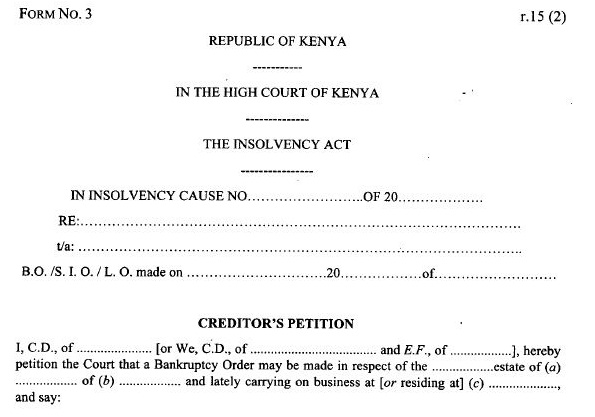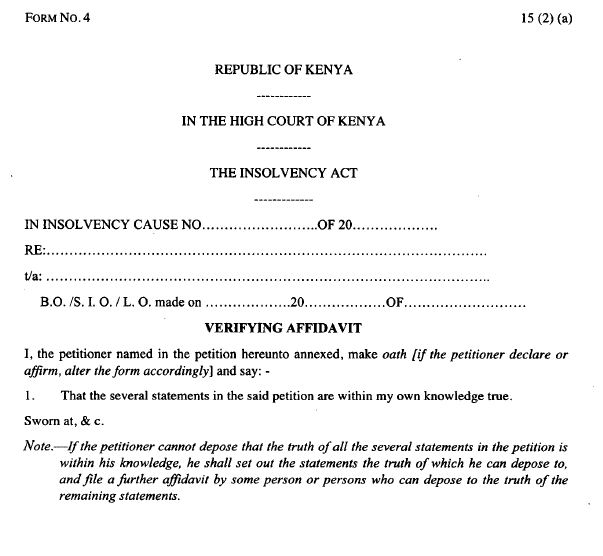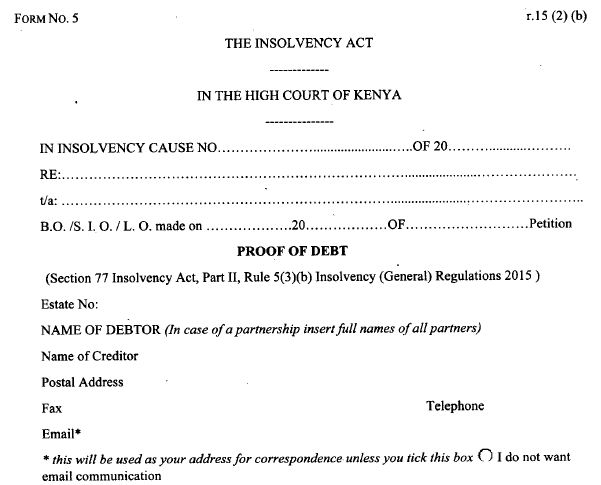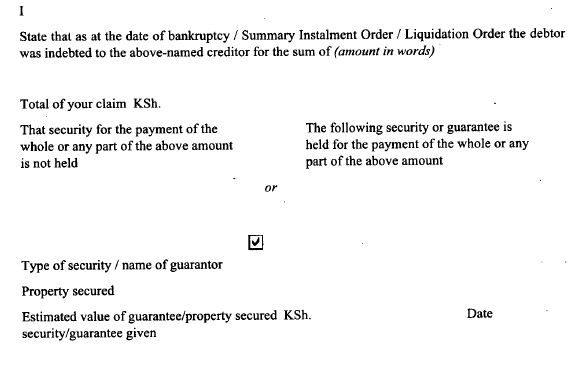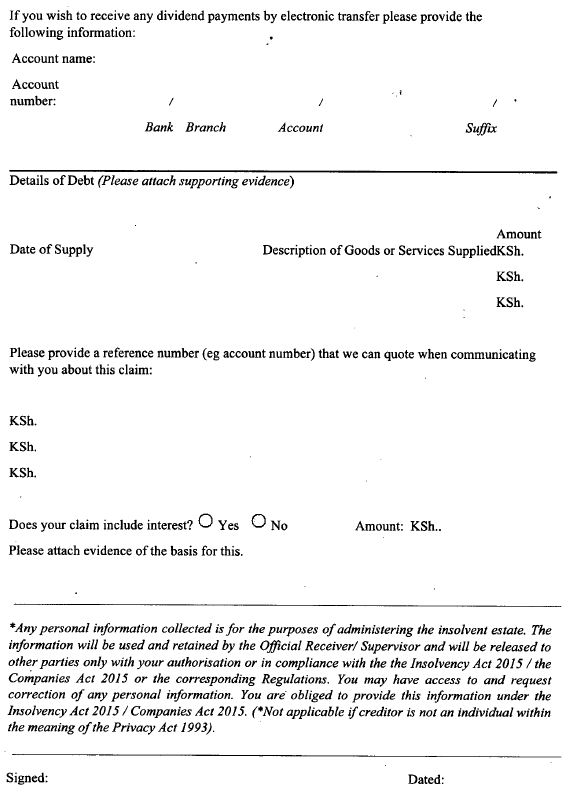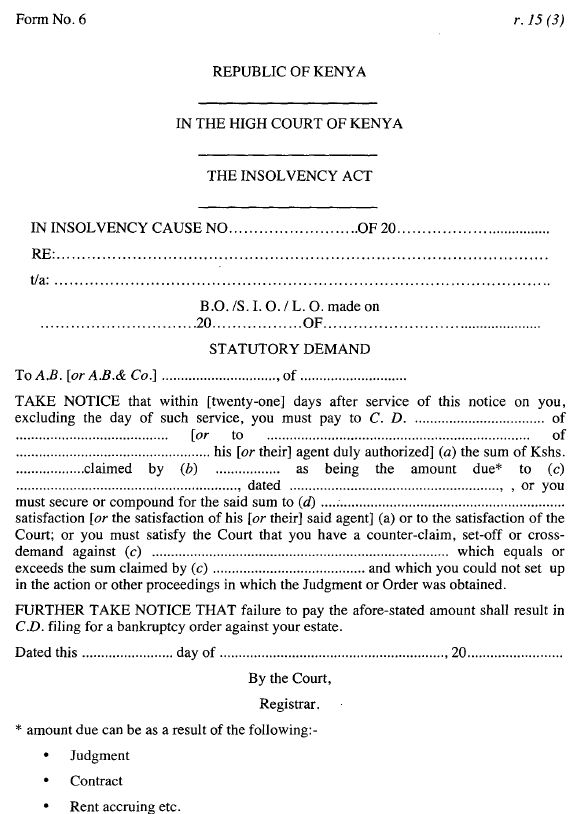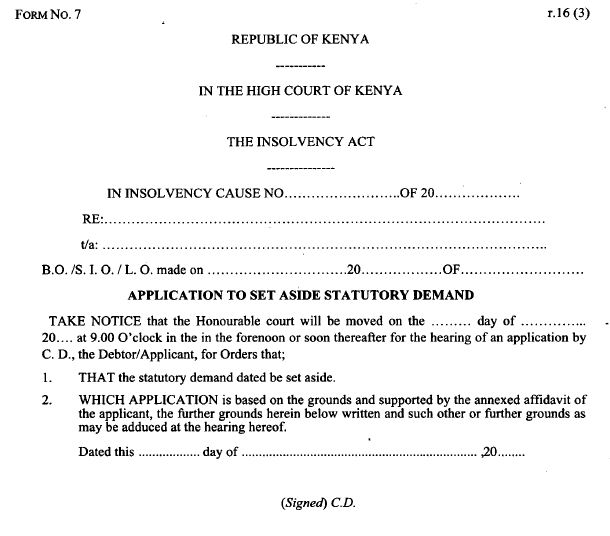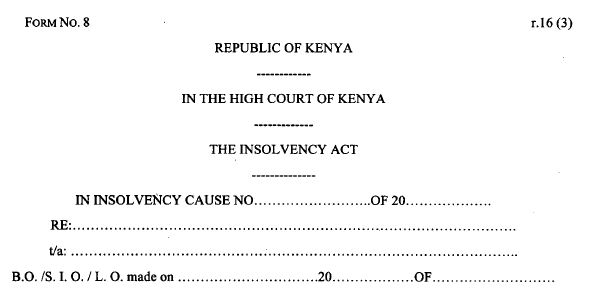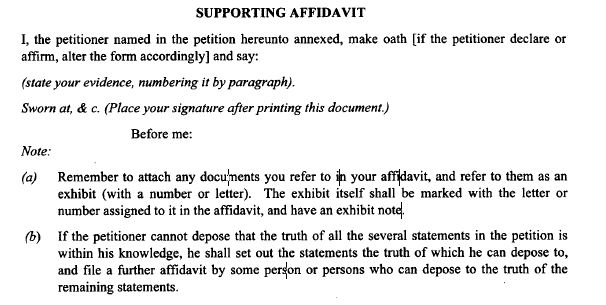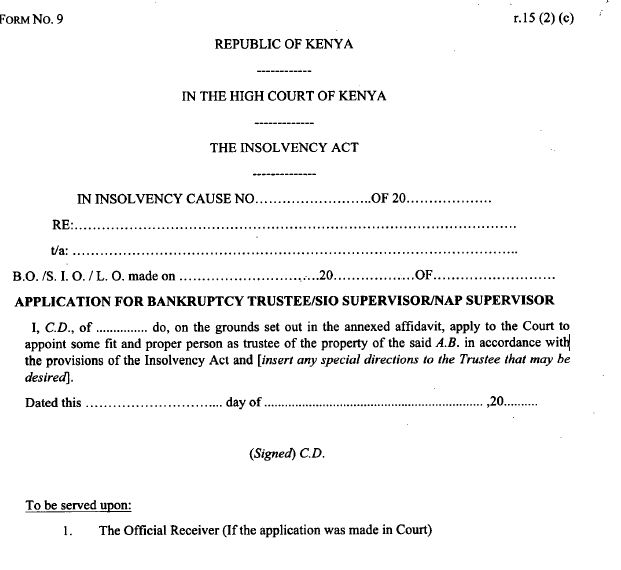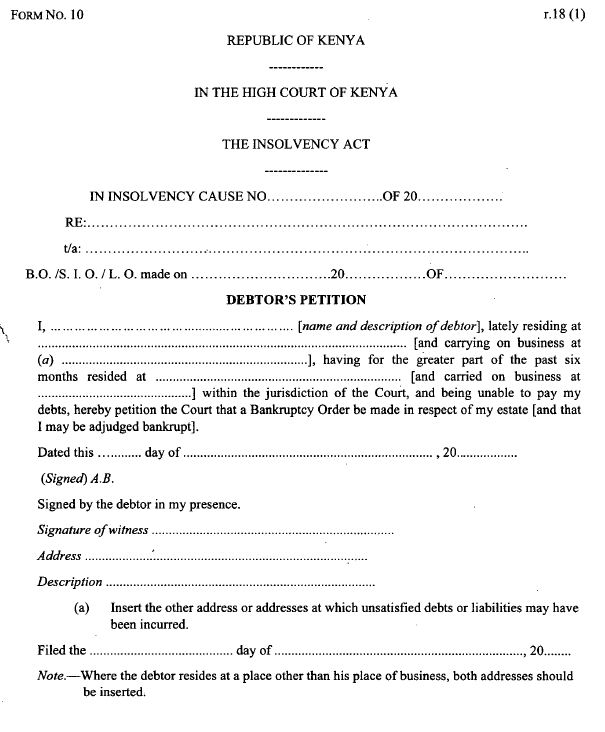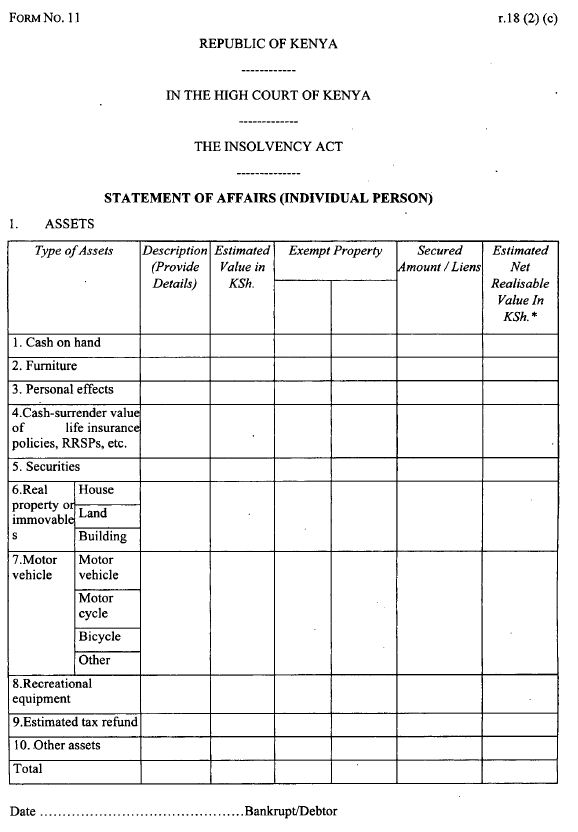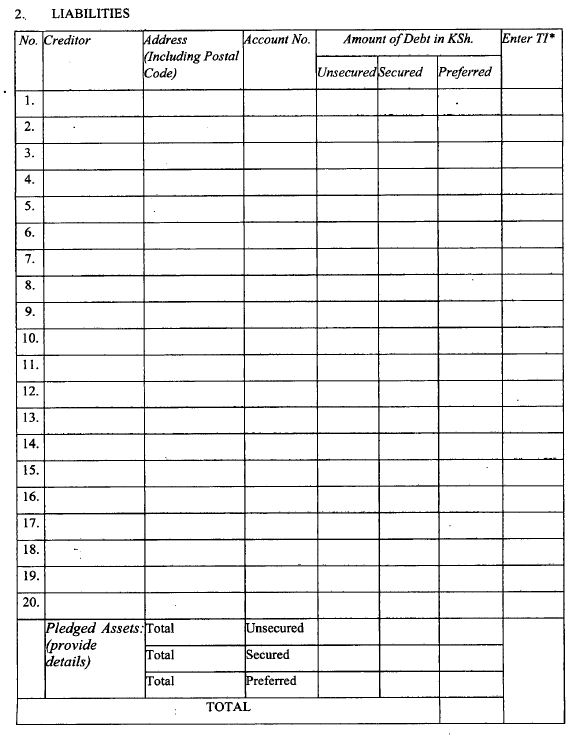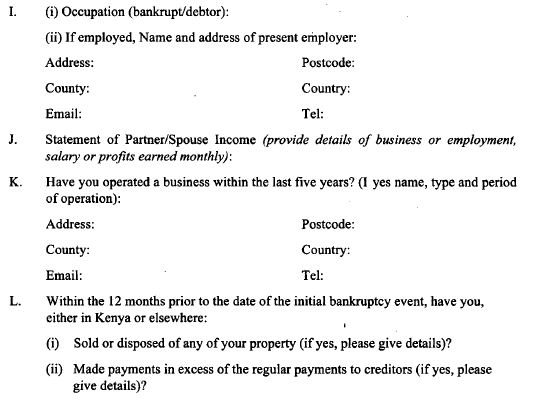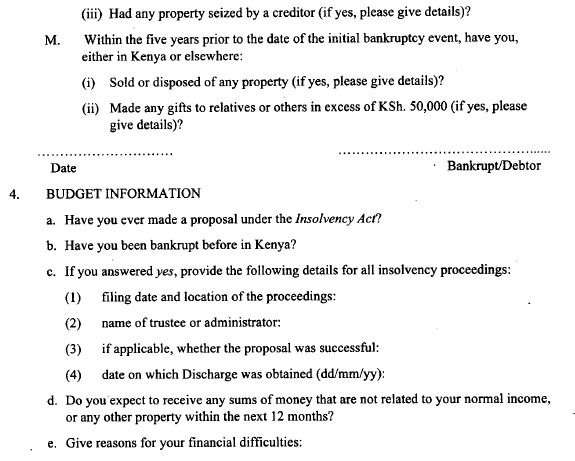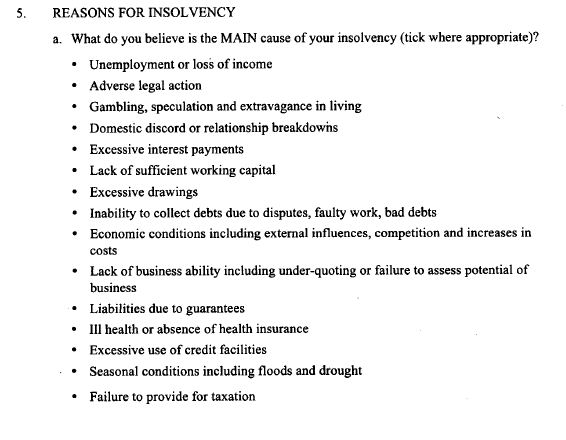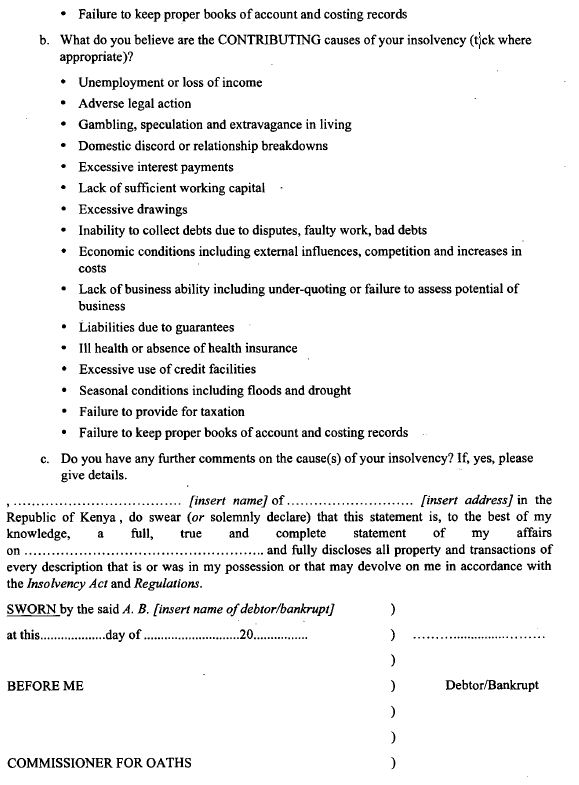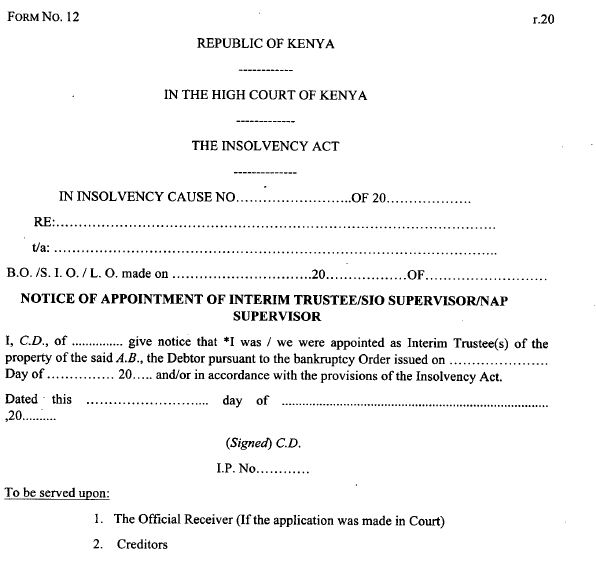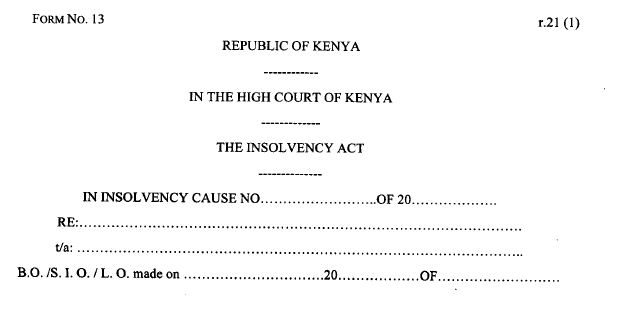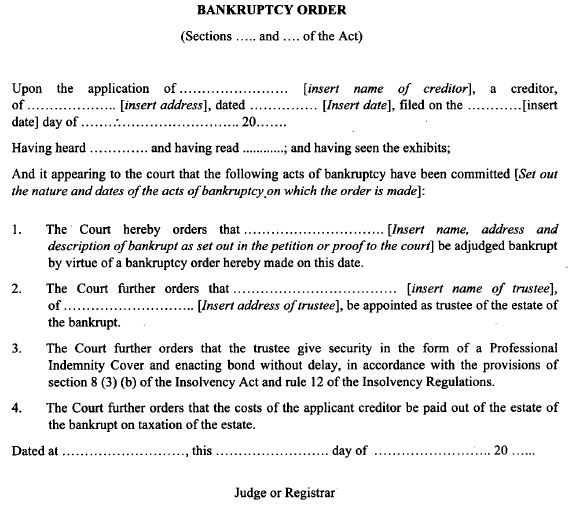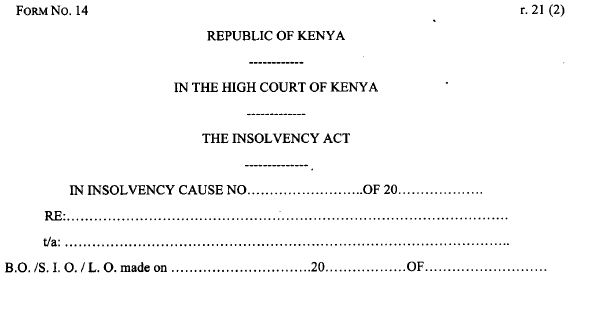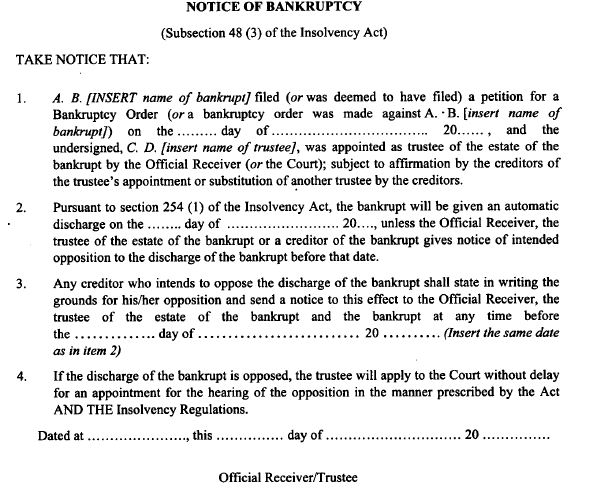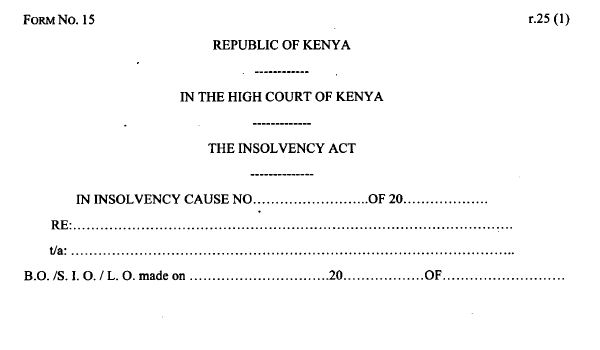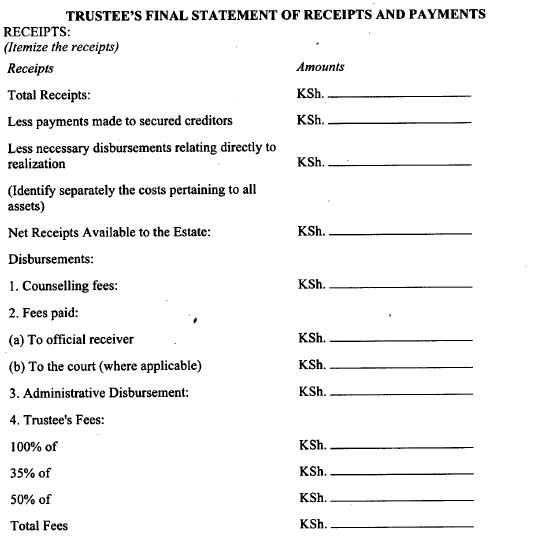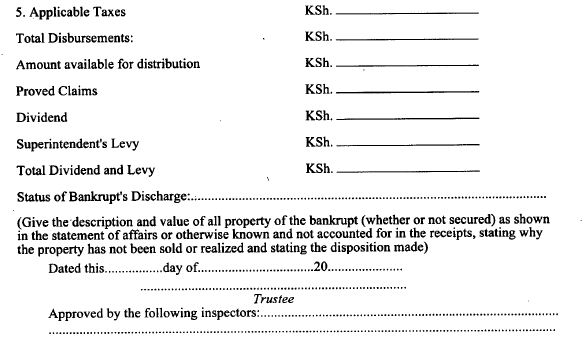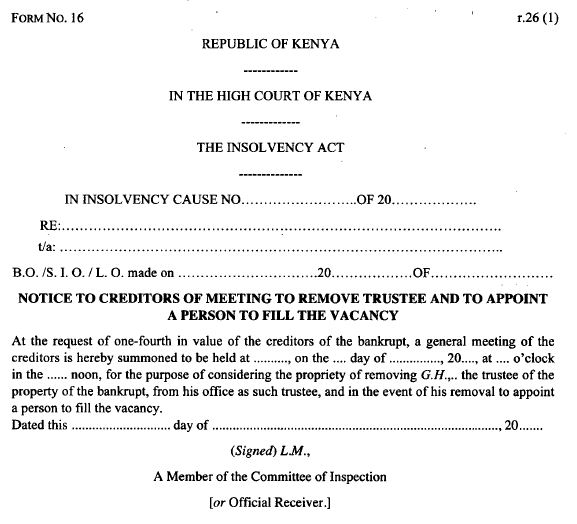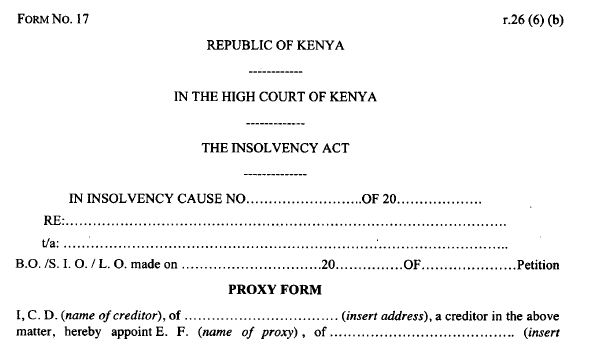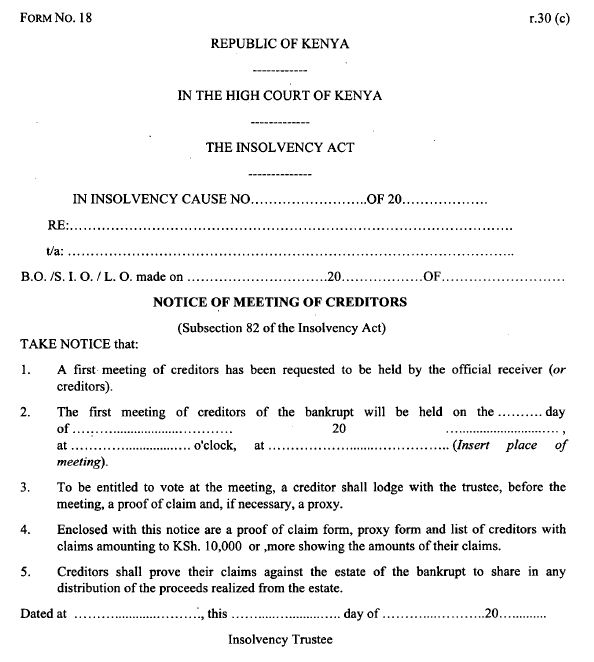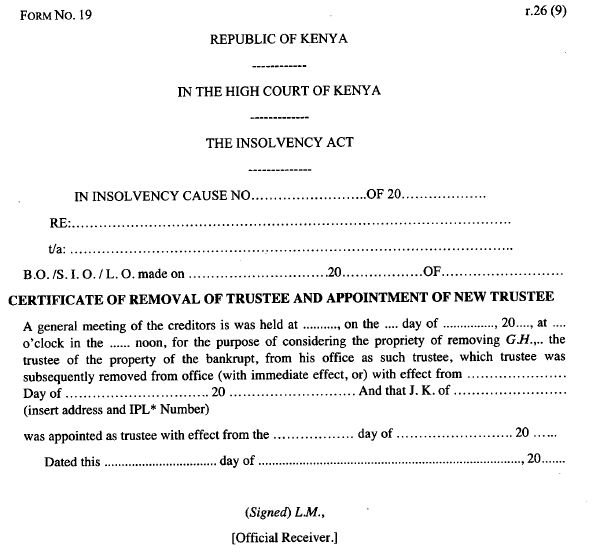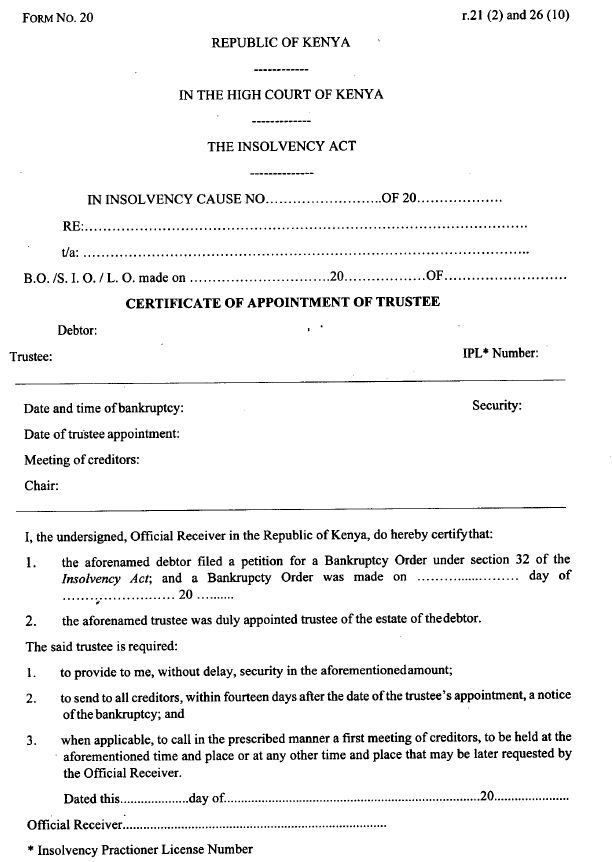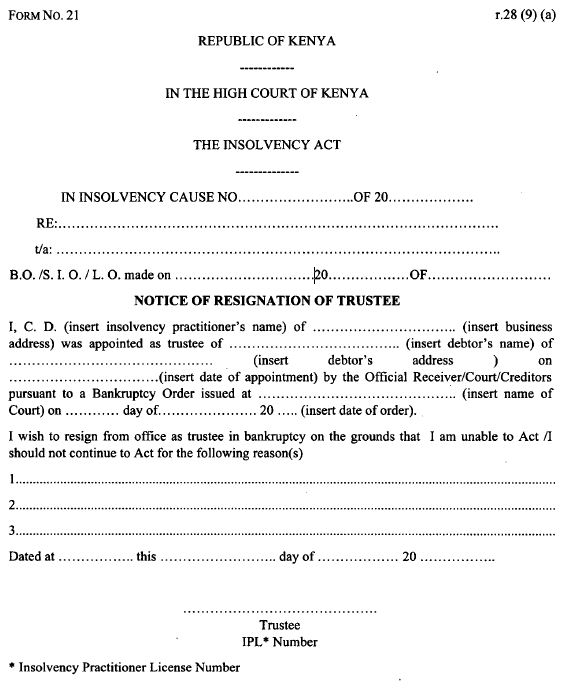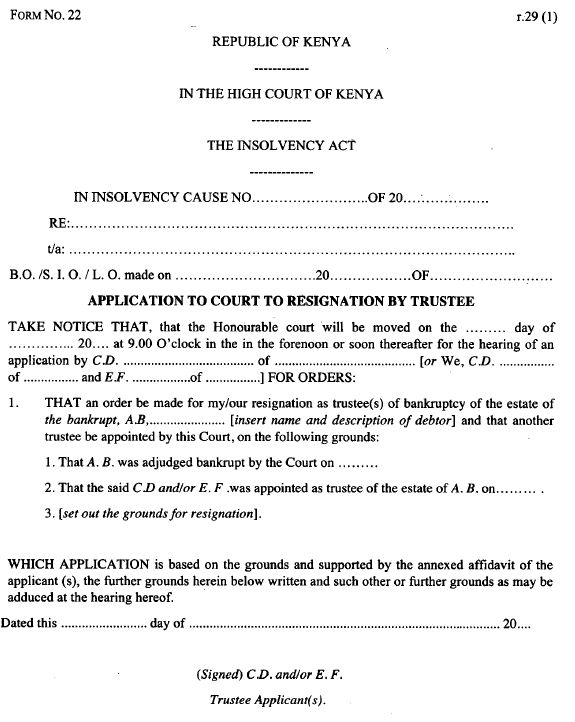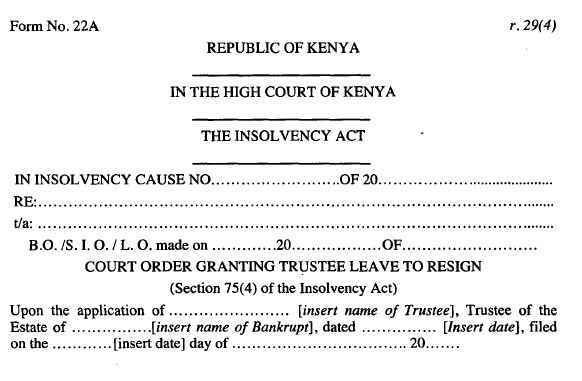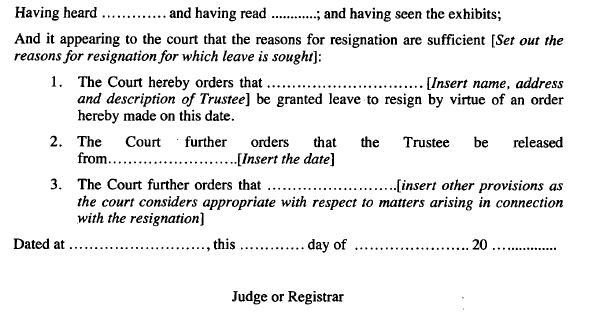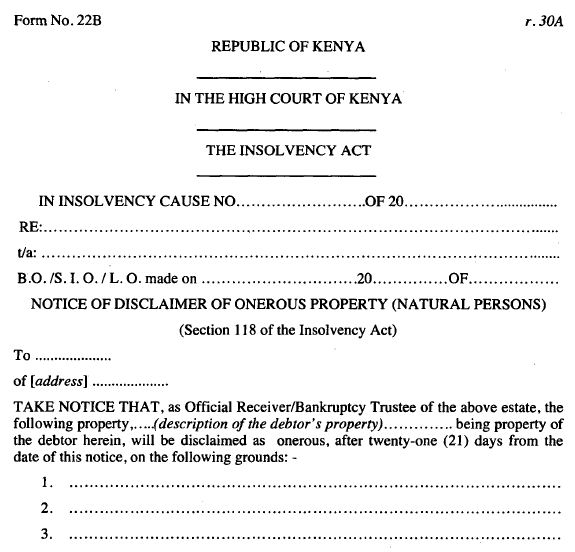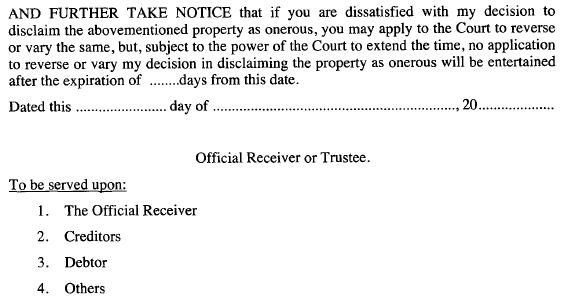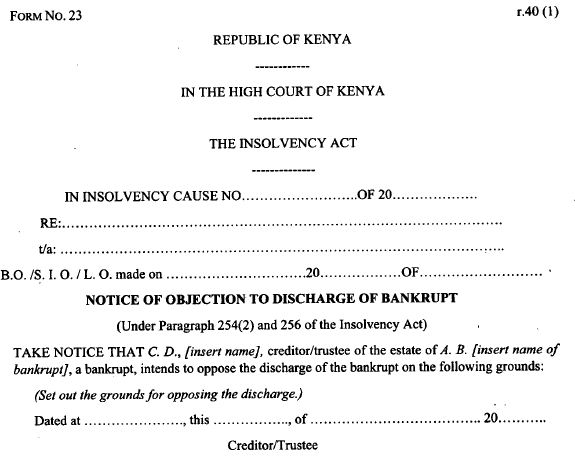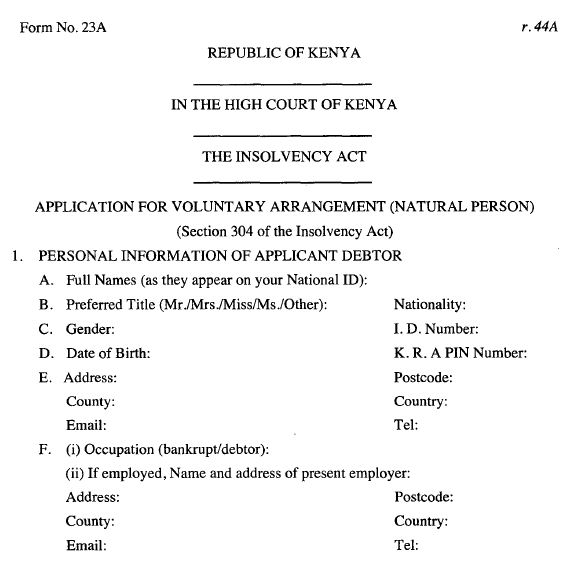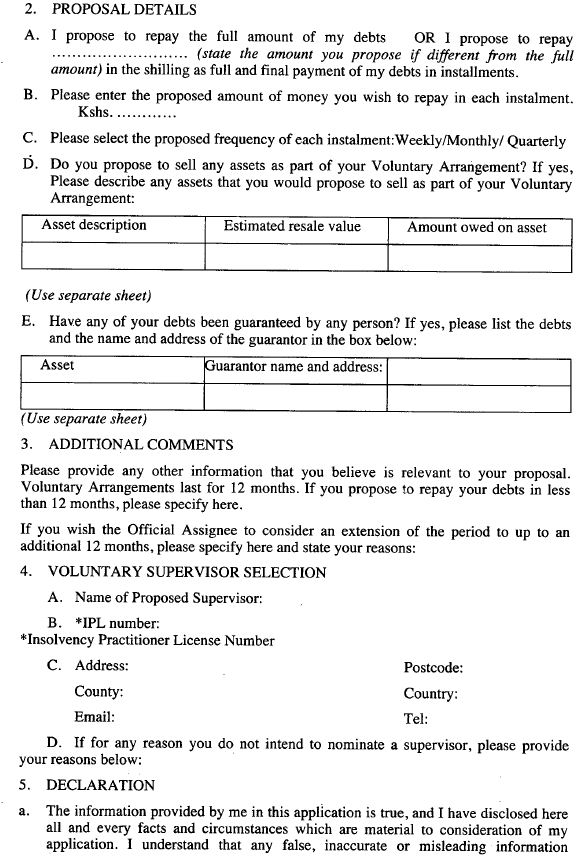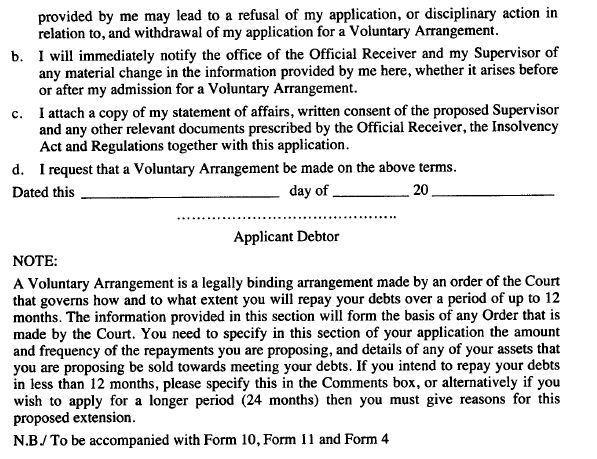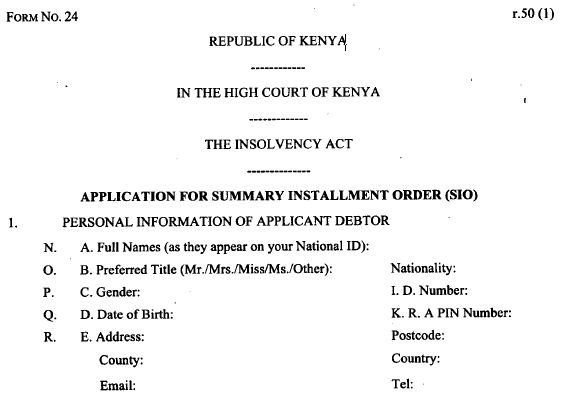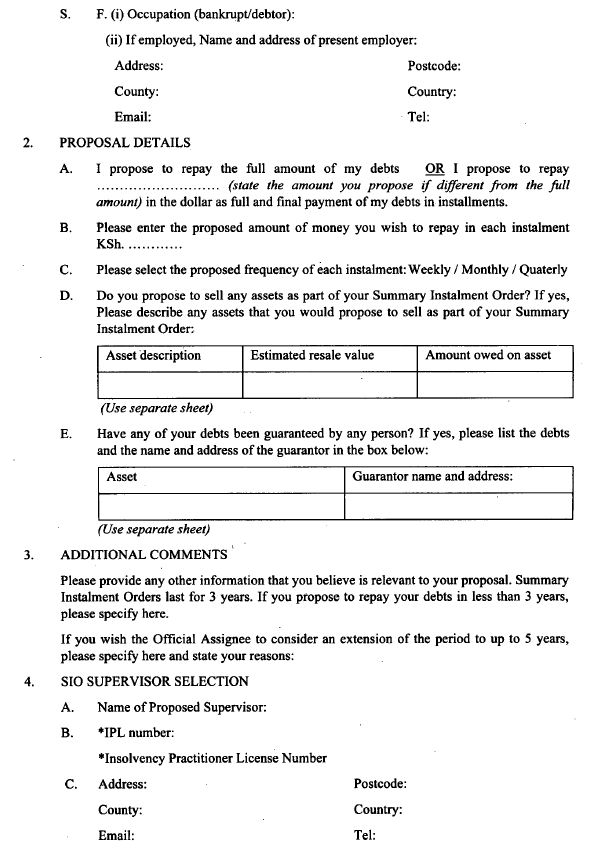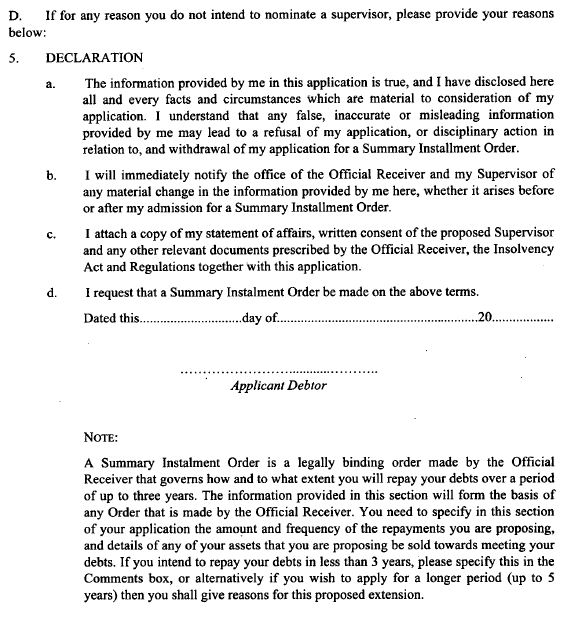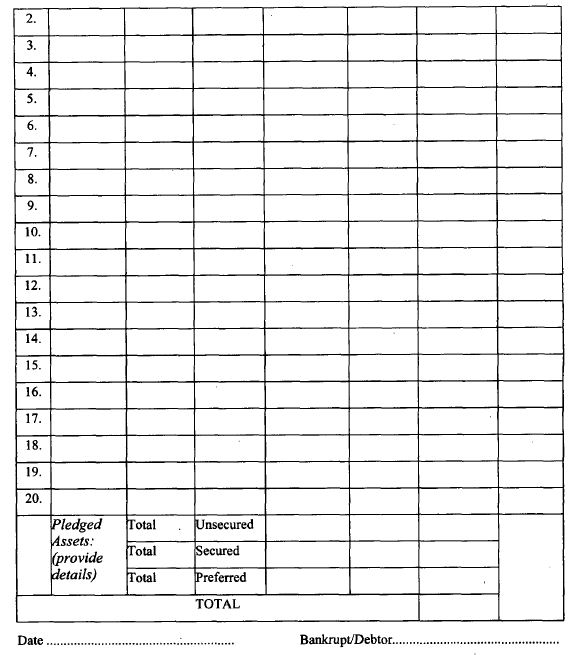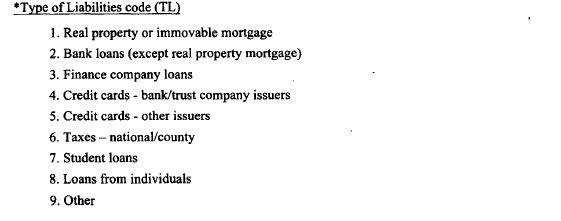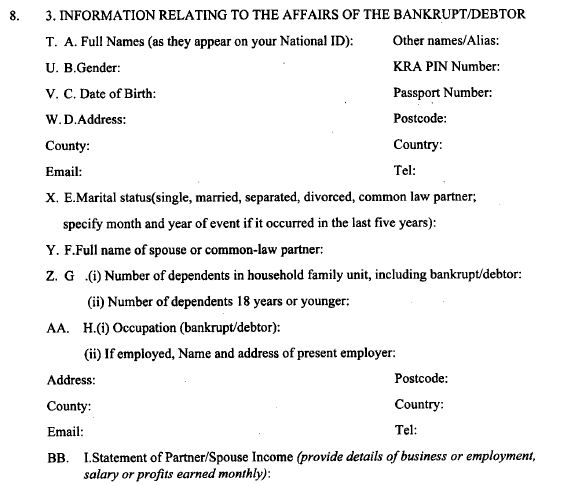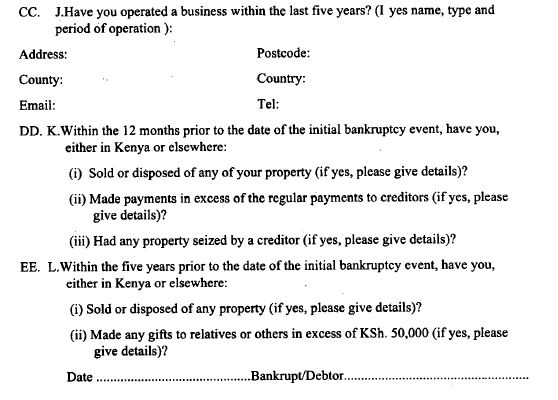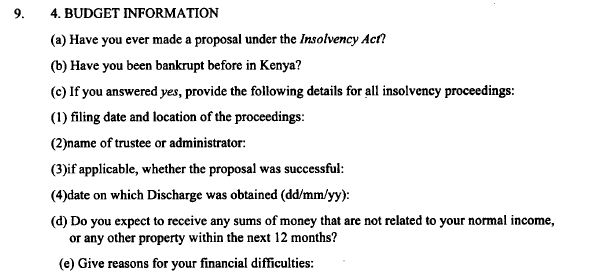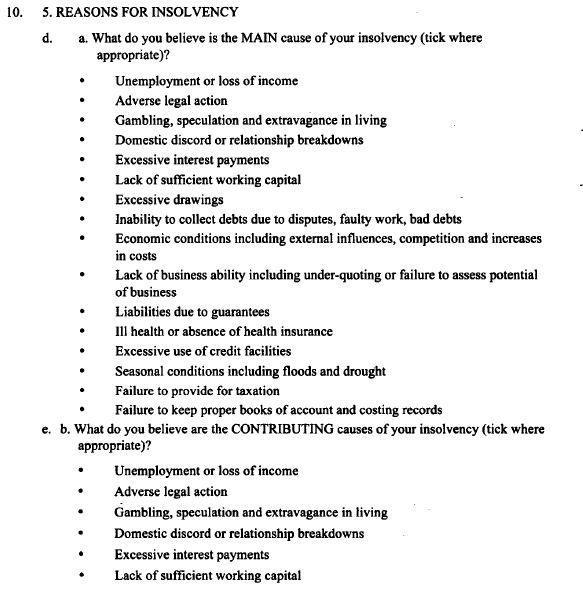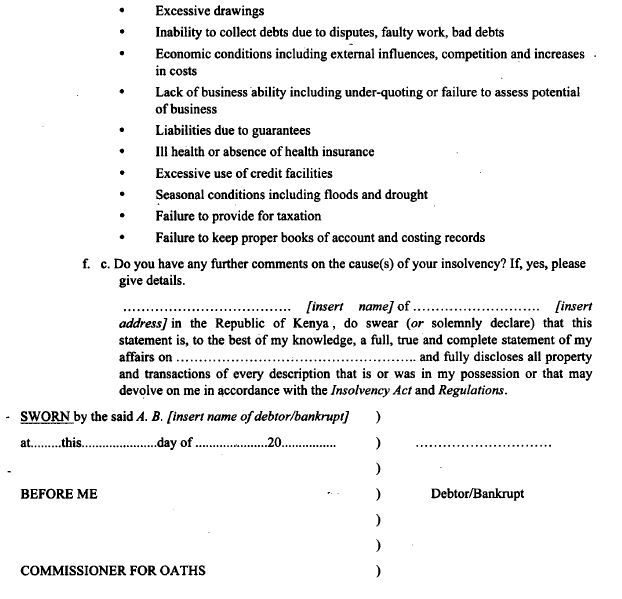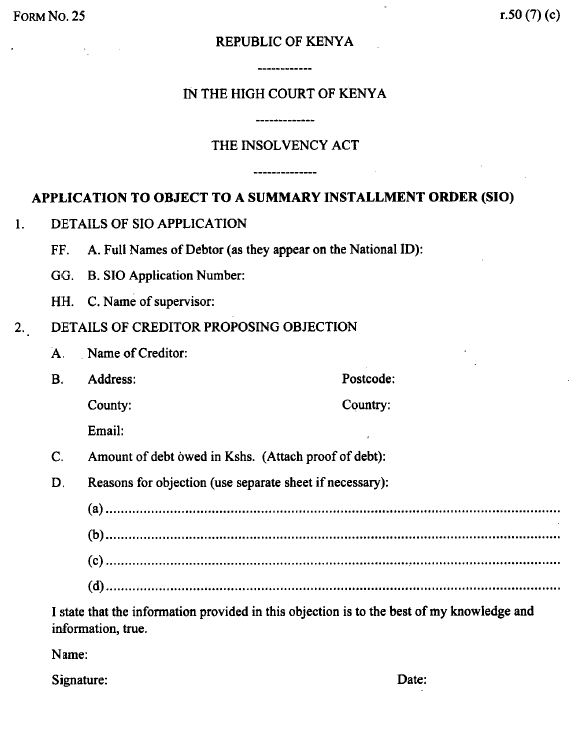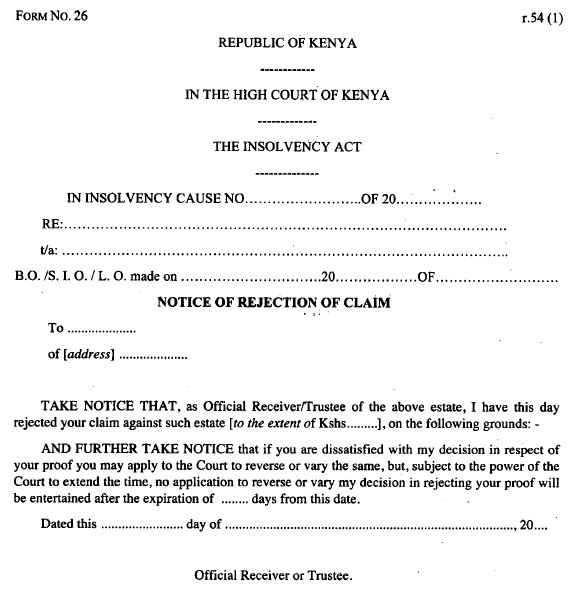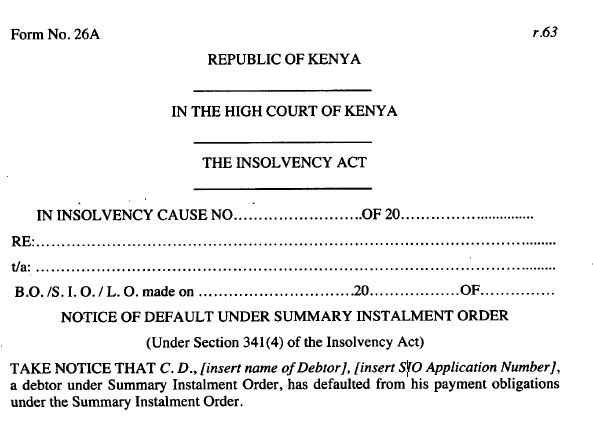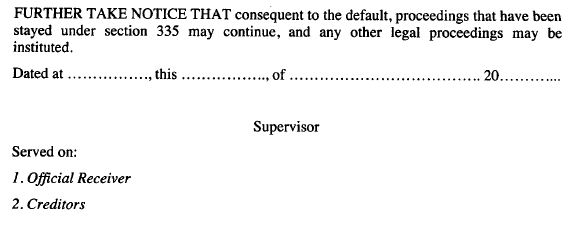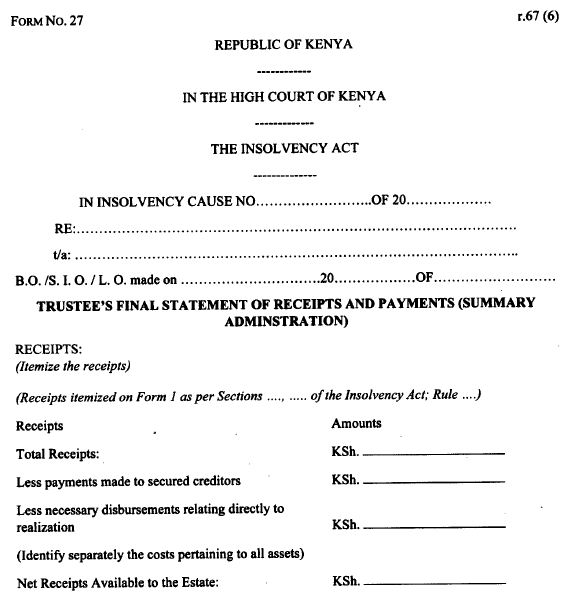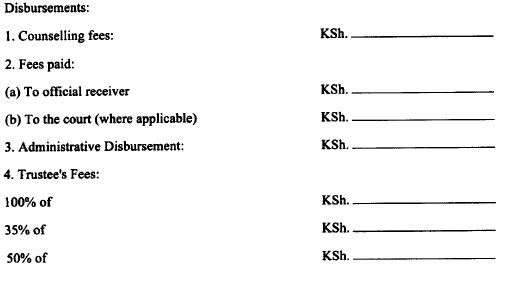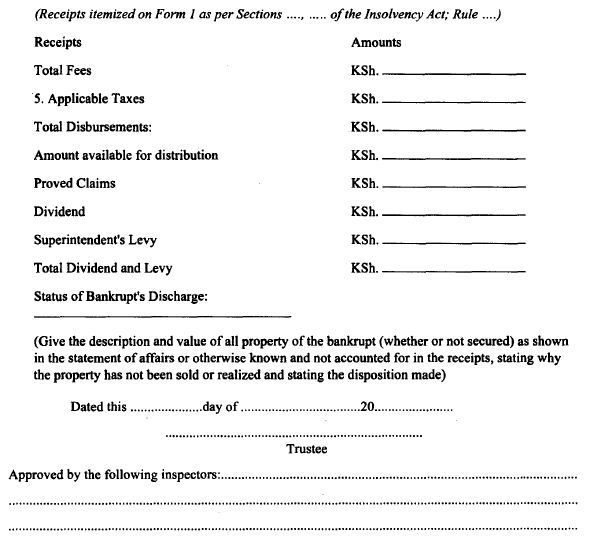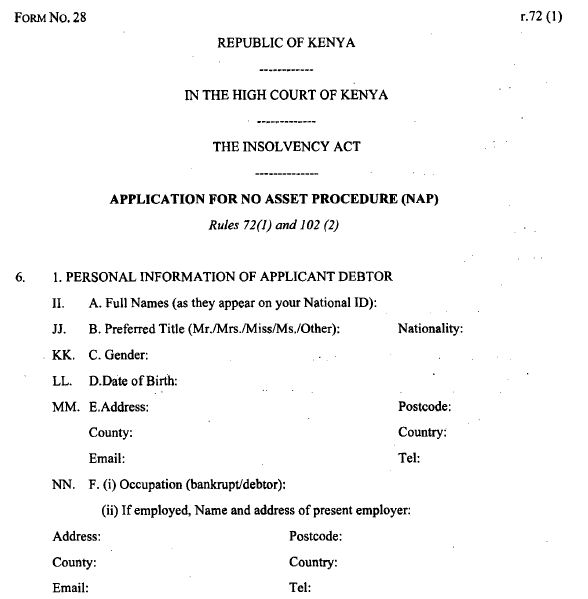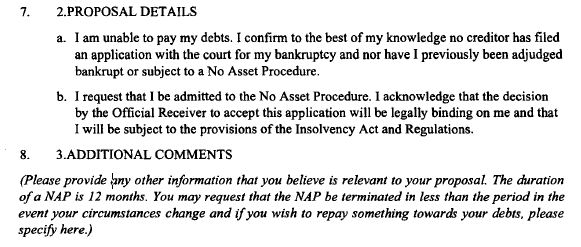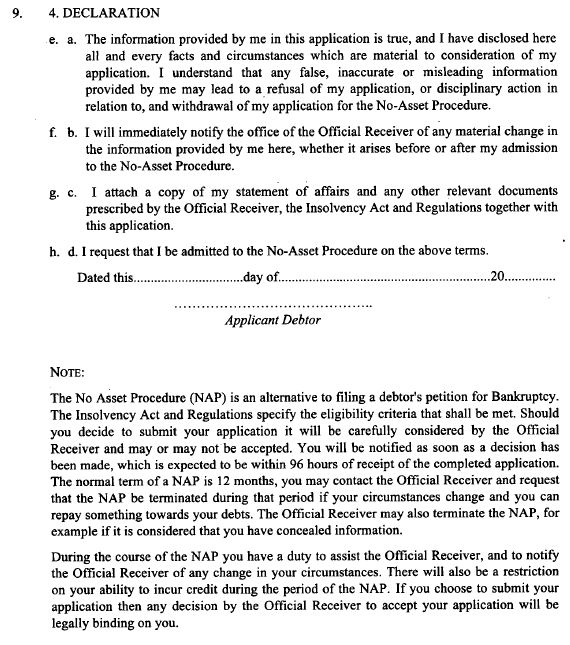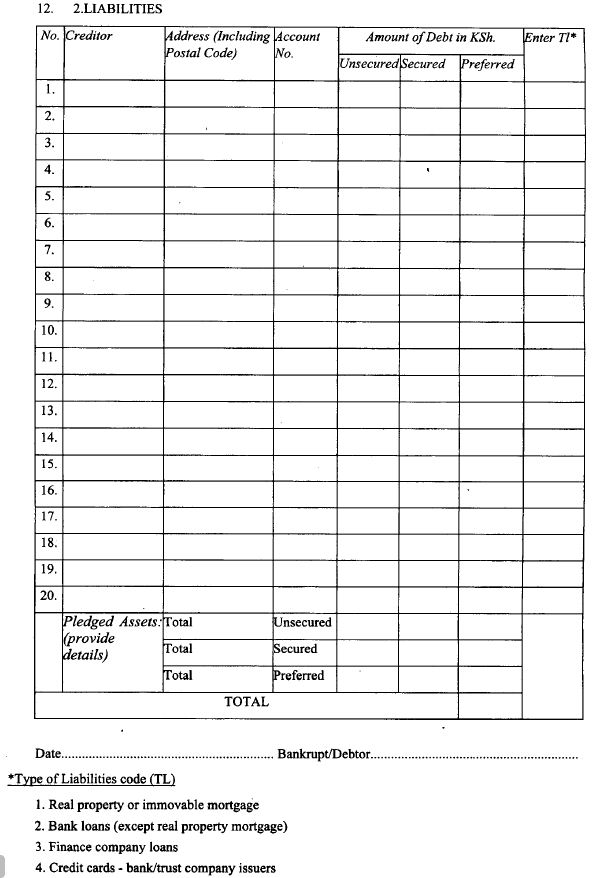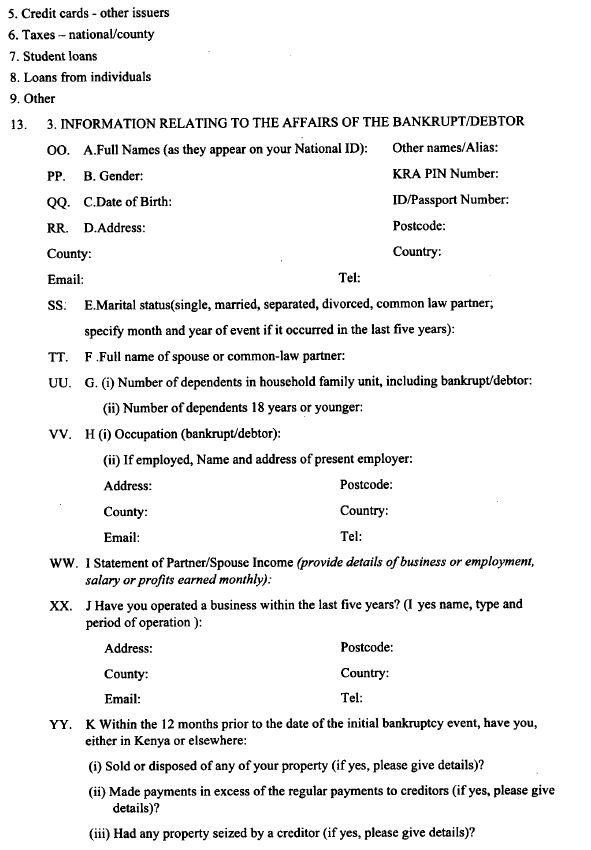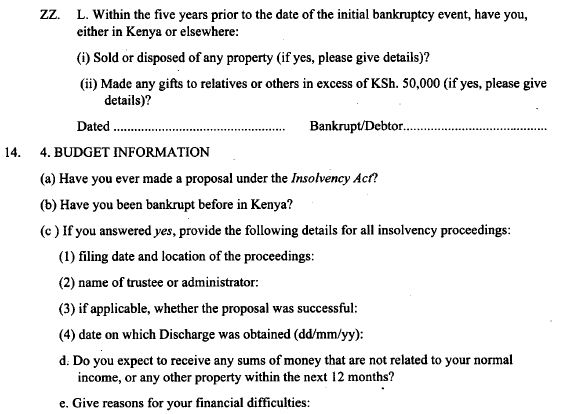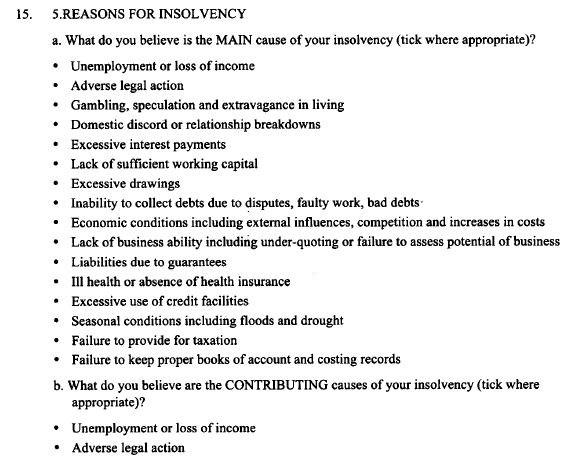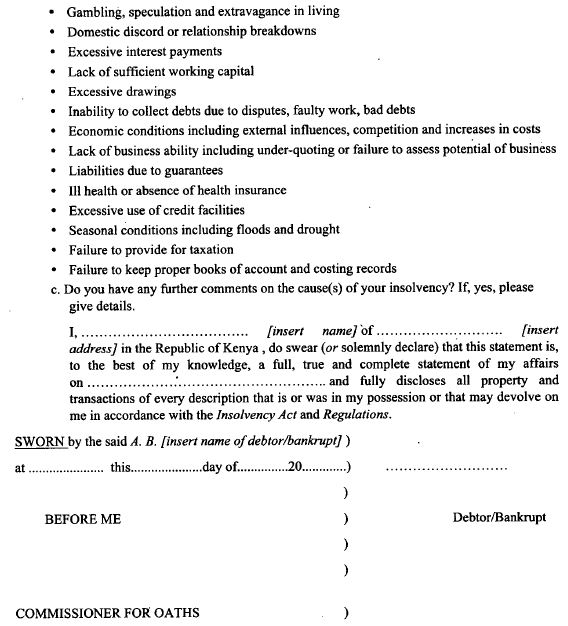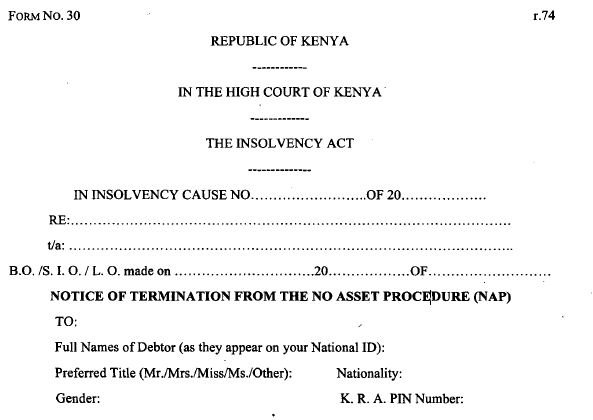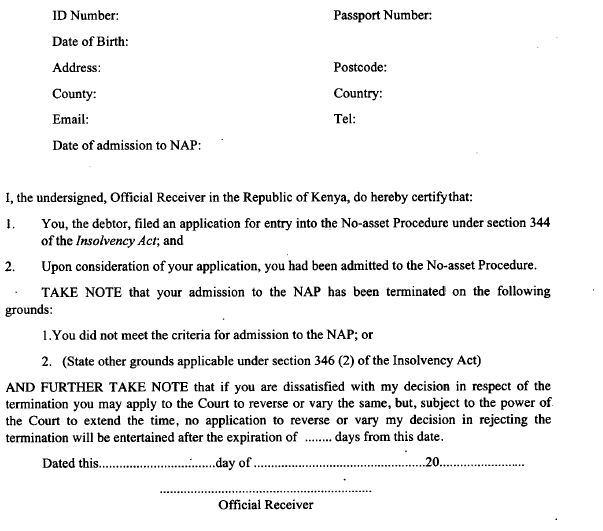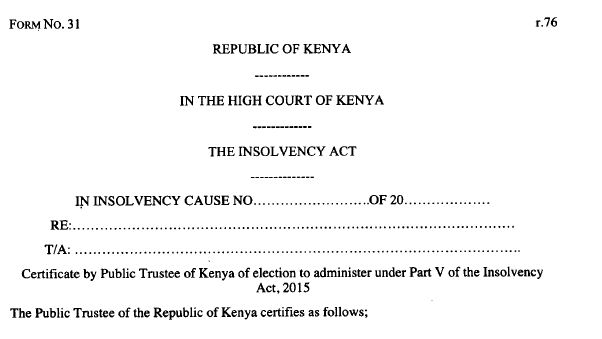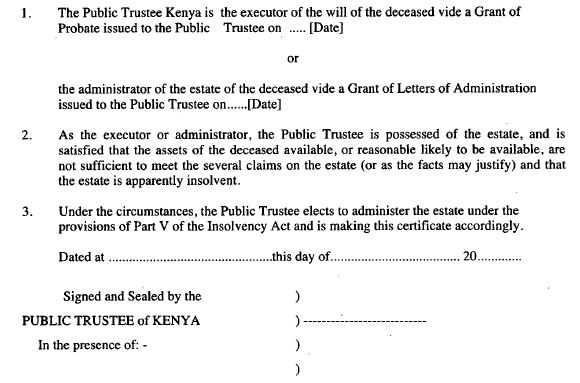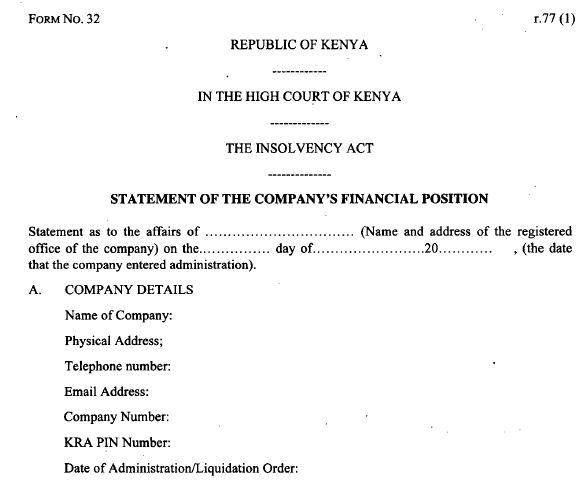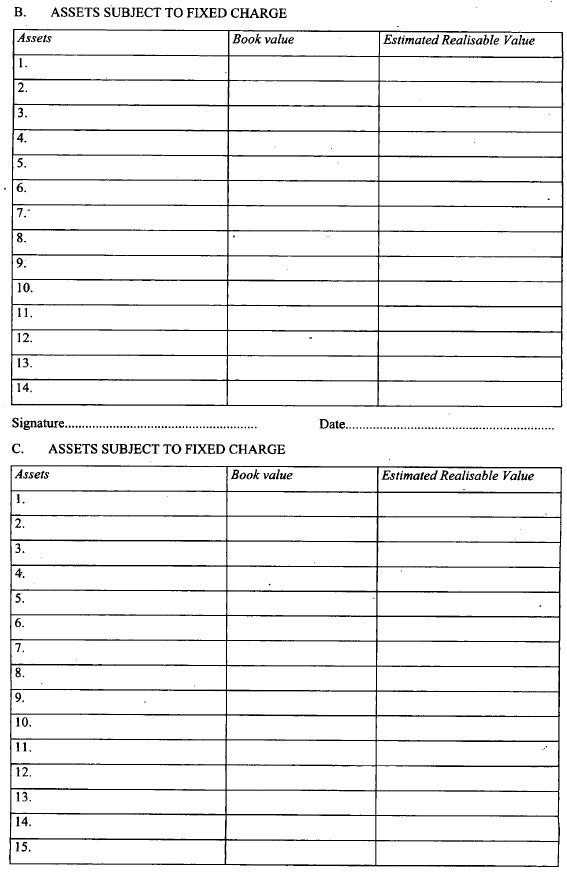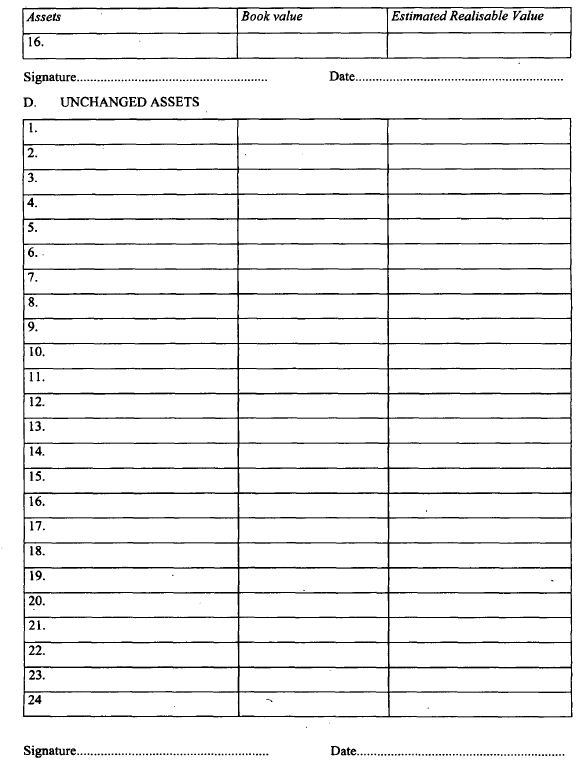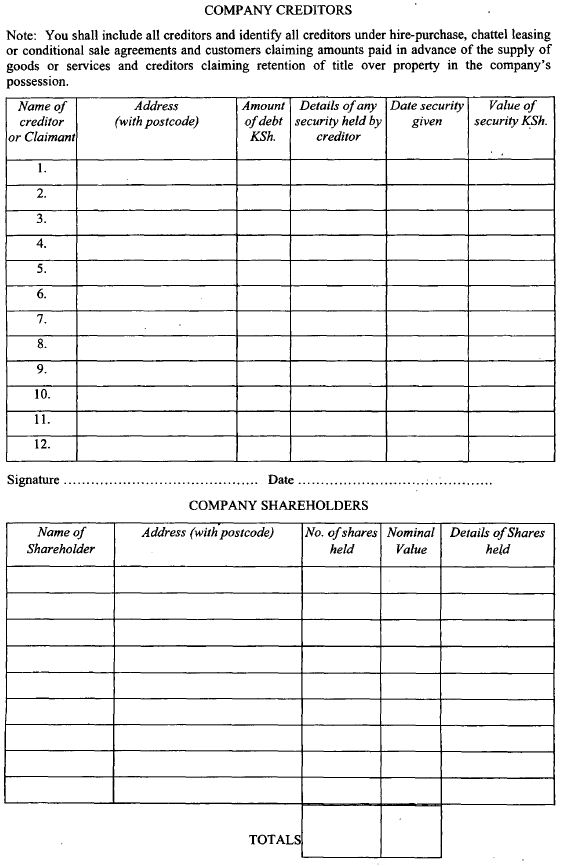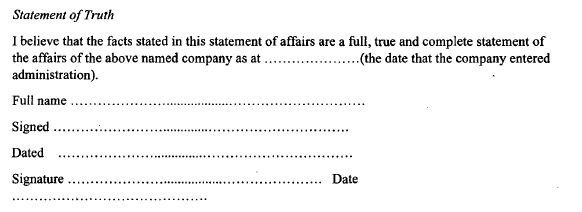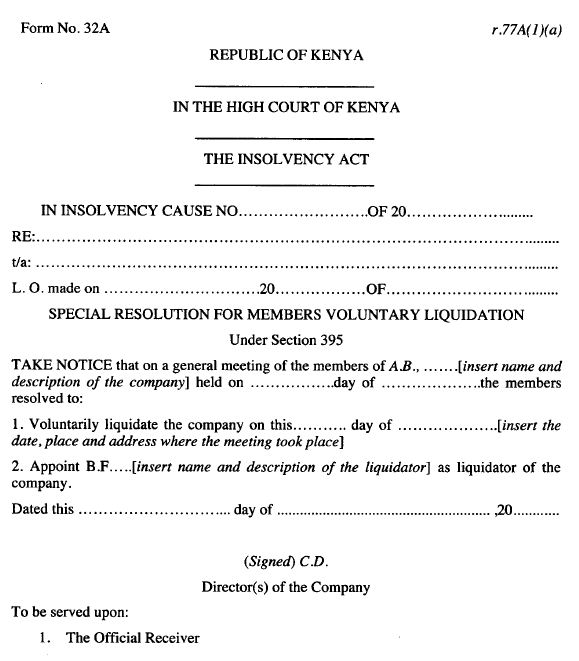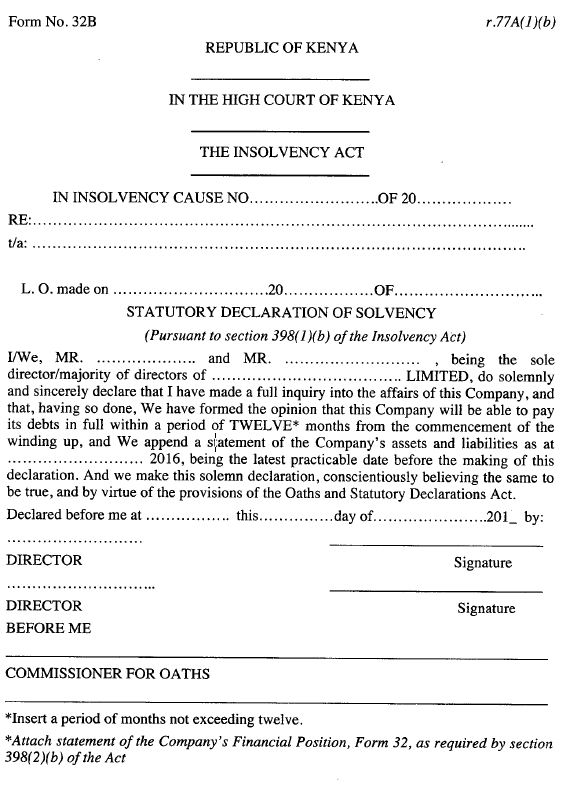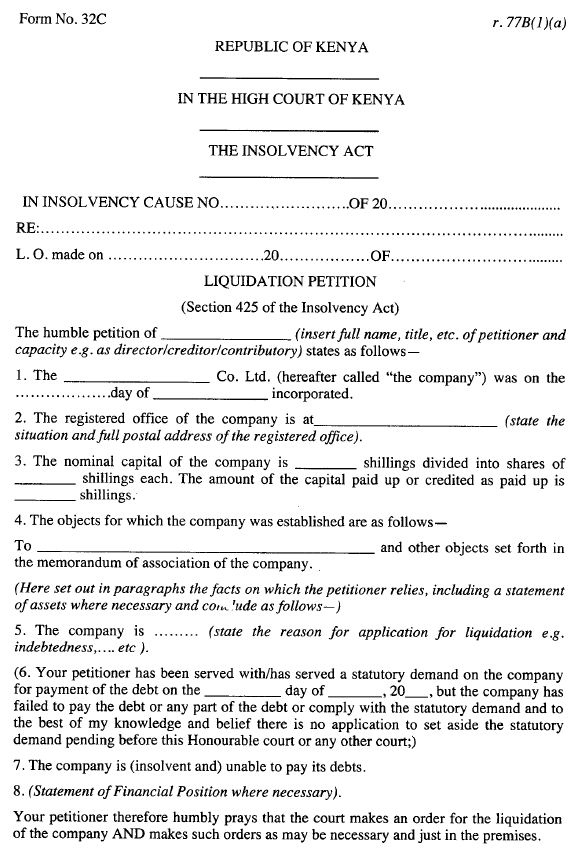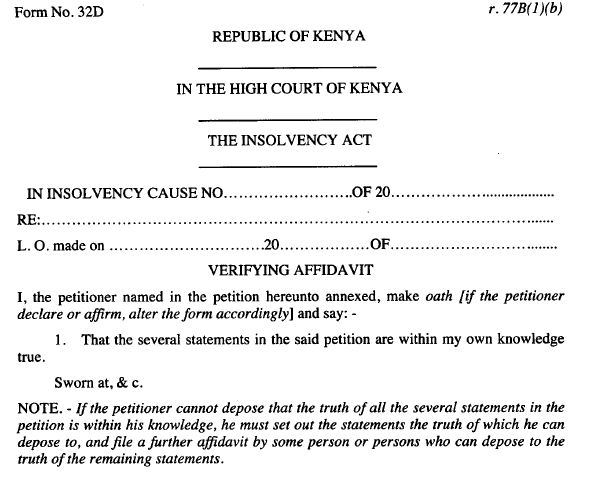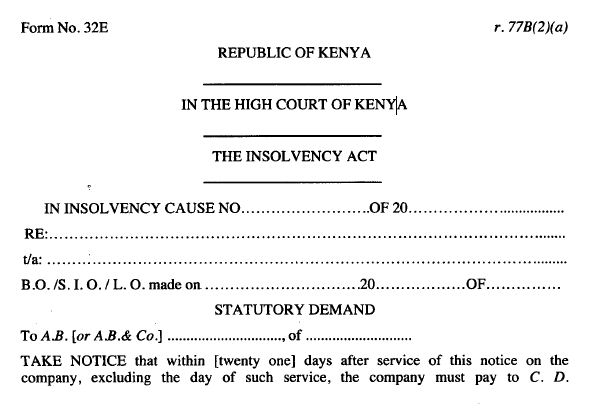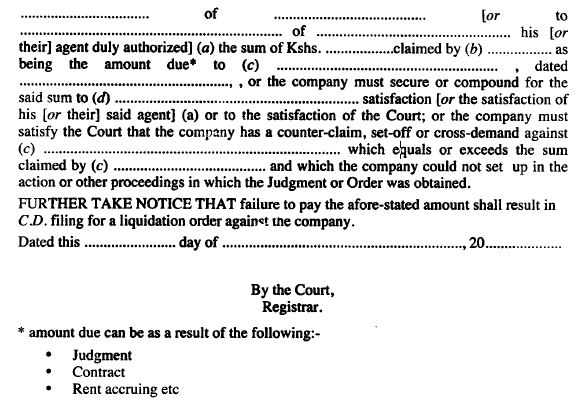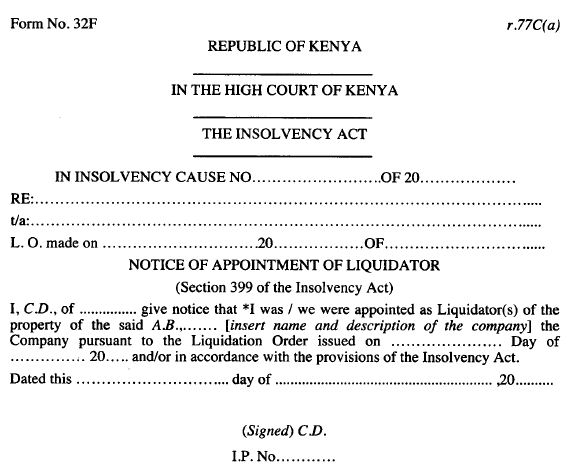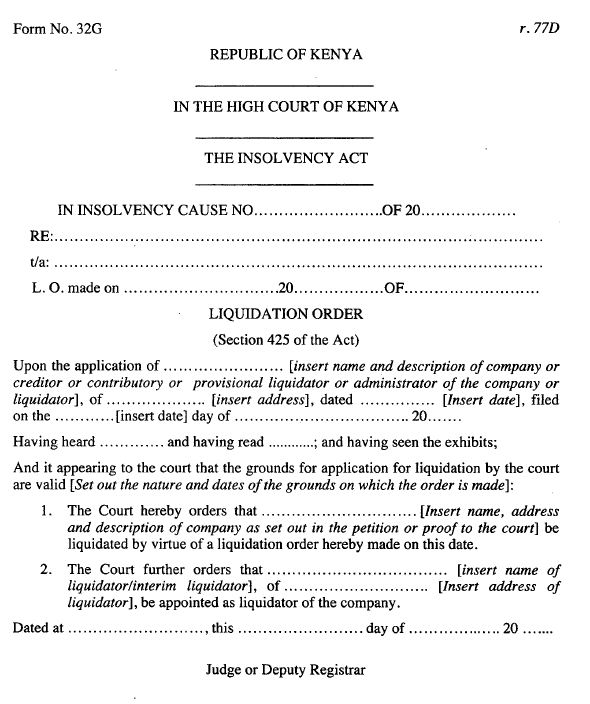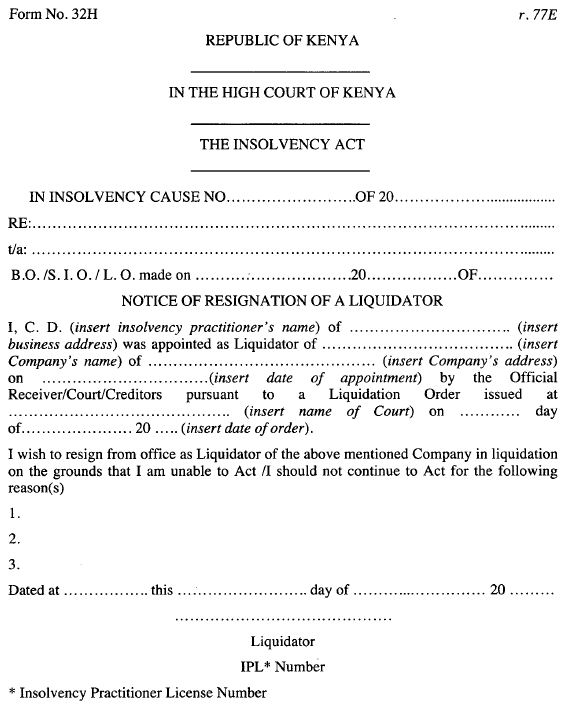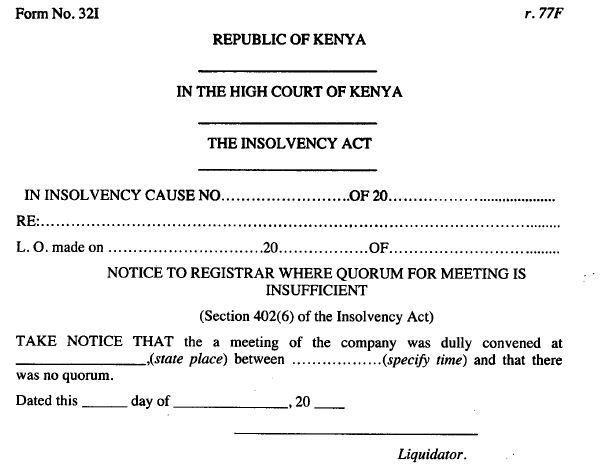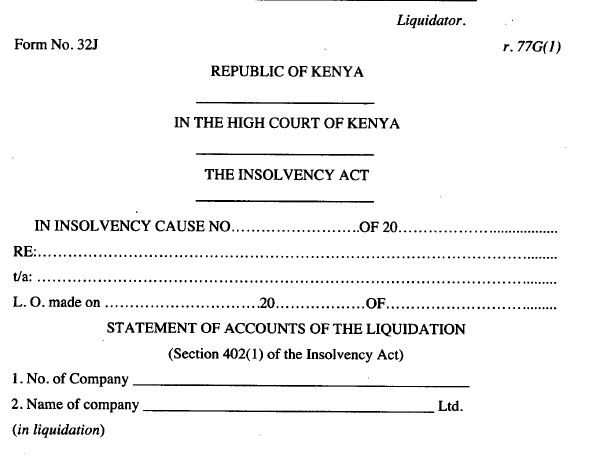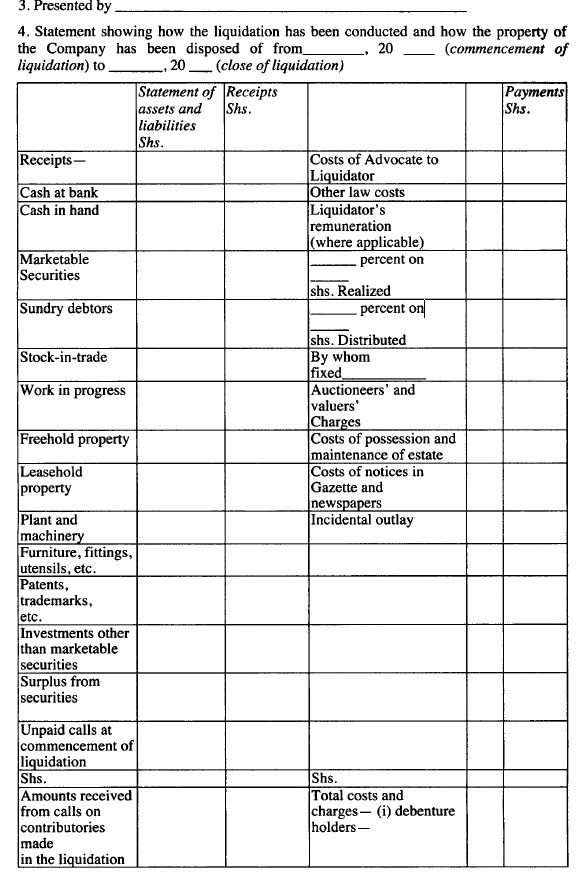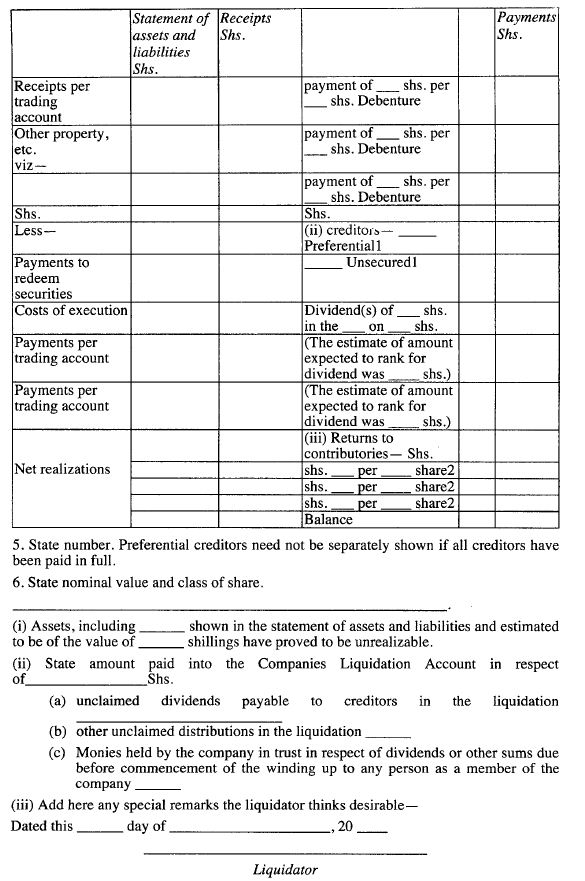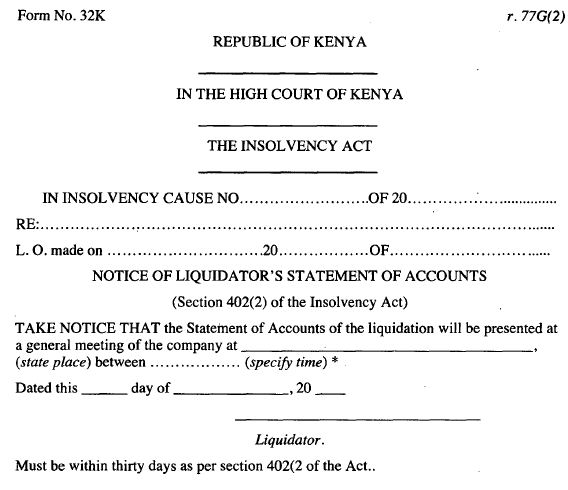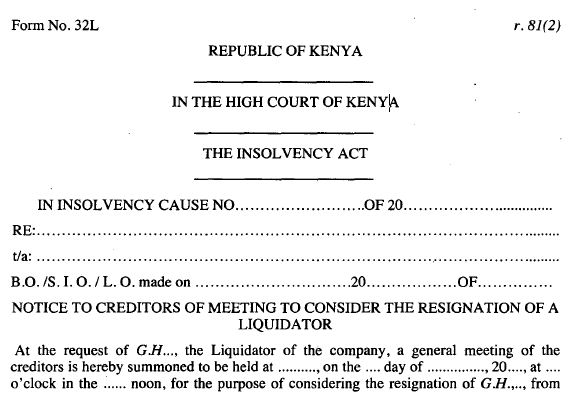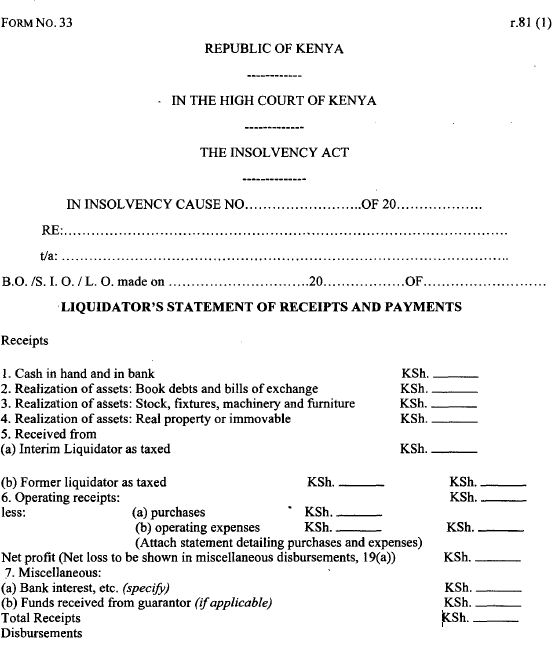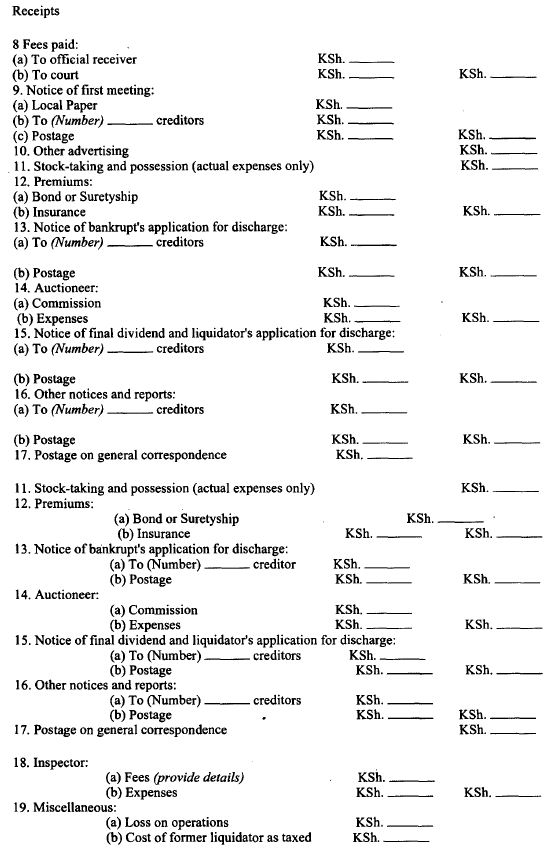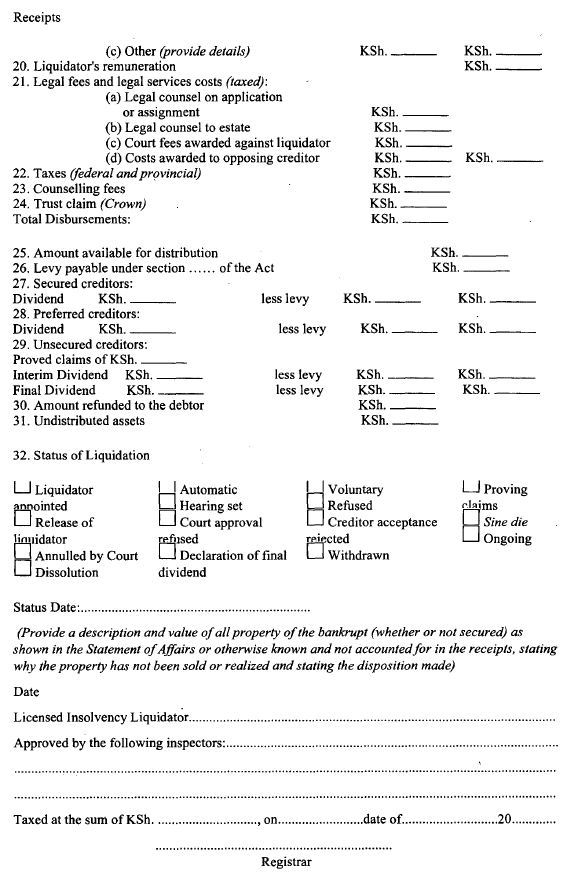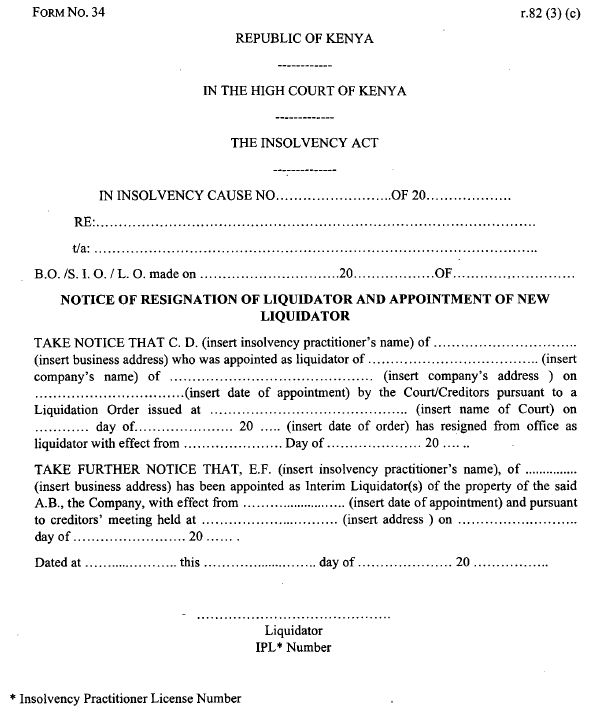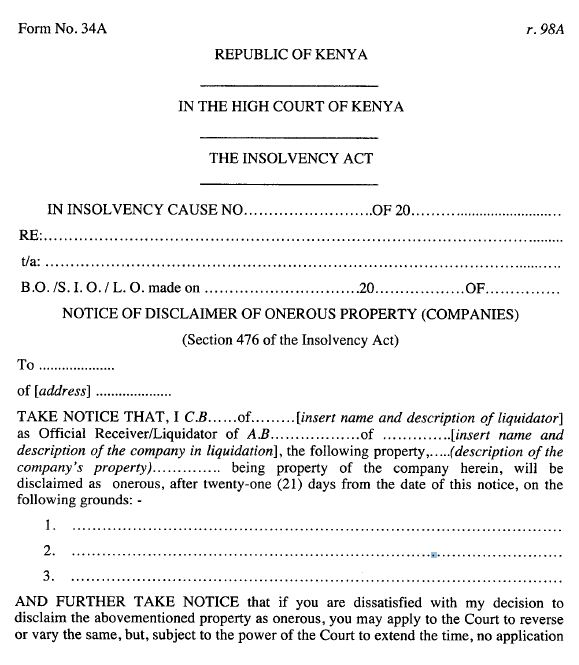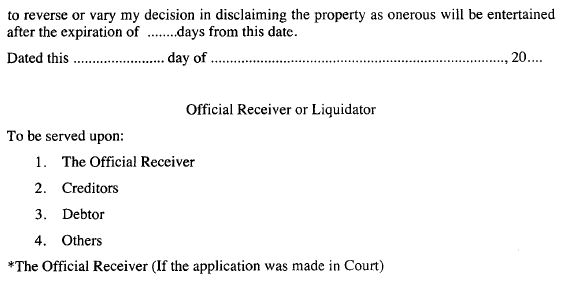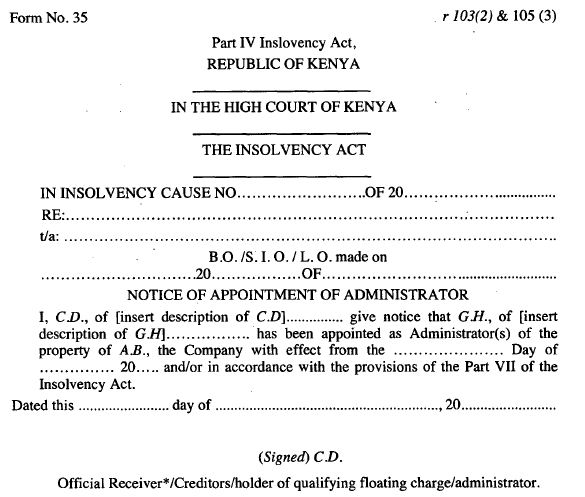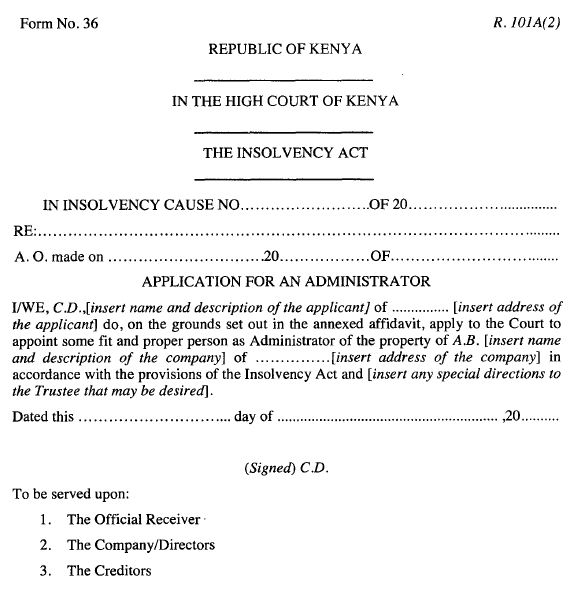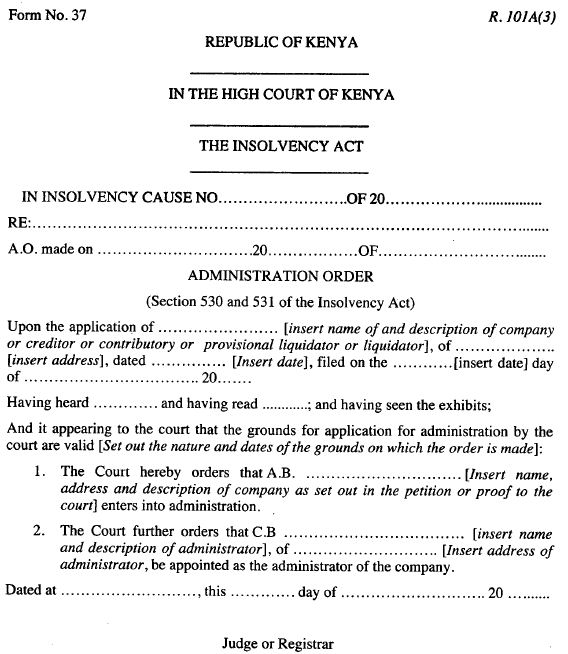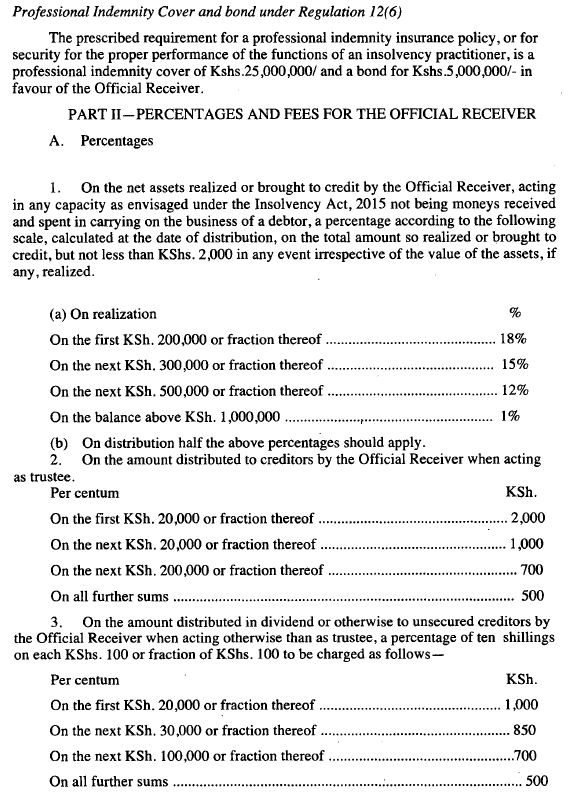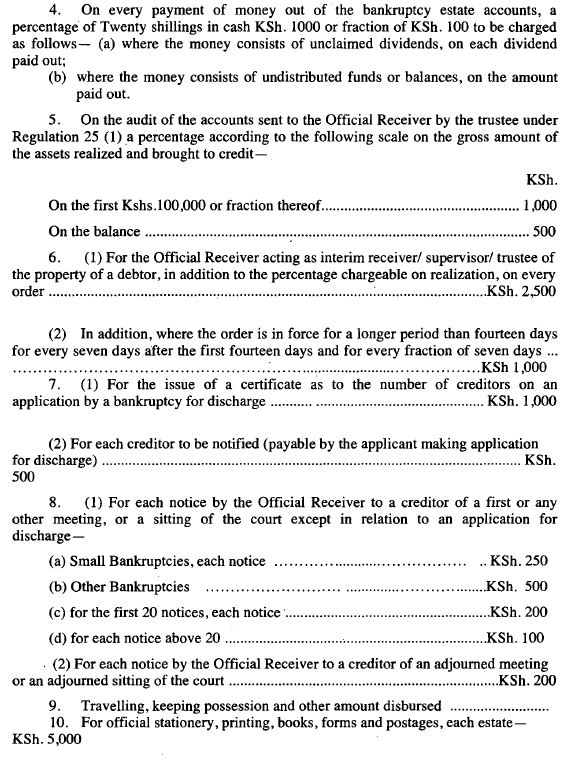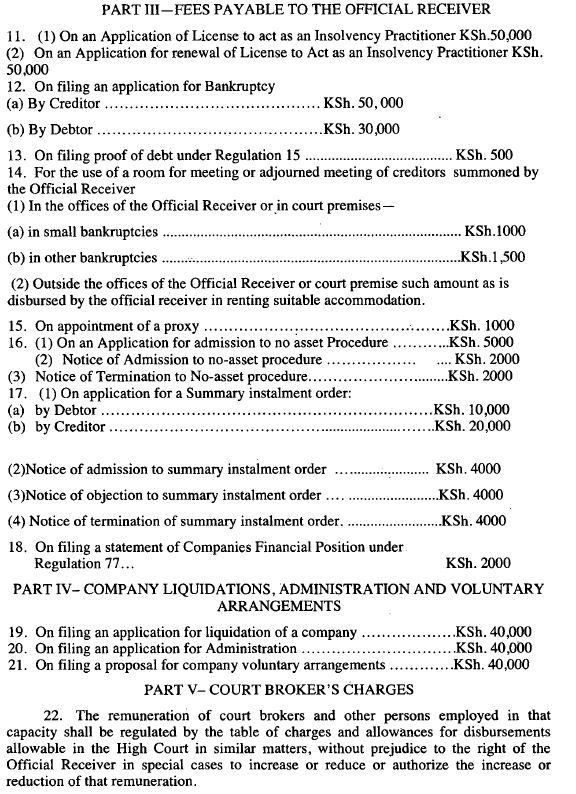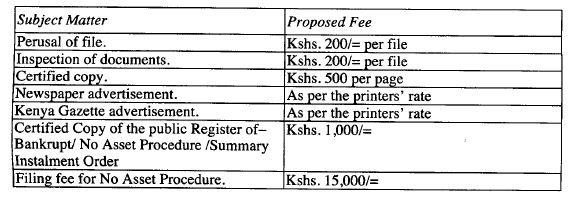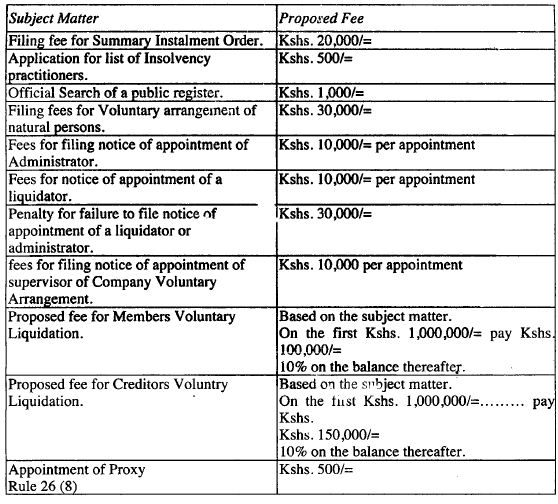|
|
THE INSOLVENCY REGULATIONS
ARRANGEMENT OF REGULATIONS
PART I – PRELIMINARY PROVISIONS
| 1. |
Citation and commencement
|
| 3. |
Prescribed bankruptcy level
|
| 5. |
Authentication of documents
|
PART II – PUBLICATION OF NOTICES
| 6. |
Publication of notices
|
| 7. |
Content of all notices
|
| 8. |
Notice relating to a company
|
| 9. |
Notices relating to a bankruptcy
|
PART III – APPLICATIONS MADE IN COURT
| 10. |
Applications to court
|
PART IV – INSOLVENCY PRACTITIONERS
| 11. |
Academic requirements for insolvency practitioners
|
| 12. |
Procedure for application of licence to act as an insolvency practitioner
|
| 13. |
Duration of the certificate of authorisation to act as an insolvency practitioner
|
| 14. |
Renewal of a certificate of authorisation
|
PART V – PERSONAL BANKRUPTCY
| 15. |
Creditor may apply for bankruptcy order in respect of debtor
|
| 16. |
Application to set aside statutory demand
|
| 17. |
Hearing of application to set aside statutory demand
|
| 18. |
When debtor may make application for bankruptcy order
|
| 19. |
Prescribed minimum value and small bankruptcy level
|
| 20. |
Notice of appointment of interim trustee to be published
|
| 21. |
Notice of issuance of Bankruptcy Order
|
| 21A. |
Certificate of appointment to be filed in court.
|
| 22. |
Bankrupt to lodge statement of financial position with bankruptcy trustee
|
| 23. |
Bankruptcy trustee to bank money and invest surplus
|
| 24. |
Bankruptcy trustee to keep proper accounting records
|
| 25. |
Bankruptcy trustee's final statement of receipts and payments
|
| 26. |
Removal of bankruptcy trustee and vacation of office
|
| 27. |
Court's power to regulate meeting under regulation 26
|
| 28. |
Creditors' meeting to receive bankruptcy trustee's resignation
|
| 29. |
Leave to resign granted by the Court
|
| 30. |
Subsequent meetings of creditors
|
| 30A. |
Notice under section 118 of the Act
|
| 31. |
Creditor in possession of goods may prove in bankruptcy if bankruptcy trustee has not exercised powers
|
| 32. |
Duties of bankrupt in respect of after-acquired property
|
| 33. |
Court may impose charge on bankrupt's property
|
| 34. |
Expenses of person summoned by bankruptcy trustee or the Court
|
| 35. |
Bankrupt entitled to be paid expenses for attending examination
|
| 36. |
Procedure for cancelling irregular transactions
|
| 37. |
Procedure for proving debt: creditor to submit claim form
|
| 38. |
Prescribed rate of interest for purposes of sections 235, 238, 240 and 247 of the Act
|
| 39. |
Final distribution of bankrupt's estate
|
| 40. |
Form for lodging objection to automatic discharge of bankrupt
|
| 41. |
Manner in which objection under section 256 of the Act can be withdrawn
|
| 42. |
When creditor required to give notice of opposition to discharge.
|
| 44. |
Deed of composition to be executed
|
| 44A. |
Voluntary arrangement
|
PART VI – VOLUNTARY ARRANGEMENTS: NATURAL PERSONS
| 45. |
Particulars to be included in the Debtor's Statement of Affairs
|
| 46. |
Additional requirements for the debtor's financial affairs statement
|
| 47. |
Conduct of creditors' meeting: consideration of debtor's proposal
|
| 48. |
Period for application for annulment of Bankruptcy Order
|
| 49. |
Particulars to be included in the Debtor's Statement of Affairs
|
PART VII – SUMMARY INSTALMENT ORDERS
| 50. |
Requirements for applications for summary instalment orders
|
| 51. |
Prescribed level for summary instalment order
|
| 52. |
Payments to creditors
|
| 53. |
Period within which creditor may make representations to the Official Receiver
|
| 54. |
Power of Official Receiver to modify or reverse supervisor's decision to reject creditor's claim
|
| 55. |
Creditor to submit claim form
|
| 56. |
Late claim in respect of debt incurred before summary instalment order
|
| 57. |
Claim in respect of debt incurred after summary instalment order made
|
| 58. |
Variation of order as a result of admission of claim under regulation 56 or 57
|
| 59. |
Supervisor shall notify creditors as to acceptance or rejection of claim
|
| 60. |
Power of Official Receiver to modify or reverse supervisor’s decision to reject creditor’s claim
|
| 61. |
Advice to creditors of dividend
|
| 62. |
Notice to employer to pay debtor’s earnings to supervisor
|
| 63. |
Notice of default under summary instalment order
|
| 64. |
Variation or discharge of summary instalment order
|
| 65. |
Notice by supervisor of variation or discharge of order
|
| 66. |
Supervisor’s obligations
|
| 67. |
Supervisor and debtor to render accounts if required by Official Receiver
|
| 68. |
Supervisor to provide Official Receiver with statement of receipts and payments after discharge of order
|
| 69. |
Supervisor’s remuneration
|
| 70. |
Money received by supervisor
|
| 71. |
Payments to creditors
|
PART VIII – NO-ASSET PROCEDURE
| 72. |
Application for entry to no-asset procedure
|
| 73. |
When debtor admitted to no-asset procedure
|
| 74. |
Official Receiver’s notice to debtor of termination of debtor’s participation in no-asset procedure
|
PART IX – ADMINISTRATION OF INSOLVENT DECEASED’S ESTATES
| 75. |
Application by executor or administrator, etc
|
| 76. |
Certificate lodged by the Public Trustee has effect as application and order
|
PART X – LIQUIDATION OF COMPANIES
Division 1— General provisions
| 77. |
Effect of company’s insolvency
|
| 77A. |
Voluntary liquidation of a company
|
| 77B. |
Liquidation by court
|
| 77C. |
Notice of appointment of a liquidator
|
| 77E. |
Release of liquidation obligation
|
| 77F. |
Notice for lack of quorum
|
| 77G. |
Notice of liquidator's statement of accounts
|
| 78. |
Additional particulars statement of financial position before creditors
|
| 78A. |
Particulars of the company's statement of affairs
|
Division 2— Resignation of liquidator from office: voluntary liquidation
| 79A. |
Delegated functions of the Liquidator
|
| 80. |
Effect of regulations 80 to 84
|
| 81. |
Resignation from office of liquidator
|
| 82. |
Creditors’ meeting convened to consider liquidator’s resignation
|
| 83. |
Leave to resign granted by the Court
|
| 84. |
Advertisement of resignation
|
Division 3 — Removal of liquidator from office
| 85. |
Effect of regulations 85 to 91
|
| 86. |
Meeting of creditors to remove liquidator
|
| 87. |
Creditors meeting to remove liquidator
|
| 88. |
Court's power to regulate meetings under regulations 86 or 87
|
| 91. |
Application for removal of liquidator by the Court or for order directing holding of creditors’ for removal of liquidator
|
Division 4—Release of liquidator who has resigned or been removed from office
| 92. |
Regulations 93 and 94 to apply to the release of resigning or removed liquidator
|
| 93. |
Release of resigning or removed liquidator
|
| 94. |
Release of liquidator in the case of company liquidated voluntarily
|
| 95. |
Release of liquidator in the case of company liquidated by the Court
|
Division 5— Ending liquidation
| 96. |
Share of assets to be made available for unsecured creditors where floating charge relates to company’s property.
|
| 97. |
Appointment of special manager to manage business of company in liquidation or provisional liquidation
|
| 98. |
Power of liquidator to disclaim onerous property
|
| 98A. |
Notice of disclaimer of onerous property
|
| 99. |
Creditor not entitled to retain benefit of execution or attachment against liquidator in certain circumstances
|
| 100. |
Interest on debts to be paid if surplus permits
|
| 101. |
Liquidator to lodge periodic statements with Registrar
|
| 101A. |
Class of persons who may apply for an administration order
|
| 101B. |
Class of persons who the applicant of an administration order may notify
|
PART XI – COMPANY ADMINISTRATION
Division 1— Appointment of administrators
| 102. |
Appointment of administrator by holder of floating charge
|
| 103. |
Duty of holder of relevant floating charge to notify appointment to administrator and other persons
|
| 104. |
Notice to be given of intention to appoint administrator
|
| 105. |
Person giving notice of intention to appoint administrator to lodge certain documents with the Court
|
| 106. |
Person appointing administrator under section 541 of the Act to lodge certain documents with the Court
|
| 107. |
Person making appointment to notify appointment to administrator and others
|
| 107A. |
Consideration for approval to enforce security
|
Division 8 – Process of Administration
| 108. |
Announcement of administrator’s appointment
|
| 108A. |
Class of persons who may be notified of the administrator’s appointment notice
|
| 109. |
Relevant persons to provide administrator with statement of company’s affairs
|
| 110. |
Administrator's proposals: additional content
|
| 111. |
Administrator's proposals: statement of pre-administration costs
|
| 112. |
Administrator's proposals: ancillary provisions about delivery
|
| 113. |
Approval of administrator’s proposals
|
| 114. |
Invitation to creditors to form a creditors’ committee
|
| 115. |
Notice of extension of time to seek approval
|
| 116. |
Notice of the creditors’ decision on the administrator’s proposals
|
| 117. |
Administrator's proposals: revision
|
| 118. |
Notice of result of creditors’ decision on revised proposals
|
| 119. |
Application of regulations 121 and 122
|
| 120. |
Orders limiting disclosure of statement of affairs, etc.
|
| 121. |
Order for disclosure
|
| 122. |
Rescission or amendment of order for limited disclosure
|
| 123. |
Publication etc. of statement of affairs or statement of proposals
|
| 124. |
Conduct of creditors’ meetings
|
| 125. |
Procedure to be followed in convening creditors’ meeting
|
| 126. |
Business to be conducted at initial creditors’ meeting and obligation of administrator to report outcome to the Court and others
|
| 127. |
Administrator’s proposals can be revised
|
| 127A. |
Sale of substantial assets by an Administrator
|
| 127B. |
Administrator may continue or disclaim contracts entered into by the company before administration commenced
|
| 128. |
Administrator’s conduct of administration can be challenged
|
| 129. |
Termination of administration when objective achieved
|
| 130. |
Procedure for moving from administration to creditors’ voluntary liquidation
|
| 131. |
Resignation of administrator under section 603 of the Act
|
| 131A. |
Post commencement credit
|
PART XII – COMPANY VOLUNTARY ARRANGEMENTS
| 132. |
Interpretation: Division 1 of Part XII of the Act
|
| 133. |
Procedure if provisional supervisor is not the liquidator or administrator
|
| 134. |
Conduct of meetings of company and its creditors
|
| 134A. |
Pre-insolvency moratoria
|
| 135. |
Statement of company’s financial position for obtaining moratorium
|
PART XIII – MISCELLANEOUS PROVISIONS
| 136. |
Courts, Official Receiver and others to publish orders and notices on their respective websites
|
| 137. |
Official Receiver, bankruptcy trustees, liquidators and administrators to notify creditors of prescribed steps in the insolvency process
|
| 137A. |
Creditors request for information from a relevant office holder.
|
| 138. |
Additional reasons for refusing access to public register or suspending operation of public register
|
| 139. |
Additional information in public registers
|
| 140. |
Fees payable in relation to matters under the Act
|
| 141. |
Transitional provision
|
SCHEDULES
| THIRD SCHEDULE [rr. 12(6), 47, 114(2), 115(2), 125, 131, 135, 137] — |
RULES FOR CONDUCT OF MEETINGS OF CREDITORS AND OTHERS
|
| FOURTH SCHEDULE [r. 134A] — |
PRE-INSOLVENCY MORATORIUM
|
THE INSOLVENCY REGULATIONS, 2016
PART I – PRELIMINARY PROVISIONS
| 1. |
Citation and commencement
| (1) |
These Regulations may be cited as the Insolvency Regulations, 2016.
|
| (2) |
Except as provided under paragraph (3) these Regulations shall come into operation on the day after the date on which they are published in the Kenya Gazette.
|
| (3) |
If a provision of the Act, is not in operation on the day referred to in paragraph (2) and a provision of these Regulations which gives effect to the provision, such provision shall come into operation on the date on which the provision shall come into operation.
|
|
| 2. |
Interpretation
In these Regulations, unless the context otherwise requires—
"Act” means the Insolvency Act, 2015;
"authorisation" means an authorisation issued under section 9 of the Act;
"certificate of authorisation" means a certificate certifying that the holder is authorised to practise as an insolvency practitioner in Kenya;
"meeting" includes a meeting that is resumed after having been adjourned;
"notice" means notice in writing.
|
| 3. |
Prescribed bankruptcy level
For the purposes of the Act, the prescribed bankruptcy level for all other bankruptcies is two hundred and fifty thousand shillings.
|
| 4. |
Form of documents
| (1) |
A notice or statement shall be in writing unless the Act or these Regulations provide otherwise.
|
| (2) |
A document in electronic form shall be capable of being—
| (a) |
read by the recipient in electronic form; and
|
| (b) |
reproduced by the recipient in print forms. [L.N. 7/2018, r. 2.]
|
|
|
| 5. |
Authentication of documents
| (1) |
A document in electronic form is adequately authenticated—
| (a) |
if the identity of the sender is confirmed in manner specified by the recipient at the time of receipt of the document; or
|
| (b) |
where the recipient has not specified, if the communication contains or is accompanied by a statement of the identity of the sender and the recipient has no reason to doubt the truth of that statement.
|
|
| (2) |
A document in print form is adequately authenticated if it is signed.
|
| (3) |
If a document is authenticated by the signature of an individual on behalf of—
| (a) |
a body of persons, the document shall also state the position of that individual in relation to the body;
|
| (b) |
a body corporate of which the individual is the sole member, the document shall also state that fact.
|
|
| (4) |
Deleted by L.N. 7/2018, r. 3.
|
| (5) |
A document in print form is adequately authenticated if it is signed.
|
| (6) |
If a document is authenticated by the signature of an individual on behalf of—
| (a) |
a body of persons, the document shall also state the position of that individual in relation to the body;
|
| (b) |
a body corporate of which the individual is the sole member, the document shall also state that fact. [L.N. 7/2018, r. 3.]
|
|
|
PART II – PUBLICATION OF NOTICES
| 6. |
Publication of notices
| (1) |
Where the Act or these Regulations require a notice to be published in the Kenya Gazette, the notice shall contain the details set out in this Part, in addition to any details specifically required by the Act or any other provision of these Regulations.
|
| (2) |
Despite paragraph (1), information required to be contained in the Gazette Notice may be omitted if it is not reasonably practicable to obtain the information.
|
|
| 7. |
Content of all notices
| (1) |
A notice shall, where applicable, identify the office-holder and state—
| (a) |
the office-holder's contact details;
|
| (b) |
the Insolvency Practitioner's number, except for the Official Receiver;
|
| (c) |
the name of any person other than the office-holder who may be contacted concerning the proceedings;
|
| (d) |
the date of the office-holder's appointment, and—
| (i) |
the court in which the matter has been filed and the case number assigned by the court; or |
| (ii) |
the reference assigned to the proceedings by the adjudicator. |
|
|
|
| 8. |
Notice relating to a company
| (1) |
A notice relating to a company shall specify the name of the company and state—
| (a) |
the address of its registered office;
|
| (b) |
any principal trading address, if the address is different from its registered office;
|
| (c) |
any name under which it was registered in the twelve months before the date of the commencement of the proceedings, which are the subject of the Gazette Notice; and
|
| (d) |
any other name or style, not being a registered name—
| (i) |
in which the company carried on business; and |
| (ii) |
in which any debt owed to a creditor was incurred. |
|
|
| (2) |
A notice relating to an unregistered company shall identify the company and specify any name or style—
| (a) |
under which the company carried on business; and
|
| (b) |
in which any debt owed to a creditor was incurred.
|
|
|
| 9. |
Notices relating to a bankruptcy
| (1) |
A notice relating to a bankruptcy shall identity the bankrupt and state—
| (a) |
the address in which the bankrupt has resided in the proceeding period of twelve months before the issuance of the bankruptcy order;
|
| (b) |
the principal trading address, if different from the bankrupt's residential address;
|
| (c) |
the bankrupt's date of birth;
|
| (d) |
the bankrupt's occupation;
|
| (e) |
any other name by which the bankrupt has been known; and
|
| (f) |
any name or style, other than the bankrupt' s own name, under which—
| (i) |
the bankrupt carried on business; and |
| (ii) |
any debt owed to a creditor was incurred. |
|
|
|
PART III – APPLICATIONS MADE IN COURT
| 10. |
Applications to court
| (1) |
This Regulation applies to applications made in Court pursuant to the provisions of the Act, but does not apply to an application for an administration order, a winding up petition or a bankruptcy petition.
|
| (2) |
The application under paragraph (1) shall state—
| (a) |
that the application is made pursuant to the provisions of the Act;
|
| (b) |
the section of the Act or paragraph of a schedule to the Act under which it is made;
|
| (c) |
the names of the parties;
|
| (d) |
the name of the bankrupt, debtor or company which is the subject of the insolvency proceedings to which the application relates;
|
| (e) |
the court, and where applicable, the division or district registry of that court, in which the application is made;
|
| (f) |
where the court has previously allocated a number to the insolvency proceedings within which the application is made, that number;
|
| (g) |
the nature of the remedy or order applied for or the directions sought from the court;
|
| (h) |
the names and addresses of the persons to whom it is intended to serve the application or that no person is intended to be served;
|
| (i) |
where the Act or Regulations require that notice of the application is to be delivered to specified persons, the names and addresses of all those persons, as known to the applicant; and
|
| (j) |
the applicant's address of service.
|
|
| (3) |
The application shall be signed by the applicant or the applicant's advocate.
|
| (4) |
All applications shall be by notice of motion.
|
|
PART IV – INSOLVENCY PRACTITIONERS
| 11. |
Academic requirements for insolvency practitioners
| (1) |
For purposes of section 6 (1) (a) of the Act, a person is qualified as an insolvency practitioner, if that person —
| (a) |
holds a degree from a university recognized in Kenya;
|
| (b) |
has at least five years' relevant professional experience as a member of a professional body recognized under section 7 of the Act;
|
| (c) |
has at least two years' experience in insolvency practice before commencement of the Act;
|
| (d) |
has worked under the apprenticeship of an insolvency practitioner for at least four years; and
|
| (e) |
satisfies the requirements of Chapter 6 of the Constitution.
|
|
| (2) |
An advocate who has worked for the Official Receiver for not less than two years automatically qualifies to Act as an Insolvency Practitioner.
|
| (3) |
The Official Receiver may waive the requirements set out under subregulation (1) (a) where the applicant has practised insolvency for at least ten years prior to the commencement of the Insolvency Act, 2015.
|
| (4) |
The Official Receiver shall, within thirty days of the decision under sub-regulation (3), communicate such waiver to the applicant, in writing. [L.N. 7/2018, r. 4.]
|
|
| 12. |
Procedure for application of licence to act as an insolvency practitioner
| (1) |
A person shall make an application to act as an insolvency practitioner under section 8 of the Act by submitting to the Official Receiver a duly completed application form.
|
| (2) |
The application under paragraph (1) shall be in Form 1 set out in the First Schedule and shall be accompanied by a fee specified in the Second Schedule.
|
| (3) |
Upon receipt, verification and acceptance by the Official Receiver of the applicants' duly filled application form, the applicant shall be required to undertake a professional examination to be administered by the Official Receiver at a prescribed fee.
|
| (4) |
Upon receipt of the requisite fees under paragraphs (2) and (3), the Official Receiver shall within thirty days' communicate to the applicant on the acceptance of the application or refusal to issue the authorisation and shall where he has declined the application he shall specify the reasons for refusal thereof.
|
| (5) |
Where the official receiver has accepted the application, the applicant shall be required to obtain a professional indemnity insurance cover, and deposit with the official receiver a security in the form of an enacting bond for purposes of securing the proper performance of the functions of the insolvency practitioner.
|
| (6) |
The amount of professional indemnity cover and the bond shall be as set out in the Second Schedule.
|
| (7) |
Upon receipt of the indemnity cover and bond specified under paragraph (6), the Official Receiver shall issue the applicant with the authorisation certificate and shall subsequently publish the authorisation—
| (b) |
in at least one newspaper of wide national circulation; and
|
| (c) |
the Official Receiver's website,
|
the applicant's name and such other details of the applicant as the Official Receiver shall consider appropriate. [L.N. 7/2018, r. 5.]
|
|
| 13. |
Duration of the certificate of authorisation to act as an insolvency practitioner
Unless revoked, cancelled or annulled, a certificate of authorisation to act as an insolvency practitioner shall be for a period of twelve months from the date on which it was issued or, if it is renewed in accordance with regulation 14, the date on which it was renewed.
|
| 14. |
Renewal of a certificate of authorisation
| (1) |
An insolvency practitioner who wishes to continue to practise as such after the expiry date of his certificate of authorisation shall apply for the renewal of the certificate not earlier than two months and not later than one month before the expiry of the certificate.
|
| (2) |
The application for renewal of the authorization shall be in Form 2 set out in the First Schedule and shall be accompanied by the renewal fee prescribed in the Second Schedule.
|
| (3) |
If an application under paragraph (1) has not been processed before the expiry of the relevant certificate of authorisätion, that certificate shall remain in effect until it is either renewed or the applicant is notified that the application has been refused.
|
| (4) |
A certificate of authorisation renewed under this regulation remains in effect for a further twelve months from the date on which it would have expired and may be further renewed in accordance with this regulation at the end of that period.
|
| (5) |
If the holder of a certificate of authorisation does not apply for the renewal of the certificate within the time allowed under paragraph (1), or within such extended period not exceeding one month as the Official Receiver may allow, the certificate may not be renewed and, if the holder wishes to continue to practise as an insolvency practitioner, he or she shall be required to make a fresh application under section 8 of the Act.
|
|
PART V – PERSONAL BANKRUPTCY
| 15. |
Creditor may apply for bankruptcy order in respect of debtor
| (1) |
For the purposes of section 17 of the Act, the procedure for complying with or setting aside a demand is as provided under regulations 16 and 17.
|
| (2) |
The creditor's application for bankruptcy order shall be in form of a petition in Form 3 set out in the First Schedule and shall be accompanied by the following documents—
| (a) |
verifying affidavit which shall be in Form 4 set out in the First Schedule;
|
| (b) |
proof of the debt which shall be in Form 5 set out in the First Schedule; and
|
| (c) |
the application for appointment of trustee which shall be Form 9 of the First schedule.
|
|
| (3) |
The petition shall be preceded by a statutory demand and shall be in Form 6 set out in the First Schedule.
|
| (4) |
The statutory demand in subregulation (3) shall be endorsed by the Deputy Registrar of the High Court before it is served on the debtor.
|
| (5) |
The statutory demand specified in subregulation (3) shall be served on the debtor at least twenty one days before the filing of the petition.
|
| (6) |
The service of the statutory demand shall be in accordance with the Civil Procedure Rules, 2010. [L.N. 7/2018, r. 6.]
|
|
| 16. |
Application to set aside statutory demand
| (1) |
The debtor may, apply to the Court for an order to set aside the statutory demand—
| (a) |
within twenty-one days from the date of the service on the debtor of the statutory demand; or
|
| (b) |
if the demand has been advertised in a newspaper, from the date of the advertisement's appearance or its first appearance, whichever is the earlier.
|
|
| (2) |
Subject to any order of the Court under regulation 17 (7), time limited for compliance with the statutory demand shall cease to run from the date on which the application is lodged with the Court.
|
| (3) |
The debtor's application shall be in Form 7 set out in the First Schedule and shall be supported by an affidavit, which shall be in Form 8 set out in the First Schedule.
|
| (4) |
The affidavit referred to under paragraph (3) shall—
| (a) |
specify the date on which the statutory demand came into the debtor's possession;
|
| (b) |
state the grounds on which the debtor claims that it should be set aside; and
|
| (c) |
annex a copy of the statutory demand.
|
|
|
| 17. |
Hearing of application to set aside statutory demand
| (1) |
On receipt of an application under regulation 16, the Court may, if satisfied that no sufficient cause is shown for granting the statutory demand, dismiss the application without giving notice to the creditor.
|
| (2) |
The time limited for compliance with the statutory demand shall commence from the date on which the application is dismissed.
|
| (3) |
If the application is not dismissed under paragraph (1), the Court shall fix a date and venue for it to be heard, and shall give at least seven days’ notice to—
| (a) |
the debtor or, if the debtor’s application was made by an advocate acting for him, to the advocate,
|
| (c) |
any other person who is named in the statutory demand as the person whom the debtor may enter into communication with in reference to the statutory demand or, if more than one person is named, the first person to be named.
|
|
| (4) |
Where the creditor responds to the application, the creditor shall serve the response upon the debtor and the Court at least three days before the date of hearing of the application.
|
| (5) |
On the hearing of the application, the Court shall consider the evidence before it, and may either summarily determine the application or adjourn it, and shall give such directions as it considers appropriate.
|
| (6) |
The Court may grant the application if—
| (a) |
the debtor appears to have a counterclaim, set-off or cross-demand which equals or exceeds the amount of the debt or debts specified in the statutory demand;
|
| (b) |
the debt is disputed on grounds which appear to the Court to be substantial;
|
| (c) |
it appears that the creditor holds some security in respect of the debt claimed by the demand, and either paragraph (6) is not complied with in respect of the demand, or the Court is satisfied that the value of the security equals or exceeds the full amount of the debt; or
|
| (d) |
the Court is satisfied, on other grounds, that the demand ought to be set aside.
|
|
| (7) |
If the creditor holds some security in respect of his debt and has complied with paragraph (6) in respect of it, and the Court is satisfied that the security is under-valued in the statutory demand, the Court may require the creditor to amend the demand accordingly, without affecting the creditor’s right to present a bankruptcy application in respect of the original statutory demand.
|
| (8) |
If the creditor holds a security in respect of the debt, the provisions of this regulation shall be deemed to be complied with if the creditor has specified the full amount of the debt, and has specified—
| (a) |
in the demand the nature of the security and the value that the creditor puts on it as at the date of the demand; and
|
| (b) |
the amount of which payment is claimed by the demand, which is required to be the full amount of the debt, less the amount specified as the value of the security.
|
|
| (9) |
If the Court dismisses the application, it shall make an Order authorising the creditor to present a bankruptcy application either immediately or on or after a date specified in the Order.
|
| (10) |
The Registrar of the Court shall, after the Court has made an order under paragraph (8), send a copy of the Order to the creditor.
|
|
| 18. |
When debtor may make application for bankruptcy order
| (1) |
An application for a bankruptcy order by the debtor shall be made by way of a bankruptcy petition and shall be in Form 10 set out in the First Schedule.
|
| (2) |
The petition shall be accompanied by the following documents—
| (a) |
an affidavit to the petition which shall be in Form 8 set out in the First Schedule;
|
| (b) |
statement of debtors financial position, which shall be called a “statement of affairs”, and shall be in Form 11 set out in the First Schedule; and
|
| (c) |
application for appointment of trustee which shall be in Form 9 of the First Schedule.
|
|
| (3) |
For the purposes of section 32 (2) of the Act, the statement of the debtor’s financial position is required to include the following information—
| (b) |
the debtor’s current address, telephone number, and any other contact detail including mobile telephone number or an email address;
|
| (c) |
if the debtor has used any other name, including any alias in the last seven years, those other names and aliases;
|
| (d) |
the debtor’s date of birth;
|
| (e) |
whether the debtor is male or female;
|
| (f) |
the debtor’s Kenya Revenue Authority Personal Identification Number ;
|
| (g) |
if the debtor has a current passport, his nationality and the passport number;
|
| (h) |
if the debtor is employed—
| (i) |
the employer’s name and address; |
| (ii) |
the debtor’s occupation or designation; |
| (iii) |
a statement of the debtor’s income; |
|
| (j) |
an itemised statement of the debtor’s expenses;
|
| (k) |
deleted by L.N. 7/2018, r. 7;
|
| (l) |
a statement of the partner’s income;
|
| (m) |
a statement of the debtor’s current assets, including the description, value, and location of those assets;
|
| (n) |
a statement of any assets that the debtor has disposed of in the previous three years;
|
| (o) |
a statement of the debtor’s liabilities, including any contingent liabilities, with the following details for each liability—
| (ii) |
whether the liability includes goods and services tax; |
| (iii) |
how liability was incurred; |
| (iv) |
whether the liability is secured; |
| (v) |
if the liability is secured, a description of the security; |
| (vi) |
whether the liability is a preferential debt; |
|
| (p) |
a statement of all financial transactions by the debtor during the previous three years.
|
|
| (4) |
The debtor is required to sign and date the statement of the debtor’s financial position and arrange for the publication of the statement in the Kenya Gazette.
|
| (5) |
The debtor shall be responsible for the costs of publishing the statement in the Gazette.
[L.N. 7/2018, r. 7.]
|
|
| 19. |
Prescribed minimum value and small bankruptcy level
For the purposes of section 33 of the Act—
| (a) |
the prescribed minimum value in bankruptcy is five hundred thousand shillings; and
|
| (b) |
the small bankruptcies level is one hundred thousand shillings.
|
|
| 20. |
Notice of appointment of interim trustee to be published
For the purposes of section 38 (1)(b) of the Act, the notice of appointment of interim trustee required to be published in the Kenya Gazette shall be in Form 12 set out in the First Schedule.
|
| 21. |
Notice of issuance of Bankruptcy Order
| (1) |
A bankruptcy Order under Division 5 Part III of the Act shall be in Form 13 set out in the First Schedule.
|
| (2) |
For the purposes of section 44 (1) of the Act, the Official Receiver shall issue the Bankruptcy Trustee with Certificate of Appointment which shall be in Form 20 set out in the First Schedule.
|
| (3) |
A notice required to be given under section 48(3) of the Act shall be in Form 14 set out in the First Schedule.
|
| (4) |
The Registrar of the Court shall serve the Notice upon the Official Receiver within fourteen days from the date in which the Order was given.
|
| (5) |
The notice to be published pursuant to section 48 (3) of the Act shall be served upon the creditors by the Official Receiver or the Bankruptcy Trustee within thirty days' from the date of receipt of the Order.
|
|
| 21A. |
Certificate of appointment to be filed in court.
The Official Receiver shall file a copy of the Certificate of Appointment issued under regulation 21(2) with the Court.
[L.N. 7/2018, r. 8.]
|
| 22. |
Bankrupt to lodge statement of financial position with bankruptcy trustee
| (1) |
For the purposes of section 50 (1) (f) of the Act, the bankrupt's statement of financial position lodged with the bankruptcy trustee shall be in Form 11 set out in the First Schedule and shall include—
| (a) |
the debtor's full name, current address, telephone number and any other contact detail such as the mobile telephone number or email address;
|
| (b) |
if the debtor has used any other name, including an alias in the last seven years, those other names and aliases;
|
| (c) |
the debtor's date of birth;
|
| (d) |
whether the debtor is male or female;
|
| (e) |
the debtor's Kenya Revenue Authority Personal Identification Number;
|
| (f) |
the number of the debtor's Identity Card Number or, if the debtor does not have such a card but has a current passport his nationality and passport number;
|
| (g) |
if the debtor is employed—
| (i) |
the employer's name and address; and |
| (ii) |
the debtor's occupation; |
|
| (h) |
a statement of the debtor's income including details of shareholding in companies;
|
| (i) |
an itemised statement of the debtor's expenses;
|
| (j) |
if the debtor has included his partner's expenses under subparagraph (i), a statement of the partner's income;
|
| (k) |
a statement of any assets that the debtor has disposed of during the previous three years;
|
| (l) |
statement of all financial transactions by the debtor during the previous three years.
|
|
| (2) |
The particulars of the bankrupt's debts referred to in section 50 (1) (b) of the Act are required to include the following details for each debt—
| (b) |
whether it includes value added tax;
|
| (d) |
whether it is a preferential debt.
|
|
| (3) |
The bankrupt shall be required to sign and date the statement of the debtor's financial position.
|
|
| 23. |
Bankruptcy trustee to bank money and invest surplus
| (1) |
For the purposes of section 66 of the Act, a bankruptcy trustee may invest money held in respect of a bankrupt's estate in an authorised investment.
|
| (2) |
In this regulation, "authorised investment" has the meaning assigned to it under section 4 of the Trustee Act (Cap. 167).
|
|
| 24. |
Bankruptcy trustee to keep proper accounting records
| (1) |
For the purposes of section 72 of the Act, the accounting records that a bankruptcy trustee is required to keep shall include—
| (c) |
a register of unrealised assets.
|
|
| (2) |
The bankruptcy trustee shall ensure that the estate ledger is balanced with the cash account at the end of each calendar month.
|
| (3) |
Subject to any directions given by the Official Receiver as to trading accounts, the bankruptcy trustee shall ensure that all sums received by and paid by the bankruptcy trustee are recorded in the cash account.
|
|
| 25. |
Bankruptcy trustee's final statement of receipts and payments
| (1) |
For the purposes of section 73 (3) of the Act, a bankruptcy trustee's final statement of receipts and payments shall be in Forms 15 and 27 set out in the First Schedule.
|
| (2) |
A bankruptcy trustee shall arrange for the trustee's final statement of receipts and payments to be published on the Official Receiver's website and the Official Receiver shall not remove that statement from that website for at least four years after the date of discharge of the bankrupt.
|
| (3) |
A bankruptcy trustee shall ensure that the trustee's final statement of receipts and payments are published in the Kenya Gazette.
[L.N. 7/2018, r. 9.]
|
|
| 26. |
Removal of bankruptcy trustee and vacation of office
| (1) |
Any creditor of a bankrupt's estate may, by notice served on the bankruptcy trustee, the other creditors and the bankrupt, convene a creditors' meeting under section 75 of the Act for the purpose of removing that trustee.
|
| (2) |
The notice under paragraph (1) shall be in Form 16 set out in the First Schedule and shall include the following information—
| (a) |
the date, time and place for holding the meeting; and
|
| (b) |
the purpose of the meeting.
|
|
| (3) |
The creditor convening the meeting shall ensure that—
| (a) |
the notice is served not less than twenty days' before the meeting, and
|
| (b) |
a copy of the notice is lodged with the Official Receiver.
|
|
| (4) |
The bankruptcy trustee shall be entitled, not later than seven days' after being served with the notice, to circulate among the creditors and the bankrupt a statement specifying reasons why the trustee should not be removed from office.
|
| (5) |
Only creditors who are in possession of proofs of the debts owed to them by the bankrupt are eligible to vote at the meeting, and which proofs shall be required to be substantiated by affidavit or statutory declaration.
|
| (6) |
Creditors specified under paragraph (5) shall be entitled to vote at the meeting either in person or by proxy.
|
| (7) |
The proxy form shall be in Form 17 set out in the First Schedule.
|
| (8) |
The proxy form shall be submitted to the Trustee together with a fee prescribed in second Schedule.
|
| (9) |
The meeting may elect a person other than the bankruptcy trustee to preside at the meeting, but if that trustee presides at the meeting and a resolution is proposed for that trustee's removal, the person presiding may adjourn the meeting only with the consent of at least one-half, in value, of the, creditors present, in person or by proxy and entitled to vote.
|
| (10) |
If the person presiding at the meeting is not the Official Receiver and there is passed at the meeting a resolution that—
| (a) |
the bankruptcy trustee be removed;
|
| (b) |
a new bankruptcy trustee be appointed; or
|
| (c) |
the removed bankruptcy trustee should not be released in accordance with section 77 of the Act, the person presiding shall, within three days after the date of the meeting, send to the Official Receiver a copy of the resolution.
|
|
| (11) |
If it has been resolved to remove the bankruptcy trustee, the person' presiding at the meeting shall send to the Official Receiver a certificate to that effect, which shall be in Form 19 set out in the First Schedule.
|
| (12) |
If, at the meeting, the creditors have resolved to appoint a new bankruptcy trustee, the person presiding at the meeting shall, within three days after the date of the meeting, send a certificate of the appointment to the Official Receiver which shall be in Form 20 set out in the First Schedule.
|
|
| 27. |
Court's power to regulate meeting under regulation 26
If a meeting is to be held in accordance with regulation 26, or is proposed to be summoned, the Court may, on the application of any creditor, give directions as to —
| (a) |
the mode of convening it;
|
| (b) |
the sending out and return of forms of proxy;
|
| (c) |
the conduct of the meeting; and
|
| (d) |
any other matter that appears to the Court to require regulation or control.
|
|
| 28. |
Creditors' meeting to receive bankruptcy trustee's resignation
| (1) |
Except as provided by the Act, a bankruptcy trustee may resign office only after convening a meeting of creditors for the purpose of receiving the resignation.
|
| (2) |
The bankruptcy trustee shall serve notice of the meeting on the creditors and at the same time shall also send a copy of the notice to the Official Receiver.
|
| (3) |
The bankruptcy trustee shall—
| (a) |
specify in the notice that the purpose, or one of the purposes, of the meeting is to approve his resignation;
|
| (b) |
in the notice, draw the attention of creditors to the provisions of section 77 of the Act with respect to that trustee's release; and
|
| (c) |
attach to, or enclose with, the notice an account of the trustee's administration of the bankrupt's estate, including a summary of that trustee's receipts and payments.
|
|
| (4) |
A bankruptcy trustee, may resign office only on grounds of ill health or because—
| (a) |
the trustee intends ceasing to practise as an insolvency practitioner; or
|
| (b) |
of conflict of interest or change of personal circumstances that precludes or makes impracticable the further discharge the trustee of the duties of bankruptcy trustee.
|
|
| (5) |
If two or more persons are acting as bankruptcy trustee jointly, any one of the persons may proceed under this regulation, without affecting the continuation in office of the other or others on the ground that, in the person's opinion and that of the other or others, it is no longer expedient that there should continue to be the present number of joint trustees.
|
| (6) |
If the person presiding at the meeting is not the Official Receiver, and there is passed at the meeting a resolution that—
| (a) |
the bankruptcy trustee's resignation be accepted;
|
| (b) |
a new trustee be appointed; or
|
| (c) |
the resigning trustee should not be released,
|
the person presiding shall, within three days after the date of the meeting, send to the Official Receiver a copy of the resolution.
|
| (7) |
If the meeting resolves to accept the bankruptcy trustee's resignation, the person presiding, at the meeting shall, within three days after the date of the meeting, send to the Official Receiver a certificate to that effect.
|
| (8) |
If the meeting resolves to appoint a new bankruptcy trustee, the person presiding at the meeting shall, within three days after the date of the meeting, also send to the Official Receiver a certificate of the new bankruptcy trustee's appointment.
|
| (9) |
If the meeting accepts an insolvency practitioner's resignation as bankruptcy trustee, that practitioner shall without delay—
| (a) |
give to the Court the notice of resignation contemplated by section 75(4) of the Act which shall be in Form 21 set out in the First Schedule; and
|
| (b) |
send a copy of that notice to the Official Receiver.
|
|
| (10) |
The bankruptcy trustee shall attach to, or enclose with, the notice an account of that trustee's administration of the bankrupt's estate, including a summary of that trustee's receipts and payments.
|
| (11) |
The bankruptcy trustee's resignation is effective on and from the date on which it is given to the Court.
|
|
| 29. |
Leave to resign granted by the Court
| (1) |
If, at a creditors' meeting convened to accept the bankruptcy trustee's resignation, it is resolved that the resignation not be accepted, the Court may, on that trustee's application, make an order giving that trustee leave to resign which application shall be in Form 22 set out in the First Schedule.
|
| (2) |
If the Court makes an order giving the bankruptcy trustee leave to resign, it—
| (a) |
may include in the order such provisions as it considers appropriate with respect to matters arising in connection with the resignation; and
|
| (b) |
shall determine the date from which the bankruptcy trustee's release is to be effective.
|
|
| (3) |
The Registrar of the Court shall send two sealed copies of the order to the bankruptcy trustee, who shall without delay send one of the copies to the Official Receiver.
|
| (4) |
For the purposes of section 75 (4) of the Act, the court shall, on the application of the Bankruptcy Trustee, make an order in Form 22A as set out in the First Schedule, determining the date on which the Bankruptcy Trustee shall be released.
|
| (5) |
The application in subregulation (1) shall be made within fourteen days from the date that the notice under section 75 (4) of the Act was given to the court.
[L.N. 7/2018, r. 10.]
|
|
| 30. |
Subsequent meetings of creditors
For the purposes of section 82 of the Act, the bankruptcy trustee is required to advertise the time, date and place of a subsequent meeting of creditors—
| (a) |
by sending notices to creditors;
|
| (b) |
by arranging for it to be published on the Official Receiver's website; and
|
| (c) |
the notice shall be in Form 18 set out in the First Schedule.
|
|
| 30A. |
Notice under section 118 of the Act
For the purposes of section 118 of the Act, the notice of disclaimer in subsection (3) shall be in Form 22B as set out in the First Schedule.
[L.N. 7/2018, r. 11.]
|
| 31. |
Creditor in possession of goods may prove in bankruptcy if bankruptcy trustee has not exercised powers
The following documents are prescribed for the purposes of section 134 (2) (a) of the Act —
| (a) |
a court order for the delivery of all of the goods to the owner; or
|
| (b) |
a court order for the delivery of all the goods to the owner, but the operation of which is postponed on condition that the hirer or any guarantor pays the unpaid balance of the hire purchase price at such times and in such amounts and fulfils such other conditions as the court considers just and fit; or
|
| (c) |
a court order for the delivery of a part of the goods to the owner and for the transfer to the hirer of the owner's title to the remainder of the goods.
|
|
| 32. |
Duties of bankrupt in respect of after-acquired property
| (1) |
The provisions of paragraphs (2) to (8) are prescribed for the purposes of section 141 of the Act.
|
| (2) |
If, at any time after the commencement of a bankruptcy—
| (a) |
any property is acquired by, or devolves on, the bankrupt; or
|
| (b) |
there is an increase of the bankrupt's income,
|
the bankrupt shall, within the period prescribed by paragraph (3), give to the bankruptcy trustee notice of the property or the increase.
|
| (3) |
The period within which the bankrupt is to give notice of property acquired by, or devolving on, the bankrupt, or of any increase in the bankrupt's income, is twenty-one days after the bankrupt has become or ought to have become aware of the relevant facts.
|
| (4) |
After giving to the bankruptcy trustee notice in respect of property acquired by, or devolving on the bankrupt, the bankrupt shall not, without the trustee's consent in writing, dispose of it during the period of forty two days beginning with the date of the notice.
|
| (5) |
If the bankrupt disposes of property before giving the notice required by this regulation or in contravention of paragraph (2), the bankrupt shall immediately disclose to the bankruptcy trustee the name and address of the disponee, and provide to that trustee any other information that may be necessary to enable that trustee to trace the property and recover it for the bankrupt's estate.
|
| (6) |
Subject to paragraph (7), paragraphs (2) to (4) do not apply to property acquired by the bankrupt in the ordinary course of a business carried on by the bankrupt.
|
| (7) |
A bankrupt who carries on a business shall, at least once every six months, give the bankruptcy trustee information with respect to it, showing the total of goods bought and sold, or the services supplied, and the profit or loss' arising from the business.
|
| (8) |
The bankrupt shall, if so required by the bankruptcy trustee, provide the bankruptcy trustee with fuller details, including accounts, of the business carried on by the bankrupt.
|
|
| 33. |
Court may impose charge on bankrupt's property
For the purposes of section 143(2) of the Act, the prescribed rate of interest is six per centum.
|
| 34. |
Expenses of person summoned by bankruptcy trustee or the Court
| (1) |
For the purposes of section 170(a) of the Act, the prescribed amount is the amount fixed for the attendance of witnesses in proceedings before the High Court.
|
| (2) |
Without prejudice to paragraph (1), the prescribed amount for the attendance of the witness shall be thirty shillings per kilometre or the amount prescribed by Court upon application.
|
|
| 35. |
Bankrupt entitled to be paid expenses for attending examination
The expenses that a bankrupt is entitled to be paid for attending a public examination before the Court under section 184 of the Act to which a person attending proceedings in the High Court as a witness would be entitled.
|
| 36. |
Procedure for cancelling irregular transactions
The following classes of transactions are prescribed for the purposes of section 208 (1) (d) of the Act—
| (a) |
disposition of property that prejudices the creditor;
|
| (b) |
a transaction at an undervalue; or
|
| (c) |
contribution of a bankrupt to the property of another person.
|
|
| 37. |
Procedure for proving debt: creditor to submit claim form
| (1) |
For the purposes of sections 215 (1), 217 (2) and 229 (2) of the Act, the form for submitting a claim in a bankruptcy shall be a proof of debt form and shall be in Form 5 set out in the First Schedule.
|
| (2) |
A creditor's claim form under section 217 or 229 of the Act is required—
| (a) |
to be signed by the person completing the form;
|
| (c) |
to have attached to it evidence of the debt and any other evidence supporting the claim.
|
|
| (3) |
Every creditor shall lodge a proof of debt form with the Trustee together with a fee prescribed in the Second Schedule.
|
|
| 38. |
Prescribed rate of interest for purposes of sections 235, 238, 240 and 247 of the Act
The rate of interest prescribed for the purposes of section 235, 238, 240 and 247(4) of the Act is six per centum.
|
| 39. |
Final distribution of bankrupt's estate
For the purposes of section 252 (2) of the Act, the prescribed information is as follows—
| (a) |
amounts realised from the sale of assets, indicating,so far as practicable, amounts raised by the sale of particular assets;
|
| (b) |
payments made by the bankruptcy trustee in the administration of the bankrupt's estate;
|
| (c) |
provision, if any made for unsettled claims, and funds if any, retained for particular purposes;
|
| (d) |
the total amount to be distributed, and the rate of dividend; and
|
| (e) |
whether, and if so when, any further dividend is expected to be declared.
|
|
| 40. |
Form for lodging objection to automatic discharge of bankrupt
| (1) |
For the purposes of section 256 (2) of the Act, the form for objecting to the automatic discharge of a bankrupt is Form 23 set out in the First Schedule.
|
| (2) |
An objection to the discharge of a bankrupt is to be made to the Court not later than twenty one days before the date on which the bankrupt would, but for the objection, be automatically discharged from bankruptcy.
|
| (3) |
The Court may not consider an objection unless it is satisfied that copies of the objection have been served on all creditors known to the objector and, if the objector is not the bankruptcy trustee, on the bankruptcy trustee and, if the Official Receiver is not the bankruptcy trustee, on the Official Receiver.
|
| (4) |
Paragraph (5) applies if the objector is not the bankruptcy trustee or Official Receiver.
|
| (5) |
To enable the objector to satisfy the condition referred to in paragraph (3), the bankruptcy trustee shall, on being required to so by the objector, provide the objector with a list of the creditors known to the trustee and their addresses.
|
|
| 41. |
Manner in which objection under section 256 of the Act can be withdrawn
The manner for withdrawing an objection lodged under section 257 (1) of the Act is by notice of motion lodged in the Court by the objector.
|
| 42. |
When creditor required to give notice of opposition to discharge.
For the purposes of section 261 (2) (b) of the Act, the period in which a creditor is required to give notice of opposition to the discharge of a bankrupt is ten days from the date of making the application to give notice for opposition of discharge.
|
| 43. |
Insolvency account
The public account prescribed for the purposes of section 272 (6) (b) of the Act is the Insolvency Account.
|
| 44. |
Deed of composition to be executed
For the purpose of section 281 (3) of the Act, the commission to be paid to the Official Receiver is eighteen per centum on realisation of the bankrupt's assets and twelve per cent on the distribution of the bankrupt's estate.
|
| 44A. |
Voluntary arrangement
An application for voluntary arrangement shall be in Form 23A as set out in the First Schedule and shall be accompanied by the following documents—
| (a) |
a statement of affairs in Form 11 as set out in the First Schedule; and
|
| (b) |
a verifying affidavit in Form 4 as set out in the First Schedule.
|
|
PART VI – VOLUNTARY ARRANGEMENTS: NATURAL PERSONS
| 45. |
Particulars to be included in the Debtor's Statement of Affairs
For the purposes of section 307 (2) of the' Act, the particulars to be included in a statement of the debtor's financial affairs are as follows—
| (a) |
statement of the debtor's income including details of shareholding in companies;
|
| (b) |
an itemised statement of the debtor's expenses;
|
| (c) |
if the debtor has included his partner's expenses, a statement of the partner's income;
|
| (d) |
a statement of any assets that the debtor has disposed off during the preceding three years; and
|
| (e) |
a statement of all financial transactions by the debtor during the preceding three years.
|
|
| 46. |
Additional requirements for the debtor's financial affairs statement
| (1) |
For the purposes of section 308 (2) of the Act, other particulars to be included in a statement of the debtor's financial affairs are as follows—
| (a) |
the debtor's full name, current address, telephone number, and any other contact detail including the mobile telephone number or email address;
|
| (b) |
if the debtor has used any other name, including an alias in the last seven years, those other names and aliases;
|
| (c) |
the debtor's date of birth;
|
| (d) |
whether the debtor is male or female;
|
| (e) |
the debtor's Kenya Revenue Authority Personal Identification Number;
|
| (f) |
the number of the debtor's identity card number or, if the debtor does not have such a card but has a current passport, the nationality and number of the passport;
|
| (g) |
if the debtor is employed—
| (i) |
the employer's name and address; |
| (ii) |
the debtor's occupation; |
|
| (h) |
a statement in accordance with paragraph(2) specifying the particulars of the debtors' debts;
|
| (i) |
a statement of the debtor's income including details of shareholding in companies;
|
| (j) |
an itemised statement of the debtor's expenses;
|
| (k) |
deleted by L.N. 7/2018, r. 14;
|
| (l) |
a statement of the partner's income;
|
| (m) |
a statement of any assets that the debtor has disposed of during the previous three years;
|
| (n) |
a statement of all financial transactions by the debtor during the preceding three years.
|
|
| (2) |
The particulars of the bankrupt's debts referred to in paragraph (1) (h) are required to include the following details for each debt—
| (b) |
if it includes value added tax;
|
| (c) |
the manner in which it was incurred;
|
| (d) |
if it is a preferential debt.
|
|
|
| 47. |
Conduct of creditors' meeting: consideration of debtor's proposal
A creditors' meeting convened under section 309 and 310 of the Act to consider a debtor's proposal is to be conducted in accordance with the procedures set out in the Third Schedule.
|
| 48. |
Period for application for annulment of Bankruptcy Order
For the purposes of section 313 (1) (b) of the Act, the prescribed period is twenty-one days.
|
| 49. |
Particulars to be included in the Debtor's Statement of Affairs
| (1) |
For the purposes of section 316 (2 ) (b) of the Act, the particulars to be included in a statement of the debtor's financial affairs are as follows—
| (a) |
the debtor's full name, current address, telephone number, and any other contact detail including the mobile telephone number or an email address;
|
| (b) |
if the debtor has used any other name, including an alias in the last seven years, those other names and aliases;
|
| (c) |
the debtor's date of birth;
|
| (d) |
whether the debtor is male or female;
|
| (e) |
the debtor's Kenya Revenue Authority Personal Identification Number;
|
| (f) |
the number of the debtor's identity card number or, if the debtor does not have such a card but has, a current passport, the nationality and number of the passport;
|
| (g) |
if the debtor is employed—
| (i) |
the employer's name and address; |
| (ii) |
the debtor's occupation; |
|
| (h) |
a statement in accordance with paragraph (2) specifying the particulars of the debtors' debts;
|
| (i) |
a statement of the debtor's income including details of shareholding in companies;
|
| (j) |
an itemised statement of the debtor's expenses;
|
| (k) |
deleted by L.N. 7/2018, r. 15;
|
| (j) |
a statement of the partner's income;
|
| (l) |
a statement of any assets that the debtor has disposed of during the preceding three years; and
|
| (m) |
a statement of all financial transactions by the debtor during the preceding three years.
|
|
| (2) |
The particulars of the bankrupt's debts referred to in paragraph (1) (h) are required to include the following details for each debt—
| (b) |
if it includes value added tax;
|
| (c) |
the manner in which it was incurred; and
|
| (d) |
if it is a preferential debt.
|
|
|
PART VII – SUMMARY INSTALMENT ORDERS
| 50. |
Requirements for applications for summary instalment orders
| (1) |
The form for an application for a summary instalment order under section 324 of the Act is in Form 24 set out in the First Schedule.
|
| (2) |
The application under paragraph (1) is required to be—
| (a) |
signed by the person making the application; and
|
|
| (3) |
If the application is made by the debtor, the application is required to state—
| (a) |
that the debtor proposes to pay the creditors in full; or
|
| (b) |
the amount that the debtor proposes to pay,
|
|
| (4) |
In all instances, if the application is made by the debtor or a creditor, the application is required—
| (a) |
to state the name and address of the debtor's proposed supervisor and annex the written consent of that person to be supervisor; or
|
| (b) |
if the debtor considers that a supervisor is not necessary, state the debtor's reasons, which shall be accompanied by a statement of affairs.
|
|
| (5) |
In all instances, whether the application is made by the debtor or a creditor, the application is required to contain the following information—
| (b) |
the debtor's current address, telephone number, and any other contact details including the mobile telephone number or email address;
|
| (d) |
the debtor's date of birth;
|
| (e) |
a detailed statement of the debtor's property;
|
| (f) |
each creditor's current address, telephone number, and any other contact detail,including the mobile telephone number or email address;
|
| (g) |
the amount and nature of each of the creditors' debts;
|
| (h) |
if any of the debts are secured and the value of the security;
|
| (i) |
if any of the debts are guaranteed by any person;
|
| (j) |
a statement of the debtor's earnings; and
|
| (k) |
if the debtor is employed, the employer's name, current address, telephone number and any other contact detail, including the mobile telephone number or email address.
|
|
| (6) |
Upon making an application for a summary instalment order, the applicant shall serve on the debtor, unless where the debtor is the applicant, and each known creditor a notice that the application has been made.
|
| (7) |
The notice under paragraph (6) is required—
| (a) |
| (i) |
the name of the applicant; |
| (ii) |
the name of the debtor; |
| (iii) |
the amount proposed to be paid under the order; and |
| (iv) |
the name of the proposed supervisor; and |
|
| (b) |
to state that the debtor and the creditors have the right to make representations opposing or supporting the order to the Official Receiver, in writing, within fourteen days after the service of the notice;
|
|
| (8) |
An application to object to a summary instalment order is in Form 25 set out in the First Schedule.
|
|
| 51. |
Prescribed level for summary instalment order
For the purposes of section 326 (1)(a) of the Act, the prescribed amount for summary instalment order is five hundred thousand shillings.
|
| 52. |
Payments to creditors
| (1) |
This regulation applies for the purposes of section 334(1) of the Act.
|
| (2) |
Unless a summary instalment order otherwise provides, the debtor shall, while the order is in effect, make payments every four months.
|
| (3) |
If a dividend, other than a final dividend, is less than two thousand, the supervisor may hold that and subsequent dividends over until the accumulated dividend to be paid exceeds that amount.
|
| (4) |
Despite anything to the contrary in these Regulations, the supervisor has discretion to liquidate a debt if the total amount of the debt payable to the creditor under the order is less than twenty thousand shillings in preference to other admitted debts of a greater amount.
|
|
| 53. |
Period within which creditor may make representations to the Official Receiver
For the purposes of section 339(2) of the Act, the period within which the debtor or a creditor is required to make representations to the Official Receiver is fourteen days after the date of the service of the notice under regulation 54(2).
|
| 54. |
Power of Official Receiver to modify or reverse supervisor's decision to reject creditor's claim
| (1) |
The notice of rejection of a creditor's claim shall be in Form 26 set out in the First Schedule and shall specify the grounds of objection of the claim.
|
| (2) |
A creditor whose claim has been rejected by the supervisor may apply to the Official Receiver to modify or reverse the supervisor's decision.
|
| (3) |
An application under paragraph (2) has no effect unless it is made within twenty-one days after the date of a notice given under regulation 52.
|
| (4) |
The Official Receiver shall, as soon as practicable, notify the supervisor, the debtor, and the creditor that—
| (a) |
the application has been received by the Official Receiver; and
|
| (b) |
each of the supervisor, the debtor, and the creditor has the right to make submissions to the Official Receiver concerning the claim within twenty-one days after the date of the notice that the application has been made.
|
|
| (5) |
The Official Receiver may, after considering any submissions made in accordance with paragraph (4) (b), modify or reverse the supervisor's decision.
|
|
| 55. |
Creditor to submit claim form
| (1) |
This regulation applies to a creditor of a debtor in respect of whom a summary instalment order has effect.
|
| (2) |
A creditor who wishes to make a claim against the estate of a debtor in respect of whom a summary instalment order has effect shall submit the claim to the supervisor's estate.
|
| (3) |
A creditor's claim is required to be—
| (c) |
accompanied by evidence of the debt and any other evidence supporting the claim.
|
|
| (4) |
A creditor's claim is required to contain the following information—
| (a) |
the creditor's full name;
|
| (b) |
the creditor's current address, telephone number, and any other contact detail including the mobile telephone number or the email address;
|
| (c) |
the creditor's Kenya Revenue Authority Personal Information Number, if any;
|
| (d) |
if the claim is made as agent of the creditor, the full name of the agent;
|
| (e) |
the full name of the bankrupt or debtor;
|
| (f) |
the amount of the debt claimed;
|
| (g) |
a description of the manner in which and the period when the debt was incurred;
|
| (h) |
whether the debt is secured;
|
| (i) |
if the debt is secured, a description of the security and the estimated value of the security.
|
|
| (5) |
The supervisor shall reject a claim that does not conform to the requirements of this regulation.
|
| (6) |
A creditor may amend a claim form if the supervisor agrees.
|
| (7) |
A creditor whose claim has been admitted under this regulation may, at any reasonable time—
| (a) |
if the debtor applied for the summary instalment order, inspect the debtor's application;
|
| (b) |
inspect the debtor's statement of affairs; or
|
| (c) |
inspect the claim form of any other creditor.
|
|
|
| 56. |
Late claim in respect of debt incurred before summary instalment order
| (1) |
This regulation applies if, after a summary instalment order has been made, a person claims that the debtor has incurred a debt before the order was made.
|
| (2) |
The supervisor may accept the person's late claim for the debt and in that case event the debt shall be included in the administration of the debtor's estate.
|
| (3) |
If the claim is not accepted, the person may, in accordance with regulation 54 apply to the Official Receiver within twenty one days' after rejection of the claim.
|
| (4) |
A creditor whose claim is admitted late under this regulation is entitled to be paid a dividend from the date of the order, but this regulation does not affect the distribution of any dividend declared before the date on which the claim was admitted.
|
|
| 57. |
Claim in respect of debt incurred after summary instalment order made
| (1) |
This regulation applies if, after a summary instalment order has been made, a person becomes a creditor of the debtor after the summary instalment order has been made.
|
| (2) |
The creditor may submit a claim form in Form 5 as set out in the First Schedule to the supervisor in respect of the debt and the supervisor may accept the claim.
|
| (3) |
If the supervisor accepts the claim, the person may be included as a creditor in the administration of the debtor's estate, but is not entitled to be paid a dividend under the order until all creditors who were included in the administration as creditors before the making of the order have been paid.
|
| (4) |
If the claim is not accepted, the person may, in accordance with regulation 59 apply to the Official Receiver within twenty-one days of the rejection of the claim.
[L.N. 7/2018, r. 17.]
|
|
| 58. |
Variation of order as a result of admission of claim under regulation 56 or 57
The supervisor, or the debtor if no supervisor has been appointed, may apply to the Official Receiver for a variation of the order if the admission of a claim under regulation 56 or 57 would substantially affect the performance of the order.
|
| 59. |
Supervisor shall notify creditors as to acceptance or rejection of claim
| (1) |
The supervisor shall as soon as practicable notify each creditor in writing whether that person’s claim has been accepted or rejected.
|
| (2) |
If the supervisor rejects a creditor’s claim, whether in whole or in part, the supervisor shall also, in the same notice—
| (a) |
give that person the reasons for rejecting it; and
|
| (b) |
advise that person of the right to apply to the Official Receiver to modify or reverse the supervisor’s decision concerning the claim.
|
|
|
| 60. |
Power of Official Receiver to modify or reverse supervisor’s decision to reject creditor’s claim
| (1) |
A creditor whose claim has been rejected by the supervisor may apply in writing to the Official Receiver to modify or reverse the supervisor’s decision.
|
| (2) |
An application made under paragraph (1) is not effective unless it is made within twenty one days after the creditor has been given notice of the rejection of the creditor’s claim in accordance with regulation 59.
|
| (3) |
As soon as practicable after receiving an application under paragraph (1), the Official Receiver shall notify the supervisor, the debtor, and the creditor that—
| (a) |
the application has been received by the Official Receiver; and
|
| (b) |
each of the supervisor, the debtor, and the creditor has the right to make submissions to the Official Receiver concerning the claim within twenty one days after the date of the notice that the application has been made.
|
|
| (4) |
After considering the application and any submissions made in accordance with paragraph (3)(b), the Official Receiver shall determine the application by either confirming the supervisor’s decision or modifying or reversing it.
|
| (5) |
As soon as practicable after making a determination under paragraph (4), the Official Receiver shall notify the supervisor, debtor and creditor of the determination, which shall include a statement setting out the reasons on which it is based.
|
|
| 61. |
Advice to creditors of dividend
The supervisor shall ensure that remittances of dividends to creditors are accompanied by an advice note identifying the payment and the period to which it relates.
|
| 62. |
Notice to employer to pay debtor’s earnings to supervisor
A direction by a supervisor to the debtor’s employer to pay all or part of the debtor’s earnings to the supervisor is not effective unless it—
| (b) |
states the date on which payment to the supervisor is required to begin; and
|
| (c) |
is served on the employer personally or posted to the employer’s place of business.
|
|
| 63. |
Notice of default under summary instalment order
As soon as practicable after becoming aware that the debtor under a summary instalment order has defaulted, the supervisor shall notify the Official Receiver and each creditor of the default in Form 26A as set out in the First Schedule.
[L.N. 7/2018, r. 18.]
|
| 64. |
Variation or discharge of summary instalment order
| (1) |
An application under section 333 of the Act to vary or discharge a summary instalment order is required —
| (b) |
to state the reasons why the applicant believes the order should be varied or discharged.
|
|
| (2) |
The application referred to under paragraph (1) is not effective unless the applicant has sent a copy of the application to every person who will be adversely affected by the variation or discharge.
|
|
| 65. |
Notice by supervisor of variation or discharge of order
| (1) |
As soon as practicable after receiving an application made under regulation 64 the supervisor shall consider the application and determine whether the order should be varied or discharged
|
| (2) |
As soon as practicable after making such a determination, the supervisor shall give the debtor and each creditor notice of the determination.
|
|
| 66. |
Supervisor’s obligations
The supervisor is responsible for performing diligently and competently the duties of a supervisor prescribed by the Act, these Regulations, and the terms of the order appointing the supervisor.
|
| 67. |
Supervisor and debtor to render accounts if required by Official Receiver
| (1) |
The supervisor or, if no supervisor has been appointed, the debtor shall, if required to do so by the Official Receiver, lodge six-monthly accounts that comply with paragraph (3).
|
| (2) |
The first six-month period shall commence on the date of the order.
|
| (3) |
The supervisor’s or debtor’s six-monthly account lodged under paragraph (1) shall be considered to have complied with this paragraph if they—
| (a) |
are lodged with the Official Receiver not later than twenty-eight days after the end of each six-month period;
|
| (b) |
record the receipts and payments under the order during that period; and
|
| (c) |
are accompanied by the relevant bank statements.
|
|
| (4) |
The Official Receiver is entitled to appoint an auditor to audit accounts lodged under this regulation.
|
| (5) |
For the purposes of an audit, the supervisor or debtor shall, as and when required, produce to an auditor appointed under paragraph (4) all accounts and relevant documents.
|
| (6) |
The accounts shall be referred to as “Trustee’s statements of receipts and payments” and shall be in Form 27 of the First Schedule.
|
|
| 68. |
Supervisor to provide Official Receiver with statement of receipts and payments after discharge of order
| (1) |
Within twenty eight days after the discharge of a summary instalment order, the supervisor shall provide the Official Receiver with a statement of receipts and payments.
|
| (2) |
The summary of receipts and payments shall be Form 27 of the First Schedule.
|
| (3) |
This regulation does not apply if the supervisor has used the Official Receiver’s trust account for receipts and payments in accordance with the order.
|
|
| 69. |
Supervisor’s remuneration
For the purposes of section 329 (2) of the Act, the supervisor may not charge the debtor an amount exceeding seven per centum of the value of the assets of the debtor that are recovered by the supervisor.
|
| 70. |
Money received by supervisor
| (1) |
For the purposes of section 334 of the Act, instalments paid to the supervisor under a summary instalment order are to be paid into—
| (a) |
the Official Receiver’s trust account; or
|
| (b) |
a bank account in the names of the debtor, the supervisor and any other person whom the supervisor considers appropriate.
|
|
| (2) |
Amounts payable out of the trust account or bank account may be paid only by cheque or electronic funds transfer.
|
| (3) |
If the supervisor elects not to use the Official Receiver’s trust account for payments to the supervisor, the supervisor shall personally bear the cost of the fees and other expenses incurred in maintaining the bank account that is used for the purpose.
|
|
| 71. |
Payments to creditors
| (1) |
Unless the order provides otherwise, the supervisor is required to make payments to creditors every four months while the summary instalment order is operative.
|
| (2) |
Despite the provisions of paragraph (1), if a dividend, other than a final dividend, is less than two thousand shillings, the supervisor may hold that and subsequent dividends over until the accumulated dividend to be paid exceeds that amount.
|
| (3) |
Despite any provision of these Regulations to the contrary, the supervisor may liquidate a debt, if the total of the debt payable to the creditor under the order is less than twenty thousand, in preference to other admitted debts of greater amount.
|
|
PART VIII – NO-ASSET PROCEDURE
| 72. |
Application for entry to no-asset procedure
| (1) |
The form for making an application for entry to the no-asset procedure shall be Form 28 set out in the First Schedule.
|
| (2) |
For purposes of section 344 (2) (b) of the Act, the form for setting out the debtor’s financial position shall be in Form 12 set out in the First Schedule.
|
| (3) |
The applicant shall ensure that his application—
| (a) |
is addressed to the Official Receiver;
|
| (b) |
states that the debtor is applying for entry to the no-asset procedure;
|
| (c) |
is signed by the debtor; and
|
|
|
| 73. |
When debtor admitted to no-asset procedure
| (1) |
The form for admitting a debtor to the no-asset procedure under section 349 (1) of the Act shall be in Form 29 set out in the First Schedule.
|
| (2) |
The Official Receiver shall ensure that a notice under section 349 (1) of the Act—
| (a) |
is signed by the Official Receiver or the Official Receiver’s delegate;
|
| (b) |
states that the debtor has been admitted to the no-asset procedure; and
|
|
| (3) |
For purposes of section 349 (2) (b) of the Act, the publication and manner of publication of the notice admitting the debtor to the no-asset procedure is by publishing that notice in the Kenya Gazette and one or more newspapers of wide national circulation.
|
|
| 74. |
Official Receiver’s notice to debtor of termination of debtor’s participation in no-asset procedure
The Official Receiver shall ensure that a notice of termination made in Form 30 set out in the First Schedule under section 355 (2) of the Act—
| (a) |
is signed by the Official Receiver or the Official Receiver’s delegate;
|
| (b) |
states that the debtor’s participation in the no-asset procedure has been terminated;
|
| (d) |
| (i) |
the debtor’s full name and address; |
| (ii) |
the debtor’s date of birth; |
| (iii) |
a unique identifying number; |
| (iv) |
the date of the debtor’s admission to the no-asset procedure; |
| (v) |
the date of termination; and |
| (vi) |
a summary of the effect of termination. |
|
|
PART IX – ADMINISTRATION OF INSOLVENT DECEASED’S ESTATES
| 75. |
Application by executor or administrator, etc
For the purposes of section 364(4)(b)(ii) of the Act, the prescribed time is twenty eight days.
|
| 76. |
Certificate lodged by the Public Trustee has effect as application and order
The certificate lodged by the Public Trustee pursuant to section 368 (2) of the Act shall be in Form 31 set out in the First Schedule.
|
PART X – LIQUIDATION OF COMPANIES
Division 1— General provisions
| 77. |
Effect of company’s insolvency
| (1) |
For the purpose of section 403 (4) (a) (iv) of the Act, the statement of the company’s financial position shall be in Form 32 set out in the First Schedule and is required to contain the following information—
| (a) |
a list of the company’s assets, divided into such categories as are appropriate for easy identification, with estimated values assigned to each category;
|
| (b) |
in the case of any property on which a claim against the company is wholly or partly secured, particulars of the claim and its amount, and the manner in which and the period when the security was created;
|
| (c) |
the names and addresses of the company’s preferential creditors, with the amounts of their respective claims;
|
| (d) |
the names and addresses of the company’s unsecured creditors, with the amounts of their respective claims;
|
| (e) |
particulars of any debts owed by or to the company to or by persons connected with it; and
|
| (f) |
the names and addresses of the company’s members, with details of their respective shareholdings.
|
|
| (2) |
For the purpose of section 402 (4)(a)(iv), the statement of the company’s financial position is required to include a certificate by the liquidator that, to the best of the liquidator’s knowledge and belief, the statement is correct.
|
|
| 77A. |
Voluntary liquidation of a company
| (1) |
When making an application for voluntary liquidation of a company, the Liquidator shall also lodge the following documents with the Registrar of companies—
| (a) |
a special resolution of the shareholders regarding the application for liquidation as set out in Form 32A;
|
| (b) |
a statutory declaration in Form 32B as set out in the First Schedule;
|
| (c) |
a statement of financial position in Form 32 as set out in the First Schedule;
|
| (d) |
audited accounts from an auditor approved by the Official Receiver; and
|
| (e) |
proof of payment of the requisite fee for voluntary liquidation as specified in the Second Schedule.
|
|
| (2) |
Upon lodging the documents under sub-regulation (1) the liquidator shall publish, within thirty days of appointment as a liquidator, a notice of intention to liquidate.
|
| (3) |
The publication under sub-regulation (2) shall be in—
| (a) |
a newspaper circulating in the area in which the company has its principal place of business in Kenya; and
|
|
| (4) |
The liquidator shall hold the first meeting of creditors within thirty days of the notice of intention to liquidate.
[L.N. 7/2018, r. 19.]
|
|
| 77B. |
Liquidation by court
| (1) |
For the purposes of section 425 of the Act an application for liquidation shall be—
| (a) |
by way of a petition in Form 32C as set out in the First Schedule; and
|
| (b) |
accompanied by a verifying affidavit in Form 32D as set out in the First Schedule.
|
|
| (2) |
The petition for liquidation shall be accompanied by the following documents—
| (a) |
a statutory demand in Form 32E set out in the First Schedule if the reason for petition is indebtedness; and
|
| (b) |
a statement of financial position in Form 32 as set out in the First Schedule where necessary.
|
|
|
| 77C. |
Notice of appointment of a liquidator
Upon appointment as a liquidator, the liquidator shall—
| (a) |
within thirty days of appointment, issue the Official Receiver with a notice of appointment in Form 32F as set out in the First Schedule; and
|
| (b) |
pay the requisite fee specified in the Second Schedule.
|
|
| 77D. |
Liquidation order
For the purpose of section 425 of the Act the Liquidation Order shall be in Form 32G as set out in the First Schedule.
[L.N. 7/2018, r. 19.]
|
| 77E. |
Release of liquidation obligation
For the purpose of section 469 (2)(c) of the Act, the period within which a liquidator is released from the liquidator's obligations with respect to the company shall be within seven days of lodging the resignation notice in Form 32H as set out in the First Schedule, with the Registrar.
[L.N. 7/2018, r. 19.]
|
| 77F. |
Notice for lack of quorum
For the purpose of section 402 (6) of the Act, if a quorum is not present at the meeting, the liquidator shall make a return that the meeting was duly convened and that no quorum was present, in form of a notice to the Registrar in Form 321 set out in the First Schedule.
[L.N. 7/2018, r. 19.]
|
| 77G. |
Notice of liquidator's statement of accounts
| (1) |
For the purpose of section 402 (1)(a) of the Act, the statement of accounts shall be in Form 32J as set of the First Schedule.
|
| (2) |
For the purpose of section 402 (2) of the Act, the notice of liquidator's statement of accounts shall be in Form 32K as set of the First Schedule.
[L.N. 7/2018, r. 19.]
|
|
| 78. |
Additional particulars statement of financial position before creditors
| (1) |
For the purpose of section 407 (3) (a) (i) of the Act, the prescribed details are list of the company’s assets, divided into such categories as are appropriate for easy identification, with estimated values assigned to each category.
|
| (2) |
For the purpose of section 407 (3) (a) (iv), the following additional information is required—
| (a) |
in the case of any property on which a claim against the company is wholly or partly secured, particulars of the claim and its amount, and of the manner in which and the period when the security was created;
|
| (b) |
particulars of any debts owed by or to the company to or by persons connected with it; and
|
| (c) |
the names and addresses of the company’s members, with details of their respective shareholdings.
|
|
|
| 78A. |
Particulars of the company's statement of affairs
| (1) |
For the purpose of section 433 (2)(a) of the Act, the prescribed particulars shall include—
| (a) |
a list of the company's assets, divided into such categories as may be appropriate for easy identification, with estimated values assigned to each category; and
|
| (b) |
particulars of any debts owed by or to the company to or by persons connected with it.
|
|
|
| 79. |
Court Bailiff
The court bailiff is a prescribed officer of the Court for purposes of section 436 (2) of the Act.
|
| 79A. |
Delegated functions of the Liquidator
For the purpose of section 459 (1) of the Act, a liquidator may exercise the functions imposed on the Court with regards to the matters specified under section 459 (2) of the Act.
[L.N. 7/2018, r. 21.]
|
| 80. |
Effect of regulations 80 to 84
Regulations 80 to 84 are intended to give effect to or supplement the provisions of section 467 of the Act relating to the resignation of a liquidator.
|
| 81. |
Resignation from office of liquidator
| (1) |
A liquidator may resign from office only in accordance with these Regulations.
|
| (2) |
Before resigning office, the liquidator shall, by notice to the company’s creditors, convene a meeting of creditors for the purpose of considering the liquidator’s resignation, which notice shall be in Form 32L set out in the First Schedule.
|
| (3) |
| (a) |
indicate in the notice that the purpose, or one of the purposes, of the meeting is to consider the liquidator’s resignation; and
|
| (b) |
draw the attention of creditors to section 469 or section 470 of the Act, whichever is appropriate, with respect to the liquidator’s release from his responsibilities.
|
|
| (4) |
At the same time as sending the notice to creditors, the liquidator shall send a copy of to the notice to the Official Receiver.
|
| (5) |
The liquidator shall attach to, or enclose with, the notice to creditors an account of the liquidator’s administration of the liquidation, including a summary of the liquidator’s receipts and payments, which statement shall be in Form 33 set out in the First schedule.
|
| (6) |
Subject to paragraph (7), the liquidator may resign from office under this regulation only on grounds of ill health or because —
| (a) |
the liquidator intends to cease practising as an insolvency practitioner; or
|
| (b) |
some conflict of interest or change of personal circumstances has arisen that precludes or makes impracticable the further discharge by the liquidator of the responsibilities of liquidator.
|
|
| (7) |
If two or more persons are acting as liquidator jointly, any one of them may proceed under this regulation, without affecting the continuation in office of the other or others, on the ground that, in the liquidator’s opinion and that of the other or others, the existing number of joint liquidators is no longer necessary.
[L.N. 7/2018, r. 22.]
|
|
| 82. |
Creditors’ meeting convened to consider liquidator’s resignation
| (1) |
This regulation applies to a meeting convened to consider the liquidator’s resignation.
|
| (2) |
If the person presiding the meeting is not the Official Receiver and at the meeting a resolution is passed—
| (a) |
that the liquidator's resignation be accepted;
|
| (b) |
that a new liquidator be appointed; or
|
| (c) |
that the resigning liquidator not be released.
|
the person presiding shall, within three days after the date on which the meeting is held, send to the Official Receiver a copy of the resolution.
|
| (3) |
If the meeting has resolved to accept the liquidator’s resignation, the person presiding shall—
| (a) |
send to the Official Receiver a notice to that effect;
|
| (b) |
where the creditors have resolved to appoint a new liquidator to replace the liquidator who has resigned, include in the notice details of the new liquidator’s appointment; and
|
| (c) |
the notice shall be in Form 34 set out in the First Schedule.
|
|
| (4) |
If the meeting accepts the liquidator’s resignation, the liquidator shall, as soon as practicable after the meeting, lodge with the Court a copy of the resignation notice, together with a copy of the account sent to creditors under regulation 81 (5).
|
| (5) |
The liquidator’s resignation is effective as from the date on which the liquidator lodges the copy of the resignation notice with the Court that date to be endorsed on the copy notice by the Registrar of the Court.
|
|
| 83. |
Leave to resign granted by the Court
| (1) |
If, at a creditors’ meeting convened to accept the liquidator’s resignation, the meeting resolves that the resignation shall not be accepted, the Court may, on the liquidator’s application, make an order giving the liquidator leave to resign.
|
| (2) |
| (a) |
may include in the order such provisions as it considers appropriate with respect to matters arising in connection with the resignation; and
|
| (b) |
if it does so, shall determine the date from which the liquidator’s release is effective.
|
|
| (3) |
The Registrar of the Court shall send two sealed copies of the order to the liquidator, who, without delay, shall send one of the copies to the Official Receiver.
|
| (4) |
The Court shall send two sealed copies of the order to the liquidator, who, without delay, shall send one of them to the Registrar of Companies.
|
|
| 84. |
Advertisement of resignation
If a new liquidator is appointed in place of one who has resigned, the new liquidator shall, in giving notice of the appointment in Form 34 as set out in the First Schedule, state—
| (a) |
that the liquidator’s predecessor has resigned; and
|
| (b) |
if it is the case, that the liquidator has been released from the liquidator’s responsibilities.
|
|
| 85. |
Effect of regulations 85 to 91
Regulations 85 to 91 are intended to give effect to or supplement the provisions of section 468 of the Act relating to the removal of a liquidator from office by the company’s creditors or by the Court.
|
| 86. |
Meeting of creditors to remove liquidator
| (1) |
If a meeting of creditors is convened for the purpose of removing the liquidator, the convener shall—
| (a) |
indicate in the notice of the meeting that that is the purpose, or one of the purposes, of the meeting; and
|
| (b) |
in the notice draw the attention of creditors to section 468 (2) (b) of the Act with respect to the liquidator’s release.
|
|
| (2) |
At the time of sending the notice stated under paragraph (1), the convener shall send a copy of the notice to the Official Receiver.
|
| (3) |
At the meeting, the meeting may elect a person other than the liquidator or the liquidator’s nominee to preside at the meeting.
|
| (4) |
Despite paragraph (3), if the liquidator or the liquidator’s nominee presides at the meeting and a resolution has been proposed for the liquidator’s removal, the person presiding may adjourn the meeting only with the consent of at least one-half, in value, of the creditors present, either in person or by proxy, and entitled to vote.
|
| (5) |
If the person presiding the meeting is not the Official Receiver and at the meeting a resolution is passed—
| (a) |
that the liquidator be removed;
|
| (b) |
that a new liquidator be appointed; or
|
| (c) |
that the removed liquidator shall not be given the liquidator’s release,
|
the person presiding shall, within three days after the date on which the meeting is held, send to the Official Receiver a copy of the resolution.
|
| (6) |
If the meeting has resolved to remove the liquidator, the person presiding shall—
| (a) |
send to the Official Receiver a notice to that effect; and
|
| (b) |
if the creditors have resolved to appoint a new liquidator to replace the liquidator who has resigned, include in the notice details of the new liquidator’s appointment.
|
|
|
| 87. |
Creditors meeting to remove liquidator
| (1) |
If requested by twenty five per centum in value of the company's creditors, excluding those who are connected with the company, the liquidator shall, within three days after receiving the request, convene a meeting under section 468(2)(b) of the Act for the purpose of considering the removal of the liquidator.
|
| (2) |
| (a) |
specify the agenda or one of the agenda of convening the meeting is for the removal of the liquidator; and
|
| (b) |
in the notice draw the attention of creditors to section 469(2) of the Act with respect to the liquidator's release.
|
|
| (3) |
At the meeting, the meeting may elect a person other than the liquidator or the liquidator’s nominee to preside at the meeting.
|
| (4) |
Despite paragraph (3), if the liquidator or the liquidator’s nominee is the person presiding and a resolution has been proposed for the liquidator's removal, the person presiding may not adjourn the meeting without the consent of at least one-half, in value, of the creditors present in person or by proxy and entitled to vote.
|
|
| 88. |
Court's power to regulate meetings under regulations 86 or 87
If a meeting under regulation 86 or 87 is to be held, or is proposed to be convened, the Court may, on the application of any creditor, give directions concerning any of the following matters—
| (a) |
the mode of convening the meeting;
|
| (b) |
the sending out and return of forms of proxy;
|
| (c) |
the conduct of the meeting; and
|
| (d) |
any other matter that appears to the Court to require regulation or control under this regulation.
|
|
| 89. |
Procedure on removal
If the creditors have resolved that the liquidator be removed, the person presiding at the creditors' meeting shall without delay—
| (a) |
if at the meeting another liquidator was not appointed, send a copy of the resolution to the Registrar; and
|
| (b) |
if at the meeting another liquidator was appointed, deliver a copy of the resolution to the new liquidator, who shall send it to the Registrar.
|
|
| 90. |
Notice of removal
If a new liquidator is appointed in place of one who has been removed from office, the new liquidator shall, in giving notice of the appointment, state—
| (a) |
that the liquidator’s predecessor has been removed from office; and
|
| (b) |
if it is the case, that the liquidator has been released from the liquidator’s responsibilities.
|
|
| 91. |
Application for removal of liquidator by the Court or for order directing holding of creditors’ for removal of liquidator
| (1) |
This regulation applies when an application is made to the Court for the removal of the liquidator, or for an order directing the liquidator to convene a meeting of creditors for the purpose of removing the liquidator.
|
| (2) |
The Court may, if it considers that no sufficient cause is shown for the application, dismiss it, but it may do so only if the applicant has been given an opportunity to attend the Court for an ex parte hearing of which the liquidator has been given at least seven days' notice.
|
| (3) |
If the application is not dismissed under paragraph (2), the Court shall fix a date, time and place for it to be heard.
|
| (4) |
The Court may require the applicant to make a deposit or give security for the costs to be incurred by the liquidator on the application.
|
| (5) |
At least fourteen days before the hearing the applicant shall —
| (a) |
send to the liquidator and the Official Receiver a notice specifying the date, time and place of the hearing; and
|
| (b) |
attach to, or enclose with, the notice a copy of the application, and of any evidence that the liquidator intends to adduce in support of it.
|
|
| (6) |
Subject to any contrary order of the Court, the costs of the application shall not be payable out of the assets of the company.
|
| (7) |
If the Court makes an order removing the liquidator from office, the Registrar of the Court shall send copies of the order to the liquidator and to the Official Receiver.
|
| (8) |
The Court may include in an order removing the liquidator from office such provisions as it considers appropriate with respect to matters arising in connection with the removal.
|
|
| 92. |
Regulations 93 and 94 to apply to the release of resigning or removed liquidator
Regulations 93 and 94 apply to the release of a liquidator who has resigned or been removed from office in accordance with section 467 or 468 of the Act.
|
| 93. |
Release of resigning or removed liquidator
| (1) |
If the liquidator's resignation is accepted by a meeting of creditors and the meeting has not resolved against the liquidator’s release, the release takes effect from the time when the liquidator’s resignation takes effect.
|
| (2) |
If the liquidator is removed by resolution of a meeting of creditors and the meeting has not resolved against the liquidator’s release, the person presiding at the meeting shall state the fact of the liquidator’s release in the notice of the resolution.
|
| (3) |
| (a) |
resigns, and the creditors' meeting convened to receive the liquidator’s resignation has resolved against the liquidator’s release; or
|
| (b) |
is removed by a creditors' meeting which has so resolved, or is removed by the Court,
|
the liquidator shall apply to the Attorney General for the liquidator’s release.
|
| (4) |
When the Attorney General gives the release, the liquidator shall certify it accordingly and send the certificate to the Official Receiver, who shall lodge the certificate with the Court.
|
| (5) |
The Attorney General shall send a copy of the certificate to the former liquidator, whose release shall be effective from the date of the certificate.
[L.N. 7/2018, r. 26.]
|
|
| 94. |
Release of liquidator in the case of company liquidated voluntarily
For the purposes of section 469 (2) (c) of the Act relating to the release of a liquidator in the instance where the company is liquidated voluntarily, the prescribed time shall be twenty eight days.
|
| 95. |
Release of liquidator in the case of company liquidated by the Court
For the purposes of section 470 (4) (d) of the Act relating to release of a liquidator in the instance where the company is liquidated by the Court, the prescribed time shall be forty five days.
|
| 95A. |
Provable debt
| (1) |
For the purpose of Part VI, Division 8 of the Act, a creditor's claim is a document that a creditor submits to the liquidator for the purpose of proving the debt.
|
| (2) |
A provable debt is a debt or liability that the company owes—
| (a) |
at the commencement of the liquidation; or
|
| (b) |
after the commencement of liquidation based on an obligation incurred by the company before the commencement of liquidation.
|
|
| (3) |
A debt is proved when it is allowed by the liquidator.
|
| (4) |
A creditor who wishes to lodge a claim in liquidation shall follow the procedure set out in the Third Schedule.
[L.N. 78 of 2018, r. 2.]
|
|
| 96. |
Share of assets to be made available for unsecured creditors where floating charge relates to company’s property.
| (1) |
For the purposes of section 474(2)(a) of the Act, the portion of the company’s net assets that are to be made available for the satisfaction of unsecured debts is twenty per centum.
|
| (2) |
For the purposes of section 474 (3)(a) of the Act, the company’s net assets shall be a minimum of five hundred thousand shillings.
|
|
| 97. |
Appointment of special manager to manage business of company in liquidation or provisional liquidation
| (1) |
For the purposes of section 475 (5) (a) of the Act, the security to be given by a special manager is an amount not less than the value of the assets in respect of which the special manager is appointed, as estimated by the liquidator or provisional liquidator in the application to the Court for the appointment of the special manager or in a report accompanying the application.
|
| (2) |
In making an application to the Court for the appointment of a special manager, the applicant shall attach to the application a report that specifies the reasons for the application and includes the applicant’s estimate of the value of the assets in respect of which the special manager is to be appointed.
|
| (3) |
For the purposes of section 475 (5) (b) of the Act, the accounting records to be prepared and kept by a special manager are the same as those required to be kept by a liquidator.
|
| (4) |
For the purposes of section 475 (5) (c) of the Act, the accounting records may be produced to the following persons—
| (b) |
creditors of the company;
|
| (c) |
directors of the company;
|
| (d) |
contributories of the company; and
|
| (e) |
any other person with legitimate interest in the company’s affairs.
|
|
|
| 98. |
Power of liquidator to disclaim onerous property
For the purposes of section 476 of the Act, the form for a notice disclaiming onerous property is required—
| (a) |
to have the title “Notice of disclaimer under section 476 of the Act ;
|
| (b) |
to identify the company in liquidation;
|
| (c) |
to identify and provide contact details for the liquidator;
|
| (d) |
to contain such particulars of the property disclaimed as shall enable it to be easily identified;
|
| (e) |
to state that the liquidator of the company disclaims all the company’s interest in the property; and
|
| (f) |
to be authenticated and dated by the liquidator.
|
|
| 98A. |
Notice of disclaimer of onerous property
For the purpose of section 476 (1) of the Act, the notice of disclaimer of onerous property shall be in Form 34A as set out in the First Schedule.
[L.N. 7/2018, r. 27.]
|
| 99. |
Creditor not entitled to retain benefit of execution or attachment against liquidator in certain circumstances
For the purposes of section 481 of the Act, a charging order made by a Court in respect of land is a prescribed event.
|
| 100. |
Interest on debts to be paid if surplus permits
The rate of interest payable under section 486 of the Act in respect of a debt is six per centum.
|
| 101. |
Liquidator to lodge periodic statements with Registrar
| (1) |
The intervals at which a liquidator is required to lodge statements with the Registrar under section 489 of the Act are six months.
|
| (2) |
The statement shall contain the heading “statement of affairs” and shall be in Form 32 set out in the First Schedule and shall contain—
| (a) |
the identification details for the company;
|
| (b) |
a statement that it is a statement of the affairs of the company on a specified date, being —
| (i) |
the date of the liquidation order; or |
| (ii) |
a date specified by the Official Receiver; |
|
| (c) |
a list of the company’s shareholders with the following information about each one—
| (i) |
the shareholder’s name and postal address; |
| (ii) |
the type of shares held by the shareholder; |
| (iii) |
the nominal amount of the shares held by the shareholder; |
| (iv) |
the number of shares held by the shareholder; |
| (v) |
the amount called up on each share; and |
| (vi) |
the total amount of shares called up; |
|
| (d) |
the total amount of shares called up held by all shareholders;
|
| (e) |
a summary of the assets of the company, setting out the book value and estimated realisable value of—
| (i) |
the assets subject to a fixed charge; |
| (ii) |
the assets subject to a floating charge; |
| (iii) |
the uncharged assets; and |
| (iv) |
the total value of all the assets available for preferential creditors; |
|
| (f) |
a summary of the liabilities of the company, setting out —
| (i) |
the amount of preferential debts; |
| (ii) |
an estimate of the deficiency with respect to preferential debts or the surplus available after paying the preferential debts; |
| (iii) |
the amount of debts secured by floating charges; |
| (iv) |
an estimate of the total assets available to pay debts secured by floating charges; |
| (v) |
an estimate of the deficiency with respect to debts secured by floating charges or the surplus available after paying the debts secured by fixed or floating charges; |
| (vi) |
the amount of unsecured debts, excluding preferential debts; |
| (vii) |
an estimate of the deficiency with respect to unsecured debts or the surplus available after paying unsecured debts; |
| (viii) |
the issued and called up capital; and |
| (ix) |
an estimate of the deficiency with respect to, or surplus available to, members of the company; |
|
| (g) |
subject to paragraphs (2) and (3) a list of the company’s creditors identifying—
| (i) |
any creditors under hire-purchase, chattel leasing or conditional sale agreements; |
| (ii) |
any customers claiming amounts paid in advance of the supply of goods or services; and |
| (iii) |
any creditors claiming retention of title over property in the company’s possession; |
|
| (h) |
subject to paragraph (2), for each listed creditor—
| (i) |
the name and postal address; |
| (ii) |
the amount of the debt owed to the creditor; |
| (iii) |
the details of any security held by the creditor; |
| (iv) |
the date the security was given; and |
| (v) |
the value of the security held by the creditor. |
|
|
| (2) |
If the details required under paragraph (1)(h) relate to creditors who are either—
| (a) |
employees or former employees of the company; or
|
| (b) |
customers claiming amounts paid in advance for the supply of goods and services,
|
the statement is required to include those particulars.
|
|
| 101A. |
Class of persons who may apply for an administration order
| (1) |
For the purpose of section 532 (1)(e) of the Act, the persons who may apply to court for an administration order shall include—
| (b) |
the Registrar of Companies; and
|
| (c) |
the employees of the companies.
|
|
| (1) |
An application for an administration order under subregulation (1) shall be in Form 36 as set out in the First Schedule.
|
| (2) |
The administration order shall be in Form 37 as set out in the First Schedule.
[L.N. 7/2018, r. 28.]
|
|
| 101B. |
Class of persons who the applicant of an administration order may notify
For the purpose of section 532 (2)(b) of the Act, the persons who the applicant of an administration order may notify shall include—
| (b) |
the Registrar of Companies;
|
| (d) |
the directors of the companies; and
|
|
PART XI – COMPANY ADMINISTRATION
Division 1— Appointment of administrators
| 102. |
Appointment of administrator by holder of floating charge
| (1) |
For the purposes of section 537 of the Act, a notice of appointment of an administrator of a company is required to be accompanied by an affidavit of statement of facts that contains the information specified in paragraph (2).
|
| (2) |
The notice of appointment shall be in Form 35 set out in the First Schedule.
|
| (3) |
The affidavit referred to under paragraph (1) shall contain the following information—
| (a) |
if the application is made by a creditor on behalf of that creditor and others, the names of the others;
|
| (b) |
if the application is made by the holder of a qualifying floating charge, details of the charge including—
| (i) |
the date of the charge; |
| (ii) |
the date on which it was registered; and |
| (iii) |
the maximum amount if any secured by the charge; |
|
| (c) |
if the company is registered under the Companies Act 2015—
| (i) |
its nominal capital, the number of shares into which the capital is divided, the nominal value of each share and the amount of capital paid up or treated as paid up, or |
| (ii) |
that it is a company limited by guarantee; |
|
| (d) |
the principal business carried on by the company;
|
| (e) |
that the applicant believes, for the reasons set out in the statutory declaration in support of the application, that the company is, or is likely to become, unable to pay its debts;
|
| (f) |
the address for service of the applicant or the applicant’s advocate;
|
| (g) |
the names and addresses of the holders of prior floating charges and details of the charges;
|
| (h) |
| (i) |
whether the company is subject to insolvency proceedings at the date of the notice; and |
| (ii) |
if it is, details of the proceedings. |
|
|
|
| 103. |
Duty of holder of relevant floating charge to notify appointment to administrator and other persons
The following persons are prescribed for the purposes of section 539 of the Act—
| (c) |
the directors of company;
|
| (d) |
contributories of company; and
|
|
| 104. |
Notice to be given of intention to appoint administrator
| (1) |
The following persons are prescribed for the purposes of section 545 (2) of the Act—
| (c) |
the directors of the company;
|
| (d) |
contributories of the company; and
|
|
| (2) |
The notice of intention referred to in section 545 (2) of the Act shall be in Form 35 as set out in the First Schedule and state—
| (a) |
the identification details for the company immediately below the heading;
|
| (b) |
the name and address of the appointer;
|
| (c) |
a statement that the appointer intends to appoint an administrator of the company;
|
| (d) |
the name and address of the proposed administrator;
|
| (e) |
a statement that the appointer is the holder of the qualifying floating charge in question and that it is now enforceable;
|
| (f) |
the details of the charge, the date on which it was registered and the maximum amount if any secured by the charge;
|
| (g) |
a statement that the notice is being given to the holder of each relevant prior floating charge;
|
| (h) |
the names and addresses of the holders of such prior floating charges and details of the charges; and
|
| (i) |
a statement whether the company is or is not subject to insolvency proceedings at the date of the notice, and details of the proceedings if it is.
|
|
| (3) |
The notice shall be in Form 35 set out in the First Schedule.
|
| (4) |
The notice of intention shall be served upon—
| (b) |
the Registrar of Companies;
|
| (d) |
the directors of the companies; and
|
|
|
| 105. |
Person giving notice of intention to appoint administrator to lodge certain documents with the Court
| (1) |
The following documents are prescribed for the purposes of section 546 of the Act—
| (a) |
three copies of the notice of appointment; and
|
| (b) |
evidence of the administrator's consent to act.
|
|
| (2) |
The period prescribed for the purpose of section 546 of the Act is twenty eight days.
|
|
| 106. |
Person appointing administrator under section 541 of the Act to lodge certain documents with the Court
| (1) |
The following documents are prescribed for the purposes of section 548 of the Act—
| (a) |
a statement of the company’s financial position;
|
| (b) |
proof documents of shareholding in the company;
|
| (c) |
certificate of authorisation; and
|
|
| (2) |
The following information is prescribed for the purposes of section 548 of the Act—
| (a) |
the name of the court that has jurisdiction;
|
| (b) |
identification details for the company, which are to be inserted immediately below the heading;
|
| (c) |
a statement that the company or the directors, as the case may be, intend to appoint an administrator of the company;
|
| (d) |
the name and address of the proposed administrator;
|
| (e) |
the names and addresses of the persons to whom notice is being given in accordance with section 545 of the Act;
|
| (f) |
a statement that each of those persons is or may be entitled to appoint an administrator of the company under section 534 of the Act;
|
| (g) |
a statement that the company has not within the preceding twelve months been—
| (i) |
in administration, or |
| (ii) |
the subject of a moratorium under Part IX of the Act that ended on a date when no company voluntary arrangement was in force; or |
| (iii) |
the subject of a company voluntary arrangement that was made during a moratorium under Part IX of the Act and that ended prematurely within the meaning of section 635 of the Act; |
|
| (h) |
a statement that in relation to the company there is no—
| (i) |
application for the liquidation of the company that has been presented but not yet disposed of, or |
| (ii) |
administration application which has not yet been disposed of; or |
|
| (i) |
a statement that the notice is accompanied (as appropriate) by either—
| (i) |
a copy of the resolution of the company to appoint an administrator, or |
| (ii) |
a record of the decision of the directors to appoint an administrator; |
|
| (j) |
a statement that if a recipient of the notice who is named in paragraph (2) (e) wishes to consent in writing to the appointment that person may do so but that after seven days have expired from delivery of the notice the appoint or may make the appointment although such a recipient has not replied.
|
|
| (3) |
The notice is required to be accompanied by—
| (a) |
if the company intends to make the appointment—a copy of the resolution of the company to appoint an administrator; or
|
| (b) |
if the directors intend to make the appointment—by a record of the decision of the directors.
|
|
| (4) |
If notice of intention to appoint is given under section 545 of the Act, a copy of the notice under subsection (2) of that section is required to be delivered at the same time to—
| (a) |
any enforcement officer, enforcement agent or other officer who, to the knowledge of the person giving the notice, is charged with distress or other legal process against the company;
|
| (b) |
any person who, to the knowledge of the person giving the notice, has distrained against the company or its property;
|
| (c) |
any supervisor of a company that is subject to a voluntary arrangement under Part IX of the Act; and
|
| (d) |
the company, if the company is not intending to make the appointment.
|
|
| (5) |
The period prescribed for the purposes of section 548 of the Act is twenty eight days.
|
|
| 107. |
Person making appointment to notify appointment to administrator and others
The following persons are prescribed for the purposes of section 551 of the Act—
| (c) |
the directors of the company;
|
| (d) |
the contributories of the company;
|
|
| 107A. |
Consideration for approval to enforce security
For the purposes of section 560 of the Act, when considering whether to grant approval to lift moratorium, the court may in particular take into consideration—
| (a) |
the statutory purpose of administration;
|
| (b) |
the impact of the approval on the applicant particularly whether the applicant is likely to suffer significant loss;
|
| (c) |
the legitimate interests of the applicant and the legitimate interest of the secured creditors and other creditors of the company; and
|
| (d) |
the conduct of the parties.
|
|
| 108. |
Announcement of administrator’s appointment
| (1) |
The following publications are prescribed for the purposes of section 563 of the Act—
| (b) |
one or more newspapers that are widely circulated within Kenya.
|
|
| (2) |
The following locations are prescribed for the purposes of section 563 of the Act—
| (a) |
the office of the Official Receiver;
|
| (b) |
the registered office of the company;
|
|
|
| 108A. |
Class of persons who may be notified of the administrator’s appointment notice
For the purpose of section 563(5) of the Act, the class of persons who the administrator may notify of his appointment shall include—
| (b) |
the Registrar of Companies;
|
| (d) |
the directors of the companies; or
|
|
| 109. |
Relevant persons to provide administrator with statement of company’s affairs
| (1) |
The statement of the company's affairs required by section 564 of the Act is required to be headed “statement of affairs” and—
| (a) |
to identify the company immediately below the heading; and
|
| (b) |
to state that it is a statement of the affairs of the company on a specified date, being the date on which it entered administration.
|
|
| (2) |
For the purposes of section 564(2) of the Act, the following particulars of the company’s property, debts and liabilities are prescribed—
| (a) |
a list of the company’s assets, divided into such categories as are appropriate for easy identification, and with each category given an estimated value;
|
| (b) |
in the case of any property on which a claim against the company is wholly or partly secured, particulars of the claim, and of how and when the security was created;
|
| (c) |
the names and addresses of the preferential creditors, with the amounts of their respective claims;
|
| (d) |
the names and addresses of the unsecured creditors with the amounts of their respective claims;
|
| (e) |
particulars of any debts owed by the company to persons connected with it;
|
| (f) |
particulars of any debts owed to the company by persons connected with it;
|
| (g) |
the names and addresses of the company’s members, with details of their respective shareholdings; and
|
| (h) |
any other particulars that the administrator considers appropriate for inclusion in the statement.
|
|
| (3) |
The statement of affairs shall be in Form 33 set out in the First Schedule.
|
|
| 110. |
Administrator's proposals: additional content
| (1) |
This regulation applies to the administrator’s statement of proposals required by section 566 (2)(a) of the Act to be sent to the Registrar, creditors and members.
|
| (2) |
The administrator shall in the administrator’s statement of proposals identify the relevant proceedings and, in addition to the matters set out in section 566 of the Act,
specify—
| (a) |
any other trading names of the company;
|
| (b) |
details of the administrator’s appointment, including—
| (i) |
the date of appointment; |
| (ii) |
the person making the application or appointment; and |
| (iii) |
if a number of persons have been appointed as administrators, details of the matters set out in section 616 relating to the exercise of their functions; |
|
| (c) |
the names of the directors and secretary of the company and details of any shareholdings in the company that they may have;
|
| (d) |
an account of the circumstances giving rise to the appointment of the administrator;
|
| (e) |
if a statement of the company's affairs has been submitted—
| (i) |
a copy or summary of it, except so far as an order under regulation 122 or 123 limits disclosure of it, and excluding any schedule referred to in regulation 28 (4), or the particulars relating to individual creditors contained in any such schedule; and |
| (ii) |
a statement of affairs has been submitted but it does not include any such summary or, if it does, the administrator believes it is no complete; |
|
| (j) |
| (i) |
how it is envisaged the purpose of the administration will be achieved; and |
| (ii) |
how it is proposed that the administration will end, including, if it is proposed that the administration will end by the company moving to a creditors' voluntary liquidation; and |
| (iii) |
details of the proposed liquidator; |
|
| (k) |
a statement that the creditors may, before the proposals are approved, nominate a different person as liquidator in accordance with section 600(7)(a);
|
| (l) |
| (i) |
the method by which the administrator has decided to seek a decision from creditors as to whether they approve the proposals; or |
| (ii) |
the administrator’s reasons for not seeking a decision from creditors; |
|
| (m) |
the manner in which the affairs and business of the company—
| (i) |
have, since the date of the administrator's appointment, been managed and financed, including, if any assets have been disposed of, the reasons for the disposals and the terms on which the disposals were made; and |
| (ii) |
will, if the administrator's proposals are approved, continue to be managed and financed; |
|
| (n) |
any other information that the administrator thinks necessary to enable creditors to decide whether or not to vote for the adoption of the proposals.
|
|
| (3) |
Except when the administrator proposes a voluntary arrangement in relation to the company, the administrator shall also include in the statement made under section 566—
| (a) |
to the best of the administrator's knowledge and belief, an estimate of the value of—
| (i) |
the prescribed part whether or not the administrator might be required under section 474 to make the prescribed part available for the satisfaction of unsecured debts; and |
| (ii) |
the company's net assets, as defined by section 474 (6); and |
|
| (b) |
a statement whether, the administrator proposes to make an application to the Court under section 474(5) and if so the reason for the application
|
|
| (4) |
The administrator may exclude from an estimate under paragraph (2) (a) information the disclosure of which could seriously prejudice the commercial interests of the company.
|
| (5) |
If the exclusion of such information affects the calculation of an estimate, the administrator shall say so in the report.
|
| (6) |
The administrator shall also include in the document containing the statement of proposals ,but not as part of the proposals—
| (a) |
the basis on which it is proposed that the administrator's remuneration should be fixed; and
|
| (b) |
a statement of any pre-administration costs charged or incurred by the administrator or, to the administrator's knowledge, by any other person qualified to act as an insolvency practitioner.
|
|
|
| 111. |
Administrator's proposals: statement of pre-administration costs
| (1) |
The administrator shall include in the statement of pre-administration costs under regulation 110 (6)(b)—
| (a) |
details of any agreement under which the fees were charged and expenses incurred, including the parties to the agreement and the date on which the agreement was made;
|
| (b) |
details of the work done for which the fees were charged and expenses incurred;
|
| (c) |
an explanation of why the work was done before the company entered administration and how it had been intended to further the achievement of an objective specified in section 522(1) of the Act in accordance with subsections (2) to (4) of that section;
|
| (d) |
a statement of the amount of the pre-administration costs, setting out separately—
| (i) |
the fees charged by the administrator; |
| (ii) |
the expenses incurred by the administrator; |
| (iii) |
the fees charged, to the administrator's knowledge by any other person qualified to act as an insolvency practitioner, if more than one, by each separately; and |
| (iv) |
the expenses incurred, to the administrator's knowledge, by any other person qualified to act as an insolvency practitioner, if more than one, by each separately; |
|
| (e) |
a statement of the amounts of pre-administration costs which have already been paid, set out separately as under subparagraph (d);
|
| (f) |
the identity of the person who made the payment or, if more than one person made the payment, the identity of each such person and of the amounts paid by each such person set out separately as under subparagraph (d);
|
| (g) |
a statement of the amounts of unpaid pre-administration costs set out separately as under subparagraph (d); and
|
| (h) |
a statement that the payment of unpaid pre-administration costs as an expense of the administration is—
| (i) |
subject to approval under paragraph (2); and |
| (ii) |
not part of the proposals subject to approval under section 570 of the Act. |
|
|
| (2) |
When the administrator has made a statement of pre-administration costs under regulation 111(6)(b), the creditors' committee, if any, may determine whether and to what extent the unpaid pre-administration costs set out in the statement are approved for payment.
[L.N. 7/2018, r. 32.]
|
|
| 112. |
Administrator's proposals: ancillary provisions about delivery
| (1) |
If the Court orders, on an application by the administrator under section 622 of the Act, an extension of the period in section 566 (5) of the Act, the administrator shall as soon as reasonably practicable after the making of the order deliver a notice of the extension to—
| (a) |
every creditor of the company; and
|
| (b) |
every member of the company of whose address the administrator is aware; and
|
|
| (2) |
The administrator shall be considered to have complied with paragraph (1) (b), if the administrator publishes a notice complying with paragraph (3).
|
| (3) |
As soon as reasonably practicable after the administrator has delivered the statement of proposals or notice of the extension to the company's creditors, the administrator shall—
| (a) |
publish, in such manner as the administrator considers appropriate, a notice that that statement has been so delivered; and
|
| (b) |
| (i) |
that members may request in writing a copy of the statement of proposals or notice of the extension, and |
| (ii) |
the address to which to write. |
|
|
| (4) |
However in the case of the statement of proposals, publication may be no later than sixty days, or such other period as may be agreed by the creditors or as the Court may order, from the date on which the company entered administration.
|
|
| 113. |
Approval of administrator’s proposals
| (1) |
This regulation applies if the administrator is required by section 568 of the Act to seek approval from the company’s creditors of the statement of proposals made under section 566 of the Act.
|
| (2) |
The administrator shall attach to, or enclose with, the statement of proposals delivered under section 566 (4) of the Act a notice to the creditors of the decision procedure in accordance with the Third Schedule.
|
| (3) |
If the administrator has made a statement under section 569 (1) of the Act and has not sought a decision on approval from creditors, the proposal shall be deemed to have been approved unless a decision has been requested under section 569 (2) of the Act.
|
|
| 114. |
Invitation to creditors to form a creditors’ committee
| (1) |
If the administrator is required to seek a decision from the company’s creditors under regulation 113, the administrator shall at the same time deliver to the creditors a notice inviting them to decide whether a creditors’ committee should be established if sufficient creditors are willing to be members of the committee.
|
| (2) |
The administrator shall include in the notice—
| (a) |
an invitation to creditors to nominate for membership of the committee;
|
| (b) |
a statement that nominations—
| (i) |
are to be delivered to the administrator by a date specified in the notice; and |
| (ii) |
shall only be accepted if the administrator is satisfied as to the creditor’s eligibility under the Third Schedule. |
|
|
| (3) |
The administrator shall also deliver a notice under this regulation to the creditors at any other time when the administrator seeks a decision from creditors and a creditors’ committee has not already been established at that time.
[L.N. 7/2018, r. 33.]
|
|
| 115. |
Notice of extension of time to seek approval
If the Court orders an extension to the period set out in section 568 (1)(b) of the Act, the administrator shall, as soon as practicable after receiving a copy of the order, deliver a notice of the extension to each person to whom the administrator is required to deliver a notice by section 566(4) of the Act.
[L.N. 7/2018, r. 34.]
|
| 116. |
Notice of the creditors’ decision on the administrator’s proposals
| (1) |
The administrator shall as soon as reasonably practicable deliver a notice to the company’s creditors and every other person who received a copy of the statement of proposals of any decision taken by the creditors on the proposals and of the date it was made, in addition to reporting to the Registrar and the Court, as required by section 570 (2) of the Act.
|
| (2) |
The administrator shall attach to, or enclose with—
| (a) |
the report to the Court; and
|
| (b) |
the notice delivered to any creditor who has not previously received the proposals,
|
a copy of the statement of proposals.
|
| (3) |
The administrator shall ensure that a report required by section 570 (2) of the Act or a notice to the creditors under paragraph (1) contains details of any modifications to the proposals that were approved by the creditors.
|
|
| 117. |
Administrator's proposals: revision
| (1) |
If section 571 (1) of the Act applies, the administrator shall ensure the statement of the proposed revision required to be delivered to all the creditors and members identifies the proceedings and includes—
| (a) |
any other trading names of the company;
|
| (b) |
details of the administrator’s appointment, including—
| (i) |
the date of appointment; |
| (ii) |
the person making the application or appointment; |
|
| (c) |
the names of the directors and secretary of the company and details of any shareholdings in the company which they may have;
|
| (d) |
a summary of the original proposals and the reason or reasons for proposing a revision;
|
| (e) |
details of the proposed revision, including details of the administrator's assessment of the likely impact of the proposed revision on creditors generally or on each class of creditors;
|
| (f) |
if the proposed revision relates to the ending of the administration by a creditors' voluntary liquidation and the nomination of a person to be the proposed liquidator of the company—
| (i) |
details of the proposed liquidator; and |
| (ii) |
a statement that the creditors may, before the proposals are approved, nominate a different person as liquidator in accordance with section 600 (7)(a) of the Act; |
|
| (g) |
any other information that the administrator considers necessary to enable creditors to decide whether or not to vote for the proposed revisions.
|
|
| (2) |
As soon as reasonably practicable after sending the statement of the proposed revisions to the creditors, the administrator shall deliver a copy to the Registrar within fourteen working days
|
| (3) |
The period within which, subject to section 571 (3) of the Act, the administrator is required to send a copy of the statement to every member of the company of whose address the administrator is aware is seven days after sending the statement of the proposed revision to each creditor.
|
| (4) |
| (a) |
publish the notice under section 571 (3) and (4) of the Act in such manner as the administrator considers appropriate as soon as reasonably practicable after the administrator has sent the statement to the creditors; and
|
| (b) |
| (i) |
that members may request in writing a copy of the proposed revision; and |
| (ii) |
state the address to which to write. |
|
|
|
| 118. |
Notice of result of creditors’ decision on revised proposals
| (1) |
As soon as reasonably practicable after the creditors have reached a decision on the statement of the administrator's revised proposals, the administrator, shall in addition to reporting to the Court and the Registrar, as required by section 571 (6) of the Act, deliver notice of the decision to every creditor and to every other person who received a copy of the original proposals.
|
| (2) |
The administrator shall lodge with the Court a copy of the statement of revised proposals.
|
| (3) |
The administrator shall ensure that the notices under section 571(6) of the Act or under this regulation contain details of any modifications to the proposals which were approved by the creditors.
|
| (4) |
The administrator shall also deliver a copy of both the original and the revised statement of proposals to any creditors who did not receive notice of the decision procedure or deemed consent procedure but of whose claim the administrator has subsequently become aware.
|
|
| 119. |
Application of regulations 121 and 122
Regulations 121 and 122 apply to the disclosure of information which would be likely to detrimentally affect the conduct of the administration or might reasonably be expected to lead to violence against any person.
|
| 120. |
Orders limiting disclosure of statement of affairs, etc
| (1) |
If the administrator considers that the circumstances in regulation 119 apply in relation to the disclosure of—
| (a) |
the whole or part of a statement of the company's affairs, or
|
| (b) |
any of the matters specified in regulation 111 (1) (e), (f) and (g) relating to administrator’s proposals,
|
the administrator may apply to the Court for an order in relation to the statement of affairs, a specified part of it or a specified part of the statement of proposals.
|
| (2) |
The Court may order that—
| (a) |
the statement of affairs;
|
| (b) |
the specified part of the statement of affairs; or
|
| (c) |
some or all of the specified part of the statement of proposals,
|
are not to be delivered to the Registrar or, in the case of the statement of proposals, to creditors or members of the company.
|
| (3) |
As soon as reasonably practicable after receiving a copy of the order, the administrator shall deliver to the Registrar—
| (b) |
the statement of affairs or the statement of proposals to the extent provided by the order,
|
| (c) |
any statement of concurrence, and
|
| (d) |
if the order relates to the statement of proposals, an indication of the nature of the matter in relation to which the order was made.
|
|
| (4) |
If the order relates to the statement of proposals, the administrator shall as soon as reasonably practicable also deliver to the creditors and members of the company—
| (a) |
the statement of proposals to the extent provided by the order; and
|
| (b) |
an indication of the nature of the matter in relation to which the order was made.
|
|
|
| 121. |
Order for disclosure
| (1) |
A creditor may apply to the Court for an order that the administrator disclose any of the following in relation to which an order has been made under regulation 120(2)—
| (b) |
a specified part of it; or
|
| (c) |
a part of a statement of proposals.
|
|
| (2) |
The application shall be supported by a statutory declaration.
|
| (3) |
The applicant shall deliver to the administrator notice of the application at least seven days’ before the hearing.
|
| (4) |
In an order for disclosure, the Court may include conditions as to confidentiality, duration, the scope of the order in the event of any change of circumstances or such other matters as it considers just.
[L.N. 7/2018, r. 37.]
|
|
| 122. |
Rescission or amendment of order for limited disclosure
| (1) |
If there is a material change in circumstances rendering an order for limited disclosure under regulation 120(2) wholly or partially unnecessary, the administrator shall, as soon as reasonably practicable after the change, apply to the Court for the order to be rescinded or amended.
|
| (2) |
If the Court makes such an order, the administrator shall, as soon as reasonably practicable after receiving a copy of it, deliver to the Registrar—
| (b) |
the statement of affairs or the statement of proposals to the extent provided by the order.
|
|
| (3) |
If the order relates to the statement of proposals, the administrator shall as soon as reasonably practicable also deliver to the creditors and members the statement of proposals to the extent allowed by the order. [L.N. 7/2018, r. 38.]
|
|
| 123. |
Publication etc. of statement of affairs or statement of proposals
| (1) |
If, after the administrator has sent a statement of proposals under section 566 (4) of the Act, a statement of affairs is delivered to the Registrar in accordance with regulation 123 (2) as the result of the rescission or amendment of an order, the administrator shall deliver to the creditors a copy or summary of the statement of affairs as delivered to the Registrar.
|
| (2) |
The administrator is taken to comply with the requirements for delivery to members of the company in regulation 120 (4) or 123 (3) if the administrator publishes the required notice.
|
| (3) |
As soon as reasonably practicable after delivering the statement of proposals, to the extent provided by the order, to the company's creditors, the administrator shall—
| (a) |
publish the notice in a manner considered by the administrator to be appropriate;
|
| (b) |
state in the notice that members may write for—
| (i) |
a copy of the statement of proposals to the extent provided by the order; |
| (ii) |
an indication of the nature of the matter in relation to which the order was made; and |
|
| (c) |
state the address to which to write.
|
|
|
| 124. |
Conduct of creditors’ meetings
For the purposes of section 567 of the Act, a creditors’ meeting is to be conducted in accordance with the Third Schedule.
|
| 125. |
Procedure to be followed in convening creditors’ meeting
| (1) |
For the purposes of sections 569 and 572 of the Act, paragraphs (2) and (3) apply for the purpose of convening a creditors’ meeting requested under that section.
|
| (2) |
The administrator shall convene the meeting by delivering a notice to each creditor who is entitled to notice of the meeting.
|
| (3) |
The notice is required to contain the following information—
| (a) |
details of the decision to be made or of any resolution on which a decision is sought;
|
| (b) |
a description of, and arrangements for, the procedure that is to apply at the meeting;
|
| (c) |
the date by which a creditor is required to have delivered a proof in respect of the creditor's claim, failing which a vote by the creditor shall be disregarded;
|
| (d) |
a statement that a creditor owed an amount that is in total less than one hundred thousand shillings and who does not deliver a proof shall not be permitted to vote;
|
| (e) |
a statement that a creditor who has opted out from receiving notices may nevertheless vote if the creditor provides a proof in accordance with paragraph (d);
|
| (f) |
in the case of a decision to remove a liquidator in a creditors’ voluntary liquidation or a liquidation by the Court, a statement drawing the attention of creditors to section 469 or 470, which relates to the release of the liquidator, as appropriate;
|
| (g) |
a statement that any proxy shall be delivered to the convener or the person presiding over the meeting before it may be used at the meeting.
|
|
| (3) |
The notice is required to be authenticated and dated by the administrator.
|
| (4) |
The period prescribed for the purpose of section 569 (2)(b) of the Act is sixty days.
[L.N. 7/2018, r. 40.]
|
|
| 126. |
Business to be conducted at initial creditors’ meeting and obligation of administrator to report outcome to the Court and others
For the purposes of section 570 of the Act requiring the administrator to report the outcome of the initial creditors’ meeting to the court and to the following other persons—
|
| 127. |
Administrator’s proposals can be revised
| (1) |
For the purposes of section 571(2) (c) of the Act, the prescribed period is twenty eight days.
|
| (2) |
For the purposes of section 571 (4) of the Act—
| (a) |
the publications in which, and the period within which, a notice is required to be published are the Gazette and at least one newspaper that has a wide circulation within Kenya;
|
| (b) |
the period within which a notice is required to be published is fourteen days from and including the date on which the notice is sent to creditors in accordance with section 571 (2) of the Act.
|
|
| (3) |
For the purposes of section 571 (6) of the Act, the following other persons are prescribed—
|
|
| 127A. |
Sale of substantial assets by an Administrator
For the purpose of section 573 of the Act, the administrator of a company shall convene a meeting seeking creditors' approval for the sale of substantial assets of not less than ten percent of the total assets of the company.
[L.N. 78 of 2018, r. 3.]
|
| 127B. |
Administrator may continue or disclaim contracts entered into by the company before administration commenced
For the purpose of section 580 of the Act, if a company is a party to a contact, the Administrator may —
| (a) |
continue the contract, subject to the terms of the contract and all relevant rules of law; or
|
| (b) |
disclaim the contract. [L.N. 78/2018, r. 3.]
|
|
| 128. |
Administrator’s conduct of administration can be challenged
For the purpose of section 591 (6) (c) of the Act, a merger to which Part XXXV of the Companies Act, 2015 applies.
|
| 129. |
Termination of administration when objective achieved
For the purposes of section 596 of the Act, the information required to be included in a notice under that section is a final progress report, which includes a summary of—
| (a) |
the administrator's proposals;
|
| (b) |
any major amendments to, or deviations from, those proposals;
|
| (c) |
the steps taken during the administration; and
|
|
| 130. |
Procedure for moving from administration to creditors’ voluntary liquidation
For the purposes of section 599 (6) (a) of the Act—
| (a) |
the prescribed period is fourteen days from the day on which the notice under section 599 (4) (a) of the Act was lodged with the Court; and
|
| (b) |
the manner in which creditors may nominate a liquidator of the company is by means of a creditors’ meeting convened and conducted in accordance with the Third Schedule.
|
|
| 131. |
Resignation of administrator under section 603 of the Act
| (1) |
The circumstances in which an administrator may resign are as follows—
| (b) |
has been adjudged bankrupt;
|
| (c) |
has been convicted for fraud;
|
| (d) |
because of the intention to cease to practise as an insolvency practitioner; or
|
| (e) |
because the further discharge of the responsibilities of the administrator is prevented or made impractical by—
| (i) |
a conflict of interest; or |
| (ii) |
a change of personal circumstances. |
|
|
| (2) |
The administrator may, with the leave of the Court, resign in other circumstances.
|
|
| 131A. |
Post commencement credit
For the purposes of section 576 and 583 of the Act—
| (a) |
the administrator may enter into a contract for a loan or other credit facility for the benefit or continuation of any business of the company after the commencement of the administration process;
|
| (b) |
the loan or other credit facility in relation to the contract referred to under paragraph (a) shall be paid in priority over the rights of other creditors.
|
|
PART XII – COMPANY VOLUNTARY ARRANGEMENTS
| 132. |
Interpretation: Division 1 of Part XII of the Act
The following other publications are prescribed for the purposes of Part IX of the Act—
| (b) |
one or more newspapers that are of wide national circulation; or
|
| (c) |
the Official Receiver’s website.
|
|
| 133. |
Procedure if provisional supervisor is not the liquidator or administrator
| (1) |
The statement of the company’s financial position referred to in section 626 (3) of the Act is required to contain the following particulars—
| (a) |
a list of the company’s assets, divided into such categories as are appropriate for easy identification, and with each category given an estimated value;
|
| (b) |
in the case of any property on which a claim against the company is wholly or partly secured, particulars of the claim, and the manner in which and the period when the security was created;
|
| (c) |
the names and addresses of the preferential creditors, and the amounts of their respective claims;
|
| (d) |
the names and addresses of the unsecured creditors and the amounts of their respective claims;
|
| (e) |
particulars of any debts owed by the company to persons connected with it;
|
| (f) |
particulars of any debts owed to the company by persons connected with it;
|
| (g) |
the names and addresses of the company’s members, and details of their respective shareholdings;
|
| (h) |
any other particulars that the provisional supervisor in writing requires to be provided for the purposes of making the provisional supervisor’s report on the proposal to the Court.
|
|
| (2) |
The statement is required to be made up to a date not earlier than fourteen days before the date of the proposal.
|
| (3) |
However, the provisional supervisor may allow the statement to be made up to an earlier date, but not more than sixty days before the proposal, if that is more practicable.
|
| (4) |
If the statement is made up to an earlier date, the provisional supervisor’s report to the Court on the proposal is required to explain why.
|
| (5) |
The statement of the company’s financial position is required to be verified by a statutory declaration made by the proposer.
|
| (6) |
If the proposal is made by the directors, only one director need make the statutory declaration.
|
| (7) |
The statement shall be in Form 32 set out in the First Schedule.
[L.N. 7/2018, r. 42.]
|
|
| 134. |
Conduct of meetings of company and its creditors
For the purposes of section 628 of the Act, the rules for conducting meetings of the company and of the creditors are those set out in the Third Schedule.
|
| 135. |
Statement of company’s financial position for obtaining moratorium
| (1) |
) For the purposes of section 643 of the Act, a statement of a company’s financial position is required to comply with paragraphs (2) and (3).
|
| (2) |
The statement of the company’s affairs is required to contain the following
particulars—
| (a) |
a list of the company’s assets, divided into such categories as are appropriate for easy identification, and with each category given an estimated value;
|
| (b) |
in the case of any property on which a claim against the company is wholly or partly secured, particulars of the claim, and of how and the manner in which and the period when the security was created;
|
| (c) |
the names and addresses of the preferential creditors, with the amounts of their respective claims;
|
| (d) |
the names and addresses of the unsecured creditors with the amounts of their respective claims;
|
| (e) |
particulars of any debts owed by the company to persons connected with it;
|
| (f) |
particulars of any debts owed to the company by persons connected with it; and
|
| (g) |
the names and addresses of the company’s members, with details of their respective shareholdings.
|
|
| (2) |
The statement is required to be made up to a date not earlier than fourteen days before the date of the proposal.
|
|
PART XIII – MISCELLANEOUS PROVISIONS
| 136. |
Courts, Official Receiver and others to publish orders and notices on their respective websites
For the purposes of section 722 of the Act the Courts, Official Receiver and other concerned persons shall publish orders and notices on their respective websites including when the following steps are undertaken—
| (a) |
appointment of an administrator;
|
| (b) |
convening of a creditor’s meeting; and
|
| (c) |
selling or disposing of assets.
|
|
| 137. |
Official Receiver, bankruptcy trustees, liquidators and administrators to notify creditors of prescribed steps in the insolvency process
| (1) |
For the purposes of section 723 of the Act, the Official Receiver, bankruptcy trustees, liquidators and administrators shall notify creditors of the following steps required in the insolvency process—
| (a) |
appointment of an administrator;
|
| (b) |
convening of a creditor’s meeting; and
|
| (c) |
selling or disposing of assets.
|
|
|
| 137A. |
Creditors request for information from a relevant office holder.
| (1) |
A creditor may request for information relating to the creditor's interest, from a relevant office holder where it is reasonable for the office holder to comply with the request, and that the office holder has not previously provided the information to the interested creditor.
|
| (2) |
For the purposes of this regulation, "the relevant office-holder" means the Official Receiver, the bankruptcy trustee, the supervisor of the voluntary arrangement, the administrator, the liquidator or the provisional liquidator, whichever is applicable.
[L.N. 78/2018, r. 4.]
|
|
| 138. |
Additional reasons for refusing access to public register or suspending operation of public register
The Official Receiver may refuse access to a public register maintained under section 47, 337, or 350 of the Act, or suspend the operation of it, for any of the following additional reasons—
| (a) |
for the maintenance of the register;
|
| (b) |
in response to technical difficulties in the maintenance or operation of the register;
|
| (c) |
to ensure the security or integrity of the register.
|
|
| 139. |
Additional information in public registers
In addition to the information specified in section 449 (1) of the Act, the Official Receiver shall ensure that a public register maintained under section 47, 337 or 350 of the Act contains the year of birth of the person who is or has been bankrupt or who is subject to a current summary instalment order or currently admitted to the no asset procedure.
[L.N. 7/2018, r. 44.]
|
| 140. |
Fees payable in relation to matters under the Act
| (1) |
A fee specified in column 3 of Part 1 of the Second Schedule is payable to the Official Receiver in respect of the matter described, opposite the fee, in column 2 of that Part.
|
| (2) |
A fee specified in column 3 of Part 2 of the Second Schedule is payable to the Official Receiver in respect of the matter described, opposite the fee, in column 2 of that Part.
|
| (3) |
A fee specified in column 3 of Part 3 of the Second Schedule is payable to the Official Receiver in respect of the matter described, opposite the fee, in column 2 of that Part.
|
| (4) |
A fee specified in column 3 of Part 4 of the Second Schedule is payable to the Official Receiver in respect of the matter described, opposite the fee, in column 2 of that Part.
|
| (5) |
A fee specified in column 3 of Part 5 of the Second Schedule is payable to the Official Receiver in respect of the matter described, opposite the fee, in column 2 of that Part.
|
| (6) |
A fee specified in column 3 of Part 6 of the Second Schedule is payable to the Official Receiver in respect of the matter described, opposite the fee, in column 2 of that Part.
|
|
| 141. |
Transitional provision
| (1) |
A practitioner carrying on any assignment under the repealed Companies Act after the one year after the commencement of the Insolvency Act shall declare to the Official Receiver any such pending assignment and whether he wishes to carry on under the Repealed Companies Act until the assignment is completed.
|
| (2) |
If an Insolvency Practitioner wishes to carry on any existing assignments under the repealed Companies Act after the one year, the party concerned shall make an application to the High Court, requesting for an extension of time and the court on hearing such an application may extend the time as the court may consider just and expedient.
|
|
FIRST SCHEDULE
[Regulation 12(1), L.N. 7/2018, r. 45(a)(b)(c)(d).]
FORM No. 1
IN THE HIGH COURT OF KENYA
APPLICATION FOR AN INSOLVENCY PRACTITIONER LICENSE
A. PERSONAL INFORMATION






E.
SUITABILITY*
*State, and provide full details where you answer Yes:
| (a) |
Have you previously practiced as an Insolvency Practitioner or been a receiver, receiver manager or liquidator?
|
| (b) |
Have you been refused admission to, or been removed from, any professional body or similar association; or is there any action pending?
|
| (c) |
Have you been the subject of any adverse findings by the any professional body or any government, statutory or regulatory authority (including the office of the Official Receiver) in relation to any matters, whether by way of financial penalty or other disciplinary action (including reprimands, warnings and undertakings); or are there any matters (including complaints) currently being considered by any of them?
|
| (d) |
Have you been or are you the subject of a bankruptcy order, sequestration order, voluntary arrangement, deed, scheme, composition or other form of agreement or debt management plan with your creditors; or are there any proceedings pending?
|
| (e) |
Have you been or are you a director of, or involved in the management of, a company which has gone into liquidation, administration or administrative receivership or entered into a company voluntary arrangement, scheme, composition or other form of agreement with its creditors; or which has been or is the subject of a statutory or regulatory investigation?
|
| (f) |
Have you been the proprietor or partner in any business or been a director of or involved in the management of, any other company which ceased trading leaving creditors unpaid?
|
| (g) |
Have you had any judgments entered against you; and are there any still outstanding?
|
| (h) |
Have you been the subject of proceedings alleging negligence, misconduct or other liability in relation to an insolvency or other professional matter; or are there any proceedings pending?
|
| (i) |
Have you been convicted of any criminal offence, other than a minor motoring offence not resulting in disqualification; or are there any proceedings pending?
|
| (j) |
Have you been or are you subject to a disqualification order or undertaking in relation to a company or office or subject to a bankruptcy restriction order or undertaking; or are there any proceedings pending?
|
| (k) |
Have you been removed or dismissed from any form of employment or engagement on grounds of misconduct, incompetence or unfitness, or from any fiduciary office or position of trust (whether or not remunerated) including as an insolvency office holder; or is there any action pending?
|
| (l) |
Have you been or are you a patient within the meaning of Part V and VI of the Mental Health Act Chapter 248 of the Laws of Kenya?
|
| (m) |
Do you, or your firm have Professional Indemnity Insurance (PII) in place which is current and meets the requirements of the Insolvency Regulations. If YES, please specify the PII policy you hold and the expiry date of this policy.
|
| (n) |
Do you, or your firm have a bond? If ‘YES’, Please enter the expiry date of the Bond. If ‘NO’, please confirm you will obtain a Bond upon approval of this application and that you will forward a copy to the Official Receiver upon receipt.
|
| 1. |
I hereby apply for an Insolvency Practitioner License, for which I believe I am suitable.
|
| 2. |
I acknowledge that I am bound by the Insolvency Practice Articles, Rules, Regulations and Guidance in relation to my membership.
|
| 3. |
The information provided by me in this application is true, and I have disclosed here all and every facts and circumstances which are material to consideration of my application. I understand that any false, inaccurate or misleading information provided by me may lead to a refusal of my application, or disciplinary action in relation to, and suspension or withdrawal of my Insolvency Practitioner License.
|
| 4. |
I will immediately notify the office of the Official Receiver of any material change in the information provided by me here, whether it arises before or after my admission to membership.
|
| 5. |
I understand that the office of the Official Receiver may seek information relevant to a proper consideration of my application from my current and past employers and from other third parties; and I hereby consent to the disclosure by my present and past employers and other third parties to the office of the Official Receiver.
|
| 6. |
I am aware that an Insolvency License if granted to me by the Official Receiver will remain in effect for one year, and it is renewed annually by me on the conditions set out by the Insolvency Practice Articles, Rules, Regulations and Guidance, and that if the license is not renewed by me that it will expire.
|
| 7. |
That I understand that ceasing to be a license holder does not remove my obligation to pay outstanding fees and to provide information and returns concerning appointments and that the Official Receiver, under the insolvency legislation, is able to make applications to court for the transfer of cases from insolvency practitioners whom it authorizes. Such transfers may arise both during the period of a license or after a member has ceased to be authorized. I understand that the Official Receiver may seek to recover the costs of such transfers from the former insolvency license holder.
|
| 8. |
I attach the following (delete where appropriate):
• Copy of documentation relating to my Joint Insolvency Examination pass; or Copy of documentation relating to my Certificate of Proficiency in Insolvency pass.
• Copy of documentation relating to my qualifications and experience
• Copy of Professional Indemnity Insurance and bond.
• Confirmation of my insolvency experience; or Copy of my IP authorization; or Copy of my appointment as an official receiver or equivalent grade
• Letters from my two sponsors (please note this should also confirm your experience)
• Signed and dated explanatory notes
• My subscription fees

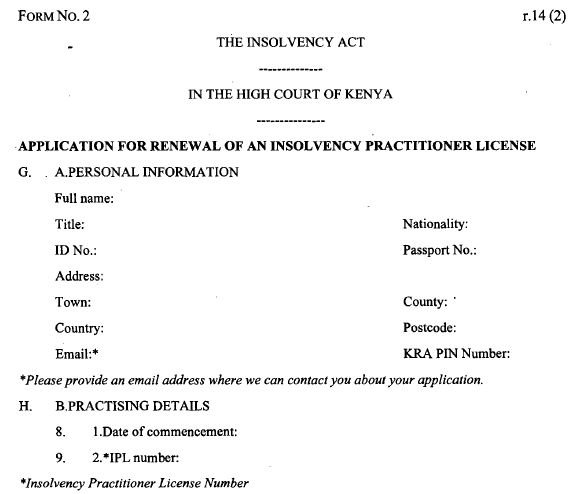
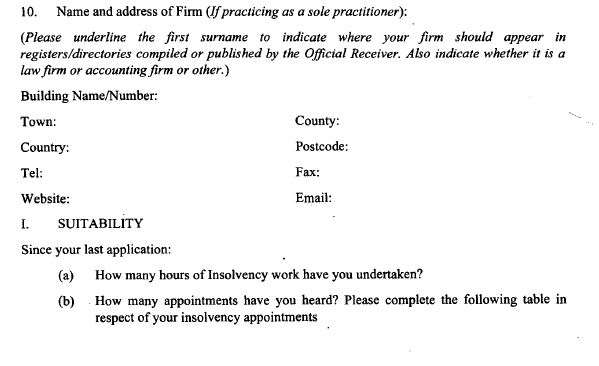
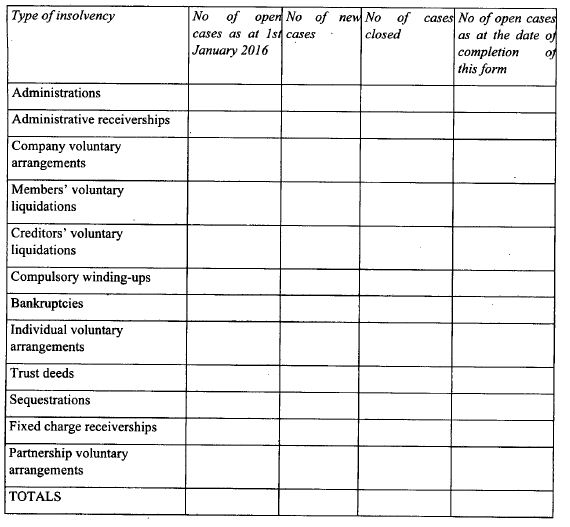
| (c) |
How many appointments do you currently hold? Please attach a complete list of all appointments currently held.
|
| (d) |
How many cases where you were appointed office-holder more than five years ago? Please list below all open cases where you were appointed office-holder more than five years ago (continue on a separate sheet if necessary).
|
| (e) |
Have you been or are you the subject of a bankruptcy order, sequestration order, voluntary arrangement, deed, scheme, composition or other form of agreement or debt management plan with your creditors; or are there any proceedings pending?
|
| (f) |
Have you had any judgments entered against you; and are there any still outstanding?
|
| (g) |
Have you been the proprietor or partner in any business or been a director of or involved in the management of, any other company which ceased trading leaving creditors unpaid?
|
| (h) |
Have you been refused admission to, or been removed from, any professional body or similar association; or is there any action pending?
|
| (i) |
Have you been the subject of any adverse findings by the any professional body or any government, statutory or regulatory authority (including the office of the Official Receiver) in relation to any matters, whether by way of financial penalty or other disciplinary action (including reprimands, warnings and undertakings); or are there any matters (including complaints) currently being considered by any of them?
|
| (j) |
Have you been the subject of proceedings alleging negligence, misconduct or other liability in relation to an insolvency or other professional matter; or are there any proceedings pending?
|
| (k) |
Have you been convicted of any criminal offence, other than a minor motoring offence not resulting in disqualification; or are there any proceedings pending?
|
| (l) |
Have you been removed or dismissed from any form of employment or engagement on grounds of misconduct, incompetence or unfitness, or from any fiduciary office or position of trust (whether or not remunerated) including as an insolvency office holder; or is there any action pending?
|
| (m) |
Have you been or are you a patient within the meaning of Part V and VI of the Mental Health Act (Chapter 248) of the Laws of Kenya?
|
| (n) |
Do you, or your firm have Professional Indemnity Insurance (PII) cover in place which is current and meets the requirements of the Insolvency Regulations. If YES, please specify the PII policy you hold and the expiry date of this policy.
|
| (o) |
Do you, or your firm have a bond? if ‘YES’, please enter the expiry date of date of the Bond. If ‘NO’, please confirm you will obtain a Bond upon approval of this application and that you will forward a copy to the Official Receiver upon receipt.
|
|
| 1. |
I hereby apply for a renewal of my Insolvency Practitioner License, for which I believe I am suitable.
|
| 2. |
I acknowledge that I am bound by the Insolvency Practice Articles, Rules, Regulations and Guidance in relation to my membership.
|
| 3. |
The information provided by me in this application is true, and I have disclosed here all and every facts and circumstances which are material to consideration of my application. I understand that any false, inaccurate or misleading information provided by me may lead to a refusal of my application, or disciplinary action in relation to, and suspension or withdrawal of my Insolvency Practitioner License.
|
| 4. |
I will immediately notify the office of the Official Receiver of any material change in the information provided by me here, whether it arises before or after my admission to membership.
|
| 5. |
I understand that the office of the Official Receiver may seek information relevant to a proper consideration of my application from my current and past employers and from other third parties; and I hereby consent to the disclosure by my present and past employers and other third parties to the office of the Official Receiver.
|
| 6. |
I am aware that an Insolvency License if granted to me by the Official Receiver will remain in effect for one year, and it is renewed annually by me on the conditions set out by the Insolvency Practice Articles, Rules, Regulations and Guidance, and that if the license is not renewed by me that it will expire.
|
| 7. |
That I understand that ceasing to be a license holder does not remove my obligation to pay outstanding fees and to provide information and returns concerning appointments and that the Official Receiver, under the insolvency legislation, is able to make applications to court for the transfer of cases from insolvency practitioners whom it authorizes. Such transfers may arise both during the period of a license or after a member has ceased to be authorized. I understand that the Official Receiver may seek to recover the costs of such transfers from the former insolvency license holder.
|
| 8. |
I attach the following (delete where appropriate):
• List of all appointments currently held.
• Copy of Professional Indemnity Insurance and bond.
• Copy of my IP authorization; or Copy of my appointment as an official receiver or equivalent grade
• Letters from my two sponsors (please note this should also confirm your experience)
• Signed and dated explanatory notes
• My subscription fees

|
| 1. |
That the said A.B. has within the period of one year preceding the presentation of this petition resided [or carried on business] at .................................. within the jurisdiction of this Court.
|
| 2. |
That the said A.B. is justly and truly indebted to me [or us] in the aggregate in the sum of £ ................ [set out amount of debt, debtors and the consideration].
|
| 3. |
That I [or we] do not, nor does any person on my [or our] behalf hold any security on the said debtor’s estate, or any part thereof, for the payment of the said sum.
| (b) |
Insert present address and description of debtor.
|
| (c) |
Insert address or addresses at which the debtor has lately resided or carried on business.
|
Note.—The address at which the debtor was residing or carrying on business when the petitioning creditor’s debt was incurred should in all cases appear in the petition
or
That I hold security for the payment of [or part of] the said sum, but that I will give up such security for the benefit of the creditors of A.B. in the event of his being adjudged bankrupt [or and I estimate the value of such security at the sum of KSh. …...........]
or
That I, C.D., one of your petitioners, hold security for the payment of, & c.
or
That I, E.F., another of your petitioners, hold security for the payment of, &c.
|
| 4. |
That amount owed by A.B. is within the prescribed bankruptcy level in accordance with the Insolvency Act and Rules
|
| 5. |
That A. B. is unable or has no reasonable prospect of paying the debt
|
| 6. |
There is no outstanding application to set aside the statutory demand in respect of the debt owed to me by A.B.
|
| 7. |
That twenty one days have elapsed since I served the statutory demand upon A. B. and neither has he complied with or set aside the statutory demand.
|
| 8. |
That atleast two years before this petition, A. B. has committed various bankruptcy offences, namely [here set out the nature and date or dates of the bankruptcy offences relied on].

Note—If there is more than one petitioner, and they do not sign together, the signature of each shall be separately attested, e.g. “Signed by the petitioner E.F. in my presence”, etc. If the petition is signed by a firm, the partner signing should add also his own signature, e.g. “A.S. & Co. F.S., a partner in the said firm”. If the debtor resides at any place other than the place where he carried on business both addresses should be inserted.
|
This petition having been presented to the Court on the ..................... day of ............................., 20................., it is ordered that this petition shall be heard at [insert the place at which the debtor is to attend on the Receiver] on the ................ day of ..................., 20 ............., at .................. o’clock in the ......................... noon.
And you the said A.B. are to take notice that if you intend to dispute the truth of any of the statements contained in the petition you shall file with the Registrar of this Court a notice showing the grounds upon which you intend to dispute the same, and send by post a copy of the notice to the petitioner [three] days before the date fixed for the hearing.
SECOND SCHEDULE
Part I - PROFESSIONAL INDEMNITY COVER AND BOND
THIRD SCHEDULE [Regs. 12(6), 47, 114(2),115(2), 125, 131,135 & 137, L.N. 7/2018, r. 45(e), L.N. 78/2018.]
RULES FOR CONDUCT OF MEETINGS OF CREDITORS AND OTHERS
PART I—APPLICATION OF THIS SCHEDULE
| 1. |
Interpretation and scope
| (1) |
The rules set out in this Schedule apply to—
| (a) |
meetings of creditors’ committees in bankruptcies and voluntary arrangements entered into by natural persons; and
|
| (b) |
meetings of liquidation committees in members’ or creditors’ voluntary liquidations, liquidations by the Court and voluntary arrangements entered into by companies, and to decisions taken or to be taken at those meetings.
|
|
| (2) |
Part 10 applies to company meetings.
|
| (3) |
In this Part—
“actual meeting” means a meeting at which the creditors or other persons concerned are present in person or through their proxies;
“decision date” means the date when a decision is to be made in a meeting;
“convenor” means an office holder who, by a provision of the Act, is required or authorised to convene a meeting comprising or including creditors;
“correspondence” includes correspondence conducted by e-mail or other electronic means;
“meeting” means an actual meeting, or virtual meeting or a meeting conducted by correspondence unless the contrary indication is given;
“office holder” means the Official Receiver, a bankruptcy trustee, supervisor, provisional supervisor, administrator, liquidator or provisional liquidator as appropriate;
“prescribed threshold” means ten per centum of the total amount of claims made by creditors;
“virtual meeting” means a meeting of persons who, although are not actually present together, are able to participate contemporaneously, including communicating directly with all the other participants in the meeting and voting, either directly or through proxies.
|
| (4) |
The decision date is to be set at the discretion of the convenor, but may be not less than fourteen days from the date of sending of the notice, except when the table in rule 8 requires a different period.
|
| (5) |
The rules in this Schedule about meetings by creditors also apply, with appropriate modifications, to meetings of or including contributories.
|
| (6) |
In particular, in place of the requirement for percentages or majorities in decision making by creditors to be determined by value, if the meeting seeks a decision from contributories the value is required to be determined on the basis of the percentage of voting rights in accordance with rule 35.
|
| (7) |
A reference to a decision in these rules includes when such a decision is signified by resolution passed at a meeting.
|
| (8) |
When a convenor or office-holder is required to give notice to all the creditors, the office-holder is only required to give notice to those creditors of whose address the convenor or office-holder is aware.
|
|
| 2. |
The prescribed meetings
The following meetings are meetings by which a convenor may seek from creditors a decision under the Act or these Regulations—
| (a) |
a meeting conducted by means of correspondence;
|
|
| 3. |
Virtual meetings
If the meeting is a virtual meeting, the notice sent or sent to creditors is required—
| (a) |
to specify any necessary information as to how to access the virtual meeting including any telephone number, access code or password required; and
|
| (b) |
to include a statement that the meeting may be suspended or adjourned by the person presiding at the meeting and is required to be adjourned if it is so resolved at the meeting.
|
|
| 4. |
Actual meetings
| (1) |
A request for an actual meeting may be made before or after the notice of the meeting has been sent or sent, but is to be made not later than seven days after the date on which the convenor sent or sent the notice of the meeting, unless these rules provide to the contrary.
|
| (2) |
The convenor is responsible for checking whether any requests for an actual meeting are submitted before the relevant deadline and, if so, whether in aggregate they meet or surpass one of the thresholds requiring an actual meeting to be held.
|
| (3) |
If the prescribed proportion of creditors require an actual meeting, the convenor shall convene the meeting by giving a notice—
| (a) |
that complies with rule 5 so far as applicable; and
|
| (b) |
that also contains a statement that the meeting may be suspended or adjourned by the person presiding at the meeting, and is required to be adjourned if it is so resolved at the meeting.
|
|
| (4) |
In addition, the convenor shall include in the notice a statement to the effect that as a result of the requirement to hold an actual meeting the original meeting is now superseded.
|
| (5) |
The convenor shall send the notice under paragraph (3) not later than seven days after one of the thresholds requiring the holding of an actual meeting has been met or surpassed.
|
| (6) |
The convenor may permit a creditor to attend an actual meeting remotely if the convenor receives a request to do so in advance of the meeting.
|
| (7) |
The convenor shall include in the notice of the meeting a statement explaining the effect of paragraph (6).
|
| (8) |
In this rule, attending an actual meeting “remotely” means attending and being able to participate in the meeting without being at the venue where the meeting is being held.
|
|
| 5. |
Notices to creditors of meetings
| (1) |
This rule sets out the requirements for notices to creditors if a decision is sought by a meeting.
|
| (2) |
The convenor shall send a notice to every creditor who is entitled to notice of the meeting, which notice shall be in Form 16 set out in the First Schedule.
|
| (3) |
The notice is required to include the following—
| (a) |
details of the decision to be made or of any resolution on which a decision is sought;
|
| (b) |
a description of, and arrangements for, the meeting;
|
| (c) |
a statement of the decision date;
|
| (d) |
a statement of the date by which the creditor is required to send a proof in respect of the creditor’s claim in accordance with these Regulations failing which a vote by the creditor shall be disregarded;
|
| (e) |
a statement that a creditor owed an amount that is in total less than one million shillings and who does not send a proof to the convenor shall not be able to vote;
|
| (f) |
a statement that a creditor who has opted out from receiving notices may nevertheless vote if the creditor provides a proof in accordance with subparagraph (d);
|
| (g) |
in the case of a decision to remove a bankruptcy trustee, a statement drawing the attention of creditors to the relevant section of the Act providing for the release of the trustee;
|
| (h) |
in the case of a decision to remove a liquidator in a creditors’ voluntary liquidation or a liquidation by the Court statement drawing the attention of creditors to the relevant section of the Act providing for the release of the liquidator;
|
| (i) |
in the case of a decision on a proposal in a company or individual voluntary arrangement, a statement of the effects of the following—
| (i) |
rule 19 about creditors’ voting rights; |
| (ii) |
rule 23 or 25 concerning the calculation of creditors’ voting rights; and |
| (iii) |
rule 26 or 28 concerning the requisite majority of creditors for making decisions; |
|
| (j) |
except in the case of an actual meeting, a statement that creditors who together satisfy the prescribed threshold may, within seven days from the date of sending of the notice, require an actual meeting to be held to consider the matter; and
|
| (k) |
in the case of a meeting, a statement that any proxy is required to be sent to the convenor or person presiding before it may be used at the meeting.
|
|
| (5) |
The notice is required to be authenticated and dated by the office-holder.
|
| (6) |
If the meeting is a meeting where the notice is required to be accompanied by a blank proxy complying with rule 43.
|
| (7) |
This rule does not apply if the Court orders under rule 9 that notice of a meeting be given by advertisement only.
|
|
| 6. |
Voting at a meeting
| (1) |
Except when votes are cast at an actual meeting, votes are required—
| (a) |
to be received by the convenor by the decision date; and
|
| (b) |
in the case of a vote cast by a creditor, to be accompanied by a proof in respect of the creditor’s claim.
|
|
| (2) |
In a bankruptcy, a company administration, a creditors’ voluntary liquidation, or a liquidation by the Court, a vote is, subject to rule 19(b)(ii), to be disregarded if—
| (a) |
a proof in respect of the claim is not received by the convenor before the decision date or, in the case of a meeting, 4 p.m. on the business day before the decision date; or
|
| (b) |
the convenor decides, in the application of Part 6 of this Schedule, that the creditor is not entitled to cast the vote.
|
|
| (3) |
In a voluntary arrangement entered into by a natural person or a company, a vote is to be disregarded if a proof in respect of the claim is not received by the convenor by the decision date.
|
| (4) |
For the decision to be made, the convenor is required to receive at least one valid vote by the decision date.
|
|
| 7. |
Venue for meeting
The convenor is required to have regard to the convenience of those invited to attend when fixing the venue, if applicable, for a meeting including the resumption of an adjourned meeting.
|
| 8. |
Notice of meetings: when and to whom sent
The convenor shall send notices of decisions in accordance with the following table:

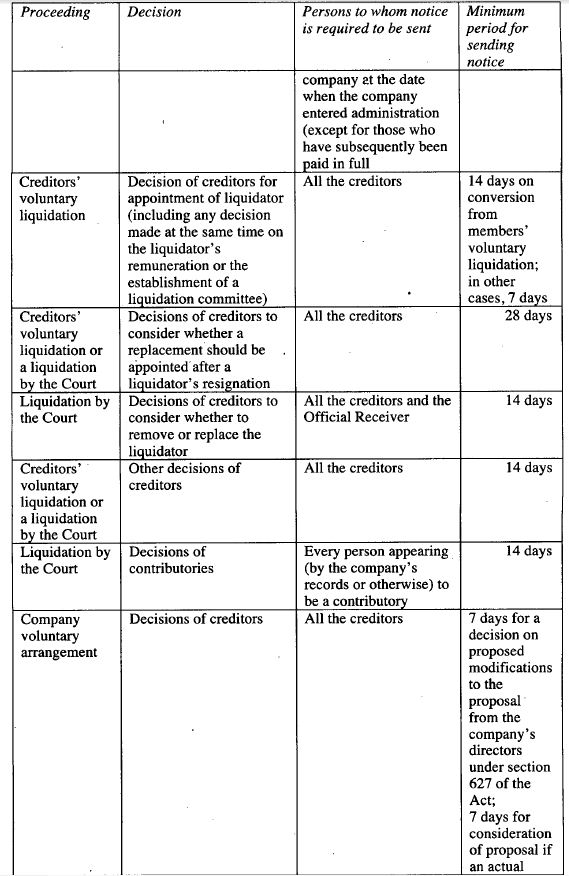
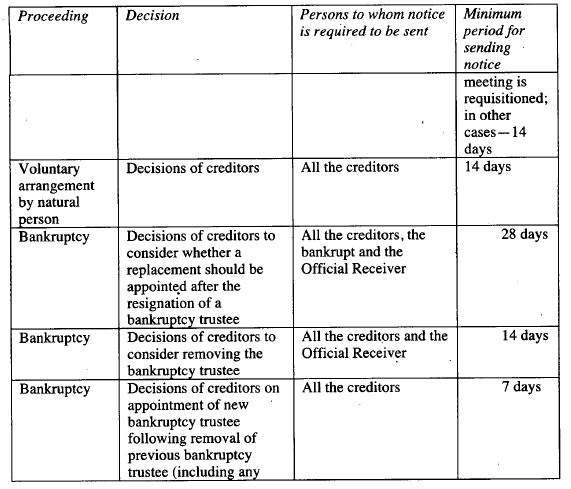
| (2) |
This rule does not apply if the Court orders under rule 9 that notice of a meeting be given by advertisement only.
|
|
| 9. |
Notice of meeting by advertisement only
| (1) |
The Court may order that notice of a meeting is to be given by advertisement only and not by individual notice to the persons concerned.
|
| (2) |
In considering whether to make such an order, the Court is required to have regard to the cost of advertisement, the amount of assets available and the extent of the interest of creditors, members and contributories or any particular class of them.
|
| (3) |
The advertisement is required to meet the requirements for a notice under rule 6, and is also required to state—
| (a) |
that the Court ordered that notice of the meeting be given by advertisement only; and
|
| (b) |
the date of the Court’s order.
|
|
|
| 10. |
Notification and advertisement of meeting
| (1) |
In a creditors’ voluntary liquidation, a liquidation by the Court, a company administration or a bankruptcy, when a decision is being sought by a meeting the convenor shall publish in the Kenya Gazette a notice of the meeting stating—
| (a) |
that a meeting of creditors or contributories is to take place,
|
| (b) |
the venue fixed for the meeting,
|
| (c) |
the purpose of the meeting; and
|
| (d) |
the time and date by which, and place at which, those attending shall send proxies and proofs, if not already sent, in order to be entitled to vote.
|
|
| (2) |
The notice is also required to state—
| (a) |
who is the convenor in respect of the meeting; and
|
| (b) |
if the meeting results from a request of one or more creditors, the fact that it was so convened and the section of the Act under which it was convened.
|
|
| (3) |
The notice is required to be published in the Kenya Gazette before or as soon as reasonably practicable after notice is sent in accordance with these rules.
|
| (4) |
Information to be published in the Kenya Gazette under this rule may also be advertised in such other manner as the convenor considers fit.
|
| (5) |
The convenor may publish in the Kenya Gazette other meetings in which case the equivalent information to that required by this rule is required to be stated in the notice.
|
|
| 11. |
Notice to company officers, bankrupts etc. in respect of meetings
(1) In a bankruptcy, notice of a meeting is required to be sent to the bankrupt.
| (2) |
In a bankruptcy, if the bankrupt is not required to attend the meeting, the notice is required to state—
| (a) |
that the bankrupt does not have to attend the meeting;
|
| (b) |
that if the bankrupt wishes to attend, the bankrupt shall communicate to the convenor as soon as reasonably practicable;
|
| (c) |
that whether the bankrupt will be allowed to participate in the meeting is at the discretion of the person presiding at the meeting; and
|
| (d) |
that the decision of the person presiding as to what intervention, if any, the bankrupt may make is final.
|
|
| (3) |
In a company administration, a creditors’ voluntary liquidation, a liquidation by the Court or a company voluntary arrangement, notice to participate in a creditors’ meeting is required to be sent to every present or former officer of the company whose presence the convenor believes is required.
|
| (4) |
If a notice given to a person under this rule states that the person is required to attend the meeting, the person is required to comply with the requirement.
|
| (5) |
Notices under this rule are required to be sent in compliance with the minimum notice requirements set out in rule 8.
|
|
| 12. |
Non-receipt of notice of decision
If a decision is sought by notice in accordance with the Act or these rules, the meeting is presumed to have been duly initiated and conducted, even if not everyone to whom the notice is to be sent has received it.
|
| 13. |
Requisition of decision
| (1) |
In this Part, “requisitioned meeting requested under the following sections of the Act—
| (a) |
section 53 (circumstances in which Official Receiver may decide not to convene first meeting of creditors);
|
| (b) |
section 55 (power of creditors to requisition meetings);
|
| (c) |
section 78(4) (vacancy in office of bankruptcy trustee);
|
| (d) |
section 82(2) (subsequent meetings of creditors);
|
| (e) |
section 437(5)(c) (appointment and powers of provisional liquidators);
|
| (f) |
section 441(3) (appointment of liquidator by the Court following administration or voluntary arrangement);
|
| (g) |
section 465(2) (liquidator’s functions: supplementary powers);
|
| (h) |
section 568 (liquidator may be removed only by the Court or by general meeting of creditors in the case of company being liquidated by the Court); and
|
| (i) |
section 573(1) (power of administrator to convene further creditors’ meetings).
|
|
| (2) |
A request for a meeting under section 465(2) of the Act is required to be sent within fourteen days after the date on which the administrator’s statement of proposals is sent.
|
| (3) |
A request for a requisitioned meeting is required to include a statement of the purpose of the proposed meeting and either a statement of the requesting creditor’s claim or contributory’s value, together with—
| (a) |
a list of the creditors or contributories concurring with the request and of the amounts of their respective claims or values;
|
| (b) |
confirmation of concurrence from each creditor or contributory concurring; and
|
| (c) |
a statement of the requesting creditor’s debt or contributory’s value and that that alone is sufficient without the concurrence of other creditors or contributories.
|
|
| (4) |
A contributory’s value referred to under paragraph (3) is the amount for which the contributory may vote in any meeting.
|
| (5) |
A meeting is required to be instigated under section 467(2)(b) of the Act for the removal of the liquidator, other than a liquidator appointed by the Court under section 416 of the Act, if twenty five per centum in value of the company's creditors, excluding those who are connected with the company, request it.
|
| (6) |
If a meeting under section 75(4)(c), 467(2)(b) or 467(3) of the Act is to be instigated, or is proposed to be instigated, the Court may, on the application of any creditor, give directions as to the meeting to be used and any other matter which appears to the Court to require regulation or control.
|
| (7) |
If the Official Receiver receives a request under paragraph (5)(c) of section 438 of the Act and it appears that it is properly made, the Official Receiver shall withdraw any notices previously given under paragraph (5)(b) of that section and act in accordance with Part 2 of this Schedule as if the Official Receiver had decided to seek nominations under section 439 of the Act.
|
|
| 14. |
Expenses and timing of requisitioned meeting
| (1) |
The convenor shall, not later than fourteen days after receiving a request for a requisitioned meeting, inform the requesting creditor or contributory of the amount to be deposited as security for payment of the expenses of such procedure.
|
| (2) |
The convenor is not obliged to initiate the meeting until either—
| (a) |
the convenor has received the required amount; or
|
| (b) |
fourteen days have expired without the convenor having informed the requesting creditor or contributory of the amount required to be deposited as security.
|
|
| (3) |
A requisitioned meeting is required to be held—
| (a) |
if requested under section 438(5)(c) of the Act, within three months; or
|
| (b) |
in any other case, within twenty eight days,
|
after the date on which the earlier of the events specified in paragraph (2) occurs.
|
| (4) |
The expenses of a requisitioned meeting are to be paid out of the deposit, if any, unless—
| (a) |
the creditors decide that they are to be payable as an expense of the administration, liquidation or bankruptcy; and
|
| (b) |
in the case of a decision of contributories, the creditors are first paid in full, with interest.
|
|
| (5) |
The notice of a requisitioned meeting of creditors is required to contain a statement that the creditors may make a decision under paragraph (4)(a).
|
| (6) |
Unless the creditors otherwise decide, the expenses are to be paid by the requesting creditor or contributory to the extent that the deposit, if any, is insufficient.
|
| (7) |
To the extent that the deposit, if any, is not needed for payment of the expenses, it is required to be repaid to the requesting creditor or contributory.
|
|
| 15. |
Quorum at meeting
| (1) |
A meeting is not competent to act unless a quorum is in attendance.
|
| (2) |
| (a) |
in the case of a meeting of creditors, at least one creditor entitled to vote;
|
| (b) |
in the case of a meeting of contributories, at least two contributories entitled to vote, or all the contributories, if their number does not exceed two.
|
|
| (3) |
If a quorum is satisfied in accordance with this rule by the person presiding alone or the person presiding and one additional person, but the person presiding is aware, either because of proofs and proxies received or otherwise, that one or more additional persons would, if attending, be entitled to vote, the person presiding is required to delay the start of the meeting by at least fifteen minutes after the time fixed for the meeting.
|
| (4) |
If there is no quorum as per section 402 of the Act, the liquidator shall issue a notice in Form 32I set out in the First Schedule, to the Registrar.
[L.N. 7/2018, r. 45(e).]
|
|
| 16. |
Who can preside over meetings
The following persons are eligible to preside at a meeting—
| (c) |
if the convenor is the Official Receiver, a person appointed by the Official Receiver.
|
|
| 17. |
Attendance by other persons
The person presiding at a meeting may—
| (a) |
allow any person who has given reasonable notice to attend to participate in a virtual meeting or to be admitted to an actual meeting;
|
| (b) |
decide what intervention, if any, may be made at—
| (i) |
a meeting of creditors by any person attending who is not a creditor; or |
| (ii) |
a meeting of contributories by any person attending who is not a contributory; |
|
| (c) |
decide what questions may be put to—
| (i) |
any present or former officer of the company; or |
|
|
| 18. |
Adjournment by person presiding
| (1) |
The person presiding may, and shall if it is so resolved, adjourn a meeting for not more than fourteen days, but subject to any direction of the Court and to rule 19.
|
| (2) |
Further adjournment under this rule may not be to a day later than fourteen days after the date on which the meeting was originally held, subject to any direction by the Court.
|
| (3) |
However, in a company voluntary arrangement, the person presiding may, and shall if the meeting so resolves, adjourn a meeting convened under section 663 of the Act, provisional supervisor to convene meetings of creditors and others, to a day that is not more than fourteen days after the date on which the moratorium, including any extension, ends.
|
|
| 19. |
Adjournment of meetings to remove a bankruptcy trustee or liquidator
| (1) |
| (a) |
the person who is presiding at a meeting to remove a bankruptcy trustee in a bankruptcy is the trustee; and
|
| (b) |
a resolution has been proposed for the trustee’s removal,
|
that person may not adjourn the meeting without the consent of at least one-half, in value, of the creditors attending and entitled to vote.
|
| (2) |
| (a) |
the person who is presiding at a meeting to remove the liquidator in a creditors’ voluntary liquidation or a liquidation by the Court is the liquidator; and
|
| (b) |
a resolution has been proposed for the liquidator's removal,
|
that person may not adjourn the meeting without the consent of at least one-half ,in value, of the creditors attending and entitled to vote.
|
|
| 20. |
Adjournment in absence of person presiding
| (1) |
If no one attends to act as person presiding within thirty minutes after the time fixed for the meeting to start, then the meeting is adjourned to the same time and place the following week or, if that is not a business day, to the business day immediately following.
|
| (2) |
If no one attends to act as person presiding within thirty minutes after the time fixed for the meeting after a second adjournment under this rule, the meeting comes to an end.
|
|
| 21. |
Proofs in adjournment
If a meeting in a bankruptcy, company administration, a creditors’ voluntary liquidation, or a liquidation by the Court is adjourned, proofs may be used—
| (a) |
if sent not later than 4 p.m. on the business day immediately before resumption of the adjourned meeting; or
|
| (b) |
after that time if the person presiding is willing to accept the proof.
|
|
| 23. |
Suspension of meetings
The person presiding at a meeting may, without an adjournment, declare the meeting suspended for one or more periods not exceeding one hour in total or, in exceptional circumstances, such longer total period during the same day at that person’s discretion.
|
| 24. |
Creditors’ voting rights
| (1) |
In a bankruptcy, a company administration, a creditors’ voluntary liquidation, a liquidation by the Court, a creditor is entitled to vote in a meeting only if—
| (a) |
the creditor has sent to the convenor a proof of the debt claimed in accordance with paragraph (2), including any calculation for the purposes of rule 25 or 26; and
|
| (b) |
the proof was sent to the convenor—
| (i) |
not later than 4 p.m. on the business day before the meeting; or |
| (ii) |
after that time if the person presiding is content to accept the proof; |
|
| (c) |
the proof has been admitted for the purposes of entitlement to vote; and
|
| (d) |
there has been sent to the convenor or person presiding a proxy intended to be used on behalf of that person.
|
|
| (2) |
A debt is claimed in accordance with this paragraph if it is—
| (a) |
claimed as due from the company or bankrupt to the person seeking to be entitled to vote; or
|
| (b) |
in relation to a liquidator, claimed to be due to creditors in proceedings in relation to which the liquidator holds office.
|
|
| (3) |
The convenor or person presiding may call for any document or other evidence to be produced if he or she considers it necessary for the purpose of substantiating the whole or any part of a claim.
|
| (4) |
In a voluntary arrangement entered into by a natural person or a company, each creditor, secured or unsecured, who has notice of the meeting is entitled to vote in respect of the creditor’s debt.
|
|
| 25. |
Calculation of voting rights
| (1) |
Votes are to be calculated according to the amount of each creditor’s claim in a bankruptcy, as set out in the creditor’s proof to the extent that it has been admitted.
|
| (2) |
Votes are to be calculated according to the amount of each creditor’s claim in a voluntary arrangement entered into by a natural person—
| (a) |
if the debtor is not an undischarged bankrupt—
| (i) |
at the date interim order, if an interim order is in force; or |
| (ii) |
otherwise, at the decision date; or |
|
| (b) |
if the debtor is an undischarged bankrupt, at the date of the notice of the meeting.
|
|
| (3) |
Votes are to be calculated according to the amount of each creditor’s claim in a company administration, as at the date on which the company entered administration, less—
| (a) |
any payments that have been made to the creditor after that date in respect of the claim; and
|
| (b) |
if notice of declaration of a dividend has not been sent in accordance with rule 33, any adjustment by way of set-off in accordance with rule 21 as if that rule were applied on the date on which the votes are counted; and
|
| (c) |
if notice of declaration of a dividend has been sent in accordance with rule 33, any adjustment by way of set-off in accordance with rule 21 that has actually been made in calculating the dividend to be paid to the creditor.
|
|
| (4) |
Votes are to be calculated according to the amount of each creditor’s claim in a creditors’ voluntary liquidation or a liquidation by the Court as set out in the creditor’s proof to the extent that it has been admitted.
|
| (5) |
Votes are to be calculated according to the amount of each creditor’s claim in a voluntary arrangement entered into by a company—
| (a) |
at the date the company went into liquidation if the company is being liquidated;
|
| (b) |
at the date the company entered into administration, less any payments made to the creditor after that date in respect of the claim, if it is in administration;
|
| (c) |
at the beginning of the moratorium if a moratorium has been obtained; or
|
| (d) |
if subparagraphs (a) to (c) do not apply, at the relevant decision date.
|
|
| (6) |
A creditor may vote in respect of a debt of an unliquidated or unascertained amount if the convenor or person presiding decides to place an estimated minimum value on it for the purpose of entitlement to vote and admits the claim for that purpose.
|
| (7) |
However, in a voluntary arrangement entered into by a natural person or a company, a debt of an unliquidated or unascertained amount is to be valued at one thousand shillings for the purposes of voting unless the convenor or person presiding or an appointed person decides to place a higher value on it.
|
| (8) |
If a debt is wholly secured, its value for voting purposes is nil.
|
| (9) |
If a debt is partly secured its value for voting purposes is the value of the unsecured part.
|
| (10) |
However, the value of the debt for voting purposes is its full value without deduction of the value of the security in the following cases—
| (a) |
if the administrator has made a statement under subsection (1)(b) of section 569(1)(b) of the Act and the administrator has been requested to seek a decision under subsection (2) of that section;
|
| (b) |
if in a company voluntary arrangement there is a decision on whether to extend or further extend a moratorium or to bring a moratorium to an end before the end of the period of any extension.
|
|
| (11) |
On a motion put to a meeting, a vote may be cast only once on the basis of a claim.
|
| (12) |
Paragraph (11) does not prevent a creditor or liquidator from—
| (i) |
voting in respect of less than the full value of an entitlement to vote; or |
| (ii) |
casting a vote one way in respect of part of the value of an entitlement and another way in respect of some or all of the balance of that value. |
|
|
| 26. |
Calculation of voting rights: special cases
| (1) |
In a company administration, a creditor under a credit purchase agreement is entitled to vote in respect of the amount of the debt due and payable by the company on the date on which the company entered administration.
|
| (2) |
In calculating the amount of any debt for the purpose of paragraph (1), no account is to be taken of any amount attributable to the exercise of any right under the relevant agreement so far as the right has become exercisable solely because of—
| (a) |
the making of a company administration application;
|
| (b) |
a notice of intention to appoint an administrator or any matter arising as a consequence of the notice; or
|
| (c) |
the company entering administration.
|
|
|
| 27. |
Procedure for admitting creditors’ claims for voting
| (1) |
The convenor or person presiding at a meeting shall ascertain entitlements to vote and admit or reject claims accordingly.
|
| (2) |
The convenor or person presiding may admit or reject a claim in whole or in part.
|
| (3) |
If the convenor or person presiding is in any doubt whether a claim should be admitted or rejected, the convenor or person presiding shall mark it as objected to and allow votes to be cast in respect of it, subject to those votes being subsequently declared invalid if the objection to the claim is upheld.
|
|
| 28. |
Requisite majorities
| (1) |
A decision is made by creditors when a majority (in value) of those voting have voted in favour of the proposed decision, except when this rule provides otherwise.
|
| (2) |
In the case of a company administration, a decision is invalid if those voting against it include more than half in value of the creditors to whom notice of the meeting was sent and who are not, to the best of the belief of the convenor or person, persons connected with the company.
|
| (3) |
Each of the following decisions in a company voluntary arrangement is made when three-quarters or more (in value) of those responding vote in favour of it—
| (a) |
a decision approving a proposal or a modification;
|
| (b) |
a decision extending or further extending a moratorium; or
|
| (c) |
a decision bringing a moratorium to an end before the end of the period of any extension.
|
|
| (4) |
In a company voluntary arrangement a decision is not made if more than half of the total value of the unconnected creditors vote against it.
|
| (5) |
For the purposes of paragraph (4)—
| (a) |
a creditor is unconnected unless the convenor or person presiding decides that the creditor is connected with the company;
|
| (b) |
in deciding whether a creditor is connected reliance may be placed on the information provided by the company’s statement of affairs or otherwise in accordance with these rules; and
|
| (c) |
the total value of the unconnected creditors is the total value of those unconnected creditors whose claims have been admitted for voting.
|
|
| (6) |
In the case of a voluntary arrangement entered into by a natural person—
| (a) |
a decision approving a proposal or a modification is made when three-quarters or more (in value) of those responding vote in favour of it;
|
| (b) |
a decision is not made if more than half of the total value of creditors who are not associates of the debtor vote against it.
|
|
| (7) |
For the purposes of paragraph (6), a creditor is not an associate of the debtor unless the convenor or person presiding decides that the creditor is an associate of the debtor.
|
|
| 29. |
Procedure for admitting creditors’ claims for voting
| (1) |
The convenor of, or the person presiding at, a meeting shall ascertain entitlement to vote and admit or reject claims accordingly.
|
| (2) |
The convenor or person presiding may admit or reject a claim in whole or in part.
|
| (3) |
If the convenor or person presiding is in any doubt whether a claim should be admitted or rejected, the convenor or person presiding shall mark it as being objected to and allow votes to be cast in respect of it, subject to those votes being subsequently declared invalid if the objection to the claim is sustained.
|
|
| 30. |
Requisite majorities
| (1) |
A decision is made by creditors when a majority (in value) of those voting have voted in favour of the proposed decision, except where this rule provides otherwise.
|
| (2) |
In the case of a voluntary arrangement entered into by a natural person—
| (a) |
a decision approving a proposal or a modification is made when three-quarters or more (in value) of those responding vote in favour of it; and
|
| (b) |
a decision is not made if more than half of the total value of creditors who are not associates of the debtor vote against it.
|
|
| (3) |
For the purposes of paragraph (2)—
| (a) |
a creditor is not an associate of the debtor unless the convenor or person presiding decides that the creditor is an associate of the debtor;
|
| (b) |
in deciding whether a creditor is an associate of the debtor, reliance may be placed on the information provided by the debtor’s statement of affairs or otherwise in accordance with these rules; and
|
| (c) |
the total value of the creditors who are not associates of the debtor is the total value of the creditors who are not associates of the debtor whose claims have been admitted for voting.
|
|
| (4) |
In the case of a company administration, a decision is invalid if those voting against it include more than half in value of the creditors to whom notice of the meeting was sent and who are not, to the best of the convenor or person presiding’s belief, persons connected with the company.
|
| (5) |
Each of the following decisions in a company voluntary arrangement is made when seventy five percentum or more (in value) of those responding vote in favour of it—
| (a) |
a decision approving a proposal or a modification;
|
| (b) |
a decision extending or further extending a moratorium; or
|
| (c) |
a decision bringing a moratorium to an end before the end of the period of any extension.
|
|
| (6) |
In a company voluntary arrangement, a decision is not effective if more than half of the total value of the unconnected creditors vote against it.
|
| (7) |
For the purposes of paragraph (6)—
| (a) |
a creditor is unconnected unless the convenor or person presiding decides that the creditor is connected with the company;
|
| (b) |
in deciding whether a creditor is connected, reliance may be placed on the information provided by the company’s statement of affairs or otherwise in accordance with these rules; and
|
| (c) |
the total value of the unconnected creditors is the total value of those unconnected creditors whose claims have been admitted for voting.
|
|
|
| 31. |
Appeals against decisions under these rules
| (1) |
A decision of the convenor or person presiding under these the rules is subject to appeal to the Court by any creditor, a contributory, or the bankrupt or debtor.
|
| (2) |
In a company voluntary arrangement, an appeal against a decision under these rules may also be made by a member of the company.
|
| (3) |
If on appeal a decision is reversed or varied, or votes are declared invalid, the Court may—
| (a) |
order another meeting to be held; or
|
| (b) |
make such other order as it considers appropriate.
|
|
| (4) |
However, in a voluntary arrangement (whether entered into by a natural person or a company), the Court may make an order only if it considers that the circumstances that led to the appeal give rise to unfair prejudice or material irregularity.
|
| (5) |
An appeal under this rule cannot be made more than twenty one days after the decision date.
|
| (6) |
Paragraph (5) does not apply in a voluntary arrangement entered into by a natural person if an appeal cannot be made after the end of the period of twenty eight days beginning with—
| (a) |
if an interim order has not been obtained—the day on which the notice of the result of the consideration of the proposal required by subsection (1)(a) of section 307 of the Act has been given; or
|
| (b) |
in any other case—the day on which the report required by subsection (1)(b) of that section 307 is made to the Court.
|
|
| (7) |
Paragraph (5) does not apply in a voluntary arrangement entered into by a company if an appeal cannot be made after the end of the period of twenty eight days beginning with the day on which the first of the reports required by section 629 of the Act was lodged with the Court.
|
| (8) |
The person who made the decision is not personally liable for costs incurred by any person in relation to an appeal under this rule unless the Court makes an order to that effect.
|
| (9) |
The Court may not make an order under paragraph (8) if the person who made the decision in a bankruptcy or in a liquidation by the Court is—
| (a) |
the Official Receiver; or
|
| (b) |
a person nominated by the Official Receiver.
|
|
|
| 31A. |
Equal treatment of creditors within a class
For the purpose of this Part creditors in the same class shall be treated equally in relation to each claim or interest of a particular class, unless the holder of a particular claim or interest agrees to a less favourable treatment of such particular claim or interest.
[L.N. 78/2018, r. 5(a).]
|
| 31B. |
Creditors claim in the liquidation
| (1) |
A creditor, including a creditor who has a preferential claim, who wishes to claim in the liquidation, shall submit a creditor's claim to the liquidator before the deadline for submitting claims.
|
| (2) |
The liquidator may accept such a claim only if the claim is in Form 5 as set out in the First Schedule.
|
| (3) |
For the purpose of sub-paragraph (1), the deadline is either —
| (a) |
the time specified by the liquidator in a notice given to the creditor; or
|
| (b) |
the time specified in an advertisement published by the liquidator in a newspaper widely circulating in the area in which the creditor normally resides or carries on business.
|
|
| (4) |
The creditor shall bear the costs of proving the debt, unless the Court makes an order as to the creditor's costs under paragraph 31 H.
|
| (5) |
The creditor may amend or withdraw the claim, but an amended claim has to comply with the formalities prescribed for the original claim.
[L.N. 78/2018, r. 5(b).]
|
|
| 31C. |
Liquidator's examination of creditors claim
| (1) |
The liquidator shall examine each creditor's claim and the grounds of the debt, unless of the opinion that no dividend will be paid to creditors.
|
| (2) |
As soon as practicable after examining a claim, the liquidator shall do one or more of the following —
| (a) |
wholly or partly allow the claim;
|
| (b) |
wholly or partly reject the claim; or
|
| (c) |
require further evidence in support of the claim or an item contained in it. [L.N. 78/2018, r. 5(b).]
|
|
|
| 31D. |
Notice to creditor of a rejected claim
As soon as practicable after rejecting a creditor's claim, or a part of it, the liquidator shall give the creditor a notice rejecting the claim and specifying the grounds for the rejection.
[L.N. 78/2018, r. 5(b).]
|
| 31E. |
Directors or creditors notice to the liquidations
| (1) |
The company's directors or any creditor may give the liquidator notice to allow or reject a creditor’s claim.
|
| (2) |
If the liquidator has not made a decision allowing or rejecting the creditor's claim within fourteen days after receiving the claim, the creditor or the directors may apply to the Court for an order under subparagraph (3).
|
| (3) |
On the hearing of an application made under sub-paragraph (2), the Court shall, if it finds the claim —
| (a) |
to be substantiated or partly substantiated, make an order allowing the claim or partly allowing the claim; or
|
| (b) |
is wholly or partly unsubstantiated, make an order rejecting or partly it, and in either case may make such other order of an ancillary nature as it considers appropriate.
|
|
|
| 31F. |
An application to court an improperly allowed creditors claim
| (1) |
The Official Receiver, the company's directors or a creditor may make an application to the Court for an order under sub-paragraph (2) on the ground that the liquidator improperly allowed a creditor's claim.
|
| (2) |
On the hearing of an application made under sub-paragraph (1), the Court may make an order cancelling the creditor's claim or reducing the amount claimed, if it considers that the claim was improperly allowed or was improperly allowed in part.
[L.N. 78/2018, r. 5(b).]
|
|
| 31G. |
Creditors application to court for a rejected creditors claim
| (1) |
A creditor whose claim has been rejected by the liquidator may apply to the Court to make an order under sub-paragraph (3).
|
| (2) |
The application under sub-paragraph (1) can only be made within twenty-one days after the creditor receives the liquidator's notice of rejection of the claim, or within such extended period as the Court may allow.
|
| (3) |
On the hearing of an application made under sub-paragraph (1), the Court shall, if it considers that the liquidator's decision was—
| (a) |
wholly justified, confirm the decision; or
|
| (b) |
only partly justified, confirm the decision as to that part and quash the rest of the decision, but if it considers that the decision was wholly unjustified, it shall quash the decision.
|
|
| (4) |
A creditor has no right to prove for a debt that has been rejected by the liquidator, unless the creditor has made an application under this paragraph.
[L.N. 78/2018, r. 5(b).]
|
|
| 31H. |
Service of a copy of the application in paragraph 31B
| (1) |
This paragraph applies to an application made under paragraph 31B(1).
|
| (2) |
If the applicant is not the liquidator, the applicant shall serve a copy of the application on the liquidator as a party to the proceeding.
|
| (3) |
If the applicant is not the directors or a creditor who is affected by the decision of the liquidator, the applicant shall serve a copy of the application on the directors or that creditor.
|
| (4) |
On being served with a copy of the application, the directors or creditor may give notice to the Court that the directors or creditor wish to appear and be heard at the hearing and, on doing so, become a party to the proceedings.
[L.N. 78/2018, r. 5(b).]
|
|
| 31I. |
Courts order on costs
On the hearing of an application made under paragraph 31B (5), the Court may, make an order directing specified costs —
| (a) |
of a creditor to be added to the creditor's claim;
|
| (b) |
of a party to the proceeding to be paid out of the company's estate; or
|
| (c) |
to be paid by a specified party to the proceedings (other than the liquidator).
|
|
| 32. |
Action when person excluded
| (1) |
In this rule and rules 33 and 34, a person is an excluded person if the person—
| (a) |
has taken all steps necessary to attend a virtual meeting; or
|
| (b) |
has been allowed by the convenor to attend an actual meeting remotely under arrangements that are established by the convenor but which do not allow that person to attend the whole or part of that meeting.
|
|
| (2) |
If the person presiding at a meeting becomes aware during the course of the meeting that an excluded person is present, the person presiding may—
| (b) |
declare the meeting void and convene the meeting again; or
|
| (c) |
declare the meeting valid up to the point when the person was excluded and then adjourn the meeting.
|
|
| (3) |
If the person presiding continues the meeting, the meeting is valid unless—
| (a) |
the person presiding decides in consequence of a complaint under rule 34 to declare the meeting void and hold the meeting again; or
|
| (b) |
the Court directs otherwise.
|
|
| (3) |
The person presiding at a meeting may, on becoming aware of the presence of an excluded person at the meeting (without an adjournment), declare the meeting to be suspended for any period up to one hour.
|
| (4) |
Paragraph (3) does not affect the operation of paragraph (2).
|
|
| 33. |
Indication to excluded person
| (1) |
A creditor who claims to be an excluded person may request an indication of what occurred during the period of the person’s claimed exclusion.
|
| (2) |
A request under paragraph (1) is required to be made in accordance with paragraph (3) as soon as reasonably practicable, and in any event, not later than 4 p.m. on the business day following the day on which the exclusion is claimed to have occurred.
|
| (3) |
A request under paragraph (1) is to be made—
| (a) |
if made during the course of the business of the meeting, to the person presiding; or
|
| (b) |
if made after the conclusion of the business of the meeting, to the office-holder.
|
|
| (4) |
As soon as reasonably practicable after being satisfied that the person making the request is an excluded person, the person to whom a request is made under paragraph (3) shall send the requested indication to the excluded person, and in any event, not later than 4 p.m. on the business day following the day on which the request was made under paragraph (1).
|
|
| 34. |
Complaints by or in relation to excluded persons
(1) A person may make a complaint if the person—
| (a) |
is, or claims to be, an excluded person; or
|
| (b) |
attends a meeting and claims to have been adversely affected by the actual, apparent or claimed exclusion of another person.
|
| (2) |
The complaint is required to be made to the appropriate person who is—
| (a) |
if the complaint is made during the course of the meeting, the person presiding; or
|
| (b) |
if it is made after the meeting, the relevant office-holder.
|
|
| (3) |
The complaint is required to be made as soon as reasonably practicable and, in any event, no later than 4 p.m. on the business day following—
| (a) |
the day on which the person was, appeared or claimed to be excluded; or
|
| (b) |
if an indication is sought under rule 33, the day on which the complainant received the indication.
|
|
| (4) |
As soon as reasonably practicable following receipt of the complaint, the appropriate person shall consider whether an excluded person was present at the meeting, and —
| (a) |
if satisfied an excluded person was present at the meeting, consider the complaint; and
|
| (b) |
if satisfied that the presence was prejudicial, take such action as the appropriate person considers necessary to remedy the prejudice.
|
|
| (5) |
Paragraph (6) applies if the appropriate person is satisfied that the complainant is an excluded person and—
| (a) |
a resolution was voted on at the meeting during the period of the person’s exclusion; and
|
| (b) |
the excluded person indicates how the excluded person intended to vote on the resolution.
|
|
| (6) |
As soon as practicable after becoming satisfied that, if the excluded person had voted as that person intended, the result of the resolution would have been different, the appropriate person shall—
| (a) |
count the intended vote as having been cast in that way;
|
| (b) |
amend the record of the result of the resolution; and
|
| (c) |
if notice of the result of the resolution has been sent to those entitled to attend the meeting—send notice to them of the amended result.
|
|
| (7) |
If satisfied that more than one complainant is an excluded person, the appropriate person shall have regard to the combined effect of the intended votes.
|
| (8) |
As soon as practicable after making a decision in respect of a complain, the appropriate person shall send notice to the complainant of a decision.
|
| (9) |
A complainant who is dissatisfied with a decision an of the appropriate person may apply to the Court for directions, but such an application is required to be made no later than 3 business days after the complainant is notified of the decision.
|
|
| 35. |
Contributories' voting rights and requisite majorities
In a meeting for contributories—
| (a) |
voting rights are the same as for a general meeting of the company, subject to any provision of the company’s articles affecting entitlement to vote, either generally or at a time when the company is in liquidation; and
|
| (b) |
a decision is made if more than one half of the votes cast by contributories are in favour of the relevant motion.
|
|
| 36. |
Record of a decision
| (1) |
The convenor of, or person presiding at, a meeting shall ensure that a record of the meeting is kept in accordance with this rule.
|
| (2) |
The convenor of, or person presiding at, the meeting shall authentic the record and the office-holder retain it as part of the records of the relevant insolvency proceedings.
|
| (3) |
The record is required to include—
| (a) |
in the case of a creditors’ meeting—a list of the names of creditors who participated in the meeting and their claims;
|
| (b) |
in the case of a contributories’ meeting, a list of the names of contributories who participated in the meeting;
|
| (c) |
if a decision is taken at the meeting on the election of members of a creditors’ committee or liquidation committee, the names and addresses of those elected; and
|
| (d) |
in the case of every meeting, a record of each decision made at the meeting.
|
|
| (4) |
The record under paragraph (3) is required—
| (a) |
to state whether or not the decision was taken; and
|
| (b) |
to contain a list of the creditors or contributories who objected to the decision, and in the case of creditors, specify their claims.
|
|
|
| 37. |
Company meetings
| (1) |
Unless the Act or these rules provide otherwise, a company meeting is required to be convened and conducted, and records of the meeting are required to be kept—
| (a) |
in the case of a company incorporated Kenya, in accordance with the Companies Act, 2015; or
|
| (b) |
in the case of a company incorporated in a country or territory outside Kenya, in accordance with the law of that country or territory applicable to meetings of the company.
|
|
| (2) |
For the purpose of this rule, reference to a company meeting called and conducted to resolve, decide or determine a particular matter includes a reference to that matter being resolved, decided or determined by written resolution of a private company passed in accordance with section 262 of the Companies Act, 2015.
|
|
| 38. |
Location of company meetings
(1) This rule applies to a request to the convenor of a meeting to specify a venue for the meeting.
| (2) |
A request under paragraph (1) is required to be accompanied by—
| (a) |
a list of the members making or concurring with the request and their voting rights; and
|
| (b) |
a confirmation from each person concurring of the person’s concurrence.
|
|
| (3) |
A request is effective only if sent to the convenor within fourteen days after the date on which the convenor sent the notice of the relevant meeting.
|
| (4) |
If satisfied that the request has been properly made in accordance with the Act and this rule, the convenor shall—
| (a) |
send notice to all those previously given notice of the meeting—
| (i) |
that it is to be held at a specified venue; and |
| (ii) |
as to whether the date and time are to remain the same or not; |
|
| (b) |
specify a venue for the meeting, the date of which may not later than twenty eight days after the original date for the meeting; and
|
| (c) |
not later than fourteen days before the date fixed for the meeting, send a notice of the venue to all those previously given notice of the meeting.
|
|
| (5) |
The notices required by paragraph (4)(a) and (c) may be sent at the same or different times.
|
| (6) |
If the convenor has specified a venue for the meeting in response to a request to which this rule applies, the person presiding at the meeting is required to attend the meeting by being present in person at the venue.
|
|
| 39. |
Action to be taken when person is excluded
| (1) |
In this rule and in rules 40 and 41, a person is an excluded person if the person has taken all steps necessary to attend a company meeting under the arrangements that are established by the convenor of the meeting, but do not allow that person to attend the whole or part of that meeting.
|
| (2) |
If the person presiding at a meeting becomes aware that an excluded person is present, the person presiding may—
| (b) |
declare the meeting void and convene the meeting afresh; or
|
| (c) |
declare the meeting valid up to the point when the person was excluded and adjourn the meeting.
|
|
| (3) |
If the person presiding continues the meeting, the meeting is valid unless—
| (a) |
that person decides in consequence of a complaint under rule 41 to declare the meeting void and hold the meeting afresh; or
|
| (b) |
the Court directs otherwise.
|
|
| (4) |
If, during the course of a meeting, the person presiding becomes aware that an excluded person is present, the person presiding may, without adjourning he meeting, declare the meeting to be suspended for not more than one hour. This paragraph does not affect paragraph (2).
|
|
| 40. |
Indication to be made to an excluded person
| (1) |
A person who claims to be an excluded person may request an indication of what occurred during the period of the person’s claimed exclusion.
|
| (2) |
A request under paragraph (1) is effective only if it is made in accordance with paragraph (3) as soon as reasonably practicable, and in any case, not later than 4 p.m. on the business day following the day on which the exclusion is claimed to have occurred.
|
| (3) |
A request under paragraph (1) has effect only if made to—
| (a) |
the person presiding where it is made during the course of the business of the meeting; or
|
| (b) |
the office-holder where it is made after the conclusion of the business of the meeting.
|
|
| (4) |
As soon as practicable after becoming aware that that the person making the request is an excluded person, the person to whom the request is made under paragraph (3) shall send the requested indication to the excluded person and in any case, not later than 4 p.m. on the business day following the day on which the request was made under paragraph (1).
|
|
| 41. |
Complaints by excluded persons
| (1) |
In this rule, “appropriate person” means—
| (a) |
in relation to a complaint made during the course of the meeting—the person presiding at the meeting; and
|
| (b) |
in relation to a complaint made after the meeting—the office-holder.
|
|
| (2) |
A person may make a complaint if the person—
| (a) |
is, or claims to be, an excluded person; or
|
| (b) |
attends the meeting and claims to have been adversely affected by the actual, apparent or claimed exclusion of another person.
|
|
| (3) |
A complainant is required to make the complaint is required to the appropriate person as reasonably practicable and, in any case, no later than 4 p.m. on the business day following—
| (a) |
the day on which the person was, appeared or claimed to be excluded; or
|
| (b) |
if an indication is sought under rule 40, the day on which the complainant received the indication.
|
|
| (4) |
As soon as reasonably practicable after receiving the complaint, the appropriate person shall consider whether is an excluded person was present at the meeting and—
| (a) |
if satisfied that an excluded person was present at the meeting, consider the complaint; and
|
| (b) |
if satisfied that the presence was prejudicial, take such action as the appropriate person considers fit to remedy the prejudice.
|
|
| (5) |
Paragraph (6) applies if the appropriate person is satisfied that the complainant was an excluded person and—
| (a) |
a resolution was voted on at the meeting during the period of the person’s exclusion; and
|
| (b) |
the excluded person indicates how that person intended to vote on the resolution.
|
|
| (6) |
As soon as practicable after becoming satisfied that, if the excluded person had voted as that person intended, the result of the resolution would have been different, the appropriate person shall, as soon as reasonably practicable afterwards—
| (a) |
count the intended vote as having been cast in that way;
|
| (b) |
amend the record of the result of the resolution; and
|
| (c) |
if notice of the result of the resolution has been sent to those entitled to attend the meeting, send to them of the notice of the amended result.
|
|
| (7) |
If satisfied that 2 or more than complainants were excluded persons, the appropriate person is required to have regard to the combined effect of their intended votes.
|
| (8) |
A soon as practicable after making a decision in respect of the complaint, the appropriate person shall notify the complainant of the decision.
|
| (9) |
A complainant who is not satisfied by the decision of the appropriate person may apply to the Court for directions.
|
| (10) |
Such an application is effective only if it is made no later than two business days after the applicant received notice of the decision.
|
|
| 42. |
Specific and continuing proxies
| (1) |
A proxy is a document given by a creditor, member or contributory to another person (“the proxy-holder”) which authorises that person to attend, to speak and vote as the representative of the creditor, member or contributory at a meeting.
|
| (2) |
A proxy is to be treated as a proxy for the specific meeting which is identified in the proxy unless it states that it is a continuing proxy for the insolvency proceeding.
|
| (3) |
A continuing proxy may be superseded by a proxy for a specific meeting or withdrawn by a written notice to the office-holder.
|
| (4) |
If a proxy appoints the person presiding (however described in the proxy) as proxy-holder the person presiding may not refuse to be the proxy-holder.
|
| (5) |
| (a) |
directs or authorises the proxy-holder to vote or abstain, or to propose resolutions as instructed; or
|
| (b) |
authorises the proxy-holder to do so in accordance with the proxy-holder's discretion.
|
|
| (6) |
A continuing proxy is required to authorise the proxy-holder to vote or abstain, or to propose resolutions in accordance with the proxy-holder's discretion.
|
| (7) |
A creditor, member or contributory may appoint two or more persons to be proxy-holders but if so—
| (a) |
their appointments are as alternates; and
|
| (b) |
only one of them may act as proxy-holder at a meeting.
|
|
| (8) |
Only a natural person is eligible to be a proxy-holder.
|
|
| 43. |
Blank proxies
| (1) |
A blank proxy is a document that—
| (a) |
complies with the requirements in this rule; and
|
| (b) |
when completed with the details specified in paragraph (3) shall be a proxy as described in rule 42.
|
|
| (2) |
A blank proxy is required to state that the creditor, member or contributory named in the document (when completed)—
| (a) |
appoints a person who is named or identified as the proxy-holder of the creditor, member or contributory;
|
| (b) |
states whether the proxy is—
| (i) |
for a specific meeting which is identified in the proxy; or |
| (ii) |
a continuing proxy for the proceedings; and |
| (iii) |
directs or authorises the proxy-holder to vote or abstain or propose resolutions as instructed. |
|
|
| (3) |
The specified details are—
| (a) |
the name and address of the creditor, member or contributory;
|
| (b) |
either the name of the proxy-holder or the identification of the proxy-holder (such as the person presiding at the meeting or the Official Receiver);
|
| (c) |
if the proxy is for a specific meeting, instructions as to the extent to which the proxy-holder is directed to vote in a particular way or to abstain.
|
|
| (4) |
A blank proxy may not have inserted in it the name or description of any person as proxy-holder or as a nominee for office-holder when it is delivered.
|
| (5) |
A blank proxy is required to have a note to the effect that the proxy may be completed with the name of the person or the person presiding at the meeting who is to be proxy-holder.
|
|
| 44. |
How proxies can be used at meetings
| (1) |
A proxy for a specific meeting is required to be delivered to the person presiding before the meeting.
|
| (2) |
A continuing proxy is required to be delivered to the office-holder and may be exercised at any meeting that begins after the proxy is delivered.
|
| (3) |
A proxy can be used at the resumption of the meeting after an adjournment, but if a different proxy is given for use at a resumed meeting, that proxy may be used only if it is delivered to the person presiding before the start of the resumed meeting.
|
| (4) |
If a specific proxy directs a proxy-holder to vote for or against a resolution for the nomination or appointment of a person as office-holder, the proxy-holder may, unless the proxy states otherwise, vote for or against (as the proxy-holder thinks fit) a motion for the nomination or appointment of that person jointly with another or others.
|
| (5) |
A proxy-holder may move a motion that is one on which the proxy-holder could vote if someone else moved it.
|
| (6) |
If a proxy gives specific directions as to voting, this does not, unless the proxy states otherwise, prohibit the proxy-holder from exercising discretion how to vote on a motion that is not dealt with by the proxy.
|
| (7) |
The person presiding at a meeting may require a proxy used at a meeting to be the same as or substantially similar to the blank proxy delivered for that meeting or to a blank proxy previously delivered which has been completed as a continuing proxy.
|
|
| 45. |
Use of proxies by the person presiding
| (1) |
If the office-holder is appointed as proxy-holder but another person presides at the meeting, the other person may use the proxies as if that person were the proxy-holder.
|
| (2) |
If, at a meeting of creditors in a bankruptcy, a company administration, a creditors’ voluntary liquidation, or a liquidation by the court, the person presiding holds a proxy that requires the proxy-holder to vote for a particular motion and no other person proposes that motion, the person presiding shall move it unless that person considers there is good reason for not doing so.
|
| (3) |
If the person presiding does not move such a motion, that person shall, as soon as reasonably practicable after the meeting, deliver to the creditor, member or contributory a notice of the reason why that was not done.
|
|
| 46. |
Right of inspection and retention of proxies
| (1) |
A person attending a meeting is entitled, immediately before or during the meeting, to inspect proxies and associated documents delivered to the person presiding or to any other person in accordance with the notice convening the meeting.
|
| (2) |
The person presiding at the meeting is shall—
| (a) |
retain the proxies used for voting at a meeting where the person presiding is the office-holder; or
|
| (b) |
as soon as reasonably practicable after the meeting, deliver them to the office-holder.
|
|
| (3) |
The office-holder shall allow proxies, so long as they remain in the office-holder’s hands, to be inspected at all reasonable times on any business day—
| (a) |
by a creditor, in the case of proxies used at a meeting of creditors;
|
| (b) |
in the case of personal insolvency proceedings, by the debtor or the bankrupt;
|
| (c) |
in the case of proxies used at a meeting of a company, or a meeting of contributories–by a member of the company or a contributory;
|
| (d) |
in the case of corporate insolvency proceedings, by a director of the company; or
|
|
| (4) |
A creditor in paragraph (3)(a) is a person who has delivered a proof in the proceedings, but does not include a person whose claim has been wholly rejected.
|
|
| 47. |
Proxy-holders who have a financial interest
| (1) |
A proxy-holder (including a person presiding using a proxy under rule 45(1) may not vote for a motion that would—
| (a) |
directly or indirectly place the proxy-holder or any associate in a position to receive any remuneration, fees or expenses from the insolvent estate, or
|
| (b) |
fix or change the amount of or the basis for any remuneration, fees or expenses receivable by the proxy-holder or any associate out of the insolvent estate.
|
|
| (2) |
However a proxy-holder may vote for such a resolution if the proxy specifically directs the proxy-holder to vote in that way.
|
| (3) |
A proxy-holder is an associate of a person presiding at a meeting when that person uses a proxy under rule 45(1).
|
|
| 48. |
Corporate representation
| (1) |
If a corporation is a creditor in a bankruptcy or a voluntary arrangement entered into by a natural person, it may by resolution of its directors or other governing body, authorise a person or persons to act as its representative or representatives in relation to any decision required or permitted to be made in relation to the bankrupt or the debtor’s creditors held in accordance with the Act or these rules.
|
| (2) |
If a corporation authorises only one person, the person is entitled to exercise the same powers on behalf of the corporation as the corporation could exercise if it were a creditor who is a natural person.
|
| (3) |
If a corporation authorises two or more persons, any one of them is entitled to exercise the same powers on behalf of the corporation as the corporation could exercise if it were a creditor who is a natural person.
|
| (4) |
If a corporation authorises two or more persons and more than one of them purport to exercise a power under paragraph (3), the following provisions apply:
| (a) |
if they purport to exercise the power in the same way, the power is treated as exercised in that way;
|
| (b) |
if they do not purport to exercise the power in the same way, the power is taken not to have been exercised.
|
|
| (5) |
A person authorised to represent a corporation (other than as a proxy-holder) at a meeting of creditors or contributories is required to produce to the person presiding—
| (a) |
the instrument conferring the authority; or
|
| (b) |
a copy of it certified as a true copy by—
| (ii) |
a director and the secretary; or |
| (iii) |
a director in the presence of a witness who attests the director’s signature. |
|
|
| (6) |
The document conferring the authority is required to have been executed in accordance with section 37 of the Companies Act, 2015, unless it is or forms part of the constitution of the corporation.
|
|
THE INSOLVENCY REGULATIONS
PART I – PRELIMINARY PROVISIONS
| 1. |
Citation and commencement
| (1) |
These Regulations may be cited as the Insolvency Regulations.
|
| (2) |
Except as provided under paragraph (3) these Regulations shall come into operation on the day after the date on which they are published in the Kenya Gazette.
|
| (3) |
If a provision of the Act, is not in operation on the day referred to in paragraph (2) and a provision of these Regulations which gives effect to the provision, such provision shall come into operation on the date on which the provision shall come into operation.
|
|
| 2. |
Interpretation
In these Regulations, unless the context otherwise requires—
"Act” means the Insolvency Act (Cap. 53);
"authorisation" means an authorisation issued under section 9 of the Act;
"certificate of authorisation" means a certificate certifying that the holder is authorised to practise as an insolvency practitioner in Kenya;
"meeting" includes a meeting that is resumed after having been adjourned;
"notice" means notice in writing.
|
| 3. |
Prescribed bankruptcy level
For the purposes of the Act, the prescribed bankruptcy level for all other bankruptcies is two hundred and fifty thousand shillings.
|
| 4. |
Form of documents
| (1) |
A notice or statement shall be in writing unless the Act or these Regulations provide otherwise.
|
| (2) |
A document in electronic form shall be capable of being—
| (a) |
read by the recipient in electronic form; and
|
| (b) |
reproduced by the recipient in print forms.
|
|
|
| 5. |
Authentication of documents
| (1) |
A document in electronic form is adequately authenticated—
| (a) |
if the identity of the sender is confirmed in manner specified by the recipient at the time of receipt of the document; or
|
| (b) |
where the recipient has not specified, if the communication contains or is accompanied by a statement of the identity of the sender and the recipient has no reason to doubt the truth of that statement.
|
|
| (2) |
A document in print form is adequately authenticated if it is signed.
|
| (3) |
If a document is authenticated by the signature of an individual on behalf of—
| (a) |
a body of persons, the document shall also state the position of that individual in relation to the body;
|
| (b) |
a body corporate of which the individual is the sole member, the document shall also state that fact.
|
|
| (4) |
Deleted by L.N. 7/2018, r. 3.
|
| (5) |
A document in print form is adequately authenticated if it is signed.
|
| (6) |
If a document is authenticated by the signature of an individual on behalf of—
| (a) |
a body of persons, the document shall also state the position of that individual in relation to the body;
|
| (b) |
a body corporate of which the individual is the sole member, the document shall also state that fact.
|
|
|
PART II – PUBLICATION OF NOTICES
| 6. |
Publication of notices
| (1) |
Where the Act or these Regulations require a notice to be published in the Kenya Gazette, the notice shall contain the details set out in this Part, in addition to any details specifically required by the Act or any other provision of these Regulations.
|
| (2) |
Despite paragraph (1), information required to be contained in the Gazette Notice may be omitted if it is not reasonably practicable to obtain the information.
|
|
| 7. |
Content of all notices
A notice shall, where applicable, identify the office-holder and state—
| (a) |
the office-holder's contact details;
|
| (b) |
the Insolvency Practitioner's number, except for the Official Receiver;
|
| (c) |
the name of any person other than the office-holder who may be contacted concerning the proceedings;
|
| (d) |
the date of the office-holder's appointment, and—
| (i) |
the court in which the matter has been filed and the case number assigned by the court; or |
| (ii) |
the reference assigned to the proceedings by the adjudicator. |
|
|
| 8. |
Notice relating to a company
| (1) |
A notice relating to a company shall specify the name of the company and state—
| (a) |
the address of its registered office;
|
| (b) |
any principal trading address, if the address is different from its registered office;
|
| (c) |
any name under which it was registered in the twelve months before the date of the commencement of the proceedings, which are the subject of the Gazette Notice; and
|
| (d) |
any other name or style, not being a registered name—
| (i) |
in which the company carried on business; and |
| (ii) |
in which any debt owed to a creditor was incurred. |
|
|
| (2) |
A notice relating to an unregistered company shall identify the company and specify any name or style—
| (a) |
under which the company carried on business; and
|
| (b) |
in which any debt owed to a creditor was incurred.
|
|
|
| 9. |
Notices relating to a bankruptcy
A notice relating to a bankruptcy shall identity the bankrupt and state—
| (a) |
the address in which the bankrupt has resided in the proceeding period of twelve months before the issuance of the bankruptcy order;
|
| (b) |
the principal trading address, if different from the bankrupt's residential address;
|
| (c) |
the bankrupt's date of birth;
|
| (d) |
the bankrupt's occupation;
|
| (e) |
any other name by which the bankrupt has been known; and
|
| (f) |
any name or style, other than the bankrupt' s own name, under which—
| (i) |
the bankrupt carried on business; and |
| (ii) |
any debt owed to a creditor was incurred. |
|
|
PART III – APPLICATIONS MADE IN COURT
| 10. |
Applications to court
| (1) |
This Regulation applies to applications made in Court pursuant to the provisions of the Act, but does not apply to an application for an administration order, a winding up petition or a bankruptcy petition.
|
| (2) |
The application under paragraph (1) shall state—
| (a) |
that the application is made pursuant to the provisions of the Act;
|
| (b) |
the section of the Act or paragraph of a schedule to the Act under which it is made;
|
| (c) |
the names of the parties;
|
| (d) |
the name of the bankrupt, debtor or company which is the subject of the insolvency proceedings to which the application relates;
|
| (e) |
the court, and where applicable, the division or district registry of that court, in which the application is made;
|
| (f) |
where the court has previously allocated a number to the insolvency proceedings within which the application is made, that number;
|
| (g) |
the nature of the remedy or order applied for or the directions sought from the court;
|
| (h) |
the names and addresses of the persons to whom it is intended to serve the application or that no person is intended to be served;
|
| (i) |
where the Act or Regulations require that notice of the application is to be delivered to specified persons, the names and addresses of all those persons, as known to the applicant; and
|
| (j) |
the applicant's address of service.
|
|
| (3) |
The application shall be signed by the applicant or the applicant's advocate.
|
| (4) |
All applications shall be by notice of motion.
|
|
PART IV – INSOLVENCY PRACTITIONERS
| 11. |
Academic requirements for insolvency practitioners
| (1) |
For purposes of section 6 (1) (a) of the Act, a person is qualified as an insolvency practitioner, if that person —
| (a) |
holds a degree from a university recognized in Kenya;
|
| (b) |
has at least five years' relevant professional experience as a member of a professional body recognized under section 7 of the Act;
|
| (c) |
has at least two years' experience in insolvency practice before commencement of the Act;
|
| (d) |
has worked under the apprenticeship of an insolvency practitioner for at least four years; and
|
| (e) |
satisfies the requirements of Chapter 6 of the Constitution.
|
|
| (2) |
An advocate who has worked for the Official Receiver for not less than two years automatically qualifies to Act as an Insolvency Practitioner.
|
| (3) |
The Official Receiver may waive the requirements set out under subregulation (1) (a) where the applicant has practised insolvency for at least ten years prior to the commencement of the Insolvency Act (Cap. 53).
|
| (4) |
The Official Receiver shall, within thirty days of the decision under sub-regulation (3), communicate such waiver to the applicant, in writing. [L.N. 7/2018, r. 4.]
|
|
| 12. |
Procedure for application of licence to act as an insolvency practitioner
| (1) |
A person shall make an application to act as an insolvency practitioner under section 8 of the Act by submitting to the Official Receiver a duly completed application form.
|
| (2) |
The application under paragraph (1) shall be in Form 1 set out in the First Schedule and shall be accompanied by a fee specified in the Second Schedule.
|
| (3) |
Upon receipt, verification and acceptance by the Official Receiver of the applicants' duly filled application form, the applicant shall be required to undertake a professional examination to be administered by the Official Receiver at a prescribed fee.
|
| (4) |
Upon receipt of the requisite fees under paragraphs (2) and (3), the Official Receiver shall within thirty days' communicate to the applicant on the acceptance of the application or refusal to issue the authorisation and shall where he has declined the application he shall specify the reasons for refusal thereof.
|
| (5) |
Where the official receiver has accepted the application, the applicant shall be required to obtain a professional indemnity insurance cover, and deposit with the official receiver a security in the form of an enacting bond for purposes of securing the proper performance of the functions of the insolvency practitioner.
|
| (6) |
The amount of professional indemnity cover and the bond shall be as set out in the Second Schedule.
|
| (7) |
Upon receipt of the indemnity cover and bond specified under paragraph (6), the Official Receiver shall issue the applicant with the authorisation certificate and shall subsequently publish the authorisation—
| (b) |
in at least one newspaper of wide national circulation; and
|
| (c) |
the Official Receiver's website,
|
the applicant's name and such other details of the applicant as the Official Receiver shall consider appropriate. [L.N. 7/2018, r. 5.]
|
|
| 13. |
Duration of the certificate of authorisation to act as an insolvency practitioner
Unless revoked, cancelled or annulled, a certificate of authorisation to act as an insolvency practitioner shall be for a period of twelve months from the date on which it was issued or, if it is renewed in accordance with regulation 14, the date on which it was renewed.
|
| 14. |
Renewal of a certificate of authorisation
| (1) |
An insolvency practitioner who wishes to continue to practise as such after the expiry date of his certificate of authorisation shall apply for the renewal of the certificate not earlier than two months and not later than one month before the expiry of the certificate.
|
| (2) |
The application for renewal of the authorization shall be in Form 2 set out in the First Schedule and shall be accompanied by the renewal fee prescribed in the Second Schedule.
|
| (3) |
If an application under paragraph (1) has not been processed before the expiry of the relevant certificate of authorisätion, that certificate shall remain in effect until it is either renewed or the applicant is notified that the application has been refused.
|
| (4) |
A certificate of authorisation renewed under this regulation remains in effect for a further twelve months from the date on which it would have expired and may be further renewed in accordance with this regulation at the end of that period.
|
| (5) |
If the holder of a certificate of authorisation does not apply for the renewal of the certificate within the time allowed under paragraph (1), or within such extended period not exceeding one month as the Official Receiver may allow, the certificate may not be renewed and, if the holder wishes to continue to practise as an insolvency practitioner, he or she shall be required to make a fresh application under section 8 of the Act.
|
|
PART V – PERSONAL BANKRUPTCY
| 15. |
Creditor may apply for bankruptcy order in respect of debtor
| (1) |
For the purposes of section 17 of the Act, the procedure for complying with or setting aside a demand is as provided under regulations 16 and 17.
|
| (2) |
The creditor's application for bankruptcy order shall be in form of a petition in Form 3 set out in the First Schedule and shall be accompanied by the following documents—
| (a) |
verifying affidavit which shall be in Form 4 set out in the First Schedule;
|
| (b) |
proof of the debt which shall be in Form 5 set out in the First Schedule; and
|
| (c) |
the application for appointment of trustee which shall be Form 9 of the First schedule.
|
|
| (3) |
The petition shall be preceded by a statutory demand and shall be in Form 6 set out in the First Schedule.
|
| (4) |
The statutory demand in subregulation (3) shall be endorsed by the Deputy Registrar of the High Court before it is served on the debtor.
|
| (5) |
The statutory demand specified in subregulation (3) shall be served on the debtor at least twenty one days before the filing of the petition.
|
| (6) |
The service of the statutory demand shall be in accordance with the Civil Procedure Rules, 2010. [L.N. 7/2018, r. 6.]
|
|
| 16. |
Application to set aside statutory demand
| (1) |
The debtor may, apply to the Court for an order to set aside the statutory demand—
| (a) |
within twenty-one days from the date of the service on the debtor of the statutory demand; or
|
| (b) |
if the demand has been advertised in a newspaper, from the date of the advertisement's appearance or its first appearance, whichever is the earlier.
|
|
| (2) |
Subject to any order of the Court under regulation 17 (7), time limited for compliance with the statutory demand shall cease to run from the date on which the application is lodged with the Court.
|
| (3) |
The debtor's application shall be in Form 7 set out in the First Schedule and shall be supported by an affidavit, which shall be in Form 8 set out in the First Schedule.
|
| (4) |
The affidavit referred to under paragraph (3) shall—
| (a) |
specify the date on which the statutory demand came into the debtor's possession;
|
| (b) |
state the grounds on which the debtor claims that it should be set aside; and
|
| (c) |
annex a copy of the statutory demand.
|
|
|
| 17. |
Hearing of application to set aside statutory demand
| (1) |
On receipt of an application under regulation 16, the Court may, if satisfied that no sufficient cause is shown for granting the statutory demand, dismiss the application without giving notice to the creditor.
|
| (2) |
The time limited for compliance with the statutory demand shall commence from the date on which the application is dismissed.
|
| (3) |
If the application is not dismissed under paragraph (1), the Court shall fix a date and venue for it to be heard, and shall give at least seven days’ notice to—
| (a) |
the debtor or, if the debtor’s application was made by an advocate acting for him, to the advocate,
|
| (c) |
any other person who is named in the statutory demand as the person whom the debtor may enter into communication with in reference to the statutory demand or, if more than one person is named, the first person to be named.
|
|
| (4) |
Where the creditor responds to the application, the creditor shall serve the response upon the debtor and the Court at least three days before the date of hearing of the application.
|
| (5) |
On the hearing of the application, the Court shall consider the evidence before it, and may either summarily determine the application or adjourn it, and shall give such directions as it considers appropriate.
|
| (6) |
The Court may grant the application if—
| (a) |
the debtor appears to have a counterclaim, set-off or cross-demand which equals or exceeds the amount of the debt or debts specified in the statutory demand;
|
| (b) |
the debt is disputed on grounds which appear to the Court to be substantial;
|
| (c) |
it appears that the creditor holds some security in respect of the debt claimed by the demand, and either paragraph (6) is not complied with in respect of the demand, or the Court is satisfied that the value of the security equals or exceeds the full amount of the debt; or
|
| (d) |
the Court is satisfied, on other grounds, that the demand ought to be set aside.
|
|
| (7) |
If the creditor holds some security in respect of his debt and has complied with paragraph (6) in respect of it, and the Court is satisfied that the security is under-valued in the statutory demand, the Court may require the creditor to amend the demand accordingly, without affecting the creditor’s right to present a bankruptcy application in respect of the original statutory demand.
|
| (8) |
If the creditor holds a security in respect of the debt, the provisions of this regulation shall be deemed to be complied with if the creditor has specified the full amount of the debt, and has specified—
| (a) |
in the demand the nature of the security and the value that the creditor puts on it as at the date of the demand; and
|
| (b) |
the amount of which payment is claimed by the demand, which is required to be the full amount of the debt, less the amount specified as the value of the security.
|
|
| (9) |
If the Court dismisses the application, it shall make an Order authorising the creditor to present a bankruptcy application either immediately or on or after a date specified in the Order.
|
| (10) |
The Registrar of the Court shall, after the Court has made an order under paragraph (8), send a copy of the Order to the creditor.
|
|
| 18. |
When debtor may make application for bankruptcy order
| (1) |
An application for a bankruptcy order by the debtor shall be made by way of a bankruptcy petition and shall be in Form 10 set out in the First Schedule.
|
| (2) |
The petition shall be accompanied by the following documents—
| (a) |
an affidavit to the petition which shall be in Form 8 set out in the First Schedule;
|
| (b) |
statement of debtors financial position, which shall be called a “statement of affairs”, and shall be in Form 11 set out in the First Schedule; and
|
| (c) |
application for appointment of trustee which shall be in Form 9 of the First Schedule.
|
|
| (3) |
For the purposes of section 32 (2) of the Act, the statement of the debtor’s financial position is required to include the following information—
| (b) |
the debtor’s current address, telephone number, and any other contact detail including mobile telephone number or an email address;
|
| (c) |
if the debtor has used any other name, including any alias in the last seven years, those other names and aliases;
|
| (d) |
the debtor’s date of birth;
|
| (e) |
whether the debtor is male or female;
|
| (f) |
the debtor’s Kenya Revenue Authority Personal Identification Number ;
|
| (g) |
if the debtor has a current passport, his nationality and the passport number;
|
| (h) |
if the debtor is employed—
| (i) |
the employer’s name and address; |
| (ii) |
the debtor’s occupation or designation; |
| (iii) |
a statement of the debtor’s income; |
|
| (j) |
an itemised statement of the debtor’s expenses;
|
| (k) |
deleted by L.N. 7/2018, r. 7;
|
| (l) |
a statement of the partner’s income;
|
| (m) |
a statement of the debtor’s current assets, including the description, value, and location of those assets;
|
| (n) |
a statement of any assets that the debtor has disposed of in the previous three years;
|
| (o) |
a statement of the debtor’s liabilities, including any contingent liabilities, with the following details for each liability—
| (ii) |
whether the liability includes goods and services tax; |
| (iii) |
how liability was incurred; |
| (iv) |
whether the liability is secured; |
| (v) |
if the liability is secured, a description of the security; |
| (vi) |
whether the liability is a preferential debt; |
|
| (p) |
a statement of all financial transactions by the debtor during the previous three years.
|
|
| (4) |
The debtor is required to sign and date the statement of the debtor’s financial position and arrange for the publication of the statement in the Kenya Gazette.
|
| (5) |
The debtor shall be responsible for the costs of publishing the statement in the Gazette.
[L.N. 7/2018, r. 7.]
|
|
| 19. |
Prescribed minimum value and small bankruptcy level
For the purposes of section 33 of the Act—
| (a) |
the prescribed minimum value in bankruptcy is five hundred thousand shillings; and
|
| (b) |
the small bankruptcies level is one hundred thousand shillings.
|
|
| 20. |
Notice of appointment of interim trustee to be published
For the purposes of section 38 (1)(b) of the Act, the notice of appointment of interim trustee required to be published in the Kenya Gazette shall be in Form 12 set out in the First Schedule.
|
| 21. |
Notice of issuance of Bankruptcy Order
| (1) |
A bankruptcy Order under Division 5 Part III of the Act shall be in Form 13 set out in the First Schedule.
|
| (2) |
For the purposes of section 44 (1) of the Act, the Official Receiver shall issue the Bankruptcy Trustee with Certificate of Appointment which shall be in Form 20 set out in the First Schedule.
|
| (3) |
A notice required to be given under section 48(3) of the Act shall be in Form 14 set out in the First Schedule.
|
| (4) |
The Registrar of the Court shall serve the Notice upon the Official Receiver within fourteen days from the date in which the Order was given.
|
| (5) |
The notice to be published pursuant to section 48 (3) of the Act shall be served upon the creditors by the Official Receiver or the Bankruptcy Trustee within thirty days' from the date of receipt of the Order.
|
|
| 21A. |
Certificate of appointment to be filed in court.
The Official Receiver shall file a copy of the Certificate of Appointment issued under regulation 21(2) with the Court.
[L.N. 7/2018, r. 8.]
|
| 22. |
Bankrupt to lodge statement of financial position with bankruptcy trustee
| (1) |
For the purposes of section 50 (1) (f) of the Act, the bankrupt's statement of financial position lodged with the bankruptcy trustee shall be in Form 11 set out in the First Schedule and shall include—
| (a) |
the debtor's full name, current address, telephone number and any other contact detail such as the mobile telephone number or email address;
|
| (b) |
if the debtor has used any other name, including an alias in the last seven years, those other names and aliases;
|
| (c) |
the debtor's date of birth;
|
| (d) |
whether the debtor is male or female;
|
| (e) |
the debtor's Kenya Revenue Authority Personal Identification Number;
|
| (f) |
the number of the debtor's Identity Card Number or, if the debtor does not have such a card but has a current passport his nationality and passport number;
|
| (g) |
if the debtor is employed—
| (i) |
the employer's name and address; and |
| (ii) |
the debtor's occupation; |
|
| (h) |
a statement of the debtor's income including details of shareholding in companies;
|
| (i) |
an itemised statement of the debtor's expenses;
|
| (j) |
if the debtor has included his partner's expenses under subparagraph (i), a statement of the partner's income;
|
| (k) |
a statement of any assets that the debtor has disposed of during the previous three years;
|
| (l) |
statement of all financial transactions by the debtor during the previous three years.
|
|
| (2) |
The particulars of the bankrupt's debts referred to in section 50 (1) (b) of the Act are required to include the following details for each debt—
| (b) |
whether it includes value added tax;
|
| (d) |
whether it is a preferential debt.
|
|
| (3) |
The bankrupt shall be required to sign and date the statement of the debtor's financial position.
|
|
| 23. |
Bankruptcy trustee to bank money and invest surplus
| (1) |
For the purposes of section 66 of the Act, a bankruptcy trustee may invest money held in respect of a bankrupt's estate in an authorised investment.
|
| (2) |
In this regulation, "authorised investment" has the meaning assigned to it under section 4 of the Trustee Act (Cap. 167).
|
|
| 24. |
Bankruptcy trustee to keep proper accounting records
| (1) |
For the purposes of section 72 of the Act, the accounting records that a bankruptcy trustee is required to keep shall include—
| (c) |
a register of unrealised assets.
|
|
| (2) |
The bankruptcy trustee shall ensure that the estate ledger is balanced with the cash account at the end of each calendar month.
|
| (3) |
Subject to any directions given by the Official Receiver as to trading accounts, the bankruptcy trustee shall ensure that all sums received by and paid by the bankruptcy trustee are recorded in the cash account.
|
|
| 25. |
Bankruptcy trustee's final statement of receipts and payments
| (1) |
For the purposes of section 73 (3) of the Act, a bankruptcy trustee's final statement of receipts and payments shall be in Forms 15 and 27 set out in the First Schedule.
|
| (2) |
A bankruptcy trustee shall arrange for the trustee's final statement of receipts and payments to be published on the Official Receiver's website and the Official Receiver shall not remove that statement from that website for at least four years after the date of discharge of the bankrupt.
|
| (3) |
A bankruptcy trustee shall ensure that the trustee's final statement of receipts and payments are published in the Kenya Gazette.
[L.N. 7/2018, r. 9.]
|
|
| 26. |
Removal of bankruptcy trustee and vacation of office
| (1) |
Any creditor of a bankrupt's estate may, by notice served on the bankruptcy trustee, the other creditors and the bankrupt, convene a creditors' meeting under section 75 of the Act for the purpose of removing that trustee.
|
| (2) |
The notice under paragraph (1) shall be in Form 16 set out in the First Schedule and shall include the following information—
| (a) |
the date, time and place for holding the meeting; and
|
| (b) |
the purpose of the meeting.
|
|
| (3) |
The creditor convening the meeting shall ensure that—
| (a) |
the notice is served not less than twenty days' before the meeting, and
|
| (b) |
a copy of the notice is lodged with the Official Receiver.
|
|
| (4) |
The bankruptcy trustee shall be entitled, not later than seven days' after being served with the notice, to circulate among the creditors and the bankrupt a statement specifying reasons why the trustee should not be removed from office.
|
| (5) |
Only creditors who are in possession of proofs of the debts owed to them by the bankrupt are eligible to vote at the meeting, and which proofs shall be required to be substantiated by affidavit or statutory declaration.
|
| (6) |
Creditors specified under paragraph (5) shall be entitled to vote at the meeting either in person or by proxy.
|
| (7) |
The proxy form shall be in Form 17 set out in the First Schedule.
|
| (8) |
The proxy form shall be submitted to the Trustee together with a fee prescribed in second Schedule.
|
| (9) |
The meeting may elect a person other than the bankruptcy trustee to preside at the meeting, but if that trustee presides at the meeting and a resolution is proposed for that trustee's removal, the person presiding may adjourn the meeting only with the consent of at least one-half, in value, of the, creditors present, in person or by proxy and entitled to vote.
|
| (10) |
If the person presiding at the meeting is not the Official Receiver and there is passed at the meeting a resolution that—
| (a) |
the bankruptcy trustee be removed;
|
| (b) |
a new bankruptcy trustee be appointed; or
|
| (c) |
the removed bankruptcy trustee should not be released in accordance with section 77 of the Act, the person presiding shall, within three days after the date of the meeting, send to the Official Receiver a copy of the resolution.
|
|
| (11) |
If it has been resolved to remove the bankruptcy trustee, the person' presiding at the meeting shall send to the Official Receiver a certificate to that effect, which shall be in Form 19 set out in the First Schedule.
|
| (12) |
If, at the meeting, the creditors have resolved to appoint a new bankruptcy trustee, the person presiding at the meeting shall, within three days after the date of the meeting, send a certificate of the appointment to the Official Receiver which shall be in Form 20 set out in the First Schedule.
|
|
| 27. |
Court's power to regulate meeting under regulation 26
If a meeting is to be held in accordance with regulation 26, or is proposed to be summoned, the Court may, on the application of any creditor, give directions as to —
| (a) |
the mode of convening it;
|
| (b) |
the sending out and return of forms of proxy;
|
| (c) |
the conduct of the meeting; and
|
| (d) |
any other matter that appears to the Court to require regulation or control.
|
|
| 28. |
Creditors' meeting to receive bankruptcy trustee's resignation
| (1) |
Except as provided by the Act, a bankruptcy trustee may resign office only after convening a meeting of creditors for the purpose of receiving the resignation.
|
| (2) |
The bankruptcy trustee shall serve notice of the meeting on the creditors and at the same time shall also send a copy of the notice to the Official Receiver.
|
| (3) |
The bankruptcy trustee shall—
| (a) |
specify in the notice that the purpose, or one of the purposes, of the meeting is to approve his resignation;
|
| (b) |
in the notice, draw the attention of creditors to the provisions of section 77 of the Act with respect to that trustee's release; and
|
| (c) |
attach to, or enclose with, the notice an account of the trustee's administration of the bankrupt's estate, including a summary of that trustee's receipts and payments.
|
|
| (4) |
A bankruptcy trustee, may resign office only on grounds of ill health or because—
| (a) |
the trustee intends ceasing to practise as an insolvency practitioner; or
|
| (b) |
of conflict of interest or change of personal circumstances that precludes or makes impracticable the further discharge the trustee of the duties of bankruptcy trustee.
|
|
| (5) |
If two or more persons are acting as bankruptcy trustee jointly, any one of the persons may proceed under this regulation, without affecting the continuation in office of the other or others on the ground that, in the person's opinion and that of the other or others, it is no longer expedient that there should continue to be the present number of joint trustees.
|
| (6) |
If the person presiding at the meeting is not the Official Receiver, and there is passed at the meeting a resolution that—
| (a) |
the bankruptcy trustee's resignation be accepted;
|
| (b) |
a new trustee be appointed; or
|
| (c) |
the resigning trustee should not be released,
|
the person presiding shall, within three days after the date of the meeting, send to the Official Receiver a copy of the resolution.
|
| (7) |
If the meeting resolves to accept the bankruptcy trustee's resignation, the person presiding, at the meeting shall, within three days after the date of the meeting, send to the Official Receiver a certificate to that effect.
|
| (8) |
If the meeting resolves to appoint a new bankruptcy trustee, the person presiding at the meeting shall, within three days after the date of the meeting, also send to the Official Receiver a certificate of the new bankruptcy trustee's appointment.
|
| (9) |
If the meeting accepts an insolvency practitioner's resignation as bankruptcy trustee, that practitioner shall without delay—
| (a) |
give to the Court the notice of resignation contemplated by section 75(4) of the Act which shall be in Form 21 set out in the First Schedule; and
|
| (b) |
send a copy of that notice to the Official Receiver.
|
|
| (10) |
The bankruptcy trustee shall attach to, or enclose with, the notice an account of that trustee's administration of the bankrupt's estate, including a summary of that trustee's receipts and payments.
|
| (11) |
The bankruptcy trustee's resignation is effective on and from the date on which it is given to the Court.
|
|
| 29. |
Leave to resign granted by the Court
| (1) |
If, at a creditors' meeting convened to accept the bankruptcy trustee's resignation, it is resolved that the resignation not be accepted, the Court may, on that trustee's application, make an order giving that trustee leave to resign which application shall be in Form 22 set out in the First Schedule.
|
| (2) |
If the Court makes an order giving the bankruptcy trustee leave to resign, it—
| (a) |
may include in the order such provisions as it considers appropriate with respect to matters arising in connection with the resignation; and
|
| (b) |
shall determine the date from which the bankruptcy trustee's release is to be effective.
|
|
| (3) |
The Registrar of the Court shall send two sealed copies of the order to the bankruptcy trustee, who shall without delay send one of the copies to the Official Receiver.
|
| (4) |
For the purposes of section 75 (4) of the Act, the court shall, on the application of the Bankruptcy Trustee, make an order in Form 22A as set out in the First Schedule, determining the date on which the Bankruptcy Trustee shall be released.
|
| (5) |
The application in subregulation (1) shall be made within fourteen days from the date that the notice under section 75 (4) of the Act was given to the court.
[L.N. 7/2018, r. 10.]
|
|
| 30. |
Subsequent meetings of creditors
For the purposes of section 82 of the Act, the bankruptcy trustee is required to advertise the time, date and place of a subsequent meeting of creditors—
| (a) |
by sending notices to creditors;
|
| (b) |
by arranging for it to be published on the Official Receiver's website; and
|
| (c) |
the notice shall be in Form 18 set out in the First Schedule.
|
|
| 30A. |
Notice under section 118 of the Act
For the purposes of section 118 of the Act, the notice of disclaimer in subsection (3) shall be in Form 22B as set out in the First Schedule.
[L.N. 7/2018, r. 11.]
|
| 31. |
Creditor in possession of goods may prove in bankruptcy if bankruptcy trustee has not exercised powers
The following documents are prescribed for the purposes of section 134 (2) (a) of the Act —
| (a) |
a court order for the delivery of all of the goods to the owner; or
|
| (b) |
a court order for the delivery of all the goods to the owner, but the operation of which is postponed on condition that the hirer or any guarantor pays the unpaid balance of the hire purchase price at such times and in such amounts and fulfils such other conditions as the court considers just and fit; or
|
| (c) |
a court order for the delivery of a part of the goods to the owner and for the transfer to the hirer of the owner's title to the remainder of the goods.
|
|
| 32. |
Duties of bankrupt in respect of after-acquired property
| (1) |
The provisions of paragraphs (2) to (8) are prescribed for the purposes of section 141 of the Act.
|
| (2) |
If, at any time after the commencement of a bankruptcy—
| (a) |
any property is acquired by, or devolves on, the bankrupt; or
|
| (b) |
there is an increase of the bankrupt's income,
|
the bankrupt shall, within the period prescribed by paragraph (3), give to the bankruptcy trustee notice of the property or the increase.
|
| (3) |
The period within which the bankrupt is to give notice of property acquired by, or devolving on, the bankrupt, or of any increase in the bankrupt's income, is twenty-one days after the bankrupt has become or ought to have become aware of the relevant facts.
|
| (4) |
After giving to the bankruptcy trustee notice in respect of property acquired by, or devolving on the bankrupt, the bankrupt shall not, without the trustee's consent in writing, dispose of it during the period of forty two days beginning with the date of the notice.
|
| (5) |
If the bankrupt disposes of property before giving the notice required by this regulation or in contravention of paragraph (2), the bankrupt shall immediately disclose to the bankruptcy trustee the name and address of the disponee, and provide to that trustee any other information that may be necessary to enable that trustee to trace the property and recover it for the bankrupt's estate.
|
| (6) |
Subject to paragraph (7), paragraphs (2) to (4) do not apply to property acquired by the bankrupt in the ordinary course of a business carried on by the bankrupt.
|
| (7) |
A bankrupt who carries on a business shall, at least once every six months, give the bankruptcy trustee information with respect to it, showing the total of goods bought and sold, or the services supplied, and the profit or loss' arising from the business.
|
| (8) |
The bankrupt shall, if so required by the bankruptcy trustee, provide the bankruptcy trustee with fuller details, including accounts, of the business carried on by the bankrupt.
|
|
| 33. |
Court may impose charge on bankrupt's property
For the purposes of section 143(2) of the Act, the prescribed rate of interest is six per centum.
|
| 34. |
Expenses of person summoned by bankruptcy trustee or the Court
| (1) |
For the purposes of section 170(a) of the Act, the prescribed amount is the amount fixed for the attendance of witnesses in proceedings before the High Court.
|
| (2) |
Without prejudice to paragraph (1), the prescribed amount for the attendance of the witness shall be thirty shillings per kilometre or the amount prescribed by Court upon application.
|
|
| 35. |
Bankrupt entitled to be paid expenses for attending examination
The expenses that a bankrupt is entitled to be paid for attending a public examination before the Court under section 184 of the Act to which a person attending proceedings in the High Court as a witness would be entitled.
|
| 36. |
Procedure for cancelling irregular transactions
The following classes of transactions are prescribed for the purposes of section 208 (1) (d) of the Act—
| (a) |
disposition of property that prejudices the creditor;
|
| (b) |
a transaction at an undervalue; or
|
| (c) |
contribution of a bankrupt to the property of another person.
|
|
| 37. |
Procedure for proving debt: creditor to submit claim form
| (1) |
For the purposes of sections 215 (1), 217 (2) and 229 (2) of the Act, the form for submitting a claim in a bankruptcy shall be a proof of debt form and shall be in Form 5 set out in the First Schedule.
|
| (2) |
A creditor's claim form under section 217 or 229 of the Act is required—
| (a) |
to be signed by the person completing the form;
|
| (c) |
to have attached to it evidence of the debt and any other evidence supporting the claim.
|
|
| (3) |
Every creditor shall lodge a proof of debt form with the Trustee together with a fee prescribed in the Second Schedule.
|
|
| 38. |
Prescribed rate of interest for purposes of sections 235, 238, 240 and 247 of the Act
The rate of interest prescribed for the purposes of section 235, 238, 240 and 247(4) of the Act is six per centum.
|
| 39. |
Final distribution of bankrupt's estate
For the purposes of section 252(2) of the Act, the prescribed information is as follows—
| (a) |
amounts realised from the sale of assets, indicating, so far as practicable, amounts raised by the sale of particular assets;
|
| (b) |
payments made by the bankruptcy trustee in the administration of the bankrupt's estate;
|
| (c) |
provision, if any made for unsettled claims, and funds if any, retained for particular purposes;
|
| (d) |
the total amount to be distributed, and the rate of dividend; and
|
| (e) |
whether, and if so when, any further dividend is expected to be declared.
|
|
| 40. |
Form for lodging objection to automatic discharge of bankrupt
| (1) |
For the purposes of section 256(2) of the Act, the form for objecting to the automatic discharge of a bankrupt is Form 23 set out in the First Schedule.
|
| (2) |
An objection to the discharge of a bankrupt is to be made to the Court not later than twenty one days before the date on which the bankrupt would, but for the objection, be automatically discharged from bankruptcy.
|
| (3) |
The Court may not consider an objection unless it is satisfied that copies of the objection have been served on all creditors known to the objector and, if the objector is not the bankruptcy trustee, on the bankruptcy trustee and, if the Official Receiver is not the bankruptcy trustee, on the Official Receiver.
|
| (4) |
Paragraph (5) applies if the objector is not the bankruptcy trustee or Official Receiver.
|
| (5) |
To enable the objector to satisfy the condition referred to in paragraph (3), the bankruptcy trustee shall, on being required to so by the objector, provide the objector with a list of the creditors known to the trustee and their addresses.
|
|
| 41. |
Manner in which objection under section 256 of the Act can be withdrawn
The manner for withdrawing an objection lodged under section 257(1) of the Act is by notice of motion lodged in the Court by the objector.
|
| 42. |
When creditor required to give notice of opposition to discharge.
For the purposes of section 261 (2) (b) of the Act, the period in which a creditor is required to give notice of opposition to the discharge of a bankrupt is ten days from the date of making the application to give notice for opposition of discharge.
|
| 43. |
Insolvency account
The public account prescribed for the purposes of section 272 (6) (b) of the Act is the Insolvency Account.
|
| 44. |
Deed of composition to be executed
For the purpose of section 281 (3) of the Act, the commission to be paid to the Official Receiver is eighteen per centum on realisation of the bankrupt's assets and twelve per cent on the distribution of the bankrupt's estate.
|
| 44A. |
Voluntary arrangement
An application for voluntary arrangement shall be in Form 23A as set out in the First Schedule and shall be accompanied by the following documents—
| (a) |
a statement of affairs in Form 11 as set out in the First Schedule; and
|
| (b) |
a verifying affidavit in Form 4 as set out in the First Schedule.
|
|
PART VI – VOLUNTARY ARRANGEMENTS: NATURAL PERSONS
| 45. |
Particulars to be included in the Debtor's Statement of Affairs
For the purposes of section 307 (2) of the' Act, the particulars to be included in a statement of the debtor's financial affairs are as follows—
| (a) |
statement of the debtor's income including details of shareholding in companies;
|
| (b) |
an itemised statement of the debtor's expenses;
|
| (c) |
if the debtor has included his partner's expenses, a statement of the partner's income;
|
| (d) |
a statement of any assets that the debtor has disposed off during the preceding three years; and
|
| (e) |
a statement of all financial transactions by the debtor during the preceding three years.
|
|
| 46. |
Additional requirements for the debtor's financial affairs statement
| (1) |
For the purposes of section 308 (2) of the Act, other particulars to be included in a statement of the debtor's financial affairs are as follows—
| (a) |
the debtor's full name, current address, telephone number, and any other contact detail including the mobile telephone number or email address;
|
| (b) |
if the debtor has used any other name, including an alias in the last seven years, those other names and aliases;
|
| (c) |
the debtor's date of birth;
|
| (d) |
whether the debtor is male or female;
|
| (e) |
the debtor's Kenya Revenue Authority Personal Identification Number;
|
| (f) |
the number of the debtor's identity card number or, if the debtor does not have such a card but has a current passport, the nationality and number of the passport;
|
| (g) |
if the debtor is employed—
| (i) |
the employer's name and address; |
| (ii) |
the debtor's occupation; |
|
| (h) |
a statement in accordance with paragraph(2) specifying the particulars of the debtors' debts;
|
| (i) |
a statement of the debtor's income including details of shareholding in companies;
|
| (j) |
an itemised statement of the debtor's expenses;
|
| (k) |
deleted by L.N. 7/2018, r. 14;
|
| (l) |
a statement of the partner's income;
|
| (m) |
a statement of any assets that the debtor has disposed of during the previous three years;
|
| (n) |
a statement of all financial transactions by the debtor during the preceding three years.
|
|
| (2) |
The particulars of the bankrupt's debts referred to in paragraph (1) (h) are required to include the following details for each debt—
| (b) |
if it includes value added tax;
|
| (c) |
the manner in which it was incurred;
|
| (d) |
if it is a preferential debt.
|
|
|
| 47. |
Conduct of creditors' meeting: consideration of debtor's proposal
A creditors' meeting convened under section 309 and 310 of the Act to consider a debtor's proposal is to be conducted in accordance with the procedures set out in the Third Schedule.
|
| 48. |
Period for application for annulment of Bankruptcy Order
For the purposes of section 313 (1) (b) of the Act, the prescribed period is twenty-one days.
|
| 49. |
Particulars to be included in the Debtor's Statement of Affairs
| (1) |
For the purposes of section 316(2)(b) of the Act, the particulars to be included in a statement of the debtor's financial affairs are as follows—
| (a) |
the debtor's full name, current address, telephone number, and any other contact detail including the mobile telephone number or an email address;
|
| (b) |
if the debtor has used any other name, including an alias in the last seven years, those other names and aliases;
|
| (c) |
the debtor's date of birth;
|
| (d) |
whether the debtor is male or female;
|
| (e) |
the debtor's Kenya Revenue Authority Personal Identification Number;
|
| (f) |
the number of the debtor's identity card number or, if the debtor does not have such a card but has, a current passport, the nationality and number of the passport;
|
| (g) |
if the debtor is employed—
| (i) |
the employer's name and address; |
| (ii) |
the debtor's occupation; |
|
| (h) |
a statement in accordance with paragraph (2) specifying the particulars of the debtors' debts;
|
| (i) |
a statement of the debtor's income including details of shareholding in companies;
|
| (j) |
an itemised statement of the debtor's expenses;
|
| (k) |
deleted by L.N. 7/2018, r. 15;
|
| (l) |
a statement of the partner's income;
|
| (m) |
a statement of any assets that the debtor has disposed of during the preceding three years; and
|
| (n) |
a statement of all financial transactions by the debtor during the preceding three years.
|
|
| (2) |
The particulars of the bankrupt's debts referred to in paragraph (1)(h) are required to include the following details for each debt—
| (b) |
if it includes value added tax;
|
| (c) |
the manner in which it was incurred; and
|
| (d) |
if it is a preferential debt.
|
|
|
PART VII – SUMMARY INSTALMENT ORDERS
| 50. |
Requirements for applications for summary instalment orders
| (1) |
The form for an application for a summary instalment order under section 324 of the Act is in Form 24 set out in the First Schedule.
|
| (2) |
The application under paragraph (1) is required to be—
| (a) |
signed by the person making the application; and
|
|
| (3) |
If the application is made by the debtor, the application is required to state—
| (a) |
that the debtor proposes to pay the creditors in full; or
|
| (b) |
the amount that the debtor proposes to pay,
|
|
| (4) |
In all instances, if the application is made by the debtor or a creditor, the application is required—
| (a) |
to state the name and address of the debtor's proposed supervisor and annex the written consent of that person to be supervisor; or
|
| (b) |
if the debtor considers that a supervisor is not necessary, state the debtor's reasons, which shall be accompanied by a statement of affairs.
|
|
| (5) |
In all instances, whether the application is made by the debtor or a creditor, the application is required to contain the following information—
| (b) |
the debtor's current address, telephone number, and any other contact details including the mobile telephone number or email address;
|
| (d) |
the debtor's date of birth;
|
| (e) |
a detailed statement of the debtor's property;
|
| (f) |
each creditor's current address, telephone number, and any other contact detail, including the mobile telephone number or email address;
|
| (g) |
the amount and nature of each of the creditors' debts;
|
| (h) |
if any of the debts are secured and the value of the security;
|
| (i) |
if any of the debts are guaranteed by any person;
|
| (j) |
a statement of the debtor's earnings; and
|
| (k) |
if the debtor is employed, the employer's name, current address, telephone number and any other contact detail, including the mobile telephone number or email address.
|
|
| (6) |
Upon making an application for a summary instalment order, the applicant shall serve on the debtor, unless where the debtor is the applicant, and each known creditor a notice that the application has been made.
|
| (7) |
The notice under paragraph (6) is required—
| (a) |
| (i) |
the name of the applicant; |
| (ii) |
the name of the debtor; |
| (iii) |
the amount proposed to be paid under the order; and |
| (iv) |
the name of the proposed supervisor; and |
|
| (b) |
to state that the debtor and the creditors have the right to make representations opposing or supporting the order to the Official Receiver, in writing, within fourteen days after the service of the notice;
|
|
| (8) |
An application to object to a summary instalment order is in Form 25 set out in the First Schedule.
|
|
| 51. |
Prescribed level for summary instalment order
For the purposes of section 326(1)(a) of the Act, the prescribed amount for summary instalment order is five hundred thousand shillings.
|
| 52. |
Payments to creditors
| (1) |
This regulation applies for the purposes of section 334(1) of the Act.
|
| (2) |
Unless a summary instalment order otherwise provides, the debtor shall, while the order is in effect, make payments every four months.
|
| (3) |
If a dividend, other than a final dividend, is less than two thousand, the supervisor may hold that and subsequent dividends over until the accumulated dividend to be paid exceeds that amount.
|
| (4) |
Despite anything to the contrary in these Regulations, the supervisor has discretion to liquidate a debt if the total amount of the debt payable to the creditor under the order is less than twenty thousand shillings in preference to other admitted debts of a greater amount.
|
|
| 53. |
Period within which creditor may make representations to the Official Receiver
For the purposes of section 339(2) of the Act, the period within which the debtor or a creditor is required to make representations to the Official Receiver is fourteen days after the date of the service of the notice under regulation 54(2).
|
| 54. |
Power of Official Receiver to modify or reverse supervisor's decision to reject creditor's claim
| (1) |
The notice of rejection of a creditor's claim shall be in Form 26 set out in the First Schedule and shall specify the grounds of objection of the claim.
|
| (2) |
A creditor whose claim has been rejected by the supervisor may apply to the Official Receiver to modify or reverse the supervisor's decision.
|
| (3) |
An application under paragraph (2) has no effect unless it is made within twenty-one days after the date of a notice given under regulation 52.
|
| (4) |
The Official Receiver shall, as soon as practicable, notify the supervisor, the debtor, and the creditor that—
| (a) |
the application has been received by the Official Receiver; and
|
| (b) |
each of the supervisor, the debtor, and the creditor has the right to make submissions to the Official Receiver concerning the claim within twenty-one days after the date of the notice that the application has been made.
|
|
| (5) |
The Official Receiver may, after considering any submissions made in accordance with paragraph (4) (b), modify or reverse the supervisor's decision.
|
|
| 55. |
Creditor to submit claim form
| (1) |
This regulation applies to a creditor of a debtor in respect of whom a summary instalment order has effect.
|
| (2) |
A creditor who wishes to make a claim against the estate of a debtor in respect of whom a summary instalment order has effect shall submit the claim to the supervisor's estate.
|
| (3) |
A creditor's claim is required to be—
| (c) |
accompanied by evidence of the debt and any other evidence supporting the claim.
|
|
| (4) |
A creditor's claim is required to contain the following information—
| (a) |
the creditor's full name;
|
| (b) |
the creditor's current address, telephone number, and any other contact detail including the mobile telephone number or the email address;
|
| (c) |
the creditor's Kenya Revenue Authority Personal Information Number, if any;
|
| (d) |
if the claim is made as agent of the creditor, the full name of the agent;
|
| (e) |
the full name of the bankrupt or debtor;
|
| (f) |
the amount of the debt claimed;
|
| (g) |
a description of the manner in which and the period when the debt was incurred;
|
| (h) |
whether the debt is secured;
|
| (i) |
if the debt is secured, a description of the security and the estimated value of the security.
|
|
| (5) |
The supervisor shall reject a claim that does not conform to the requirements of this regulation.
|
| (6) |
A creditor may amend a claim form if the supervisor agrees.
|
| (7) |
A creditor whose claim has been admitted under this regulation may, at any reasonable time—
| (a) |
if the debtor applied for the summary instalment order, inspect the debtor's application;
|
| (b) |
inspect the debtor's statement of affairs; or
|
| (c) |
inspect the claim form of any other creditor.
|
|
|
| 56. |
Late claim in respect of debt incurred before summary instalment order
| (1) |
This regulation applies if, after a summary instalment order has been made, a person claims that the debtor has incurred a debt before the order was made.
|
| (2) |
The supervisor may accept the person's late claim for the debt and in that case event the debt shall be included in the administration of the debtor's estate.
|
| (3) |
If the claim is not accepted, the person may, in accordance with regulation 54 apply to the Official Receiver within twenty one days' after rejection of the claim.
|
| (4) |
A creditor whose claim is admitted late under this regulation is entitled to be paid a dividend from the date of the order, but this regulation does not affect the distribution of any dividend declared before the date on which the claim was admitted.
|
|
| 57. |
Claim in respect of debt incurred after summary instalment order made
| (1) |
This regulation applies if, after a summary instalment order has been made, a person becomes a creditor of the debtor after the summary instalment order has been made.
|
| (2) |
The creditor may submit a claim form in Form 5 as set out in the First Schedule to the supervisor in respect of the debt and the supervisor may accept the claim.
|
| (3) |
If the supervisor accepts the claim, the person may be included as a creditor in the administration of the debtor's estate, but is not entitled to be paid a dividend under the order until all creditors who were included in the administration as creditors before the making of the order have been paid.
|
| (4) |
If the claim is not accepted, the person may, in accordance with regulation 59 apply to the Official Receiver within twenty-one days of the rejection of the claim.
[L.N. 7/2018, r. 17.]
|
|
| 58. |
Variation of order as a result of admission of claim under regulation 56 or 57
The supervisor, or the debtor if no supervisor has been appointed, may apply to the Official Receiver for a variation of the order if the admission of a claim under regulation 56 or 57 would substantially affect the performance of the order.
|
| 59. |
Supervisor shall notify creditors as to acceptance or rejection of claim
| (1) |
The supervisor shall as soon as practicable notify each creditor in writing whether that person’s claim has been accepted or rejected.
|
| (2) |
If the supervisor rejects a creditor’s claim, whether in whole or in part, the supervisor shall also, in the same notice—
| (a) |
give that person the reasons for rejecting it; and
|
| (b) |
advise that person of the right to apply to the Official Receiver to modify or reverse the supervisor’s decision concerning the claim.
|
|
|
| 60. |
Power of Official Receiver to modify or reverse supervisor’s decision to reject creditor’s claim
| (1) |
A creditor whose claim has been rejected by the supervisor may apply in writing to the Official Receiver to modify or reverse the supervisor’s decision.
|
| (2) |
An application made under paragraph (1) is not effective unless it is made within twenty one days after the creditor has been given notice of the rejection of the creditor’s claim in accordance with regulation 59.
|
| (3) |
As soon as practicable after receiving an application under paragraph (1), the Official Receiver shall notify the supervisor, the debtor, and the creditor that—
| (a) |
the application has been received by the Official Receiver; and
|
| (b) |
each of the supervisor, the debtor, and the creditor has the right to make submissions to the Official Receiver concerning the claim within twenty one days after the date of the notice that the application has been made.
|
|
| (4) |
After considering the application and any submissions made in accordance with paragraph (3)(b), the Official Receiver shall determine the application by either confirming the supervisor’s decision or modifying or reversing it.
|
| (5) |
As soon as practicable after making a determination under paragraph (4), the Official Receiver shall notify the supervisor, debtor and creditor of the determination, which shall include a statement setting out the reasons on which it is based.
|
|
| 61. |
Advice to creditors of dividend
The supervisor shall ensure that remittances of dividends to creditors are accompanied by an advice note identifying the payment and the period to which it relates.
|
| 62. |
Notice to employer to pay debtor’s earnings to supervisor
A direction by a supervisor to the debtor’s employer to pay all or part of the debtor’s earnings to the supervisor is not effective unless it—
| (b) |
states the date on which payment to the supervisor is required to begin; and
|
| (c) |
is served on the employer personally or posted to the employer’s place of business.
|
|
| 63. |
Notice of default under summary instalment order
As soon as practicable after becoming aware that the debtor under a summary instalment order has defaulted, the supervisor shall notify the Official Receiver and each creditor of the default in Form 26A as set out in the First Schedule.
[L.N. 7/2018, r. 18.]
|
| 64. |
Variation or discharge of summary instalment order
| (1) |
An application under section 333 of the Act to vary or discharge a summary instalment order is required —
| (b) |
to state the reasons why the applicant believes the order should be varied or discharged.
|
|
| (2) |
The application referred to under paragraph (1) is not effective unless the applicant has sent a copy of the application to every person who will be adversely affected by the variation or discharge.
|
|
| 65. |
Notice by supervisor of variation or discharge of order
| (1) |
As soon as practicable after receiving an application made under regulation 64 the supervisor shall consider the application and determine whether the order should be varied or discharged.
|
| (2) |
As soon as practicable after making such a determination, the supervisor shall give the debtor and each creditor notice of the determination.
|
|
| 66. |
Supervisor’s obligations
The supervisor is responsible for performing diligently and competently the duties of a supervisor prescribed by the Act, these Regulations, and the terms of the order appointing the supervisor.
|
| 67. |
Supervisor and debtor to render accounts if required by Official Receiver
| (1) |
The supervisor or, if no supervisor has been appointed, the debtor shall, if required to do so by the Official Receiver, lodge six-monthly accounts that comply with paragraph (3).
|
| (2) |
The first six-month period shall commence on the date of the order.
|
| (3) |
The supervisor’s or debtor’s six-monthly account lodged under paragraph (1) shall be considered to have complied with this paragraph if they—
| (a) |
are lodged with the Official Receiver not later than twenty-eight days after the end of each six-month period;
|
| (b) |
record the receipts and payments under the order during that period; and
|
| (c) |
are accompanied by the relevant bank statements.
|
|
| (4) |
The Official Receiver is entitled to appoint an auditor to audit accounts lodged under this regulation.
|
| (5) |
For the purposes of an audit, the supervisor or debtor shall, as and when required, produce to an auditor appointed under paragraph (4) all accounts and relevant documents.
|
| (6) |
The accounts shall be referred to as “Trustee’s statements of receipts and payments” and shall be in Form 27 of the First Schedule.
|
|
| 68. |
Supervisor to provide Official Receiver with statement of receipts and payments after discharge of order
| (1) |
Within twenty eight days after the discharge of a summary instalment order, the supervisor shall provide the Official Receiver with a statement of receipts and payments.
|
| (2) |
The summary of receipts and payments shall be Form 27 of the First Schedule.
|
| (3) |
This regulation does not apply if the supervisor has used the Official Receiver’s trust account for receipts and payments in accordance with the order.
|
|
| 69. |
Supervisor’s remuneration
For the purposes of section 329 (2) of the Act, the supervisor may not charge the debtor an amount exceeding seven per centum of the value of the assets of the debtor that are recovered by the supervisor.
|
| 70. |
Money received by supervisor
| (1) |
For the purposes of section 334 of the Act, instalments paid to the supervisor under a summary instalment order are to be paid into—
| (a) |
the Official Receiver’s trust account; or
|
| (b) |
a bank account in the names of the debtor, the supervisor and any other person whom the supervisor considers appropriate.
|
|
| (2) |
Amounts payable out of the trust account or bank account may be paid only by cheque or electronic funds transfer.
|
| (3) |
If the supervisor elects not to use the Official Receiver’s trust account for payments to the supervisor, the supervisor shall personally bear the cost of the fees and other expenses incurred in maintaining the bank account that is used for the purpose.
|
|
| 71. |
Payments to creditors
| (1) |
Unless the order provides otherwise, the supervisor is required to make payments to creditors every four months while the summary instalment order is operative.
|
| (2) |
Despite the provisions of paragraph (1), if a dividend, other than a final dividend, is less than two thousand shillings, the supervisor may hold that and subsequent dividends over until the accumulated dividend to be paid exceeds that amount.
|
| (3) |
Despite any provision of these Regulations to the contrary, the supervisor may liquidate a debt, if the total of the debt payable to the creditor under the order is less than twenty thousand, in preference to other admitted debts of greater amount.
|
|
PART VIII – NO-ASSET PROCEDURE
| 72. |
Application for entry to no-asset procedure
| (1) |
The form for making an application for entry to the no-asset procedure shall be Form 28 set out in the First Schedule.
|
| (2) |
For purposes of section 344 (2) (b) of the Act, the form for setting out the debtor’s financial position shall be in Form 12 set out in the First Schedule.
|
| (3) |
The applicant shall ensure that his application—
| (a) |
is addressed to the Official Receiver;
|
| (b) |
states that the debtor is applying for entry to the no-asset procedure;
|
| (c) |
is signed by the debtor; and
|
|
|
| 73. |
When debtor admitted to no-asset procedure
| (1) |
The form for admitting a debtor to the no-asset procedure under section 349 (1) of the Act shall be in Form 29 set out in the First Schedule.
|
| (2) |
The Official Receiver shall ensure that a notice under section 349 (1) of the Act—
| (a) |
is signed by the Official Receiver or the Official Receiver’s delegate;
|
| (b) |
states that the debtor has been admitted to the no-asset procedure; and
|
|
| (3) |
For purposes of section 349 (2) (b) of the Act, the publication and manner of publication of the notice admitting the debtor to the no-asset procedure is by publishing that notice in the Kenya Gazette and one or more newspapers of wide national circulation.
|
|
| 74. |
Official Receiver’s notice to debtor of termination of debtor’s participation in no-asset procedure
The Official Receiver shall ensure that a notice of termination made in Form 30 set out in the First Schedule under section 355 (2) of the Act—
| (a) |
is signed by the Official Receiver or the Official Receiver’s delegate;
|
| (b) |
states that the debtor’s participation in the no-asset procedure has been terminated;
|
| (d) |
| (i) |
the debtor’s full name and address; |
| (ii) |
the debtor’s date of birth; |
| (iii) |
a unique identifying number; |
| (iv) |
the date of the debtor’s admission to the no-asset procedure; |
| (v) |
the date of termination; and |
| (vi) |
a summary of the effect of termination. |
|
|
PART IX – ADMINISTRATION OF INSOLVENT DECEASED’S ESTATES
| 75. |
Application by executor or administrator, etc
For the purposes of section 364(4)(b)(ii) of the Act, the prescribed time is twenty eight days.
|
| 76. |
Certificate lodged by the Public Trustee has effect as application and order
The certificate lodged by the Public Trustee pursuant to section 368 (2) of the Act shall be in Form 31 set out in the First Schedule.
|
PART X – LIQUIDATION OF COMPANIES
Division 1— General provisions
| 77. |
Effect of company’s insolvency
| (1) |
For the purpose of section 403 (4) (a) (iv) of the Act, the statement of the company’s financial position shall be in Form 32 set out in the First Schedule and is required to contain the following information—
| (a) |
a list of the company’s assets, divided into such categories as are appropriate for easy identification, with estimated values assigned to each category;
|
| (b) |
in the case of any property on which a claim against the company is wholly or partly secured, particulars of the claim and its amount, and the manner in which and the period when the security was created;
|
| (c) |
the names and addresses of the company’s preferential creditors, with the amounts of their respective claims;
|
| (d) |
the names and addresses of the company’s unsecured creditors, with the amounts of their respective claims;
|
| (e) |
particulars of any debts owed by or to the company to or by persons connected with it; and
|
| (f) |
the names and addresses of the company’s members, with details of their respective shareholdings.
|
|
| (2) |
For the purpose of section 402 (4)(a)(iv), the statement of the company’s financial position is required to include a certificate by the liquidator that, to the best of the liquidator’s knowledge and belief, the statement is correct.
|
|
| 77A. |
Voluntary liquidation of a company
| (1) |
When making an application for voluntary liquidation of a company, the Liquidator shall also lodge the following documents with the Registrar of companies—
| (a) |
a special resolution of the shareholders regarding the application for liquidation as set out in Form 32A;
|
| (b) |
a statutory declaration in Form 32B as set out in the First Schedule;
|
| (c) |
a statement of financial position in Form 32 as set out in the First Schedule;
|
| (d) |
audited accounts from an auditor approved by the Official Receiver; and
|
| (e) |
proof of payment of the requisite fee for voluntary liquidation as specified in the Second Schedule.
|
|
| (2) |
Upon lodging the documents under sub-regulation (1) the liquidator shall publish, within thirty days of appointment as a liquidator, a notice of intention to liquidate.
|
| (3) |
The publication under sub-regulation (2) shall be in—
| (a) |
a newspaper circulating in the area in which the company has its principal place of business in Kenya; and
|
|
| (4) |
The liquidator shall hold the first meeting of creditors within thirty days of the notice of intention to liquidate.
[L.N. 7/2018, r. 19.]
|
|
| 77B. |
Liquidation by court
| (1) |
For the purposes of section 425 of the Act an application for liquidation shall be—
| (a) |
by way of a petition in Form 32C as set out in the First Schedule; and
|
| (b) |
accompanied by a verifying affidavit in Form 32D as set out in the First Schedule.
|
|
| (2) |
The petition for liquidation shall be accompanied by the following documents—
| (a) |
a statutory demand in Form 32E set out in the First Schedule if the reason for petition is indebtedness; and
|
| (b) |
a statement of financial position in Form 32 as set out in the First Schedule where necessary.
|
|
|
| 77C. |
Notice of appointment of a liquidator
Upon appointment as a liquidator, the liquidator shall—
| (a) |
within thirty days of appointment, issue the Official Receiver with a notice of appointment in Form 32F as set out in the First Schedule; and
|
| (b) |
pay the requisite fee specified in the Second Schedule.
|
|
| 77D. |
Liquidation order
For the purpose of section 425 of the Act the Liquidation Order shall be in Form 32G as set out in the First Schedule.
[L.N. 7/2018, r. 19.]
|
| 77E. |
Release of liquidation obligation
For the purpose of section 469 (2)(c) of the Act, the period within which a liquidator is released from the liquidator's obligations with respect to the company shall be within seven days of lodging the resignation notice in Form 32H as set out in the First Schedule, with the Registrar.
[L.N. 7/2018, r. 19.]
|
| 77F. |
Notice for lack of quorum
For the purpose of section 402 (6) of the Act, if a quorum is not present at the meeting, the liquidator shall make a return that the meeting was duly convened and that no quorum was present, in form of a notice to the Registrar in Form 321 set out in the First Schedule.
[L.N. 7/2018, r. 19.]
|
| 77G. |
Notice of liquidator's statement of accounts
| (1) |
For the purpose of section 402 (1)(a) of the Act, the statement of accounts shall be in Form 32J as set of the First Schedule.
|
| (2) |
For the purpose of section 402 (2) of the Act, the notice of liquidator's statement of accounts shall be in Form 32K as set of the First Schedule.
[L.N. 7/2018, r. 19.]
|
|
| 78. |
Additional particulars statement of financial position before creditors
| (1) |
For the purpose of section 407 (3) (a) (i) of the Act, the prescribed details are list of the company’s assets, divided into such categories as are appropriate for easy identification, with estimated values assigned to each category.
|
| (2) |
For the purpose of section 407 (3) (a) (iv), the following additional information is required—
| (a) |
in the case of any property on which a claim against the company is wholly or partly secured, particulars of the claim and its amount, and of the manner in which and the period when the security was created;
|
| (b) |
particulars of any debts owed by or to the company to or by persons connected with it; and
|
| (c) |
the names and addresses of the company’s members, with details of their respective shareholdings.
|
|
|
| 78A. |
Particulars of the company's statement of affairs
For the purpose of section 433(2)(a) of the Act, the prescribed particulars shall include—
| (a) |
a list of the company's assets, divided into such categories as may be appropriate for easy identification, with estimated values assigned to each category; and
|
| (b) |
particulars of any debts owed by or to the company to or by persons connected with it.
|
|
| 79. |
Court Bailiff
The court bailiff is a prescribed officer of the Court for purposes of section 436 (2) of the Act.
|
| 79A. |
Delegated functions of the Liquidator
For the purpose of section 459 (1) of the Act, a liquidator may exercise the functions imposed on the Court with regards to the matters specified under section 459 (2) of the Act.
[L.N. 7/2018, r. 21.]
|
| 80. |
Effect of regulations 80 to 84
Regulations 80 to 84 are intended to give effect to or supplement the provisions of section 467 of the Act relating to the resignation of a liquidator.
|
| 81. |
Resignation from office of liquidator
| (1) |
A liquidator may resign from office only in accordance with these Regulations.
|
| (2) |
Before resigning office, the liquidator shall, by notice to the company’s creditors, convene a meeting of creditors for the purpose of considering the liquidator’s resignation, which notice shall be in Form 32L set out in the First Schedule.
|
| (3) |
| (a) |
indicate in the notice that the purpose, or one of the purposes, of the meeting is to consider the liquidator’s resignation; and
|
| (b) |
draw the attention of creditors to section 469 or section 470 of the Act, whichever is appropriate, with respect to the liquidator’s release from his responsibilities.
|
|
| (4) |
At the same time as sending the notice to creditors, the liquidator shall send a copy of to the notice to the Official Receiver.
|
| (5) |
The liquidator shall attach to, or enclose with, the notice to creditors an account of the liquidator’s administration of the liquidation, including a summary of the liquidator’s receipts and payments, which statement shall be in Form 33 set out in the First schedule.
|
| (6) |
Subject to paragraph (7), the liquidator may resign from office under this regulation only on grounds of ill health or because —
| (a) |
the liquidator intends to cease practising as an insolvency practitioner; or
|
| (b) |
some conflict of interest or change of personal circumstances has arisen that precludes or makes impracticable the further discharge by the liquidator of the responsibilities of liquidator.
|
|
| (7) |
If two or more persons are acting as liquidator jointly, any one of them may proceed under this regulation, without affecting the continuation in office of the other or others, on the ground that, in the liquidator’s opinion and that of the other or others, the existing number of joint liquidators is no longer necessary.
[L.N. 7/2018, r. 22.]
|
|
| 82. |
Creditors’ meeting convened to consider liquidator’s resignation
| (1) |
This regulation applies to a meeting convened to consider the liquidator’s resignation.
|
| (2) |
If the person presiding the meeting is not the Official Receiver and at the meeting a resolution is passed—
| (a) |
that the liquidator's resignation be accepted;
|
| (b) |
that a new liquidator be appointed; or
|
| (c) |
that the resigning liquidator not be released.
|
the person presiding shall, within three days after the date on which the meeting is held, send to the Official Receiver a copy of the resolution.
|
| (3) |
If the meeting has resolved to accept the liquidator’s resignation, the person presiding shall—
| (a) |
send to the Official Receiver a notice to that effect;
|
| (b) |
where the creditors have resolved to appoint a new liquidator to replace the liquidator who has resigned, include in the notice details of the new liquidator’s appointment; and
|
| (c) |
the notice shall be in Form 34 set out in the First Schedule.
|
|
| (4) |
If the meeting accepts the liquidator’s resignation, the liquidator shall, as soon as practicable after the meeting, lodge with the Court a copy of the resignation notice, together with a copy of the account sent to creditors under regulation 81 (5).
|
| (5) |
The liquidator’s resignation is effective as from the date on which the liquidator lodges the copy of the resignation notice with the Court that date to be endorsed on the copy notice by the Registrar of the Court.
|
|
| 83. |
Leave to resign granted by the Court
| (1) |
If, at a creditors’ meeting convened to accept the liquidator’s resignation, the meeting resolves that the resignation shall not be accepted, the Court may, on the liquidator’s application, make an order giving the liquidator leave to resign.
|
| (2) |
| (a) |
may include in the order such provisions as it considers appropriate with respect to matters arising in connection with the resignation; and
|
| (b) |
if it does so, shall determine the date from which the liquidator’s release is effective.
|
|
| (3) |
The Registrar of the Court shall send two sealed copies of the order to the liquidator, who, without delay, shall send one of the copies to the Official Receiver.
|
| (4) |
The Court shall send two sealed copies of the order to the liquidator, who, without delay, shall send one of them to the Registrar of Companies.
|
|
| 84. |
Advertisement of resignation
If a new liquidator is appointed in place of one who has resigned, the new liquidator shall, in giving notice of the appointment in Form 34 as set out in the First Schedule, state—
| (a) |
that the liquidator’s predecessor has resigned; and
|
| (b) |
if it is the case, that the liquidator has been released from the liquidator’s responsibilities.
|
|
| 85. |
Effect of regulations 85 to 91
Regulations 85 to 91 are intended to give effect to or supplement the provisions of section 468 of the Act relating to the removal of a liquidator from office by the company’s creditors or by the Court.
|
| 86. |
Meeting of creditors to remove liquidator
| (1) |
If a meeting of creditors is convened for the purpose of removing the liquidator, the convener shall—
| (a) |
indicate in the notice of the meeting that that is the purpose, or one of the purposes, of the meeting; and
|
| (b) |
in the notice draw the attention of creditors to section 468 (2) (b) of the Act with respect to the liquidator’s release.
|
|
| (2) |
At the time of sending the notice stated under paragraph (1), the convener shall send a copy of the notice to the Official Receiver.
|
| (3) |
At the meeting, the meeting may elect a person other than the liquidator or the liquidator’s nominee to preside at the meeting.
|
| (4) |
Despite paragraph (3), if the liquidator or the liquidator’s nominee presides at the meeting and a resolution has been proposed for the liquidator’s removal, the person presiding may adjourn the meeting only with the consent of at least one-half, in value, of the creditors present, either in person or by proxy, and entitled to vote.
|
| (5) |
If the person presiding the meeting is not the Official Receiver and at the meeting a resolution is passed—
| (a) |
that the liquidator be removed;
|
| (b) |
that a new liquidator be appointed; or
|
| (c) |
that the removed liquidator shall not be given the liquidator’s release,
|
the person presiding shall, within three days after the date on which the meeting is held, send to the Official Receiver a copy of the resolution.
|
| (6) |
If the meeting has resolved to remove the liquidator, the person presiding shall—
| (a) |
send to the Official Receiver a notice to that effect; and
|
| (b) |
if the creditors have resolved to appoint a new liquidator to replace the liquidator who has resigned, include in the notice details of the new liquidator’s appointment.
|
|
|
| 87. |
Creditors meeting to remove liquidator
| (1) |
If requested by twenty five per centum in value of the company's creditors, excluding those who are connected with the company, the liquidator shall, within three days after receiving the request, convene a meeting under section 468(2)(b) of the Act for the purpose of considering the removal of the liquidator.
|
| (2) |
| (a) |
specify the agenda or one of the agenda of convening the meeting is for the removal of the liquidator; and
|
| (b) |
in the notice draw the attention of creditors to section 469(2) of the Act with respect to the liquidator's release.
|
|
| (3) |
At the meeting, the meeting may elect a person other than the liquidator or the liquidator’s nominee to preside at the meeting.
|
| (4) |
Despite paragraph (3), if the liquidator or the liquidator’s nominee is the person presiding and a resolution has been proposed for the liquidator's removal, the person presiding may not adjourn the meeting without the consent of at least one-half, in value, of the creditors present in person or by proxy and entitled to vote.
|
|
| 88. |
Court's power to regulate meetings under regulations 86 or 87
If a meeting under regulation 86 or 87 is to be held, or is proposed to be convened, the Court may, on the application of any creditor, give directions concerning any of the following matters—
| (a) |
the mode of convening the meeting;
|
| (b) |
the sending out and return of forms of proxy;
|
| (c) |
the conduct of the meeting; and
|
| (d) |
any other matter that appears to the Court to require regulation or control under this regulation.
|
|
| 89. |
Procedure on removal
If the creditors have resolved that the liquidator be removed, the person presiding at the creditors' meeting shall without delay—
| (a) |
if at the meeting another liquidator was not appointed, send a copy of the resolution to the Registrar; and
|
| (b) |
if at the meeting another liquidator was appointed, deliver a copy of the resolution to the new liquidator, who shall send it to the Registrar.
|
|
| 90. |
Notice of removal
If a new liquidator is appointed in place of one who has been removed from office, the new liquidator shall, in giving notice of the appointment, state—
| (a) |
that the liquidator’s predecessor has been removed from office; and
|
| (b) |
if it is the case, that the liquidator has been released from the liquidator’s responsibilities.
|
|
| 91. |
Application for removal of liquidator by the Court or for order directing holding of creditors’ for removal of liquidator
| (1) |
This regulation applies when an application is made to the Court for the removal of the liquidator, or for an order directing the liquidator to convene a meeting of creditors for the purpose of removing the liquidator.
|
| (2) |
The Court may, if it considers that no sufficient cause is shown for the application, dismiss it, but it may do so only if the applicant has been given an opportunity to attend the Court for an ex parte hearing of which the liquidator has been given at least seven days' notice.
|
| (3) |
If the application is not dismissed under paragraph (2), the Court shall fix a date, time and place for it to be heard.
|
| (4) |
The Court may require the applicant to make a deposit or give security for the costs to be incurred by the liquidator on the application.
|
| (5) |
At least fourteen days before the hearing the applicant shall —
| (a) |
send to the liquidator and the Official Receiver a notice specifying the date, time and place of the hearing; and
|
| (b) |
attach to, or enclose with, the notice a copy of the application, and of any evidence that the liquidator intends to adduce in support of it.
|
|
| (6) |
Subject to any contrary order of the Court, the costs of the application shall not be payable out of the assets of the company.
|
| (7) |
If the Court makes an order removing the liquidator from office, the Registrar of the Court shall send copies of the order to the liquidator and to the Official Receiver.
|
| (8) |
The Court may include in an order removing the liquidator from office such provisions as it considers appropriate with respect to matters arising in connection with the removal.
|
|
| 92. |
Regulations 93 and 94 to apply to the release of resigning or removed liquidator
Regulations 93 and 94 apply to the release of a liquidator who has resigned or been removed from office in accordance with section 467 or 468 of the Act.
|
| 93. |
Release of resigning or removed liquidator
| (1) |
If the liquidator's resignation is accepted by a meeting of creditors and the meeting has not resolved against the liquidator’s release, the release takes effect from the time when the liquidator’s resignation takes effect.
|
| (2) |
If the liquidator is removed by resolution of a meeting of creditors and the meeting has not resolved against the liquidator’s release, the person presiding at the meeting shall state the fact of the liquidator’s release in the notice of the resolution.
|
| (3) |
| (a) |
resigns, and the creditors' meeting convened to receive the liquidator’s resignation has resolved against the liquidator’s release; or
|
| (b) |
is removed by a creditors' meeting which has so resolved, or is removed by the Court,
|
the liquidator shall apply to the Attorney General for the liquidator’s release.
|
| (4) |
When the Attorney General gives the release, the liquidator shall certify it accordingly and send the certificate to the Official Receiver, who shall lodge the certificate with the Court.
|
| (5) |
The Attorney General shall send a copy of the certificate to the former liquidator, whose release shall be effective from the date of the certificate.
[L.N. 7/2018, r. 26.]
|
|
| 94. |
Release of liquidator in the case of company liquidated voluntarily
For the purposes of section 469 (2) (c) of the Act relating to the release of a liquidator in the instance where the company is liquidated voluntarily, the prescribed time shall be twenty eight days.
|
| 95. |
Release of liquidator in the case of company liquidated by the Court
For the purposes of section 470 (4) (d) of the Act relating to release of a liquidator in the instance where the company is liquidated by the Court, the prescribed time shall be forty five days.
|
| 95A. |
Provable debt
| (1) |
For the purpose of Part VI, Division 8 of the Act, a creditor's claim is a document that a creditor submits to the liquidator for the purpose of proving the debt.
|
| (2) |
A provable debt is a debt or liability that the company owes—
| (a) |
at the commencement of the liquidation; or
|
| (b) |
after the commencement of liquidation based on an obligation incurred by the company before the commencement of liquidation.
|
|
| (3) |
A debt is proved when it is allowed by the liquidator.
|
| (4) |
A creditor who wishes to lodge a claim in liquidation shall follow the procedure set out in the Third Schedule.
[L.N. 78 of 2018, r. 2.]
|
|
| 96. |
Share of assets to be made available for unsecured creditors where floating charge relates to company’s property.
| (1) |
For the purposes of section 474(2)(a) of the Act, the portion of the company’s net assets that are to be made available for the satisfaction of unsecured debts is twenty per centum.
|
| (2) |
For the purposes of section 474 (3)(a) of the Act, the company’s net assets shall be a minimum of five hundred thousand shillings.
|
|
| 97. |
Appointment of special manager to manage business of company in liquidation or provisional liquidation
| (1) |
For the purposes of section 475 (5) (a) of the Act, the security to be given by a special manager is an amount not less than the value of the assets in respect of which the special manager is appointed, as estimated by the liquidator or provisional liquidator in the application to the Court for the appointment of the special manager or in a report accompanying the application.
|
| (2) |
In making an application to the Court for the appointment of a special manager, the applicant shall attach to the application a report that specifies the reasons for the application and includes the applicant’s estimate of the value of the assets in respect of which the special manager is to be appointed.
|
| (3) |
For the purposes of section 475 (5) (b) of the Act, the accounting records to be prepared and kept by a special manager are the same as those required to be kept by a liquidator.
|
| (4) |
For the purposes of section 475 (5) (c) of the Act, the accounting records may be produced to the following persons—
| (b) |
creditors of the company;
|
| (c) |
directors of the company;
|
| (d) |
contributories of the company; and
|
| (e) |
any other person with legitimate interest in the company’s affairs.
|
|
|
| 98. |
Power of liquidator to disclaim onerous property
For the purposes of section 476 of the Act, the form for a notice disclaiming onerous property is required—
| (a) |
to have the title “Notice of disclaimer under section 476 of the Act ;
|
| (b) |
to identify the company in liquidation;
|
| (c) |
to identify and provide contact details for the liquidator;
|
| (d) |
to contain such particulars of the property disclaimed as shall enable it to be easily identified;
|
| (e) |
to state that the liquidator of the company disclaims all the company’s interest in the property; and
|
| (f) |
to be authenticated and dated by the liquidator.
|
|
| 98A. |
Notice of disclaimer of onerous property
For the purpose of section 476 (1) of the Act, the notice of disclaimer of onerous property shall be in Form 34A as set out in the First Schedule.
[L.N. 7/2018, r. 27.]
|
| 99. |
Creditor not entitled to retain benefit of execution or attachment against liquidator in certain circumstances
For the purposes of section 481 of the Act, a charging order made by a Court in respect of land is a prescribed event.
|
| 100. |
Interest on debts to be paid if surplus permits
The rate of interest payable under section 486 of the Act in respect of a debt is six per centum.
|
| 101. |
Liquidator to lodge periodic statements with Registrar
| (1) |
The intervals at which a liquidator is required to lodge statements with the Registrar under section 489 of the Act are six months.
|
| (2) |
The statement shall contain the heading “statement of affairs” and shall be in Form 32 set out in the First Schedule and shall contain—
| (a) |
the identification details for the company;
|
| (b) |
a statement that it is a statement of the affairs of the company on a specified date, being —
| (i) |
the date of the liquidation order; or |
| (ii) |
a date specified by the Official Receiver; |
|
| (c) |
a list of the company’s shareholders with the following information about each one—
| (i) |
the shareholder’s name and postal address; |
| (ii) |
the type of shares held by the shareholder; |
| (iii) |
the nominal amount of the shares held by the shareholder; |
| (iv) |
the number of shares held by the shareholder; |
| (v) |
the amount called up on each share; and |
| (vi) |
the total amount of shares called up; |
|
| (d) |
the total amount of shares called up held by all shareholders;
|
| (e) |
a summary of the assets of the company, setting out the book value and estimated realisable value of—
| (i) |
the assets subject to a fixed charge; |
| (ii) |
the assets subject to a floating charge; |
| (iii) |
the uncharged assets; and |
| (iv) |
the total value of all the assets available for preferential creditors; |
|
| (f) |
a summary of the liabilities of the company, setting out —
| (i) |
the amount of preferential debts; |
| (ii) |
an estimate of the deficiency with respect to preferential debts or the surplus available after paying the preferential debts; |
| (iii) |
the amount of debts secured by floating charges; |
| (iv) |
an estimate of the total assets available to pay debts secured by floating charges; |
| (v) |
an estimate of the deficiency with respect to debts secured by floating charges or the surplus available after paying the debts secured by fixed or floating charges; |
| (vi) |
the amount of unsecured debts, excluding preferential debts; |
| (vii) |
an estimate of the deficiency with respect to unsecured debts or the surplus available after paying unsecured debts; |
| (viii) |
the issued and called up capital; and |
| (ix) |
an estimate of the deficiency with respect to, or surplus available to, members of the company; |
|
| (g) |
subject to paragraphs (2) and (3) a list of the company’s creditors identifying—
| (i) |
any creditors under hire-purchase, chattel leasing or conditional sale agreements; |
| (ii) |
any customers claiming amounts paid in advance of the supply of goods or services; and |
| (iii) |
any creditors claiming retention of title over property in the company’s possession; |
|
| (h) |
subject to paragraph (2), for each listed creditor—
| (i) |
the name and postal address; |
| (ii) |
the amount of the debt owed to the creditor; |
| (iii) |
the details of any security held by the creditor; |
| (iv) |
the date the security was given; and |
| (v) |
the value of the security held by the creditor. |
|
|
| (3) |
If the details required under paragraph (1)(h) relate to creditors who are either—
| (a) |
employees or former employees of the company; or
|
| (b) |
customers claiming amounts paid in advance for the supply of goods and services,
|
the statement is required to include those particulars.
|
|
| 101A. |
Class of persons who may apply for an administration order
| (1) |
For the purpose of section 532(1)(e) of the Act, the persons who may apply to court for an administration order shall include—
| (b) |
the Registrar of Companies; and
|
| (c) |
the employees of the companies.
|
|
| (2) |
An application for an administration order under subregulation (1) shall be in Form 36 as set out in the First Schedule.
|
| (3) |
The administration order shall be in Form 37 as set out in the First Schedule.
[L.N. 7/2018, r. 28.]
|
|
| 101B. |
Class of persons who the applicant of an administration order may notify
For the purpose of section 532 (2)(b) of the Act, the persons who the applicant of an administration order may notify shall include—
| (b) |
the Registrar of Companies;
|
| (d) |
the directors of the companies; and
|
|
PART XI – COMPANY ADMINISTRATION
Division 1— Appointment of administrators
| 102. |
Appointment of administrator by holder of floating charge
| (1) |
For the purposes of section 537 of the Act, a notice of appointment of an administrator of a company is required to be accompanied by an affidavit of statement of facts that contains the information specified in paragraph (2).
|
| (2) |
The notice of appointment shall be in Form 35 set out in the First Schedule.
|
| (3) |
The affidavit referred to under paragraph (1) shall contain the following information—
| (a) |
if the application is made by a creditor on behalf of that creditor and others, the names of the others;
|
| (b) |
if the application is made by the holder of a qualifying floating charge, details of the charge including—
| (i) |
the date of the charge; |
| (ii) |
the date on which it was registered; and |
| (iii) |
the maximum amount if any secured by the charge; |
|
| (c) |
if the company is registered under the Companies Act (Cap. 486)—
| (i) |
its nominal capital, the number of shares into which the capital is divided, the nominal value of each share and the amount of capital paid up or treated as paid up, or |
| (ii) |
that it is a company limited by guarantee; |
|
| (d) |
the principal business carried on by the company;
|
| (e) |
that the applicant believes, for the reasons set out in the statutory declaration in support of the application, that the company is, or is likely to become, unable to pay its debts;
|
| (f) |
the address for service of the applicant or the applicant’s advocate;
|
| (g) |
the names and addresses of the holders of prior floating charges and details of the charges;
|
| (h) |
| (i) |
whether the company is subject to insolvency proceedings at the date of the notice; and |
| (ii) |
if it is, details of the proceedings. |
|
|
|
| 103. |
Duty of holder of relevant floating charge to notify appointment to administrator and other persons
The following persons are prescribed for the purposes of section 539 of the Act—
| (c) |
the directors of company;
|
| (d) |
contributories of company; and
|
|
| 104. |
Notice to be given of intention to appoint administrator
| (1) |
The following persons are prescribed for the purposes of section 545 (2) of the Act—
| (c) |
the directors of the company;
|
| (d) |
contributories of the company; and
|
|
| (2) |
The notice of intention referred to in section 545 (2) of the Act shall be in Form 35 as set out in the First Schedule and state—
| (a) |
the identification details for the company immediately below the heading;
|
| (b) |
the name and address of the appointer;
|
| (c) |
a statement that the appointer intends to appoint an administrator of the company;
|
| (d) |
the name and address of the proposed administrator;
|
| (e) |
a statement that the appointer is the holder of the qualifying floating charge in question and that it is now enforceable;
|
| (f) |
the details of the charge, the date on which it was registered and the maximum amount if any secured by the charge;
|
| (g) |
a statement that the notice is being given to the holder of each relevant prior floating charge;
|
| (h) |
the names and addresses of the holders of such prior floating charges and details of the charges; and
|
| (i) |
a statement whether the company is or is not subject to insolvency proceedings at the date of the notice, and details of the proceedings if it is.
|
|
| (3) |
The notice shall be in Form 35 set out in the First Schedule.
|
| (4) |
The notice of intention shall be served upon—
| (b) |
the Registrar of Companies;
|
| (d) |
the directors of the companies; and
|
|
|
| 105. |
Person giving notice of intention to appoint administrator to lodge certain documents with the Court
| (1) |
The following documents are prescribed for the purposes of section 546 of the Act—
| (a) |
three copies of the notice of appointment; and
|
| (b) |
evidence of the administrator's consent to act.
|
|
| (2) |
The period prescribed for the purpose of section 546 of the Act is twenty eight days.
|
|
| 106. |
Person appointing administrator under section 541 of the Act to lodge certain documents with the Court
| (1) |
The following documents are prescribed for the purposes of section 548 of the Act—
| (a) |
a statement of the company’s financial position;
|
| (b) |
proof documents of shareholding in the company;
|
| (c) |
certificate of authorisation; and
|
|
| (2) |
The following information is prescribed for the purposes of section 548 of the Act—
| (a) |
the name of the court that has jurisdiction;
|
| (b) |
identification details for the company, which are to be inserted immediately below the heading;
|
| (c) |
a statement that the company or the directors, as the case may be, intend to appoint an administrator of the company;
|
| (d) |
the name and address of the proposed administrator;
|
| (e) |
the names and addresses of the persons to whom notice is being given in accordance with section 545 of the Act;
|
| (f) |
a statement that each of those persons is or may be entitled to appoint an administrator of the company under section 534 of the Act;
|
| (g) |
a statement that the company has not within the preceding twelve months been—
| (i) |
in administration, or |
| (ii) |
the subject of a moratorium under Part IX of the Act that ended on a date when no company voluntary arrangement was in force; or |
| (iii) |
the subject of a company voluntary arrangement that was made during a moratorium under Part IX of the Act and that ended prematurely within the meaning of section 635 of the Act; |
|
| (h) |
a statement that in relation to the company there is no—
| (i) |
application for the liquidation of the company that has been presented but not yet disposed of, or |
| (ii) |
administration application which has not yet been disposed of; or |
|
| (i) |
a statement that the notice is accompanied (as appropriate) by either—
| (i) |
a copy of the resolution of the company to appoint an administrator, or |
| (ii) |
a record of the decision of the directors to appoint an administrator; |
|
| (j) |
a statement that if a recipient of the notice who is named in paragraph (2) (e) wishes to consent in writing to the appointment that person may do so but that after seven days have expired from delivery of the notice the appoint or may make the appointment although such a recipient has not replied.
|
|
| (3) |
The notice is required to be accompanied by—
| (a) |
if the company intends to make the appointment—a copy of the resolution of the company to appoint an administrator; or
|
| (b) |
if the directors intend to make the appointment—by a record of the decision of the directors.
|
|
| (4) |
If notice of intention to appoint is given under section 545 of the Act, a copy of the notice under subsection (2) of that section is required to be delivered at the same time to—
| (a) |
any enforcement officer, enforcement agent or other officer who, to the knowledge of the person giving the notice, is charged with distress or other legal process against the company;
|
| (b) |
any person who, to the knowledge of the person giving the notice, has distrained against the company or its property;
|
| (c) |
any supervisor of a company that is subject to a voluntary arrangement under Part IX of the Act; and
|
| (d) |
the company, if the company is not intending to make the appointment.
|
|
| (5) |
The period prescribed for the purposes of section 548 of the Act is twenty eight days.
|
|
| 107. |
Person making appointment to notify appointment to administrator and others
The following persons are prescribed for the purposes of section 551 of the Act—
| (c) |
the directors of the company;
|
| (d) |
the contributories of the company;
|
|
| 107A. |
Consideration for approval to enforce security
For the purposes of section 560 of the Act, when considering whether to grant approval to lift moratorium, the court may in particular take into consideration—
| (a) |
the statutory purpose of administration;
|
| (b) |
the impact of the approval on the applicant particularly whether the applicant is likely to suffer significant loss;
|
| (c) |
the legitimate interests of the applicant and the legitimate interest of the secured creditors and other creditors of the company; and
|
| (d) |
the conduct of the parties.
|
|
| 108. |
Announcement of administrator’s appointment
| (1) |
The following publications are prescribed for the purposes of section 563 of the Act—
| (b) |
one or more newspapers that are widely circulated within Kenya.
|
|
| (2) |
The following locations are prescribed for the purposes of section 563 of the Act—
| (a) |
the office of the Official Receiver;
|
| (b) |
the registered office of the company;
|
|
|
| 108A. |
Class of persons who may be notified of the administrator’s appointment notice
For the purpose of section 563(5) of the Act, the class of persons who the administrator may notify of his appointment shall include—
| (b) |
the Registrar of Companies;
|
| (d) |
the directors of the companies; or
|
|
| 109. |
Relevant persons to provide administrator with statement of company’s affairs
| (1) |
The statement of the company's affairs required by section 564 of the Act is required to be headed “statement of affairs” and—
| (a) |
to identify the company immediately below the heading; and
|
| (b) |
to state that it is a statement of the affairs of the company on a specified date, being the date on which it entered administration.
|
|
| (2) |
For the purposes of section 564(2) of the Act, the following particulars of the company’s property, debts and liabilities are prescribed—
| (a) |
a list of the company’s assets, divided into such categories as are appropriate for easy identification, and with each category given an estimated value;
|
| (b) |
in the case of any property on which a claim against the company is wholly or partly secured, particulars of the claim, and of how and when the security was created;
|
| (c) |
the names and addresses of the preferential creditors, with the amounts of their respective claims;
|
| (d) |
the names and addresses of the unsecured creditors with the amounts of their respective claims;
|
| (e) |
particulars of any debts owed by the company to persons connected with it;
|
| (f) |
particulars of any debts owed to the company by persons connected with it;
|
| (g) |
the names and addresses of the company’s members, with details of their respective shareholdings; and
|
| (h) |
any other particulars that the administrator considers appropriate for inclusion in the statement.
|
|
| (3) |
The statement of affairs shall be in Form 33 set out in the First Schedule.
|
|
| 110. |
Administrator's proposals: additional content
| (1) |
This regulation applies to the administrator’s statement of proposals required by section 566(2)(a) of the Act to be sent to the Registrar, creditors and members.
|
| (2) |
The administrator shall in the administrator’s statement of proposals identify the relevant proceedings and, in addition to the matters set out in section 566 of the Act, specify—
| (a) |
any other trading names of the company;
|
| (b) |
details of the administrator’s appointment, including—
| (i) |
the date of appointment; |
| (ii) |
the person making the application or appointment; and |
| (iii) |
if a number of persons have been appointed as administrators, details of the matters set out in section 616 relating to the exercise of their functions; |
|
| (c) |
the names of the directors and secretary of the company and details of any shareholdings in the company that they may have;
|
| (d) |
an account of the circumstances giving rise to the appointment of the administrator;
|
| (e) |
if a statement of the company's affairs has been submitted—
| (i) |
a copy or summary of it, except so far as an order under regulation 122 or 123 limits disclosure of it, and excluding any schedule referred to in regulation 28(4), or the particulars relating to individual creditors contained in any such schedule; and |
| (ii) |
a statement of affairs has been submitted but it does not include any such summary or, if it does, the administrator believes it is no complete; |
|
| (f) |
| (i) |
how it is envisaged the purpose of the administration will be achieved; and |
| (ii) |
how it is proposed that the administration will end, including, if it is proposed that the administration will end by the company moving to a creditors' voluntary liquidation; and |
| (iii) |
details of the proposed liquidator; |
|
| (g) |
a statement that the creditors may, before the proposals are approved, nominate a different person as liquidator in accordance with section 600(7)(a);
|
| (h) |
| (i) |
the method by which the administrator has decided to seek a decision from creditors as to whether they approve the proposals; or |
| (ii) |
the administrator’s reasons for not seeking a decision from creditors; |
|
| (i) |
the manner in which the affairs and business of the company—
| (i) |
have, since the date of the administrator's appointment, been managed and financed, including, if any assets have been disposed of, the reasons for the disposals and the terms on which the disposals were made; and |
| (ii) |
will, if the administrator's proposals are approved, continue to be managed and financed; |
|
| (j) |
any other information that the administrator thinks necessary to enable creditors to decide whether or not to vote for the adoption of the proposals.
|
|
| (3) |
Except when the administrator proposes a voluntary arrangement in relation to the company, the administrator shall also include in the statement made under section 566—
| (a) |
to the best of the administrator's knowledge and belief, an estimate of the value of—
| (i) |
the prescribed part whether or not the administrator might be required under section 474 to make the prescribed part available for the satisfaction of unsecured debts; and |
| (ii) |
the company's net assets, as defined by section 474(6); and |
|
| (b) |
a statement whether, the administrator proposes to make an application to the Court under section 474(5) and if so the reason for the application
|
|
| (4) |
The administrator may exclude from an estimate under paragraph (2)(a) information the disclosure of which could seriously prejudice the commercial interests of the company.
|
| (5) |
If the exclusion of such information affects the calculation of an estimate, the administrator shall say so in the report.
|
| (6) |
The administrator shall also include in the document containing the statement of proposals ,but not as part of the proposals—
| (a) |
the basis on which it is proposed that the administrator's remuneration should be fixed; and
|
| (b) |
a statement of any pre-administration costs charged or incurred by the administrator or, to the administrator's knowledge, by any other person qualified to act as an insolvency practitioner.
|
|
|
| 111. |
Administrator's proposals: statement of pre-administration costs
| (1) |
The administrator shall include in the statement of pre-administration costs under regulation 110(6)(b)—
| (a) |
details of any agreement under which the fees were charged and expenses incurred, including the parties to the agreement and the date on which the agreement was made;
|
| (b) |
details of the work done for which the fees were charged and expenses incurred;
|
| (c) |
an explanation of why the work was done before the company entered administration and how it had been intended to further the achievement of an objective specified in section 522(1) of the Act in accordance with subsections (2) to (4) of that section;
|
| (d) |
a statement of the amount of the pre-administration costs, setting out separately—
| (i) |
the fees charged by the administrator; |
| (ii) |
the expenses incurred by the administrator; |
| (iii) |
the fees charged, to the administrator's knowledge by any other person qualified to act as an insolvency practitioner, if more than one, by each separately; and |
| (iv) |
the expenses incurred, to the administrator's knowledge, by any other person qualified to act as an insolvency practitioner, if more than one, by each separately; |
|
| (e) |
a statement of the amounts of pre-administration costs which have already been paid, set out separately as under subparagraph (d);
|
| (f) |
the identity of the person who made the payment or, if more than one person made the payment, the identity of each such person and of the amounts paid by each such person set out separately as under subparagraph (d);
|
| (g) |
a statement of the amounts of unpaid pre-administration costs set out separately as under subparagraph (d); and
|
| (h) |
a statement that the payment of unpaid pre-administration costs as an expense of the administration is—
| (i) |
subject to approval under paragraph (2); and |
| (ii) |
not part of the proposals subject to approval under section 570 of the Act. |
|
|
| (2) |
When the administrator has made a statement of pre-administration costs under regulation 111(6)(b), the creditors' committee, if any, may determine whether and to what extent the unpaid pre-administration costs set out in the statement are approved for payment.
[L.N. 7/2018, r. 32.]
|
|
| 112. |
Administrator's proposals: ancillary provisions about delivery
| (1) |
If the Court orders, on an application by the administrator under section 622 of the Act, an extension of the period in section 566(5) of the Act, the administrator shall as soon as reasonably practicable after the making of the order deliver a notice of the extension to—
| (a) |
every creditor of the company; and
|
| (b) |
every member of the company of whose address the administrator is aware; and
|
|
| (2) |
The administrator shall be considered to have complied with paragraph (1)(b), if the administrator publishes a notice complying with paragraph (3).
|
| (3) |
As soon as reasonably practicable after the administrator has delivered the statement of proposals or notice of the extension to the company's creditors, the administrator shall—
| (a) |
publish, in such manner as the administrator considers appropriate, a notice that that statement has been so delivered; and
|
| (b) |
| (i) |
that members may request in writing a copy of the statement of proposals or notice of the extension, and |
| (ii) |
the address to which to write. |
|
|
| (4) |
However in the case of the statement of proposals, publication may be no later than sixty days, or such other period as may be agreed by the creditors or as the Court may order, from the date on which the company entered administration.
|
|
| 113. |
Approval of administrator’s proposals
| (1) |
This regulation applies if the administrator is required by section 568 of the Act to seek approval from the company’s creditors of the statement of proposals made under section 566 of the Act.
|
| (2) |
The administrator shall attach to, or enclose with, the statement of proposals delivered under section 566(4) of the Act a notice to the creditors of the decision procedure in accordance with the Third Schedule.
|
| (3) |
If the administrator has made a statement under section 569(1) of the Act and has not sought a decision on approval from creditors, the proposal shall be deemed to have been approved unless a decision has been requested under section 569 (2) of the Act.
|
|
| 114. |
Invitation to creditors to form a creditors’ committee
| (1) |
If the administrator is required to seek a decision from the company’s creditors under regulation 113, the administrator shall at the same time deliver to the creditors a notice inviting them to decide whether a creditors’ committee should be established if sufficient creditors are willing to be members of the committee.
|
| (2) |
The administrator shall include in the notice—
| (a) |
an invitation to creditors to nominate for membership of the committee;
|
| (b) |
a statement that nominations—
| (i) |
are to be delivered to the administrator by a date specified in the notice; and |
| (ii) |
shall only be accepted if the administrator is satisfied as to the creditor’s eligibility under the Third Schedule. |
|
|
| (3) |
The administrator shall also deliver a notice under this regulation to the creditors at any other time when the administrator seeks a decision from creditors and a creditors’ committee has not already been established at that time.
[L.N. 7/2018, r. 33.]
|
|
| 115. |
Notice of extension of time to seek approval
If the Court orders an extension to the period set out in section 568(1)(b) of the Act, the administrator shall, as soon as practicable after receiving a copy of the order, deliver a notice of the extension to each person to whom the administrator is required to deliver a notice by section 566(4) of the Act.
[L.N. 7/2018, r. 34.]
|
| 116. |
Notice of the creditors’ decision on the administrator’s proposals
| (1) |
The administrator shall as soon as reasonably practicable deliver a notice to the company’s creditors and every other person who received a copy of the statement of proposals of any decision taken by the creditors on the proposals and of the date it was made, in addition to reporting to the Registrar and the Court, as required by section 570(2) of the Act.
|
| (2) |
The administrator shall attach to, or enclose with—
| (a) |
the report to the Court; and
|
| (b) |
the notice delivered to any creditor who has not previously received the proposals,
|
a copy of the statement of proposals.
|
| (3) |
The administrator shall ensure that a report required by section 570 (2) of the Act or a notice to the creditors under paragraph (1) contains details of any modifications to the proposals that were approved by the creditors.
|
|
| 117. |
Administrator's proposals: revision
| (1) |
If section 571(1) of the Act applies, the administrator shall ensure the statement of the proposed revision required to be delivered to all the creditors and members identifies the proceedings and includes—
| (a) |
any other trading names of the company;
|
| (b) |
details of the administrator’s appointment, including—
| (i) |
the date of appointment; |
| (ii) |
the person making the application or appointment; |
|
| (c) |
the names of the directors and secretary of the company and details of any shareholdings in the company which they may have;
|
| (d) |
a summary of the original proposals and the reason or reasons for proposing a revision;
|
| (e) |
details of the proposed revision, including details of the administrator's assessment of the likely impact of the proposed revision on creditors generally or on each class of creditors;
|
| (f) |
if the proposed revision relates to the ending of the administration by a creditors' voluntary liquidation and the nomination of a person to be the proposed liquidator of the company—
| (i) |
details of the proposed liquidator; and |
| (ii) |
a statement that the creditors may, before the proposals are approved, nominate a different person as liquidator in accordance with section 600(7)(a) of the Act; |
|
| (g) |
any other information that the administrator considers necessary to enable creditors to decide whether or not to vote for the proposed revisions.
|
|
| (2) |
As soon as reasonably practicable after sending the statement of the proposed revisions to the creditors, the administrator shall deliver a copy to the Registrar within fourteen working days
|
| (3) |
The period within which, subject to section 571(3) of the Act, the administrator is required to send a copy of the statement to every member of the company of whose address the administrator is aware is seven days after sending the statement of the proposed revision to each creditor.
|
| (4) |
| (a) |
publish the notice under section 571(3) and (4) of the Act in such manner as the administrator considers appropriate as soon as reasonably practicable after the administrator has sent the statement to the creditors; and
|
| (b) |
| (i) |
that members may request in writing a copy of the proposed revision; and |
| (ii) |
state the address to which to write. |
|
|
|
| 118. |
Notice of result of creditors’ decision on revised proposals
| (1) |
As soon as reasonably practicable after the creditors have reached a decision on the statement of the administrator's revised proposals, the administrator, shall in addition to reporting to the Court and the Registrar, as required by section 571(6) of the Act, deliver notice of the decision to every creditor and to every other person who received a copy of the original proposals.
|
| (2) |
The administrator shall lodge with the Court a copy of the statement of revised proposals.
|
| (3) |
The administrator shall ensure that the notices under section 571(6) of the Act or under this regulation contain details of any modifications to the proposals which were approved by the creditors.
|
| (4) |
The administrator shall also deliver a copy of both the original and the revised statement of proposals to any creditors who did not receive notice of the decision procedure or deemed consent procedure but of whose claim the administrator has subsequently become aware.
|
|
| 119. |
Application of regulations 121 and 122
Regulations 121 and 122 apply to the disclosure of information which would be likely to detrimentally affect the conduct of the administration or might reasonably be expected to lead to violence against any person.
|
| 120. |
Orders limiting disclosure of statement of affairs, etc.
| (1) |
If the administrator considers that the circumstances in regulation 119 apply in relation to the disclosure of—
| (a) |
the whole or part of a statement of the company's affairs, or
|
| (b) |
any of the matters specified in regulation 111(1)(e), (f) and (g) relating to administrator’s proposals,
|
the administrator may apply to the Court for an order in relation to the statement of affairs, a specified part of it or a specified part of the statement of proposals.
|
| (2) |
The Court may order that—
| (a) |
the statement of affairs;
|
| (b) |
the specified part of the statement of affairs; or
|
| (c) |
some or all of the specified part of the statement of proposals,
|
are not to be delivered to the Registrar or, in the case of the statement of proposals, to creditors or members of the company.
|
| (3) |
As soon as reasonably practicable after receiving a copy of the order, the administrator shall deliver to the Registrar—
| (b) |
the statement of affairs or the statement of proposals to the extent provided by the order,
|
| (c) |
any statement of concurrence, and
|
| (d) |
if the order relates to the statement of proposals, an indication of the nature of the matter in relation to which the order was made.
|
|
| (4) |
If the order relates to the statement of proposals, the administrator shall as soon as reasonably practicable also deliver to the creditors and members of the company—
| (a) |
the statement of proposals to the extent provided by the order; and
|
| (b) |
an indication of the nature of the matter in relation to which the order was made.
|
|
|
| 121. |
Order for disclosure
| (1) |
A creditor may apply to the Court for an order that the administrator disclose any of the following in relation to which an order has been made under regulation 120(2)—
| (b) |
a specified part of it; or
|
| (c) |
a part of a statement of proposals.
|
|
| (2) |
The application shall be supported by a statutory declaration.
|
| (3) |
The applicant shall deliver to the administrator notice of the application at least seven days’ before the hearing.
|
| (4) |
In an order for disclosure, the Court may include conditions as to confidentiality, duration, the scope of the order in the event of any change of circumstances or such other matters as it considers just.
[L.N. 7/2018, r. 37.]
|
|
| 122. |
Rescission or amendment of order for limited disclosure
| (1) |
If there is a material change in circumstances rendering an order for limited disclosure under regulation 120(2) wholly or partially unnecessary, the administrator shall, as soon as reasonably practicable after the change, apply to the Court for the order to be rescinded or amended.
|
| (2) |
If the Court makes such an order, the administrator shall, as soon as reasonably practicable after receiving a copy of it, deliver to the Registrar—
| (b) |
the statement of affairs or the statement of proposals to the extent provided by the order.
|
|
| (3) |
If the order relates to the statement of proposals, the administrator shall as soon as reasonably practicable also deliver to the creditors and members the statement of proposals to the extent allowed by the order. [L.N. 7/2018, r. 38.]
|
|
| 123. |
Publication etc. of statement of affairs or statement of proposals
| (1) |
If, after the administrator has sent a statement of proposals under section 566(4) of the Act, a statement of affairs is delivered to the Registrar in accordance with regulation 123(2) as the result of the rescission or amendment of an order, the administrator shall deliver to the creditors a copy or summary of the statement of affairs as delivered to the Registrar.
|
| (2) |
The administrator is taken to comply with the requirements for delivery to members of the company in regulation 120(4) or 123(3) if the administrator publishes the required notice.
|
| (3) |
As soon as reasonably practicable after delivering the statement of proposals, to the extent provided by the order, to the company's creditors, the administrator shall—
| (a) |
publish the notice in a manner considered by the administrator to be appropriate;
|
| (b) |
state in the notice that members may write for—
| (i) |
a copy of the statement of proposals to the extent provided by the order; |
| (ii) |
an indication of the nature of the matter in relation to which the order was made; and |
|
| (c) |
state the address to which to write.
|
|
|
| 124. |
Conduct of creditors’ meetings
For the purposes of section 567 of the Act, a creditors’ meeting is to be conducted in accordance with the Third Schedule.
|
| 125. |
Procedure to be followed in convening creditors’ meeting
| (1) |
For the purposes of sections 569 and 572 of the Act, paragraphs (2) and (3) apply for the purpose of convening a creditors’ meeting requested under that section.
|
| (2) |
The administrator shall convene the meeting by delivering a notice to each creditor who is entitled to notice of the meeting.
|
| (3) |
The notice is required to contain the following information—
| (a) |
details of the decision to be made or of any resolution on which a decision is sought;
|
| (b) |
a description of, and arrangements for, the procedure that is to apply at the meeting;
|
| (c) |
the date by which a creditor is required to have delivered a proof in respect of the creditor's claim, failing which a vote by the creditor shall be disregarded;
|
| (d) |
a statement that a creditor owed an amount that is in total less than one hundred thousand shillings and who does not deliver a proof shall not be permitted to vote;
|
| (e) |
a statement that a creditor who has opted out from receiving notices may nevertheless vote if the creditor provides a proof in accordance with paragraph (d);
|
| (f) |
in the case of a decision to remove a liquidator in a creditors’ voluntary liquidation or a liquidation by the Court, a statement drawing the attention of creditors to section 469 or 470, which relates to the release of the liquidator, as appropriate;
|
| (g) |
a statement that any proxy shall be delivered to the convener or the person presiding over the meeting before it may be used at the meeting.
|
|
| (4) |
The notice is required to be authenticated and dated by the administrator.
|
| (5) |
The period prescribed for the purpose of section 569(2)(b) of the Act is sixty days.
[L.N. 7/2018, r. 40.]
|
|
| 126. |
Business to be conducted at initial creditors’ meeting and obligation of administrator to report outcome to the Court and others
For the purposes of section 570 of the Act requiring the administrator to report the outcome of the initial creditors’ meeting to the court and to the following other persons—
|
| 127. |
Administrator’s proposals can be revised
| (1) |
For the purposes of section 571(2)(c) of the Act, the prescribed period is twenty eight days.
|
| (2) |
For the purposes of section 571(4) of the Act—
| (a) |
the publications in which, and the period within which, a notice is required to be published are the Gazette and at least one newspaper that has a wide circulation within Kenya;
|
| (b) |
the period within which a notice is required to be published is fourteen days from and including the date on which the notice is sent to creditors in accordance with section 571(2) of the Act.
|
|
| (3) |
For the purposes of section 571(6) of the Act, the following other persons are prescribed—
|
|
| 127A. |
Sale of substantial assets by an Administrator
For the purpose of section 573 of the Act, the administrator of a company shall convene a meeting seeking creditors' approval for the sale of substantial assets of not less than ten percent of the total assets of the company.
[L.N. 78 of 2018, r. 3.]
|
| 127B. |
Administrator may continue or disclaim contracts entered into by the company before administration commenced
For the purpose of section 580 of the Act, if a company is a party to a contact, the Administrator may —
| (a) |
continue the contract, subject to the terms of the contract and all relevant rules of law; or
|
| (b) |
disclaim the contract. [L.N. 78/2018, r. 3.]
|
|
| 128. |
Administrator’s conduct of administration can be challenged
For the purpose of section 591 (6) (c) of the Act, a merger to which Part XXXV of the Companies Act (Cap. 486) applies.
|
| 129. |
Termination of administration when objective achieved
For the purposes of section 596 of the Act, the information required to be included in a notice under that section is a final progress report, which includes a summary of—
| (a) |
the administrator's proposals;
|
| (b) |
any major amendments to, or deviations from, those proposals;
|
| (c) |
the steps taken during the administration; and
|
|
| 130. |
Procedure for moving from administration to creditors’ voluntary liquidation
For the purposes of section 599(6)(a) of the Act—
| (a) |
the prescribed period is fourteen days from the day on which the notice under section 599 (4) (a) of the Act was lodged with the Court; and
|
| (b) |
the manner in which creditors may nominate a liquidator of the company is by means of a creditors’ meeting convened and conducted in accordance with the Third Schedule.
|
|
| 131. |
Resignation of administrator under section 603 of the Act
| (1) |
The circumstances in which an administrator may resign are as follows—
| (b) |
has been adjudged bankrupt;
|
| (c) |
has been convicted for fraud;
|
| (d) |
because of the intention to cease to practise as an insolvency practitioner; or
|
| (e) |
because the further discharge of the responsibilities of the administrator is prevented or made impractical by—
| (i) |
a conflict of interest; or |
| (ii) |
a change of personal circumstances. |
|
|
| (2) |
The administrator may, with the leave of the Court, resign in other circumstances.
|
|
| 131A. |
Post commencement credit
For the purposes of section 576 and 583 of the Act—
| (a) |
the administrator may enter into a contract for a loan or other credit facility for the benefit or continuation of any business of the company after the commencement of the administration process;
|
| (b) |
the loan or other credit facility in relation to the contract referred to under paragraph (a) shall be paid in priority over the rights of other creditors.
|
|
PART XII – COMPANY VOLUNTARY ARRANGEMENTS
| 132. |
Interpretation: Division 1 of Part XII of the Act
The following other publications are prescribed for the purposes of Part IX of the Act—
| (b) |
one or more newspapers that are of wide national circulation; or
|
| (c) |
the Official Receiver’s website.
|
|
| 133. |
Procedure if provisional supervisor is not the liquidator or administrator
| (1) |
The statement of the company’s financial position referred to in section 626(3) of the Act is required to contain the following particulars—
| (a) |
a list of the company’s assets, divided into such categories as are appropriate for easy identification, and with each category given an estimated value;
|
| (b) |
in the case of any property on which a claim against the company is wholly or partly secured, particulars of the claim, and the manner in which and the period when the security was created;
|
| (c) |
the names and addresses of the preferential creditors, and the amounts of their respective claims;
|
| (d) |
the names and addresses of the unsecured creditors and the amounts of their respective claims;
|
| (e) |
particulars of any debts owed by the company to persons connected with it;
|
| (f) |
particulars of any debts owed to the company by persons connected with it;
|
| (g) |
the names and addresses of the company’s members, and details of their respective shareholdings;
|
| (h) |
any other particulars that the provisional supervisor in writing requires to be provided for the purposes of making the provisional supervisor’s report on the proposal to the Court.
|
|
| (2) |
The statement is required to be made up to a date not earlier than fourteen days before the date of the proposal.
|
| (3) |
However, the provisional supervisor may allow the statement to be made up to an earlier date, but not more than sixty days before the proposal, if that is more practicable.
|
| (4) |
If the statement is made up to an earlier date, the provisional supervisor’s report to the Court on the proposal is required to explain why.
|
| (5) |
The statement of the company’s financial position is required to be verified by a statutory declaration made by the proposer.
|
| (6) |
If the proposal is made by the directors, only one director need make the statutory declaration.
|
| (7) |
The statement shall be in Form 32 set out in the First Schedule.
[L.N. 7/2018, r. 42.]
|
|
| 134. |
Conduct of meetings of company and its creditors
For the purposes of section 628 of the Act, the rules for conducting meetings of the company and of the creditors are those set out in the Third Schedule.
|
| 134A. |
Pre-insolvency moratoria
The provisions of the Fourth Schedule shall apply to pre-insolvency moratoria under Part IXA of the Act.
|
| 135. |
Statement of company’s financial position for obtaining moratorium
| (1) |
For the purposes of section 643 of the Act, a statement of a company’s financial position is required to comply with paragraphs (2) and (3).
|
| (2) |
The statement of the company’s affairs is required to contain the following particulars—
| (a) |
a list of the company’s assets, divided into such categories as are appropriate for easy identification, and with each category given an estimated value;
|
| (b) |
in the case of any property on which a claim against the company is wholly or partly secured, particulars of the claim, and of how and the manner in which and the period when the security was created;
|
| (c) |
the names and addresses of the preferential creditors, with the amounts of their respective claims;
|
| (d) |
the names and addresses of the unsecured creditors with the amounts of their respective claims;
|
| (e) |
particulars of any debts owed by the company to persons connected with it;
|
| (f) |
particulars of any debts owed to the company by persons connected with it; and
|
| (g) |
the names and addresses of the company’s members, with details of their respective shareholdings.
|
|
| (3) |
The statement is required to be made up to a date not earlier than fourteen days before the date of the proposal.
|
|
PART XIII – MISCELLANEOUS PROVISIONS
| 136. |
Courts, Official Receiver and others to publish orders and notices on their respective websites
For the purposes of section 722 of the Act the Courts, Official Receiver and other concerned persons shall publish orders and notices on their respective websites including when the following steps are undertaken—
| (a) |
appointment of an administrator;
|
| (b) |
convening of a creditor’s meeting; and
|
| (c) |
selling or disposing of assets.
|
|
| 137. |
Official Receiver, bankruptcy trustees, liquidators and administrators to notify creditors of prescribed steps in the insolvency process
For the purposes of section 723 of the Act, the Official Receiver, bankruptcy trustees, liquidators and administrators shall notify creditors of the following steps required in the insolvency process—
| (a) |
appointment of an administrator;
|
| (b) |
convening of a creditor’s meeting; and
|
| (c) |
selling or disposing of assets.
|
|
| 137A. |
Creditors request for information from a relevant office holder.
| (1) |
A creditor may request for information relating to the creditor's interest, from a relevant office holder where it is reasonable for the office holder to comply with the request, and that the office holder has not previously provided the information to the interested creditor.
|
| (2) |
For the purposes of this regulation, "the relevant office-holder" means the Official Receiver, the bankruptcy trustee, the supervisor of the voluntary arrangement, the administrator, the liquidator or the provisional liquidator, whichever is applicable.
[L.N. 78/2018, r. 4.]
|
|
| 138. |
Additional reasons for refusing access to public register or suspending operation of public register
The Official Receiver may refuse access to a public register maintained under section 47, 337, or 350 of the Act, or suspend the operation of it, for any of the following additional reasons—
| (a) |
for the maintenance of the register;
|
| (b) |
in response to technical difficulties in the maintenance or operation of the register;
|
| (c) |
to ensure the security or integrity of the register.
|
|
| 139. |
Additional information in public registers
In addition to the information specified in section 449(1) of the Act, the Official Receiver shall ensure that a public register maintained under section 47, 337 or 350 of the Act contains the year of birth of the person who is or has been bankrupt or who is subject to a current summary instalment order or currently admitted to the no asset procedure.
[L.N. 7/2018, r. 44.]
|
| 140. |
Fees payable in relation to matters under the Act
| (1) |
A fee specified in column 3 of Part 1 of the Second Schedule is payable to the Official Receiver in respect of the matter described, opposite the fee, in column 2 of that Part.
|
| (2) |
A fee specified in column 3 of Part 2 of the Second Schedule is payable to the Official Receiver in respect of the matter described, opposite the fee, in column 2 of that Part.
|
| (3) |
A fee specified in column 3 of Part 3 of the Second Schedule is payable to the Official Receiver in respect of the matter described, opposite the fee, in column 2 of that Part.
|
| (4) |
A fee specified in column 3 of Part 4 of the Second Schedule is payable to the Official Receiver in respect of the matter described, opposite the fee, in column 2 of that Part.
|
| (5) |
A fee specified in column 3 of Part 5 of the Second Schedule is payable to the Official Receiver in respect of the matter described, opposite the fee, in column 2 of that Part.
|
| (6) |
A fee specified in column 3 of Part 6 of the Second Schedule is payable to the Official Receiver in respect of the matter described, opposite the fee, in column 2 of that Part.
|
|
| 141. |
Transitional provision
| (1) |
A practitioner carrying on any assignment under the repealed Companies Act after the one year after the commencement of the Insolvency Act shall declare to the Official Receiver any such pending assignment and whether he wishes to carry on under the Repealed Companies Act until the assignment is completed.
|
| (2) |
If an Insolvency Practitioner wishes to carry on any existing assignments under the repealed Companies Act after the one year, the party concerned shall make an application to the High Court, requesting for an extension of time and the court on hearing such an application may extend the time as the court may consider just and expedient.
|
|
FIRST SCHEDULE
FORMS
[L.N. 7/2018, r. 45.]
|
FORM NO. 1
|
|
|
(r. 12(1))
|
|
|
THE INSOLVENCY ACT (Cap. 53)-----------
|
|
|
|
IN THE HIGH COURT OF KENYA-----------
|
|
|
APPLICATION FOR AN INSOLVENCY PRACTITIONER LICENSE
|
|
A. PERSONAL INFORMATION
|
|
|
|
Full name:
|
|
|
|
Title:
|
|
Membership number (if known/applicable):
|
|
ID Number:
|
|
Passport Number:
|
|
Address:
|
|
|
|
Town:
|
|
County:
|
|
Country:
|
|
Postcode:
|
|
Email:*
|
|
KRA PIN Number:
|
|
*please provide an email address where we can contact you about your application.
|
|
|
|
B. PRACTISING DETAILS
|
|
|
|
1. Date of commencement:
|
|
|
|
2. I intend to practice (tick as appropriate)
|
|
A. as a sole practitioner
|
B. as a partner/co-director as both a sole practitioner and a partner/co-director
|
|
C. as an employee of a firm of insolvency practitioners
|
|
|
|
3. Name and address of Firm (If practicing as a sole practitioner):
|
|
(Please underline the first surname to indicate where your firm should appear in registers/directories compiled or published by the Official Receiver. Also indicate whether it is a law firm or accounting firm or other.)
|
|
Building Name/Number:
|
|
|
|
Town:
|
County:
|
|
|
Country:
|
Postcode:
|
|
|
Tel:
|
Fax:
|
|
|
Website:
|
Email:
|
|
|
|
|
4. Partners (If you are not intending to practice as a sole practitioner, please enter the names of all partners with their designatory letters.)
|
|
1. ...........................................................................................................
|
|
2. ...........................................................................................................
|
|
3. ...........................................................................................................
|
|
5. (a) Head office addressBuilding Name/Number:
|
|
|
|
Town:
|
County:
|
|
|
Country:
|
Postcode:
|
|
|
Tel:
|
Fax:
|
|
|
Email:
|
Website:
|
|
|
(b) Address of your office (if different from 5(i)):Building Name/Number:
|
|
Town:
|
County:
|
|
|
Country:
|
Postcode:
|
|
|
Tel:
|
Fax:
|
|
|
Email:
|
Website:
|
|
|
6. Address and contact details of your firm's other branches (use a separate sheet if necessary):
|
|
7. Employer's details
|
|
|
|
(a) Name of Firm/Partnership/Company for which you work:(b) How long you have worked there:
|
|
(c) Your current job title/position:(d) Nature of Firm/Partnership/Company business:(e) Address:
|
|
Building Name/Number:
|
|
|
|
Town:Country:
|
County:Postcode:
|
|
|
Tel:Website:
|
Fax:Email:
|
|
|
C. EXPERIENCE AND QUALIFICATIONS*
|
|
1. Please set out details of your employment during the last five years (including any different job title/position with your current employer:
|
|
Your Job
Title/Position
|
Your Employer
|
Dates
commencement and
completion
|
Insolvency
hours worked
|
Type of Insolvency (Personal, Administrations, CVAs or Liquidations)
|
|
|
|
|
|
|
|
2. Please set out details of your professional examination passes (including the KASNEB Accounting and CPS for certified accountants and secretaries and KSL for advocates for which documentary evidence shall be included with this form), degrees or equivalents you may have:
|
|
3. Please state whether you are a member of any Professional Body and for how long you have been a member:
|
|
D. SPONSORS*
|
|
|
|
1. Please provide details of your two sponsors who should be:
|
|
(1) an Insolvency Practitioner (IP) (whether or not in possession of an IP practicing certificate); and
|
|
|
|
(2) another IP or a member of a professional body or a person of standing who are each able to vouch for your good character and suitability to become an member of the IP Body:
|
|
|
|
2. Name of Sponsor (1):
|
|
(a) Name of Firm/Partnership/Company for which he/she works:
|
|
(b) How long he/she has worked there:
|
|
(c) Current job title/position:
|
|
(d) Nature of Firm/Partnership/Company business:
|
|
(e) Address:
|
|
Building Name/Number:
|
|
|
|
Town:
|
|
County:
|
|
Country:
|
|
Postcode:
|
|
Tel:
|
|
Fax:
|
|
Website:
|
|
Email:
|
|
3. Name of Sponsor (2):
|
|
(a) Name of Firm/Partnership/Company for which he/she works:
|
|
(b) How long he/she has worked there:
|
|
(c) Current job title/position:
|
|
(d) Nature of Firm/Partnership/Company business:
|
|
(e) Address:
|
|
Building Name/Number:
|
|
|
|
Town:
|
|
County:
|
|
Country:
|
|
Postcode:
|
|
Tel:
|
|
Fax:
|
|
Website:
|
|
Email:
|
|
E. SUITABILITY*
|
|
|
|
*State, and provide full details where you answer Yes:
|
|
(a) Have you previously practiced as an Insolvency Practitioner or been a receiver, receiver manager or liquidator?
|
|
(b) Have you been refused admission to, or been removed from, any professional body or similar association; or is there any action pending?
|
|
(c) Have you been the subject of any adverse findings by the any professional body or any government, statutory or regulatory authority (including the office of the Official Receiver) in relation to any matters, whether by way of financial penalty or other disciplinary action (including reprimands, warnings and undertakings); or are there any matters (including complaints) currently being considered by any of them?
|
|
(d) Have you been or are you the subject of a bankruptcy order, sequestration order, voluntary arrangement, deed, scheme, composition or other form of agreement or debt management plan with your creditors; or are there any proceedings pending?
|
|
(e) Have you been or are you a director of, or involved in the management of, a company which has gone into liquidation, administration or administrative receivership or entered into a company voluntary arrangement, scheme, composition or other form of agreement with its creditors; or which has been or is the subject of a statutory or regulatory investigation?
|
|
(f) Have you been the proprietor or partner in any business or been a director of or involved in the management of, any other company which ceased trading leaving creditors unpaid?
|
|
(g) Have you had any judgments entered against you; and are there any still outstanding?
|
|
(h) Have you been the subject of proceedings alleging negligence, misconduct or other liability in relation to an insolvency or other professional matter; or are there any proceedings pending?
|
|
(i) Have you been convicted of any criminal offence, other than a minor motoring offence not resulting in disqualification; or are there any proceedings pending?
|
|
(j) Have you been or are you subject to a disqualification order or undertaking in relation to a company or office or subject to a bankruptcy restriction order or undertaking; or are there any proceedings pending?
|
|
(k) Have you been removed or dismissed from any form of employment or engagement on grounds of misconduct, incompetence or unfitness, or from any fiduciary office or position of trust (whether or not remunerated) including as an insolvency office holder; or is there any action pending?
|
|
(l) Have you been or are you a patient within the meaning of Part V and VI of the Mental Health Act (Cap. 248) of the Laws of Kenya?
|
|
(m) Do you, or your firm have Professional Indemnity Insurance (PII) in place which is current and meets the requirements of the Insolvency Regulations. If YES, please specify the PII policy you hold and the expiry date of this policy.
|
|
(n) Do you, or your firm have a bond? If ‘YES’, Please enter the expiry date of the Bond. If ‘NO’, please confirm you will obtain a Bond upon approval of this application and that you will forward a copy to the Official Receiver upon receipt
|
|
|
|
F. DECLARATION
|
|
1. I hereby apply for an Insolvency Practitioner License, for which I believe I am suitable.
|
|
2. I acknowledge that I am bound by the Insolvency Practice Articles, Rules, Regulations and Guidance in relation to my membership.
|
|
3. The information provided by me in this application is true, and I have disclosed here all and every facts and circumstances which are material to consideration of my application. I understand that any false, inaccurate or misleading information provided by me may lead to a refusal of my application, or disciplinary action in relation to, and suspension or withdrawal of my Insolvency Practitioner License.
|
|
4. I will immediately notify the office of the Official Receiver of any material change in the information provided by me here, whether it arises before or after my admission to membership.
|
|
5. I understand that the office of the Official Receiver may seek information relevant to a proper consideration of my application from my current and past employers and from other third parties; and I hereby consent to the disclosure by my present and past employers and other third parties to the office of the Official Receiver.
|
|
6. I am aware that an Insolvency License if granted to me by the Official Receiver will remain in effect for one year, and it is renewed annually by me on the conditions set out by the Insolvency Practice Articles, Rules, Regulations and Guidance, and that if the license is not renewed by me that it will expire.
|
|
7. That I understand that ceasing to be a license holder does not remove my obligation to pay outstanding fees and to provide information and returns concerning appointments and that the Official Receiver, under the insolvency legislation, is able to make applications to court for the transfer of cases from insolvency practitioners whom it authorizes. Such transfers may arise both during the period of a license or after a member has ceased to be authorized. I understand that the Official Receiver may seek to recover the costs of such transfers from the former insolvency license holder.
|
|
8. I attach the following (delete where appropriate):
|
|
• Copy of documentation relating to my Joint Insolvency Examination pass; or Copy of documentation relating to my Certificate of Proficiency in Insolvency pass.• Copy of documentation relating to my qualifications and experience• Copy of Professional Indemnity Insurance and bond.• Confirmation of my insolvency experience; or Copy of my IP authorization; or Copy of my appointment as an official receiver or equivalent grade• Letters from my two sponsors (please note this should also confirm your experience)• Signed and dated explanatory notes• My subscription fees
|
_________________________________
|
|
|
|
|
|
|
|
|
|
|
FORM NO. 2
|
|
|
(r. 14(2))
|
|
|
-----------
|
|
|
|
THE INSOLVENCY ACT
|
|
|
|
IN THE HIGH COURT OF KENYA
|
|
|
|
-----------
|
|
|
APPLICATION FOR RENEWAL OF AN INSOLVENCY PRACTITIONER LICENSE
|
|
G.
|
A.
|
PERSONAL INFORMATION
|
|
Full name:
|
|
|
|
Title:
|
|
Nationality:
|
|
ID No.:
|
|
Passport No.:
|
|
Address:
|
|
|
|
Town:
|
|
County:
|
|
Country:
|
|
Postcode:
|
|
Email:*
|
|
KRA PIN Number:
|
|
*please provide an email address where we can contact you about your application.
|
|
H.
|
B
|
PRACTISING DETAILS
|
|
|
8.
|
1. Date of commencement:
|
|
|
9.
|
2. *IPL number:
|
|
*Insolvency Practitioner License Number
|
|
|
10.
|
Name and address of Firm (If practicing as a sole practitioner):
|
|
(Please underline the first surname to indicate where your firm should appear in registers/directories compiled or published by the Official Receiver. Also indicate whether it is a law firm or accounting firm or other.)
|
|
Building Name/Number:
|
|
|
|
Town:
|
|
County:
|
|
Country:
|
|
Postcode:
|
|
Tel:
|
|
Fax:
|
|
Website:
|
|
Email:
|
|
I. SUITABILITY
|
|
Since your last application:
|
|
(a) How many hours of Insolvency work have you undertaken?
|
|
(b) How many appointments have you heard? Please complete the following table in respect of your insolvency appointments
|
|
|
|
Type of insolvency
|
No of open cases
as at 1st
January 2016
|
No of new cases
|
No of cases closed
|
No of open cases
as at the date of
completion of this
form
|
|
Administrations
|
|
|
|
|
|
Administrative receiverships
|
|
|
|
|
|
Company voluntaryarrangements
|
|
|
|
|
|
Members' voluntaryliquidations
|
|
|
|
|
|
Creditors' voluntaryliquidations
|
|
|
|
|
|
Compulsory winding-ups
|
|
|
|
|
|
Bankruptcies
|
|
|
|
|
|
Individual voluntaryarrangements
|
|
|
|
|
|
Trust deeds
|
|
|
|
|
|
Sequestrations
|
|
|
|
|
|
Fixed charge receiverships
|
|
|
|
|
|
Partnership voluntaryarrangements
|
|
|
|
|
|
TOTALS
|
|
|
|
|
|
(c) How many appointments do you currently hold? Please attach a complete list of all appointments currently held
|
|
(d) How many cases where you were appointed office-holder more than five years ago? Please list below all open cases where you were appointed office-holder more than five years ago (continue on a separate sheet if necessary).
|
|
Name of case
|
Type of insolvency appointment
|
Date of appointment
|
|
|
|
|
|
|
|
|
|
(e) Have you been or are you the subject of a bankruptcy order, sequestration order, voluntary arrangement, deed, scheme, composition or other form of agreement or debt management plan with your creditors; or are there any proceedings pending?
|
|
(f) Have you had any judgments entered against you; and are there any still outstanding?
|
|
(g) Have you been the proprietor or partner in any business or been a director of or involved in the management of, any other company which ceased trading leaving creditors unpaid?
|
|
(h) Have you been refused admission to, or been removed from, any professional body or similar association; or is there any action pending?
|
|
(i) Have you been the subject of any adverse findings by the any professional body or any government, statutory or regulatory authority (including the office of the Official Receiver) in relation to any matters, whether by way of financial penalty or other disciplinary action (including reprimands, warnings and undertakings); or are there any matters (including complaints) currently being considered by any of them?
|
|
(j) Have you been the subject of proceedings alleging negligence, misconduct or other liability in relation to an insolvency or other professional matter; or are there any proceedings pending?
|
|
(k) Have you been convicted of any criminal offence, other than a minor motoring offence not resulting in disqualification; or are there any proceedings pending?
|
|
(l) Have you been removed or dismissed from any form of employment or engagement on grounds of misconduct, incompetence or unfitness, or from any fiduciary office or position of trust (whether or not remunerated) including as an insolvency office holder; or is there any action pending?
|
|
(m) Have you been or are you a patient within the meaning of Part V and VI of the Mental Health Act (Chapter 248) of the Laws of Kenya?
|
|
(n) Do you, or your firm have Professional Indemnity Insurance (PII) cover in place which is current and meets the requirements of the Insolvency Regulations. If YES, please specify the PII policy you hold and the expiry date of this policy.
|
|
(o) Do you, or your firm have a bond? if ‘YES’, please enter the expiry date of date of the Bond. If ‘NO’, please confirm you will obtain a Bond upon approval of this application and that you will forward a copy to the Official Receiver upon receipt
|
|
J. DECLARATION
|
|
1. I hereby apply for a renewal of my Insolvency Practitioner License, for which I believe Iam suitable
|
|
2. I acknowledge that I am bound by the Insolvency Practice Articles, Rules, Regulations and Guidance in relation to my membership.
|
|
3. The information provided by me in this application is true, and I have disclosed here all and every facts and circumstances which are material to consideration of my application. I understand that any false, inaccurate or misleading information provided by me may lead to a refusal of my application, or disciplinary action in relation to, and suspension or withdrawal of my Insolvency Practitioner License.
|
|
4. I will immediately notify the office of the Official Receiver of any material change in the information provided by me here, whether it arises before or after my admission to membership.
|
|
5. I understand that the office of the Official Receiver may seek information relevant to a proper consideration of my application from my current and past employers and from other third parties; and I hereby consent to the disclosure by my present and past employers and other third parties to the office of the Official Receiver.
|
|
6. I am aware that an Insolvency License if granted to me by the Official Receiver will remain in effect for one year, and it is renewed annually by me on the conditions set out by the Insolvency Practice Articles, Rules, Regulations and Guidance, and that if the license is not renewed by me that it will expire.
|
|
7. That I understand that ceasing to be a license holder does not remove my obligation to pay outstanding fees and to provide information and returns concerning appointments and that the Official Receiver, under the insolvency legislation, is able to make applications to court for the transfer of cases from insolvency practitioners whom it authorizes. Such transfers may arise both during the period of a license or after a member has ceased to be authorized. I understand that the Official Receiver may seek to recover the costs of such transfers from theformer insolvency license holder.
|
|
8. I attach the following (delete where appropriate):
|
|
• List of all appointments currently held.• Copy of Professional Indemnity Insurance and bond.• Copy of my IP authorization; or Copy of my appointment as an official receiver or equivalent grade• Letters from my two sponsors (please note this should also confirm your experience)• Signed and dated explanatory notes• My subscription fees
|
_________________________________
|
FORM NO. 3
|
|
|
(r. 15(2))
|
|
|
REPUBLIC OF KENYA
|
|
|
|
IN THE HIGH COURT OF KENYA
|
|
|
|
THE INSOLVENCY ACT
|
|
|
IN INSOLVENCY CAUSE NO. ......................... OF 20 ...................
|
|
RE. .................................................................................................
|
|
t/a. ...................................................................................................
|
|
B.O. /S. I. O./ L. O. made on ....................... 20 .............. of ........................
|
|
CREDITOR'S PETITION
|
|
I, C.D., of ......................[or We, C.D., of ..................................... and E.F., of .................. ], hereby petition the Court that a Bankruptcy Order may be made in respect of the .................. estate of (a) ..................... of (b) .................. and lately carrying on business at [or residing at] (c) ....................., and say:
|
|
1. That the said A.B. has within the period of one year preceding the presentation of this petition resided [or carried on business] at .................................. within the jurisdiction of this Court
|
|
2. That the said A.B. is justly and truly indebted to me [or us] in the aggregate in the sum of £ ................ [set out amount of debt, debtors and the consideration].
|
|
3.That I [or we] do not, nor does any person on my [or our] behalf hold any security on the said debtor’s estate, or any part thereof, for the payment of the said sum
|
|
(a)
|
Insert name of debtor
|
|
|
(b)
|
Insert present address and description of debtor.
|
|
|
(c)
|
Insert address or addresses at which the debtor has lately resided or carried on business.
|
|
|
Note.—The address at which the debtor was residing or carrying on business when the petitioning creditor’s debt was incurred should in all cases appear in the petitionorThat I hold security for the payment of [or part of] the said sum, but that I will give up such security for the benefit of the creditors of A.B. in the event of his being adjudged bankrupt [or and I estimate the value of such security at the sum of KSh. …...........]orThat I, C.D., one of your petitioners, hold security for the payment of, & c.orThat I, E.F., another of your petitioners, hold security for the payment of, &c.
|
|
4. That amount owed by A.B. is within the prescribed bankruptcy level in accordance with the Insolvency Act (Cap. 53)and Rules
|
|
5. That A. B. is unable or has no reasonable prospect of paying the debt
|
|
6. There is no outstanding application to set aside the statutory demand in respect of the debt owed to me by A.B.
|
|
7. That twenty one days have elapsed since I served the statutory demand upon A. B. and neither has he complied with or set aside the statutory demand.
|
|
8. That at least two years before this petition, A. B. has committed various bankruptcy offences, namely [here set out the nature and date or dates of the bankruptcy offences relied on].
|
|
Dated this ..................... day of ..............................., 20 ..............
|
|
|
(Signed) C.D.
|
|
|
|
E.F.
|
|
|
|
Signed by the petitioner in my presence:
|
|
|
Signature of witness ....................................................................................................................
|
|
Address .......................................................................................................................................
|
|
Description ................................................................................................................................
|
|
|
|
Note—If there is more than one petitioner, and they do not sign together, the signature of each shall be separately attested, e.g. “Signed by the petitioner E.F. in my presence”, etc. If the petition is signed by a firm, the partner signing should add also his own signature, e.g. “A.S. & Co. F.S., a partner in the said firm”. If the debtor resides at any place other than the place where he carried on business both addresses should be inserted.
|
|
Endorsement
|
|
This petition having been presented to the Court on the ............... day of ............................, 20................., it is ordered that this petition shall be heard at [insert the place at which the debtor is to attend on the Receiver] on the ................ day of ..................., 20 ............., at .................. o’clock in the ......................... noon.
|
|
And you the said A.B. are to take notice that if you intend to dispute the truth of any of the statements contained in the petition you shall file with the Registrar of this Court a notice showing the grounds upon which you intend to dispute the same, and send by post a copy of the notice to the petitioner [three] days before the date fixed for the hearing.
|
_________________________________
|
FORM NO. 4
|
|
|
(r. 15(2)(a))
|
|
|
REPUBLIC OF KENYA-----------
|
|
|
|
IN THE HIGH COURT OF KENYA-----------
|
|
|
|
THE INSOLVENCY ACT-----------
|
|
|
IN INSOLVENCY CAUSE NO.......................... OF 20 ...................
|
|
RE. .................................................................................................
|
|
t/a. ...................................................................................................
|
|
B.O. /S. I. O./ L. O. made on ............................... 20 .................. of...........................
|
|
VERIFYING AFFIDAVIT
|
|
I, the petitioner named in the petition hereunto annexed, make oath [if the petitioner declare or affirm, alter the form accordingly] and say:—
|
|
1. That the several statements in the said petition are within my own knowledge true.
|
|
Sworn at, & c.s.
|
|
Note.— If the petitioner cannot depose that the truth of all the several statements in the petition is within his knowledge, he shall set out the statements the truth of which he can depose to, and file a further affidavit by some person or persons who can depose to the truth of the remaining statement
|
_________________________________
|
FORM NO. 5
|
|
|
(r. 15(2)(b))
|
|
|
|
|
|
|
THE INSOLVENCY ACT
|
|
|
|
-----------
|
|
|
|
IN THE HIGH COURT OF KENYA
|
|
|
|
-----------
|
|
|
|
-
|
|
|
IN INSOLVENCY CAUSE NO. ..................................................................... OF 20 .......................
|
|
RE. ..........................................................................................................................................................
|
|
t/a. .........................................................................................................................................................
|
|
B.O. /S. I. O./ L. O. made on ................................ 20 .................... OF ............................ Petition
|
|
|
PROOF OF DEBT
|
|
|
(Section 77 Insolvency Act (Cap. 53), Part II, Rule 5(3)(b) Insolvency (General) Regulations (Sub.leg))
|
|
Estate No:
|
|
|
|
|
NAME OF DEBTOR (In case of a partnership insert full names of all partners)
|
|
Name of Creditor
|
|
|
|
|
Postal Address
|
|
|
|
|
Fax
|
|
Telephone
|
|
|
Email*
|
|
|
|
|
* this will be used as your address for correspondence unless you tick this box ☐ I do not want email communication
|
|
|
|
|
|
|
I,
|
|
State that as at the date of bankruptcy / Summary Instalment Order I Liquidation Order the debtor was indebted to the above-named creditor for the sum of (amount in words)
|
|
Total of your claim KSh.
|
|
|
|
That security for the payment of thewhole or any part of the above amountis not held
|
The following security or guarantee isheld for the payment of the whole or anypart of the above amount
|
|
|
or
|
|
|
|
|
☐
|
|
|
|
Type of security I name of guarantor
|
|
|
|
Property secured
|
|
|
|
|
Estimated value of guarantee/property secured KSh.
|
Date
|
|
security/guarantee given
|
|
|
|
|
If you wish to receive any dividend payments by electronic transfer please provide the following information:
|
|
Account name:
|
|
|
|
|
Accountnumber:
|
|
|
|
|
|
/
|
/
|
/
|
|
|
Bank Branch
|
Account
|
Suffix
|
|
___________________________________________________________________________________________________
|
|
Details of Debt (Please attach supporting evidence)
|
|
|
|
|
|
|
Amount
|
|
Date of Supply
|
Description of Goods or Services Supplied
|
KSh.
|
|
|
|
|
KSh.
|
|
|
|
|
KSh.
|
|
Please provide a reference number (eg account number) that we can quote when communicating with you about this claim:
|
|
KSh.
|
|
|
|
|
KSh.
|
|
|
|
|
KSh.
|
|
|
|
|
Does your claim include interest?
|
☐ Yes
|
☐ No
|
Amount: KSh..
|
|
Please attach evidence of the basis for this.
|
|
|
___________________________________________________________________________________________________
|
|
*Any personal information collected is for the purposes of administering the insolvent estate. The information will be used and retained by the Official Receiver/ Supervisor and will be released to other parties only with your authorisation or in compliance with the the Insolvency Act (Cap. 53) the Companies Act (Cap. 489) or the corresponding Regulations. You may have access to and request correction of any personal information. You are obliged to provide this information under the Insolvency Act (Cap. 53) Companies Act (Cap. 489). (*Not applicable if creditor is not an individual within the meaning of the Privacy Act 1993).
|
|
Signed:
|
|
Dated:
|
|
|
|
|
FORM NO. 6
|
|
|
(r. 15(3))
|
|
|
REPUBLIC OF KENYA
|
|
|
|
-----------
|
|
|
|
IN THE HIGH COURT OF KENYA
|
|
|
|
-----------
|
|
|
|
THE INSOLVENCY ACT
|
|
|
|
-----------
|
|
|
IN INSOLVENCY CAUSE NO................................................... OF 20 ..........................
|
|
RE. ...................................................................................................................................
|
|
t/a. ................................................................................................................................
|
|
B.O. /S. I. O./ L. O.
|
|
made on ........................................................ 20 .......................................... OF.....................
|
|
STATUTORY DEMAND
|
|
To A.B. [or A.B.& Co. ] .............................., of............................
|
|
TAKE NOTICE that within [twenty-one] days after service of this notice on you, excluding the day of such service, you shall pay to C. D. .................................. of ........................................ [or to ..................................................... of ................................................... his [or their] agent duly authorized] (a) the sum of Kshs. .................. claimed by (b) ................. as being the amount due* to (c) .........................................................., dated .................................................................. or you must secure or compound for the said sum to (d) ...................................satisfaction [ or the satisfaction of his [or their] said agent] (a) or to the satisfaction of the Court; or you must satisfy the Court that you have a counter-claim, set-off or cross-demand against (c) ............................................................. and which you could not set up in the action or other proceedings in which the Judgment of Order was obtained.
|
|
FURTHER TAKE NOTICE THAT failure to pay the afore-stated amount shall result in C.D. filing for a bankruptcy order against your estate.
|
|
Dated this .......................... day of .................................................. 20 .................................................................
|
|
*amount due can be as a result of the following:-* Judgment* Contract* Rent accruing etc.
|
_________________________________
|
FORM NO. 7
|
|
|
(r. 16(3))
|
|
|
|
|
|
|
REPUBLIC OF KENYA
|
|
|
|
-----------
|
|
|
|
IN THE HIGH COURT OF KENYA
|
|
|
|
-----------
|
|
|
|
THE INSOLVENCY ACT
|
|
|
|
-----------
|
|
|
IN INSOLVENCY CAUSE NO.......................... OF 20 ...................
|
|
RE. .................................................................................................
|
|
t/a. ...................................................................................................
|
|
B.O. /S. I. O./ L. O. made on ............................... 20 .................. OF...........................
|
|
|
|
APPLICATION TO SET ASIDE STATUTORY DEMAND
|
|
TAKE NOTICE that the Honourable court will be moved on the .........day of ................ 20.... at 9.00 O'clock in the in the forenoon or soon thereafter for the hearing of an application by C. D., the Debtor/Applicant, for Orders that;
|
|
1. THAT the statutory demand dated be set aside.
|
|
2. WHICH APPLICATION is based on the grounds and supported by the annexed affidavit of the applicant, the further grounds herein below written and such other or further grounds as may be adduced at the hearing hereof.
|
|
Dated this ................ day of ........................................, 20 .............
|
|
|
|
|
(Signed) C.D.
|
|
|
_________________________________
|
|
|
|
FORM NO. 8
|
|
|
(r. 16(3))
|
|
|
|
|
|
|
REPUBLIC OF KENYA
|
|
|
|
-----------
|
|
|
|
IN THE HIGH COURT OF KENYA
|
|
|
|
-----------
|
|
|
|
THE INSOLVENCY ACT
|
|
|
|
-----------
|
|
|
IN INSOLVENCY CAUSE NO.......................... OF 20 ...................
|
|
RE. .................................................................................................
|
|
t/a. ...................................................................................................
|
|
B.O. /S. I. O./ L. O. made on ...................... 20 ............... OF ...........................
|
|
SUPPORTING AFFIDAVIT
|
|
I, the petitioner named in the petition hereunto annexed, make oath [if the petitioner declare or affirm, alter the form accordingly] and say:
|
|
(state your evidence, numbering it by paragraph).
|
|
Sworn at, & c. (Place your signature after printing this document.)
|
|
Note:
|
|
(a) Remember to attach any documents you refer to in your affidavit, and refer to them as an exhibit (with a number or letter). The exhibit itself shall be marked with the letter or number assigned to it in the affidavit, and have an exhibit note.
|
|
(b) If the petitioner cannot depose that the truth of all the several statements in the petition is within his knowledge, he shall set out the statements the truth of which he can depose to, and file a further affidavit by some person or persons who can depose to the truth of the remaining statements.
|
_________________________________
|
FORM NO. 9
|
|
|
(r. 15(2)(c))
|
|
|
REPUBLIC OF KENYA-----------
|
|
|
|
IN THE HIGH COURT OF KENYA-----------
|
|
|
|
THE INSOLVENCY ACT-----------
|
|
|
IN INSOLVENCY CAUSE NO.......................... OF 20 ...................
|
|
RE. .................................................................................................
|
|
t/a. ...................................................................................................
|
|
B.O. /S. I. O./ L. O. made on ............................... 20 ................ OF ...........................
|
|
APPLICATION FOR BANKRUPTCY TRUSTEE/SIO SUPERVISOR/NAP SUPERVISOR
|
|
I, C.D., of ...............do, on the grounds set out in the annexed affidavit, apply to the Court to appoint some fit and proper person as trustee of the property of the said A.B. in accordance with the provisions of the Insolvency Act (Cap. 53) and [insert any special directions to the Trustee that may be desired]
|
|
Dated this ............................................. day of .................................................... 20 ..................
|
|
|
(Signed) C.D.
|
|
|
To be served upon:
|
|
1. The Official Receiver (If the application was made in Court)
|
_________________________________
|
FORM NO. 10
|
|
|
(r. 18(1))
|
|
|
REPUBLIC OF KENYA
|
|
|
|
-----------
|
|
|
|
IN THE HIGH COURT OF KENYA
|
|
|
|
-----------
|
|
|
|
THE INSOLVENCY ACT
|
|
|
|
-----------
|
|
|
IN INSOLVENCY CAUSE NO.......................... OF 20 ...................
|
|
RE. .................................................................................................
|
|
t/a. ...................................................................................................
|
|
B.O. /S. I. O./ L. O. made on ....................... 20 ................ OF .........................DEBTOR'S PETITION
|
|
I, .............................................................. [name and description of debtor], lately residing at ............................................. [and carrying on business at (a) ....................................................], having for the greater part of the past six months resided at ..............................................................[and carried on business at .............................................] within the jurisdiction of the Court, and being unable to pay my debts, hereby petition the Court that a Bankruptcy Order be made in respect of my estate [and that I may be adjudged bankrupt].
|
|
Dated this ............ day of ....................................................., 20 ...........(Signed) A.B.Signed by the debtor in my presence.
|
|
Signature of witness ........................................................................
|
|
Address .......................................................................
|
|
Description ..............................................................................
|
|
(a)Insert the other address or addresses at which unsatisfied debts or liabilities may have been incurred.
|
|
Filed the .......................................... day of .......................................................................... 20...........Note.—Where the debtor resides at a place other than his place of business, both addresses should be inserted.
|
_________________________________
|
FORM NO. 11
|
|
|
(r. 18(2)(c))
|
|
|
REPUBLIC OF KENYA-----------
|
|
|
|
IN THE HIGH COURT OF KENYA-----------
|
|
|
|
THE INSOLVENCY ACT-----------
|
|
|
STATEMENT OF AFFAIRS (INDIVIDUAL PERSON)
|
|
1. ASSETS
|
|
Type of Assets
|
Description (Provide Details)
|
Estimated Value in Ksh.
|
Exempt Property
|
Secured Amount/Liens
|
Estimated Net Realisable Value in Ksh.*
|
|
|
|
|
1. Cash on hand
|
|
|
|
|
|
|
|
2. Furniture
|
|
|
|
|
|
|
|
3. Personal effects
|
|
|
|
|
|
|
|
4. Cash-surrender value of life insurance policies, RRSPs. etc
|
|
|
|
|
|
|
|
5. Securities
|
|
|
|
|
|
|
|
6. Real Property or immovables
|
House
|
|
|
|
|
|
|
|
Land
|
|
Building
|
|
7. Motor vehicle
|
MotorVehicle
|
|
|
|
|
|
|
|
Motor Cycle
|
|
Bicycle
|
|
Other
|
|
8. Recreational equipment
|
|
|
|
|
|
|
|
9. Estimated tax refund
|
|
|
|
|
|
|
|
10. Other assests
|
|
|
|
|
|
|
|
Total
|
|
|
|
|
|
|
|
Date .................................. Bankrupt/Debtor
|
| 2. |
LIABILITIES
|
No.
|
Creditor
|
Address (Including Postal Code)
|
Account No.
|
Amount of Debt in Ksh.
|
Enter TI*
|
|
|
|
Unsecured
|
Secured
|
Preferred
|
|
|
|
1.
|
|
|
|
|
|
|
|
|
|
|
2.
|
|
|
|
|
|
|
|
|
|
|
3.
|
|
|
|
|
|
|
|
|
|
|
4.
|
|
|
|
|
|
|
|
|
|
|
5.
|
|
|
|
|
|
|
|
|
|
|
6.
|
|
|
|
|
|
|
|
|
|
|
7.
|
|
|
|
|
|
|
|
|
|
|
8.
|
|
|
|
|
|
|
|
|
|
|
9.
|
|
|
|
|
|
|
|
|
|
|
10.
|
|
|
|
|
|
|
|
|
|
|
11.
|
|
|
|
|
|
|
|
|
|
|
12
|
|
|
|
|
|
|
|
|
|
|
13.
|
|
|
|
|
|
|
|
|
|
|
14.
|
|
|
|
|
|
|
|
|
|
|
15.
|
|
|
|
|
|
|
|
|
|
|
16.
|
|
|
|
|
|
|
|
|
|
|
17.
|
|
|
|
|
|
|
|
|
|
|
18.
|
|
|
|
|
|
|
|
|
|
|
19.
|
|
|
|
|
|
|
|
|
|
|
20.
|
|
|
|
|
|
|
|
|
|
|
|
Pledged Assets:(provide details)
|
Total
|
Unsecured
|
|
|
|
|
|
Total
|
Secured
|
|
|
|
|
Total
|
Preferred
|
|
|
|
|
Total
|
|
|
................................................
|
|
................................................
|
|
Date
|
|
Bankrupt/Debtor
|
|
*Type of Liabilities code (TL)
|
|
1. Real property or immovable mortgage2. Bank loans (except real property mortgage)3. Finance company loans4. Credit cards - bank/trust company issuers5. Credit cards - other issuers6. Taxes - national/county7. Student loans8. Loans from individuals9. Other
|
|
|
|
3. INFORMATION RELATING TO THE AFFAIRS OF THE BANKRUPT/DEBTOR
|
|
A. Full Names (as they appear on your National ID):
|
|
|
|
|
B. Other names/Alias:
|
|
Gender:
|
|
|
|
|
C. ID Number:
|
|
Passport Number:
|
|
|
|
|
D. Passport Number:
|
|
KRA PIN Number:
|
|
|
|
|
E. Address:
|
|
Postcode:
|
|
|
|
|
County:
|
|
Country:
|
|
|
|
|
Email:
|
|
Tel:
|
|
|
|
|
F. Marital status(single, married, separated, divorced, common law partner; specify month and year of event if it occurred in the last five years):
|
|
|
|
|
G. Full name of spouse or common-law partner:
|
|
|
|
|
H. (i) Number of dependents in household family unit, including bankrupt/debtor:
|
|
|
|
|
(ii) Number of dependents 18 years or younger:
|
|
|
|
|
I. (i) Occupation (bankrupt/debtor):
|
|
|
|
|
(ii) If employed, Name and address of present employer:
|
|
|
|
|
Address:
|
|
Postcode:
|
|
|
|
|
County:
|
|
Country:
|
|
|
|
|
Email:
|
|
Tel:
|
|
|
|
|
J. Statement of Partner/Spouse Income (provide details of business or employment, salary or profits earned monthly):
|
|
|
|
|
K. Have you operated a business within the last five years? (I yes name, type and period of operation):
|
|
Address:
|
|
Postcode:
|
|
|
|
|
County:
|
|
Country:
|
|
|
|
|
Email:
|
|
Tel:
|
|
|
|
|
L. Within the 12 months prior to the date of the initial bankruptcy event, have you, either in Kenya or elsewhere:
|
|
|
|
|
(i) Sold or disposed of any of your property (if yes, please give details)?
|
|
|
|
|
(ii) Made payments in excess of the regular payments to creditors (if yes, please give details)?
|
|
|
|
|
(iii) Had any property seized by a creditor (if yes, please give details)?
|
|
|
|
|
M. Within the five years prior to the date of the initial bankruptcy event, have you, either in Kenya or elsewhere:
|
|
|
|
|
(i) Sold or disposed of any property (if yes, please give details)?
|
|
|
|
|
(ii) Made any gifts to relatives or others in excess of KSh. 50,000 (if yes, please give details)?
|
|
|
|
|
|
|
|
|
|
|
|
..........................Date
|
|
................................Bankrupt/Debtor
|
|
|
|
|
4.
|
BUDGET INFORMATION
|
|
a.
|
Have you ever made a proposal under the Insolvency Act?
|
|
b.
|
Have you been bankrupt before in Kenya?
|
|
c.
|
If you answered yes, provide the following details for all insolvency proceedings:
|
|
|
(1) filing date and location of the proceedings:
|
|
|
(2) name of trustee or administrator:
|
|
|
(3) if applicable, whether the proposal was successful:
|
|
|
(4) date on which Discharge was obtained (dd/mm/yy):
|
|
d.
|
Do you expect to receive any sums of money that are not related to your normal income, or any other property within the next 12 months?
|
|
5.
|
REASONS FOR INSOLVENCY
|
|
a.
|
What do you believe is the MAIN cause of your insolvency (tick where appropriate)?
|
|
|
• Unemployment or loss of income• Adverse legal action• Gambling, speculation and extravagance in living• Domestic discord or relationship breakdowns• Excessive interest payments• Lack of sufficient working capital• Excessive drawings• Inability to collect debts due to disputes, faulty work, bad debts• Economic conditions including external influences, competition and increases in costs• Lack of business ability including under-quoting or failure to assess potential of business• Liabilities due to guarantees• Ill health or absence of health insurance• Excessive use of credit facilities• Seasonal conditions including floods and drought• Failure to provide for taxation• Failure to keep proper books of account and costing records
|
|
b.
|
What do you believe are the CONTRIBUTING causes of your insolvency (tick whereappropriate)?
|
|
|
• Unemployment or loss of income• Adverse legal action• Gambling, speculation and extravagance in living• Domestic discord or relationship breakdowns• Excessive interest payments• Lack of sufficient working capital• Excessive drawings• Inability to collect debts due to disputes, faulty work, bad debts• Economic conditions including external influences, competition and increases in costs• Lack of business ability including under-quoting or failure to assess potential of business• Liabilities due to guarantees• Ill health or absence of health insurance• Excessive use of credit facilities• Seasonal conditions including floods and drought• Failure to provide for taxation• Failure to keep proper books of account and costing records
|
|
c.
|
Do you have any further comments on the cause(s) of your insolvency? If, yes, please give details
|
|
,................................... [insert name] of ............................ [insert address] in the Republic of Kenya, do swear (or solemnly declare) that this statement is, to the best of my knowledge, a full, true and complete statement of my affairs on .....................................................and fully discloses all property and transactions of every description that is or was in my possession or that may devolve on me in accordance with the Insolvency Act (Cap. 53) and Regulations.
|
|
SWORN by the said A. B. [insert name of debtor/bankrupt]
|
)
|
|
|
at this ................... day of.................. 20 ..............
|
)
|
...............................
|
|
|
|
)
|
|
|
BEFORE ME
|
))
|
Debtor/Bankrupt
|
|
COMMISSIONER FOR OATHS
|
)
|
|
|
_________________________________
|
FORM NO. 12
|
|
|
(r. 20)
|
|
|
REPUBLIC OF KENYA-----------
|
|
|
|
IN THE HIGH COURT OF KENYA-----------
|
|
|
|
THE INSOLVENCY ACT-----------
|
|
|
IN INSOLVENCY CAUSE NO.......................... OF 20 ...................
|
|
RE. .................................................................................................
|
|
t/a. ...................................................................................................
|
|
B.O. /S. I. O./ L. O. made on ........................ 20 .................. OF .....................
|
|
NOTICE OF APPOINTMENT OF INTERIM TRUSTEE/SIO SUPERVISOR/NAP SUPERVISOR
|
|
I, C.D., of .................... give notice that *I was / we were appointed as Interim Trustee(s) of the property of the said A.B., the Debtor pursuant to the bankruptcy Order issued on ...................... Day of ............... 20 ............. and/or in accordance with the provisions of the Insolvency Act.
|
|
Dated this ..................... day of ............................................, 20 ..............
|
|
|
(Signed) C.D.I.P. No......................
|
|
|
To be served upon:1. The Official Receiver (If the application was made in Court2. Creditors
|
_________________________________
|
FORM NO. 13
|
|
|
(r. 20(1))
|
|
|
REPUBLIC OF KENYA-----------
|
|
|
|
IN THE HIGH COURT OF KENYA-----------
|
|
|
|
THE INSOLVENCY ACT-----------
|
|
|
IN INSOLVENCY CAUSE NO. ....................... OF 20 ...................
|
|
RE. .................................................................................................
|
|
t/a. ...................................................................................................
|
|
B.O. /S. I. O./ L. O. made on ........................... 20 ............. OF .........................
|
|
BANKRUPTCY ORDER
|
|
(Sections ........ and ................. of the Act)
|
|
Upon the application of .......................... [insert name of creditor], a creditor, of .......................[insert address], dated ............... [Insert date], filed on the .............. [insert date] day of .............................20 ...........
|
|
Having heard ................... and having read ..............; and having seen the exhibits;
|
|
And it appearing to the court that the following acts of bankruptcy have been committed [Set out the nature and dates of the acts of bankruptcy on which the order is made]:
|
|
1. The Court hereby orders that ............................... [Insert name, address and description of bankrupt as set out in the petition or proof to the court] be adjudged bankrupt by virtue of a bankruptcy order hereby made on this date.
|
|
2. The Court further orders that .................................... [insert name of trustee], of............................. [Insert address of trustee], be appointed as trustee of the estate of the bankrupt.
|
|
3. The Court further orders that the trustee give security in the form of a Professional Indemnity Cover and enacting bond without delay, in accordance with the provisions of section 8 (3) (b) of the Insolvency Act and rule 12 of the Insolvency Regulations.
|
|
4. The Court further orders that the costs of the applicant creditor be paid out of the estate of the bankrupt on taxation of the estate.
|
|
Dated ............................, this .........................day of ....................... 20 ..............
|
_________________________________
|
FORM NO. 14
|
|
|
(r. 21(2))
|
|
|
REPUBLIC OF KENYA-----------
|
|
|
|
IN THE HIGH COURT OF KENYA-----------
|
|
|
|
THE INSOLVENCY ACT (Cap. 53)-----------
|
|
|
IN INSOLVENCY CAUSE NO.......................... OF 20 ...................
|
|
RE. .................................................................................................
|
|
t/a. ...................................................................................................
|
|
B.O. /S. I. O./ L. O. made on ............................... 20 .................. OF...........................
|
|
NOTICE OF BANKRUPTCY(Subsection 48(3) of the Insolvency Act)
|
|
TAKE NOTICE THAT:
|
|
1. A. B. [INSERT name of bankrupt] flied (or was deemed to have filed) a petition for a Bankruptcy Order (or a bankruptcy order was made against A. B. [insert name of bankrupt]) on the .........day of ................................... 20 ......, and the undersigned, C. D. [insert name of trustee], was appointed as trustee of the estate of the bankrupt by the Official Receiver (or the Court); subject to affirmation by the creditors of the trustee's appointment or substitution of another trustee by the creditors.
|
|
2. Pursuant to section 254 (1) of the Insolvency Act, the bankrupt will be given an automatic discharge on the ........day of ......................... 20.....unless the Official Receiver, the trustee of the estate of the bankrupt or a creditor of the bankrupt gives notice of intended opposition to the discharge of the bankrupt before that date.
|
|
3. Any creditor who intends to oppose the discharge of the bankrupt shall state in writing the grounds for his/her opposition and send a notice to this effect to the Official Receiver, the trustee of the estate of the bankrupt and the bankrupt at any time before the..............day of...........................20 ..........(Insert the same date as in item 2)
|
|
4. If the discharge of the bankrupt is opposed, the trustee will apply to the Court without delay for an appointment for the hearing of the opposition in the manner prescribed by the Act AND THE Insolvency Regulations.
|
|
Dated at .............., this ............... day of ..................... 20 ...............
|
|
|
Official Receiver/Trustee
|
|
_________________________________
|
FORM NO. 15
|
|
|
(r. 25(1))
|
|
|
REPUBLIC OF KENYA-----------
|
|
|
|
IN THE HIGH COURT OF KENYA-----------
|
|
|
|
THE INSOLVENCY ACT-----------
|
|
|
IN INSOLVENCY CAUSE NO. ......................... OF 20 ...................RE. .................................................................................................t/a. ...................................................................................................B.O. /S. I. O./ L. O. made on ............................... 20 ............... OF .........................
|
|
TRUSTEE'S FINAL STATEMENT OF RECEIPTS AND PAYMENTS
|
|
RECEIPTS:(Itemize the receipts)
|
|
Receipts
|
|
Amounts
|
|
Total Receipts:
|
|
KSh. ____________________
|
|
Less payments made to secured creditors
|
|
KSh. ____________________
|
|
Less necessary disbursements relating directly to realization
|
KSh. ____________________
|
|
(Identify separately the costs pertaining to all assets)
|
|
|
Net Receipts Available to the Estate:
|
KSh. ____________________
|
|
Disbursements:
|
|
|
|
1. Counselling fees:
|
|
KSh. ____________________
|
|
2. Fees paid:
|
|
|
|
(a) To official receiver
|
|
KSh. ____________________
|
|
(b) To the court (where applicable)
|
KSh. ____________________
|
|
3. Administrative Disbursement:
|
KSh. ____________________
|
|
4. Trustee's Fees:
|
|
KSh. ____________________
|
|
100% of
|
|
KSh. ____________________
|
|
35% of
|
|
KSh. ____________________
|
|
50% of
|
|
KSh. ____________________
|
|
Total Fees
|
|
KSh. ____________________
|
|
5. Applicable Taxes
|
|
KSh. ____________________
|
|
Total Disbursements:
|
KSh. ____________________
|
|
Amount available for distribution
|
KSh. ____________________
|
|
Proved Claims
|
|
KSh. ____________________
|
|
Dividend
|
|
KSh. ____________________
|
|
Superintendent's Levy
|
|
KSh. ____________________
|
|
Total Dividend and Levy
|
|
KSh. ____________________
|
|
|
|
|
|
Status of Bankrupt's Discharges ................................................................
|
|
(Give the 'description and value of all property of the bankrupt (whether or not secured) as shown in the statement of affairs or otherwise known and not accounted for in the receipts, stating why the property has not been sold or realized and stating the disposition made)
|
|
Dated this .............. day of ...................... 20 ..................
|
|
|
..............................................Trustee
|
|
|
Approved by the following inspectors: ......................................................................................
|
_________________________________
|
FORM NO. 16
|
|
|
(r. 26(1))
|
|
|
REPUBLIC OF KENYA-----------
|
|
|
|
IN THE HIGH COURT OF KENYA-----------
|
|
|
|
THE INSOLVENCY ACT-----------
|
|
|
IN INSOLVENCY CAUSE NO.......................... OF 20 ...................
|
|
RE. .................................................................................................
|
|
t/a. ..................................................................................................
|
|
B.O. /S. I. O./ L. O. made on ................... 20 ................ OF.......................
|
|
|
|
NOTICE TO CREDITORS OF MEETING TO REMOVE TRUSTEE AND TO APPOINT A PERSON TO FILL THE VACANCY
|
|
|
|
At the request of one-fourth in value of the creditors of the bankrupt, a general meeting of the creditors is hereby summoned to be held at ................on the .............. day of..............., 20 ................., at ................ o'clock in the ................ noon, for the purpose of considering the propriety of removing G.H ............... the trustee of the property of the bankrupt, from his office as such trustee, and in the event of his removal to appoint a person to fill the vacancy.
|
|
|
|
Dated this ............... day of ..................... 20 .................
|
|
|
(Signed) L.M.,
|
|
|
A Member of the Committee of Inspection
|
|
|
|
|
|
|
[or Official Receiver.]
|
|
_________________________________
|
FORM NO. 17
|
|
|
(r. 26(6)(b))
|
|
|
REPUBLIC OF KENYA-----------
|
|
|
|
IN THE HIGH COURT OF KENYA-----------
|
|
|
|
THE INSOLVENCY ACT-----------
|
|
|
IN INSOLVENCY CAUSE NO.......................... OF 20 ...................RE. .................................................................................................t/a. ...................................................................................................B.O. /S. I. O./ L. O. made on ....................... 20 .............. OF ....................... Petition
|
|
PROXY FORM
|
|
I, C. D. (name of creditor), of .................................. (insert address), a creditor in the above matter, hereby appoint E. F. (name of proxy), of ......................................... (insert address), to be my proxy holder in the above matter, except as to the receipt of dividends, with (or without) power to appoint another proxy holder in his place.
|
|
Dated at ................, this .................. day of .................... 20 ............................................ Individual Creditor................................ Witness................................ Seal of Corporate Creditor................................ Witness
|
|
........................................................ Individual Creditor........................................................ Witness........................................................ Seal of Corporate Creditor........................................................ Witness
|
_________________________________
|
FORM NO. 18
|
|
|
(r. 30(c))
|
|
|
REPUBLIC OF KENYA-----------
|
|
|
|
IN THE HIGH COURT OF KENYA-----------
|
|
|
|
THE INSOLVENCY ACT-----------
|
|
|
IN INSOLVENCY CAUSE NO.......................... OF 20 ...................RE. .................................................................................................t/a. ...................................................................................................
|
|
B.O. /S. I. O./ L. O. made on ............................... 20 .................. OF...........................
|
|
NOTICE OF MEETING OF CREDITORS
|
|
(Subsection 82 of the Insolvency Act (Cap. 53))
|
|
TAKE NOTICE that:
|
|
1.A first meeting of creditors has been requested to be held by the official receiver (or creditors).2.The first meeting of creditors of the bankrupt will be held on the ..........day of ............................. 20 ............., at ..............................o'clock, at .......................................... (Insert place of meeting).3.To be entitled to vote at the meeting, a creditor shall lodge with the trustee, before the meeting, a proof of claim and, if necessary, a proxy.4.Enclosed with this notice are a proof of claim form, proxy form and list of creditors with claims amounting to KSh. 10,000 or more showing the amounts of their claims.5.Creditors shall prove their claims against the estate of the bankrupt to share in any distribution of the proceeds realized from the estate.Dated at ....................., this .................... day of ........................ 20 ............
|
|
Insolvency Trustee
|
__________________________________
|
FORM NO. 19
|
|
|
(r. 26(9))
|
|
|
REPUBLIC OF KENYA-----------
|
|
|
|
IN THE HIGH COURT OF KENYA-----------
|
|
|
|
THE INSOLVENCY ACT-----------
|
|
|
IN INSOLVENCY CAUSE NO.......................... OF 20 ...................
|
|
RE. .................................................................................................t/a. ...................................................................................................B.O. /S. I. O./ L. O. made on ......................... 20 .............. OF ........................
|
|
CERTIFICATE OF REMOVAL OF TRUSTEE AND APPOINTMENT OF NEW TRUSTEE
|
|
A general meeting of the creditors is was held at ................ on the .............. day of .................... 20 ................ at o'clock in the ................. noon, for the purpose of considering the propriety of removing G.H.............. the trustee of the property of the bankrupt, from his office as such trustee, which trustee was subsequently removed from office (with immediate effect, or) with effect from ...................... Day of .................. 20 ................ And that J.K.of .........................(insert address and IPL* Number)was appointed as trustee with effect from the ............... day of .....................20 ......Dated this ................... day of .........................., 20 .......
|
|
(Signed) L.M.,[Official Receiver.]
|
_________________________________
|
FORM NO. 20
|
|
|
(r. 21(2) and 26(10))
|
|
|
REPUBLIC OF KENYA-----------
|
|
|
|
IN THE HIGH COURT OF KENYA-----------
|
|
|
|
THE INSOLVENCY ACT-----------
|
|
|
IN INSOLVENCY CAUSE NO.......................... OF 20 ...................
|
|
RE. .................................................................................................
|
|
t/a. ...................................................................................................
|
|
B.O. /S. I. O./ L. O. made on ............................... 20 .................. OF...........................
|
|
CERTIFICATE OF APPOINTMENT OF TRUSTEE
|
|
Debtor:
|
|
|
|
Trustee:
|
|
IPL* Number:
|
|
________________________________________________________________________________________________________________
|
|
Date and time of bankruptcy:
|
|
Security:
|
|
Date of trustee appointment:
|
|
|
|
Chair:
|
|
|
|
________________________________________________________________________________________________________________
|
|
I, the undersigned, Official Receiver in the Republic of Kenya, do hereby certify that:
|
|
1. the aforenamed debtor filed a petition for a Bankruptcy Order under section 32 of the Insolvency Act (Cap. 53); and a Bankrupcty Order was made on ........................day of ....................... 20 ................
|
|
2. the aforenamed trustee was duly appointed trustee of the estate of the debtor.
|
|
The said trustee is required:
|
|
1. to provide to me, without delay, security in the aforementioned amount;
|
|
2. to send to all creditors, within fourteen days after the date of the trustee's appointment, a notice of the bankruptcy; and
|
|
3. when applicable, to call in the prescribed manner a first meeting of creditors, to be held at the aforementioned time and place or at any other time and place that may be later requested by the Official Receiver.
|
|
Dated this ............... day of .................................. 20 ...................
|
|
Official Receiver .........................................................................
|
|
*Insolvency Practioner License Number
|
_________________________________
|
FORM NO. 21
|
|
|
(r. 28(9)(a))
|
|
|
|
|
|
|
REPUBLIC OF KENYA-----------
|
|
|
|
IN THE HIGH COURT OF KENYA-----------
|
|
|
|
THE INSOLVENCY ACT-----------
|
|
|
IN INSOLVENCY CAUSE NO. ...................... OF 20 ...................
|
|
RE. .................................................................................................
|
|
t/a. ...................................................................................................
|
|
B.O. /S. I. O./ L. O. made on ............................... 20 .................. OF ..........................
|
|
|
|
NOTICE OF RESIGNATION OF TRUSTEE
|
|
I, C. D. (insert insolvency practitioner's name) of ................................ (insert business address) was appointed as trustee of ......................................(insert debtor's name) of .............................. (insert debtor's address) on ....................... insert date of appointment) by the Official Receiver/Court/Creditors pursuant to a Bankruptcy Order issued at ................................................... (insert name of Court) on ............ day of ..................... 20 ....... (insert date of order).I wish to resign from office as trustee in bankruptcy on the grounds that I am unable to Act /1 should not continue to Act for the following reason(s)1. ........................................................................2. ........................................................................3. ........................................................................Dated at ................. this ....................... day of ................. 20 .................
|
|
............................................TrusteeIPL* Number
|
|
* Insolvency Practitioner License Number
|
_________________________________
|
FORM NO. 22
|
|
|
(r. 29(1))
|
|
|
REPUBLIC OF KENYA-----------
|
|
|
|
IN THE HIGH COURT OF KENYA-----------
|
|
|
|
THE INSOLVENCY ACT-----------
|
|
|
|
|
|
|
IN INSOLVENCY CAUSE NO.......................... OF 20 ...................
|
|
RE. .................................................................................................
|
|
t/a. ...................................................................................................
|
|
B.O. /S. I. O./ L. O. made on ............................... 20 .................. OF...........................
|
|
|
|
APPLICATION TO COURT TO RESIGNATION BY TRUSTEE
|
|
|
|
TAKE NOTICE THAT, that the Honourable court will be moved on the .........day of............ 20.... at 9.00 O'clock in the in the forenoon or soon thereafter for the hearing of an applicationby C.D . ...................................... of ......................................... [or We, C.D................. of ................and EF. ................. of ................] FOR ORDERS:
|
|
1. THAT an order be made for my/our resignation as trustee(s) of bankruptcy of the estate of the bankrupt, A.B ....................... [insert name and description of debtor] and that another trustee be appointed by this Court, on the following grounds:
|
|
1. That A. B. was adjudged bankrupt by the Court on ..............................
|
|
2. That the said CD and/or E. F was appointed as trustee of the estate of A. B. on..........
|
|
3. [set out the grounds for resignation].
|
|
WHICH APPLICATION is based on the grounds and supported by the annexed affidavit of the applicant (s), the further grounds herein below written and such other or further grounds as may be adduced at the hearing hereof.
|
|
Dated this ................ day of .............................. 20 ...........
|
|
|
|
(Signed) C.D. and/or E. F.
|
|
Trustee Applicant(s).
|
|
|
_________________________________
|
FORM NO. 22A
|
|
|
(r. 29(4))
|
|
|
REPUBLIC OF KENYA-----------
|
|
|
|
IN THE HIGH COURT OF KENYA-----------
|
|
|
|
THE INSOLVENCY ACT-----------
|
|
|
IN INSOLVENCY CAUSE NO.......................... OF 20 ...................
|
|
RE. .................................................................................................
|
|
t/a. ...................................................................................................
|
|
B.O. /S. I. O./ L. O. made on ............................... 20 .................. OF ...........................
|
|
|
|
COURT ORDER GRANTING TRUSTEE LEAVE TO RESIGN
|
|
(Section 75(4) of the Insolvency Act (Cap. 53))
|
|
|
|
Upon the application of ........................ [insert name of Trustee], Trustee of the Estate of ...................... [insert name of Bankrupt], dated ................... [Insert date], filed on the .................. [insert date] day of .................... 20 ...............
|
|
Having heard ..................... and having read ...................; and having seen the exhibits;
|
|
And it appearing to the court that the reasons for resignation are sufficient [Set out the reasons for resignation for which leave is sought]:
|
|
1. The Court hereby orders that ............................... [insert name, address and description of Trustee] be granted leave to resign by virtue of an order hereby made on this date.
|
|
2. The Court further orders that the Trustee be released from .......................... [insert the date]
|
|
3. The Court further orders that .......................... [insert other provisions as the court considers appropriate with respect to matters arising in connection with the resignation]
|
|
|
|
Dated this ............. day of ....................... 20 ...........
|
|
|
|
Judge or Registrar
|
_________________________________
|
FORM NO. 22B
|
|
|
(r. 30A)
|
|
|
REPUBLIC OF KENYA-----------
|
|
|
|
IN THE HIGH COURT OF KENYA-----------
|
|
|
|
THE INSOLVENCY ACT-----------
|
|
|
IN INSOLVENCY CAUSE NO. ......................... OF 20 ....................
|
|
RE. .................................................................................................
|
|
t/a. ...................................................................................................
|
|
B.O. /S. I. O. / L. O. made on ................... 20 ................ OF ....................
|
|
NOTICE OF DISCLAIMER OF ONEROUS PROPERTY (NATURAL PERSONS)
|
|
(Section 118 of the Insolvency Act (Cap. 53))
|
|
To ............................................of [address] ...............................TAKE NOTICE THAT, as Official Receiver/Bankruptcy Trustee of the above estate, the following property .................. (description of the debtor's property) .............................. being property of the debtor herein, will be disclaimed as onerous, after twenty-one (21) days from the date of this notice, on the following grounds:-
|
|
1. ..................................................................
|
|
2. ..................................................................
|
|
3. ..................................................................
|
|
AND FURTHER TAKE NOTICE that if you are dissatisfied with my decision to disclaim the abovementioned property as onerous, you may apply to the Court to reverse or vary the same, but, subject to the power of the Court to extend the time, no application to reverse or vary my decision in disclaiming the property as onerous will be entertained after the expiration of ........................... days from this date.
|
|
Dated this ................ day of ........................ 20 ................
|
|
Official Receiver or Trustee.
|
|
To be served upon:1. The Official Receiver2. Creditors3. Debtor4. Others
|
|
FORM NO. 23
|
|
|
(r. 40 (1))
|
|
|
REPUBLIC OF KENYA-----------
|
|
|
|
IN THE HIGH COURT OF KENYA-----------
|
|
|
|
THE INSOLVENCY ACT-----------
|
|
|
IN INSOLVENCY CAUSE NO.......................... OF 20 ...................
|
|
RE. .................................................................................................
|
|
t/a. ...................................................................................................
|
|
B.O. /S. I. O./ L. O. made on ............................... 20 .................. OF...........................
|
|
NOTICE OF OBJECTION TO DISCHARGE OF BANKRUPT
|
|
(Under Paragraph 254(2) and 256 of the Insolvency Act (Cap. 53))
|
|
TAKE NOTICE THAT C. D., [insert name], creditor/trustee of the estate of A. B. [insert name of bankrupt], a bankrupt, intends to oppose the discharge of the bankrupt on the following grounds:
|
|
(Set out the grounds for opposing the discharge.)
|
|
Dated at ...................., this .............., of ............................... 20 ...........
|
|
Creditor/Trustee
|
|
FORM NO. 23A
|
(r. 44A)
|
|
REPUBLIC OF KENYA-----------
|
|
IN THE HIGH COURT OF KENYA-----------
|
|
THE INSOLVENCY ACT
|
|
APPLICATION FOR VOLUNTARY ARRANGEMENT (NATURAL PERSON)
|
|
(Section 304 of the Insolvency Act (Cap. 53))
|
|
1. PERSONAL INFORMATION OF APPLICANT DEBTOR
|
|
A.
|
Full Names (as they appear on your National ID):
|
|
|
B.
|
Preferred Title (Mr./Mrs./Miss/Ms./Other):
|
Nationality:
|
|
C.
|
Gender:
|
I. D. Number:
|
|
D.
|
Date of Birth:
|
K. R. A PIN Number:
|
|
E.
|
Address:
|
Postcode:
|
|
|
County:
|
Country:
|
|
|
Email:
|
Tel:
|
|
F.
|
(i) Occupation (bankrupt/debtor):
|
|
|
|
(ii) If employed, Name and address of present employer:
|
|
|
|
Address:
|
Postcode:
|
|
|
County:
|
Country:
|
|
|
Email:
|
Tel:
|
|
2. PROPOSAL DETAILS
|
|
A.
|
I propose to repay the full amount of my debts OR I propose to repay .................................. (state the amount you propose if different from the full amount) in the shilling as full and final payment of my debts in installments.
|
|
B.
|
Please enter the proposed amount of money you wish to repay in each instalment.Kshs. ......................
|
|
C.
|
Please select the proposed frequency of each instalment: Weekly/Monthly/ Quarterly
|
|
D.
|
Do you propose to sell any assets as part of your Voluntary Arrangement? If yes,Please describe any assets that you would propose to sell as part of your Voluntary Arrangement:
|
|
Asset description
|
Estimated resale value
|
Amount owed on asset
|
|
|
|
|
|
(Use separate sheet)
|
|
E.
|
Have any of your debts been guaranteed by any person? If yes, please list the debts and the name and address of the guarantor in the box below:
|
|
Asset
|
Guarantor name and address:
|
|
|
|
|
|
|
(Use separate sheet)
|
|
|
|
3. ADDITIONAL COMMENTS
|
|
|
|
|
Please provide any other information that you believe is relevant to your proposal.Voluntary Arrangements last for 12 months. If you propose to repay your debts in less than 12 months, please specify here.If you wish the Official Assignee to consider an extension of the period to up to an additional 12 months, please specify here and state your reasons:
|
|
|
|
|
4.
|
VOLUNTARY SUPERVISOR SELECTION
|
|
|
|
|
A.
|
Name of Proposed Supervisor:
|
|
|
B.
|
*IPL number:
|
|
|
*Insolvency Practitioner License Number
|
|
|
C.
|
Address:
|
Postcode:
|
|
|
County:
|
Country:
|
|
|
Email:
|
Tel:
|
|
D.
|
If for any reason you do not intend to nominate a supervisor, please provide your reasons below:
|
|
|
|
|
5. DECLARATION
|
|
|
|
a.
|
The information provided by me in this application is true, and I have disclosed here all and every facts and circumstances which are material to consideration of my application. I understand that any false, inaccurate or misleading information provided by me may lead to a refusal of my application, or disciplinary action in relation to, and withdrawal of my application for a Voluntary Arrangement.
|
|
b.
|
I will immediately notify the office of the Official Receiver and my Supervisor of any material change in the information provided by me here, whether it arises before or after my admission for a Voluntary Arrangement.
|
|
c.
|
I attach a copy of my statement of affairs, written consent of the proposed Supervisor and any other relevant documents prescribed by the Official Receiver, the Insolvency Act (Cap. 53) and Regulations together with this application.
|
|
d.
|
I request that a Voluntary Arrangement be made on the above terms.
|
|
|
|
|
Dated this ____________ day of _______________ 20 ____________
|
|
|
|
......................................................................Applicant Debtor
|
|
|
|
NOTE:
|
|
A Voluntary Arrangement is a legally binding arrangement made by an order of the Court that governs how and to what extent you will repay your debts over a period of up to 12 months. The information provided in this section will form the basis of any Order that is made by the Court. You need to specify in this section of your application the amount and frequency of the repayments you are proposing, and details of any of your assets that you are proposing be sold towards meeting your debts. If you intend to repay your debts in less than 12 months, please specify this in the Comments box, or alternatively if you wish to apply for a longer period (24 months) then you must give reasons for this proposed extension.N.B: To be accompanied with Form 10, Form 11 and Form 4
|
|
|
|
|
|
|
|
|
FORM NO. 24
|
|
|
(r. 50 (1))
|
|
|
|
|
|
|
REPUBLIC OF KENYA-----------
|
|
|
|
IN THE HIGH COURT OF KENYA-----------
|
|
|
|
THE INSOLVENCY ACT-----------
|
|
|
APPLICATION FOR SUMMARY INSTALLMENT ORDER (SIO)
|
|
1.
|
PERSONAL INFORMATION OF APPLICANT DEBTOR
|
|
|
|
N.
|
A. Full Names (as they appear on your National ID):
|
|
|
|
0.
|
B. Preferred Title (Mr./Mrs./Miss/Ms./Other):
|
Nationality:
|
|
|
P.
|
C. Gender:
|
I. D. Number:
|
|
|
Q.
|
D. Date of Birth:
|
K. R. A PIN Number:
|
|
|
R.
|
E. Address:
|
Postcode:
|
|
|
|
County:
|
Country:
|
|
|
|
Email:
|
Tel:
|
|
|
S.
|
F. (i) Occupation (bankrupt/debtor):
|
|
|
|
|
(ii) If employed, Name and address of present employer:
|
|
|
|
|
Address:
|
Postcode:
|
|
|
|
County:
|
Country:
|
|
|
|
Email:
|
Tel:
|
|
2.
|
PROPOSAL DETAILS
|
|
|
A.
|
I propose to repay the full amount of my debts OR I propose to repay ................... (state the amount you propose if different from the full amount) in the dollar as full and final payment of my debts in installments.
|
|
|
B.
|
Please enter the proposed amount of money you wish to repay in each instalment KSh. ....................
|
|
|
C.
|
Please select the proposed frequency of each instalment: Weekly / Monthly/ Quaterly
|
|
|
D.
|
Do you propose to sell any assets as part of your Summary Instalment Order? If yes, Please describe any assets that you would propose to sell as part of your Summary Instalment Order:—
|
|
Asset description
|
Estimated resale value
|
Amount owed on asset
|
|
|
|
|
|
(Use separate sheet)
|
|
E. Have any of your debts been guaranteed by any person? If yes, please list the debts and the name and address of the guarantor in the box below:
|
|
Asset
|
Guarantor name and address:
|
|
|
|
|
(Use separate sheet)
|
|
3.
|
ADDITIONAL COMMENTS
|
|
|
Please provide any other information that you believe is relevant to your proposal. Summary Instalment Orders last for 3 years. If you propose to repay your debts in less than 3 years, please specify here.
|
|
|
If you wish the Official Assignee to consider an extension of the period to up to 5 years, please specify here and state your reasons:
|
|
4.
|
SIO SUPERVISOR SELECTION
|
|
|
A.
|
Name of Proposed Supervisor:
|
|
|
B.
|
*IPL number:
|
|
|
|
*Insolvency Practitioner License Number
|
|
|
C.
|
Address:
|
Postcode:
|
|
|
County:
|
Country:
|
|
|
Email:
|
Tel:
|
|
D.
|
If for any reason you do not intend to nominate a supervisor, please provide your reasons below:
|
|
5.
|
DECLARATION
|
|
|
|
a.
|
The information provided by me in this application is true, and I have disclosed here all and every facts and circumstances which are material to consideration of my application. I understand that any false, inaccurate or misleading information provided by me may lead to a refusal of my application, or disciplinary action in relation to, and withdrawal of my application for a Summary Installment Order.
|
|
|
b.
|
I will immediately notify the office of the Official Receiver and my Supervisor of any material change in the information provided by me here, whether it arises before or after my admission for a Summary Installment Order.
|
|
|
c.
|
I attach a copy of my statement of affairs, written consent of the proposed Supervisor and any other relevant documents prescribed by the Official Receiver, the Insolvency Act (Cap. 53) and Regulations together With this application.
|
|
|
d.
|
I request that a Summary Instalment Order be made on the above terms.
|
|
|
|
Dated this ...................... day of .................................. 20 .......................
|
|
|
..........................................Applicant / Debtor
|
|
|
NOTE:A Summary Instalment Order is a legally binding order made by the Official Receiver that governs how and to what extent you will repay your debts over a period of up to three years. The information provided in this section will form the basis of any Order that is made by the Official Receiver. You need to specify in this section of your application the amount and frequency of the repayments you are proposing, and details of any of your assets that you are proposing be sold towards meeting your debts. If you intend to repay your debts in less than 3 years, please specify this in the Comments box, or alternatively if you wish to apply for a longer period (up to 5 years) then you shall give reasons for this proposed extension.
|
|
|
|
REPUBLIC OF KENYA-----------
|
|
|
|
IN THE HIGH COURT OF KENYA-----------
|
|
|
|
THE INSOLVENCY ACT-----------
|
|
|
STATEMENT OF AFFAIRS (INDIVIDUAL PERSON)
|
|
6. 1. ASSETS
|
|
|
|
Type of Assets
|
Description(Provide Details)
|
EstimatedValue in KSh.
|
Exempt Property
|
Secured Amount/Liens
|
Estimated NetRealisableValue in KSh.
|
|
|
|
|
|
1. Cash on hand
|
|
|
|
|
|
|
|
2. Furniture
|
|
|
|
|
|
|
|
3. Personal effects
|
|
|
|
|
|
|
|
4. Cash-surrender value of life insurance policies, RRSPs, etc.
|
|
|
|
|
|
|
|
5. Securities
|
|
|
|
|
|
|
|
6.Realproperty orimmovables
|
House
|
|
|
|
|
|
|
|
Land
|
|
Building
|
|
7. Motor vehicle
|
Motor vehicle
|
|
|
|
|
|
|
|
Motor cycle
|
|
Bicycle
|
|
Other
|
|
8. Recreational equipment
|
|
|
|
|
|
|
|
9. Estimated tax refund
|
|
|
|
|
|
|
|
10. Other assets
|
|
|
|
|
|
|
|
Total
|
|
|
|
|
|
|
|
Date ......................... Bankrupt/Debtor ...................
|
|
7. 2. LIABILITIES
|
|
No.
|
Creditor
|
Address(includingpostal code)
|
Account No.
|
Amount of debt in KSh.
|
Enter TL *
|
|
Unsecured
|
Secured
|
Preferred
|
|
1.
|
|
|
|
|
|
|
|
|
2.
|
|
|
|
|
|
|
|
|
3.
|
|
|
|
|
|
|
|
|
4.
|
|
|
|
|
|
|
|
|
5.
|
|
|
|
|
|
|
|
|
6.
|
|
|
|
|
|
|
|
|
7.
|
|
|
|
|
|
|
|
|
8.
|
|
|
|
|
|
|
|
|
9.
|
|
|
|
|
|
|
|
|
10.
|
|
|
|
|
|
|
|
|
11.
|
|
|
|
|
|
|
|
|
12.
|
|
|
|
|
|
|
|
|
13.
|
|
|
|
|
|
|
|
|
14.
|
|
|
|
|
|
|
|
|
15.
|
|
|
|
|
|
|
|
|
16.
|
|
|
|
|
|
|
|
|
17.
|
|
|
|
|
|
|
|
|
18.
|
|
|
|
|
|
|
|
|
19.
|
|
|
|
|
|
|
|
|
20.
|
|
|
|
|
|
|
|
|
|
Pledged Assets: (provide details)
|
Total
|
Unsecured
|
|
|
|
|
|
Total
|
Secured
|
|
|
|
|
Total
|
Preferred
|
|
|
|
|
TOTAL
|
|
|
Date ............................ Bankrupt/Debtor ..........................
|
|
|
|
*Type of Liabilities code (TL)
|
|
1. Real property or immovable mortgage
|
|
2. Bank loans (except real property mortgage)
|
|
3. Finance company loans
|
|
4. Credit cards - bank/trust company issuers
|
|
5. Credit cards - other issuers
|
|
6. Taxes - national/county
|
|
7. Student loans
|
|
8. Loans from individuals
|
|
9. Other
|
|
8.
|
3.
|
INFORMATION RELATING TO THE AFFAIRS OF THE BANKRUPT/DEBTOR
|
|
T.
|
A.
|
Full Names (as they appear on your National ID):
|
Other names/Alias:
|
|
|
U.
|
B.
|
Gender:
|
KRA PIN Number:
|
|
|
V.
|
C.
|
Date of Birth:
|
Passport Number:
|
|
|
W.
|
D.
|
Address:
|
Postcode:
|
|
|
County:
|
|
|
Country:
|
|
|
Email:
|
|
|
Tel:
|
|
|
X.
|
E.
|
Marital status(single, married, separated, divorced, common law partner; specify month and year of event if it occurred in the last five years):
|
|
|
|
|
|
Y.
|
F.
|
Full name of spouse or common-law partner:
|
|
|
|
|
|
Z.
|
G:
|
(i) Number of dependents in household family unit, including bankrupt/debtor:(ii) Number of dependents 18 years or younger
|
|
|
|
|
AA.
|
H.
|
(i) Occupation (bankrupt/debtor):
|
|
|
|
|
|
|
(ii)
|
If employed, Name and address of present employer:
|
|
|
|
|
|
Address:
|
|
|
Postcode:
|
|
|
|
|
County:
|
|
|
Country:
|
|
|
|
|
Email:
|
|
|
Tel:
|
|
|
|
|
BB.
|
I. Statement of Partner/Spouse Income (provide details of business or employment, salary or profits earned monthly):
|
|
|
|
|
|
|
|
CC.
|
J. Have you operated a business within the last five years? (I yes name, type and period of operation):
|
|
|
|
|
|
|
|
|
|
|
|
Address:
|
|
|
|
Postcode:
|
|
|
|
County:
|
|
|
|
Country:
|
|
|
|
Email:
|
|
|
|
Tel:
|
|
|
|
|
|
|
|
|
|
|
|
DD.
|
K. Within the 12 months prior to the date of the initial bankruptcy event, have you, either in Kenya or elsewhere:
|
|
|
|
|
(i) Sold or disposed of any of your property (if yes, please give details)?
|
|
|
|
|
(ii) Made payments in excess of the regular payments to creditors (if yes, please give details)?
|
|
|
|
|
(iii) Had any property seized by a creditor (if yes, please give details)?
|
|
|
|
|
|
|
|
|
EE.
|
L. Within the five years prior to the date of the initial bankruptcy event, have you, either in Kenya or elsewhere:
|
|
|
|
|
(i) Sold or disposed of any property (if yes, please give details)?
|
|
|
|
|
(ii) Made any gifts to relatives or others in excess of KSh. 50,000 (if yes, please give details)?
|
|
|
|
|
|
|
|
|
|
Date............................................ Bankrupt/Debtor ......................................................
|
|
|
|
|
|
|
|
|
|
9. 4
|
BUDGET INFORMATION
|
|
|
|
|
|
|
|
(a) Have you ever made a proposal under the Insolvency Act?
|
|
|
|
(b) Have you been bankrupt before in Kenya?
|
|
|
|
(c) If you answered yes, provide the following details for all insolvency proceedings:
|
|
|
(1) filing date and location of the proceedings:
|
|
|
(2) name of trustee or administrator:
|
|
|
(3) if applicable, whether the proposal was successful:
|
|
|
(4) date on which Discharge was obtained (dd/mm/yy):
|
|
|
|
|
(d) Do you expect to receive any sums of money that are not related to your normal income, or any other property within the next 12 months?
|
|
|
|
(e) Give reasons for your financial difficulties:
|
|
|
|
|
|
|
|
|
|
|
|
|
|
|
|
|
10. 5
|
REASONS FOR INSOLVENCY
|
|
d.
|
a. What do you believe is the MAIN cause of your insolvency (tick where appropriate)?• Unemployment or loss of income• Adverse legal action• Gambling, speculation and extravagance in living• Domestic discord or relationship breakdowns• Excessive interest payments• Lack of sufficient working capital• Excessive drawings• Inability to collect debts due to disputes, faulty work, bad debts• Economic conditions including external influences, competition and increases in costs• Lack of business ability including under-quoting or failure to assess potential of business• Liabilities due to guarantees• Ill health or absence of health insurance• Excessive use of credit facilities• Seasonal conditions including floods and drought• Failure to provide for taxation• Failure to keep proper books of account and costing records
|
|
|
|
|
e.
|
b. What do you believe are the CONTRIBUTING causes of your insolvency (tick where appropriate)?
|
|
|
• Unemployment or loss of income• Adverse legal action• Gambling, speculation and extravagance in living• Domestic discord or relationship breakdowns• Excessive interest payments• Lack of sufficient working capital• Excessive drawings• Inability to collect debts due to disputes, faulty work, bad debts• Economic conditions including external influences, competition and increases in costs• Lack of business ability including under-quoting or failure to assess potential of business• Liabilities due to guarantees• Ill health or absence of health insurance• Excessive use of credit facilities• Seasonal conditions including floods and drought• Failure to provide for taxation• Failure to keep proper books of account and costing records
|
|
|
|
|
f.
|
c. Do you have any further comments on the cause(s) of your insolvency?If, yes, please give details
|
|
|
|
|
.................................... [insert name] of................. [insert address] in the Republic of Kenya, do swear (or solemnly declare) that this statement is, to the best of my knowledge, a full, true and complete statement of my affairs on .......................................... and fully discloses all property and transactions of every description that is or was in my possession or that may devolve on me in accordance with the Insolvency Act and Regulations.
|
|
SWORN by the said A. B. [insert name of debtor/bankrupt]
|
)
|
..........................
|
|
|
)
|
|
|
at ....... this ............ day of .............. 20 ................
|
)
|
|
|
BEFORE ME
|
)
|
Debtor/Bankrupt
|
|
COMMISSIONER FOR OATHS
|
)
|
|
_________________________________
|
FORM NO. 25
|
|
|
(r. 50 (7) (c))
|
|
|
REPUBLIC OF KENYA-----------
|
|
|
|
IN THE HIGH COURT OF KENYA-----------
|
|
|
|
THE INSOLVENCY ACT-----------
|
|
|
APPLICATION TO OBJECT TO A SUMMARY INSTALLMENT ORDER (SIO)
|
|
1. DETAILS OF SIO APPLICATIONFF. A. Full Names of Debtor (as they appear on the National ID):GG. B. SIO Application Number:HH. C. Name of supervisor:
|
|
2. DETAILS OF CREDITOR PROPOSING OBJECTION
|
|
A.
|
Name of Creditor:
|
|
|
|
B.
|
Address:County:Email:
|
|
Postcode:Country:
|
|
C.
|
Amount of debt owed in Kshs. (Attach proof of debt):
|
|
D.
|
Reasons for objection (use separate sheet if necessary):
|
|
|
(a) ...............................................................................................(b) ..............................................................................................(c) ...............................................................................................(d) ..............................................................................................
|
|
I state that the information provided in this objection is to the best of my knowledge and information, true.
|
_________________________________
|
FORM NO. 26
|
|
|
(r. 54 (1))
|
|
|
REPUBLIC OF KENYA-----------
|
|
|
|
IN THE HIGH COURT OF KENYA-----------
|
|
|
|
THE INSOLVENCY ACT-----------
|
|
|
IN INSOLVENCY CAUSE NO. ..................... OF 20 ...................RE. .................................................................................................t/a. ...................................................................................................B.O. /S. I. O./ L. O. made on ............................... 20 .................. OF...........................NOTICE OF REJECTION OF CLAIM
|
|
To ...............................of [address] .........................TAKE NOTICE THAT, as Official Receiver/Trustee of the above estate, I have this day rejected your claim against such estate [to the extent of Kshs ................. ] on the following grounds:—AND FURTHER TAKE NOTICE that if you are dissatisfied with my decision in respect of your proof you may apply to the Court to reverse or vary the same, but, subject to the power of the Court to extend the time, no application to reverse or vary my decision in rejecting your proof will be entertained after the expiration of ........days from this date.
|
|
Dated this ................. day of ............................ 20 .............
|
|
Official Receiver or Trustee...................................................................
|
_________________________________
|
FORM NO. 26A
|
|
|
(r. 63)
|
|
|
|
|
|
|
REPUBLIC OF KENYA
|
|
|
|
-----------
|
|
|
|
IN THE HIGH COURT OF KENYA
|
|
|
|
-----------
|
|
|
|
THE INSOLVENCY ACT
|
|
|
|
-----------
|
|
|
IN INSOLVENCY CAUSE NO.......................... OF 20 ...................
|
|
RE. .................................................................................................
|
|
t/a. ...................................................................................................
|
|
B.O. /S. I. O. / L. O. made on ................ 20 .............. OF ........................
|
|
NOTICE OF DEFAULT UNDER SUMMARY INSTALMENT ORDER
|
|
(Under Section 341(4) of the Insolvency Act)
|
|
TAKE NOTICE THAT C. D., [insert name of Debtor], [insert SlO Application Number], a debtor under Summary Instalment Order, has defaulted from his payment obligations under the Summary Instalment Order.
|
|
FURTHER TAKE NOTICE THAT consequent to the default, proceedings that have beenstayed under section 335 may continue, and any other legal proceedings may be instituted.
|
|
Dated at .................. this ................ of ................. 20 ....
|
|
Supervisor
|
|
|
Supervisor
|
|
|
|
|
Served on:1. Official Receiver2. Creditors
|
|
|
_________________________________
|
FORM NO. 27
|
|
|
(r. 67 (6))
|
|
|
|
|
|
|
REPUBLIC OF KENYA
|
|
|
|
-----------
|
|
|
|
IN THE HIGH COURT OF KENYA
|
|
|
|
-----------
|
|
|
|
THE INSOLVENCY ACT
|
|
|
|
-----------
|
|
|
IN INSOLVENCY CAUSE NO. .................... OF 20 .................
|
|
RE. .................................................................................................
|
|
t/a. ...................................................................................................
|
|
B.O. /S. I. O./ L. O. made on ............................... 20 .................. OF...........................
|
|
|
|
TRUSTEE'S FINAL STATEMENT OF RECEIPTS AND PAYMENTS (SUMMARY ADMINSTRATION)
|
|
RECEIPTS:
|
|
Itemize the receipts)
|
|
(Receipts itemized on Form 1 as per Sections ....., ..... of the Insolvency Act; Rule ....)
|
|
Receipts
|
|
Amounts
|
|
Total Receipts:
|
|
KSh. ____________________
|
|
Less payments made to secured creditors
|
|
KSh. ____________________
|
|
Less necessary disbursements relating directly to realization
|
KSh. ____________________
|
|
(Identify separately the costs pertaining to all assets)
|
|
|
Net Receipts Available to the Estate:
|
KSh. ____________________
|
|
Disbursements:
|
|
|
|
|
|
|
|
1. Counselling fees:
|
|
KSh. ____________________
|
|
|
|
|
|
2. Fees paid:
|
|
|
|
(a) To official receiver
|
|
KSh. ____________________
|
|
(b) To the court (where applicable)
|
KSh. ____________________
|
|
|
|
|
3. Administrative Disbursement:
|
KSh. ____________________
|
|
|
|
|
4. Trustee's Fees:
|
|
KSh. ____________________
|
|
100% of
|
|
KSh. ____________________
|
|
35% of
|
|
KSh. ____________________
|
|
50% of
|
|
KSh. ____________________
|
|
Total Fees
|
|
KSh. ____________________
|
|
|
|
|
|
5. Applicable Taxes
|
|
KSh. ____________________
|
|
Total Disbursements:
|
KSh. ____________________
|
|
Amount available for distribution
|
KSh. ____________________
|
|
Proved Claims
|
|
KSh. ____________________
|
|
Dividend
|
|
KSh. ____________________
|
|
Superintendent's Levy
|
|
KSh. ____________________
|
|
Total Dividend and Levy
|
|
KSh. ____________________
|
|
|
|
|
|
Status of Bankrupt's Discharge:__________________________________________________________________________
|
|
|
|
(Give the description and value of all property of the bankrupt (whether or not secured) as shown in the statement of affairs or otherwise known and not accounted for in the receipts, stating why the property has not been sold or realized and stating the disposition made)
|
|
|
|
|
|
|
|
Dated this ......................... day of .......................... 20 .........................
|
|
.......................................................................................
|
|
|
Trustee
|
|
|
|
|
|
|
Approved by the following inspectors: ...............................................................................................................................................................................................................................................................................................................................................................................................................................................
|
_________________________________
|
|
|
|
|
|
FORM NO. 28
|
|
|
(r. 72 (1))
|
|
|
|
|
|
|
REPUBLIC OF KENYA
|
|
|
|
-----------
|
|
|
|
IN THE HIGH COURT OF KENYA
|
|
|
|
-----------
|
|
|
|
THE INSOLVENCY ACT
|
|
|
|
-----------
|
|
|
|
APPLICATION FOR NO ASSET PROCEDURE (NAP)
|
|
|
|
Rules 72(1) and 102 (2)
|
|
|
6.
|
1. PERSONAL INFORMATION OF APPLICANT DEBTOR
|
|
II.
|
A.
|
Full Names (as they appear on your National ID):
|
|
|
JJ.
|
B.
|
Preferred Title (Mr./Mrs./Miss/Ms./Other):
|
Nationality
|
|
KK.
|
C.
|
Gender:
|
|
|
LL.
|
D.
|
Date of Birth:
|
|
|
MM.
|
E.
|
Address:
|
Postcode:
|
|
|
County:
|
|
Country:
|
|
|
Email:
|
|
Tel:
|
|
NN.
|
F.
|
(i) Occupation (bankrupt/debtor):
|
|
|
|
|
(ii) If employed, Name and address of present employer:
|
|
|
|
Address:
|
Postcode:
|
|
|
|
County:
|
Country:
|
|
|
|
Email:
|
Tel:
|
|
|
7.
|
2. PROPOSAL DETAILS
|
|
|
a.
|
am unable to pay my debts. I confirm to the best of my knowledge no creditor has filed an application with the court for my bankruptcy and nor have I previously been adjudged bankrupt or subject to a No Asset Procedure.
|
|
|
b.
|
I request that I be admitted to the No Asset Procedure. I acknowledge that the decision by the Official Receiver to accept this application will be legally binding on me and that I will be subject to the provisions of the Insolvency Act and Regulations
|
|
8.
|
3. ADDITIONAL COMMENTS
|
|
(Please provide any other information that you believe is relevant to your proposal. The duration of a NAP is 12 months. You may request that the NAP be terminated in less than the period in the event your circumstances change and if you wish to repay something towards your debts, please specify here)
|
|
9.
|
4. DECLARATION
|
|
|
e.
|
a. The information provided by me in this application is true, and I have disclosed here all and every facts and circumstances which are material to consideration of my application. I understand that any false, inaccurate or misleading information provided by me may lead to a refusal of my application, or disciplinary action in relation to, and withdrawal of my application for the No-Asset Procedure.
|
|
|
f.
|
b. will immediately notify the office of the Official Receiver of any material change in the information provided by me here, whether it arises before or after my admission to the No-Asset Procedure.
|
|
|
g.
|
c. attach a copy of my statement of affairs and any other relevant documents prescribed by the Official Receiver, the Insolvency Act (Cap. 53) and Regulations together with this application
|
|
|
h.
|
d. I request that I be admitted to the No-Asset Procedure on the above terms
|
|
Dated this .......................... day of ........................ 20 .........................
|
|
......................................................................................
|
|
|
Applicant Debtor
|
|
|
|
|
|
|
|
|
|
|
NOTE:
|
|
|
|
The No Asset Procedure (NAP) is an alternative to filing a debtor's petition for Bankruptcy. The Insolvency Act (Cap. 53) and Regulations specify the eligibility criteria that shall be met. Should you decide to submit your application it will be carefully considered by the Official Receiver and may or may not be accepted. You will be notified as soon as a decision has been made, which is expected to be within 96 hours of receipt of the completed application. The normal term of a NAP is 12 months, you may contact the Official Receiver and request that the NAP be terminated during that period if your circumstances change and you can repay something towards your debts. The Official Receiver may also terminate the NAP, for example if it is considered that you have concealed information.
|
|
During the course of the NAP you have a duty to assist the Official Receiver, and to notify the Official Receiver of any change in your circumstances. There will also be a restriction on your ability to incur credit during the period of the NAP. If you choose to submit your application then any decision by the Official Receiver to accept your application will be legally binding on you.
|
|
|
|
|
|
|
REPUBLIC OF KENYA
|
|
|
|
-----------
|
|
|
|
IN THE HIGH COURT OF KENYA
|
|
|
|
-----------
|
|
|
|
THE INSOLVENCY ACT
|
|
|
|
-----------
|
|
|
|
STATEMENT OF AFFAIRS (INDIVIDUAL PERSON)
|
|
|
Type of Assets
|
Description (Provide Details)
|
Estimated Value in Ksh.
|
Exempt Property
|
Secured Amount/Liens
|
Estimated Net Realisable Value in Ksh.*
|
|
|
|
|
1. Cash on hand
|
|
|
|
|
|
|
|
2. Furniture
|
|
|
|
|
|
|
|
3. Personal effects
|
|
|
|
|
|
|
|
4. Cash-surrender value of life insurance policies, RRSPs. etc
|
|
|
|
|
|
|
|
5. Securities
|
|
|
|
|
|
|
|
6. Real Property or immovables
|
House
|
|
|
|
|
|
|
|
Land
|
|
Building
|
|
7. Motor vehicle
|
MotorVehicle
|
|
|
|
|
|
|
|
Motor Cycle
|
|
Bicycle
|
|
Other
|
|
8. Recreational equipment
|
|
|
|
|
|
|
|
9. Estimated tax refund
|
|
|
|
|
|
|
|
10. Other assests
|
|
|
|
|
|
|
|
Total
|
|
|
|
|
|
|
|
|
|
|
|
Date ............................... Bankrupt/Debtor .........................................................
|
|
No.
|
Creditor
|
Address (Including Postal Code)
|
Account No.
|
Amount of Debt in Ksh.
|
Enter TI*
|
|
|
|
Unsecured
|
Secured
|
Preferred
|
|
|
|
|
1.
|
|
|
|
|
|
|
|
|
|
|
2.
|
|
|
|
|
|
|
|
|
|
|
3.
|
|
|
|
|
|
|
|
|
|
|
4.
|
|
|
|
|
|
|
|
|
|
|
5.
|
|
|
|
|
|
|
|
|
|
|
6.
|
|
|
|
|
|
|
|
|
|
|
7.
|
|
|
|
|
|
|
|
|
|
|
8.
|
|
|
|
|
|
|
|
|
|
|
9.
|
|
|
|
|
|
|
|
|
|
|
10.
|
|
|
|
|
|
|
|
|
|
|
11.
|
|
|
|
|
|
|
|
|
|
|
12
|
|
|
|
|
|
|
|
|
|
|
13.
|
|
|
|
|
|
|
|
|
|
|
14.
|
|
|
|
|
|
|
|
|
|
|
15.
|
|
|
|
|
|
|
|
|
|
|
16.
|
|
|
|
|
|
|
|
|
|
|
17.
|
|
|
|
|
|
|
|
|
|
|
18.
|
|
|
|
|
|
|
|
|
|
|
19.
|
|
|
|
|
|
|
|
|
|
|
20.
|
|
|
|
|
|
|
|
|
|
|
|
Pledged Assets:(provide details)
|
Total
|
Unsecured
|
|
|
|
|
|
Total
|
Secured
|
|
|
|
|
Total
|
Preferred
|
|
|
|
|
Total
|
|
|
Date ................................ Bankrupt/Debtor .........................................
|
|
|
|
*Type of Liabilities code (TL)
|
|
1. Real property or immovable mortgage
|
|
2. Bank loans (except real property mortgage)
|
|
3. Finance company loans
|
|
4. Credit cards - bank/trust company issuers
|
|
5. Credit cards - other issuers
|
|
6. Taxes - national/county
|
|
7. Student loans
|
|
8. Loans from individuals
|
|
9. Other
|
|
|
|
13.
|
3. INFORMATION RELATING TO THE AFFAIRS OF THE BANKRUPT/DEBTOR
|
|
00.
|
Full Names (as they appear on your National ID):
|
Other names/Alias:
|
|
PP.
|
B. Gender:
|
|
KRA PIN Number:
|
|
QQ.
|
C.Date of Birth:
|
|
ID/Passport Number:
|
|
RR.
|
D.Address:
|
|
Postcode:
|
|
County:
|
|
|
Country:
|
|
Email:
|
|
Tel:
|
|
|
SS:
|
E.Marital status(single, married, separated, divorced, common law partner;
|
|
|
specify month and year of event if it occurred in the last five years):
|
|
TT.
|
F .Full name of spouse or common-law partner:
|
|
UU.
|
G. (i) Number of dependents in household family unit, including bankrupt/debtor:
|
|
|
(ii) Number of dependents 18 years or younger:
|
|
VV.
|
H (i) Occupation (bankrupt/debtor):
|
|
|
(ii) If employed, Name and address of present employer:
|
|
|
Address:
|
|
Postcode:
|
|
|
County:
|
|
Country:
|
|
|
Email:
|
|
Tel:
|
|
WW.
|
Statement of Partner/Spouse Income (provide details of business or employment, salary or profits earned monthly):
|
|
XX.
|
J Have you operated a business within the last five years? (I yes name, type and period of operation):
|
|
|
Address:
|
|
Postcode:
|
|
|
County:
|
|
Country:
|
|
|
Email:
|
|
Tel:
|
|
YY.
|
K Within the 12 months prior to the date of the initial bankruptcy event, have you, either in Kenya or elsewhere:
|
|
|
(i) Sold or disposed of any of your property (if yes, please give details)?
|
|
|
(ii) Made payments in excess of the regular payments to creditors (if yes, please give details)?
|
|
|
(iii) Had any property seized by a creditor (if yes, please give details)?
|
|
ZZ.
|
Within the five years prior to the date of the initial bankruptcy event, have you, either in Kenya or elsewhere:
|
|
|
(i) Sold or disposed of any property (if yes, please give details)?
|
|
|
(ii) Made any gifts to relatives or others in excess of KSh. 50,000 (if yes, please give details)?
|
|
|
Dated .................................
|
Bankrupt/Debtor ..........................
|
|
|
14.
|
4. BUDGET INFORMATION
|
|
|
|
|
(a) Have you ever made a proposal under the Insolvency Act?(b) Have you been bankrupt before in Kenya(c) If you answered yes, provide the following details for all insolvency proceedings:
|
|
(1)
|
Have you ever made a proposal under the Insolvency Act?
|
|
|
|
(2)
|
Have you been bankrupt before in Kenya?
|
|
|
|
(3)
|
if applicable, whether the proposal was successful:
|
|
|
|
(4)
|
date on which Discharge was obtained (dd/mm/yy):
|
|
|
|
|
d. Do you expect to receive any sums of money that are not related to your normal income, or any other property within the next 12 months?
|
|
|
e. Give reasons for your financial difficulties:
|
|
15.
|
5.REASONS FOR INSOLVENCYa. What do you believe is the MAIN cause of your insolvency (tick where appropriate)?• Unemployment or loss of income• Adverse legal action• Gambling, speculation and extravagance in living• Domestic discord or relationship breakdowns• Excessive interest payments• Lack of sufficient working capital•Excessive drawings• Inability to collect debts due to disputes, faulty work, bad debts• Economic conditions including external influences, competition and increases in costs• Lack of business ability including under-quoting or failure to assess potential of business• Liabilities due to guarantees• Ill health or absence of health insurance• Excessive use of credit facilities• Seasonal conditions including floods and drought• Failure to provide for taxation• Failure to keep proper books of account and costing recordsb. What do you believe are the CONTRIBUTING causes of your insolvency (tick where appropriate)?• Unemployment or loss of income• Adverse legal action• Gambling, speculation and extravagance in living• Domestic discord or relationship breakdowns• Excessive interest payments• Lack of sufficient working capital• Excessive drawings• Inability to collect debts due to disputes, faulty work, bad debts• Economic conditions including external influences, competition and increases in costs• Lack of business ability including under-quoting or failure to assess potential of business• Liabilities due to guarantees• Ill health or absence of health insurance• Excessive use of credit facilities• Seasonal conditions including floods and drought• Failure to provide for taxation• Failure to keep proper books of account and costing records
|
|
|
c. Do you have any further comments on the cause(s) of your insolvency? If, yes, please give details.I
|
|
|
I, ..................................... [insert name] of............................ [insert address] in the Republic of Kenya, do swear (or solemnly declare) that this statement is, to the best of my knowledge, a full, true and complete statement of my affairs on ..................................... and fully discloses all property and transactions of every description that is or was in my possession or that may devolve on me in accordance with the Insolvency Act (Cap. 53) and Regulations.
|
|
|
|
|
|
|
|
|
SWORN by the said A. B. [insert name of debtor/bankrupt]
|
)
|
|
|
at......... this......................day of.......................... 20.....................
|
)
|
|
|
|
)
|
......................................
|
|
BEFORE ME
|
)
|
Debtor/Bankrupt
|
|
|
)
|
|
|
COMMISSIONER FOR OATHS
|
)
|
|
|
|
|
|
|
|
|
|
_________________________________
|
FORM NO. 29
|
|
|
(r. 73 (1))
|
|
|
REPUBLIC OF KENYA-----------
|
|
|
|
IN THE HIGH COURT OF KENYA-----------
|
|
|
|
THE INSOLVENCY ACT-----------
|
|
|
IN INSOLVENCY CAUSE NO.......................... OF 20 ...................
|
|
RE. .................................................................................................
|
|
t/a. ...................................................................................................
|
|
B.O. /S. I. O./ L. O. made on ............................... 20 .................. OF...........................
|
|
NOTICE OF ADMISSION TO THE NO ASSET PROCEDURE (NAP)
|
|
TO:
|
|
Full Names of Debtor (as they appear on your National ID):
|
|
Preferred Title (Mr./Mrs./Miss/Ms./Other):
|
Nationality:
|
|
Gender:
|
|
K. R. A. PIN Number:
|
|
ID Number:
|
|
Passport Number:
|
|
Date of Birth:
|
|
|
|
|
Address:
|
|
Postcode:
|
|
County:
|
|
Country:
|
|
Email:
|
|
Tel:
|
|
Date of admission to NAP:
|
|
|
Duration of NAP: 12 months
|
|
I, the undersigned, Official Receiver in the Republic of Kenya, do hereby certify that:
|
|
1. You, the debtor, filed an application for entry into the No-asset Procedure under section 344 of the Insolvency Act; and
|
|
2. upon consideration of your application, you have been admitted to the No-asset Procedure.
|
|
Take note that:
|
|
1. The duration of the NAP is 12 months
|
|
2. You are required to co-operate fully with the Official Receiver at all times. This may include complying with requests for information;
|
|
3. You shall Notify the Official Receiver whenever you change your:
|
|
Name (for example, through marriage)
|
|
Address
|
|
Employment
|
|
Terms of employment
|
|
Income and/or expenditure
|
|
4. You shall Notify the Official Receiver if your financial circumstances change;
|
|
5. You shall continue to file tax returns, as this is still the responsibility of the tax payer; and
|
|
6. You shall not incur credit of Ksh. 10,000 or more without making the creditor aware that you are currently in a NAP (this should be done in writing to avoid any misunderstandings).
|
|
FURTHER TAKE NOTE that once you have entered into a NAP, a creditor cannot continue to recover or enforce a debt or add further penalties to the debt you owe. Certain debts are excluded from a NAP by law. You shall continue to pay any:
|
|
a. Amounts payable under the Matrimonial Causes Act and Children Act;
|
|
b. Amounts owed in respect of a loan to secure the education of a dependent child or stepchild of the debtor;
|
|
c. Debt that you incurred after you have applied for the NAP;
|
|
d. Secured debt; and
|
|
e. Debt secured by fraud.
|
|
Dated this ........................... day of ......................................... 20 .................
|
|
|
..............................................
|
|
|
|
Official Receiver
|
|
_________________________________
|
FORM NO. 30
|
|
|
r. 74
|
|
|
REPUBLIC OF KENYA-----------
|
|
|
|
IN THE HIGH COURT OF KENYA-----------
|
|
|
|
THE INSOLVENCY ACT-----------
|
|
|
IN INSOLVENCY CAUSE NO.......................... OF 20 ...................
|
|
RE. .................................................................................................
|
|
t/a. ...................................................................................................
|
|
B.O. /S. I. O./ L. O. made on ... ...................... 20 .... ........... of ........................
|
|
|
|
NOTICE OF TERMINATION FROM THE NO ASSET PROCEDURE (NAP)
|
|
|
|
TO:
|
|
Full Names of Debtor (as they appear on your National ID):
|
|
Preferred Title (Mr./Mrs./Miss/Ms./Other):
|
Nationality:
|
|
Gender:
|
|
K. R. A. PIN Number:
|
|
ID Number:
|
|
Passport Number:
|
|
Date of Birth:
|
|
|
|
|
Address:
|
|
Postcode:
|
|
County:
|
|
Country:
|
|
Email:
|
|
Tel:
|
|
Date of admission to NAP:
|
|
I, the undersigned, Official Receiver in the Republic of Kenya, do hereby certifythat:
|
|
1. You, the debtor, filed an application for entry into the No-asset Procedure under section 344 of the Insolvency Act; and
|
|
2. Upon consideration of your application, you had been admitted to the No-asset Procedure.
|
|
TAKE NOTE that your admission to the NAP has been terminated on the following grounds:
|
|
1. You did not meet the criteria for admission to the NAP; or2. (State other grounds applicable under section 346 (2) of the Insolvency Act)
|
|
AND FURTHER TAKE NOTE that if you are dissatisfied with my decision in respect of the termination you may apply to the Court to reverse or vary the same, but, subject to the power of the Court to extend the time, no application to reverse or vary my decision in rejecting the termination will be entertained after the expiration of ........days from this date.
|
|
Dated this ....................... day of .................................... 20 ...............................
|
|
..............................................................................................
|
|
|
Official Receiver
|
|
_________________________________
|
FORM NO. 31
|
|
|
(r. 76)
|
|
|
REPUBLIC OF KENYA
|
|
|
|
-----------
|
|
|
|
IN THE HIGH COURT OF KENYA
|
|
|
|
-----------
|
|
|
|
THE INSOLVENCY ACT
|
|
|
|
-----------
|
|
|
IN INSOLVENCY CAUSE NO.......................... OF 20 ...................
|
|
RE. .................................................................................................
|
|
T/A. ...................................................................................................
|
|
Certificate by Public Trustee of Kenya of election to administer under Part V of the InsolvencyAct (Cap. 53)
|
|
The Public Trustee of the Republic of Kenya certifies as follows;
|
|
1. The Public Trustee Kenya is the executor of the will of the deceased vide a Grant of Probate issued to the Public Trustee on .....[Date]orthe administrator of the estate of the deceased vide a Grant of Letters of Administration issued to the Public Trustee on......[Date]
|
|
2. As the executor or administrator, the Public Trustee is possessed of the estate, and is satisfied that the assets of the deceased available, or reasonable likely to be available, are not sufficient to meet the several claims on the estate (or as the facts may justify) and that the estate is apparently insolvent.
|
|
3. Under the circumstances, the Public Trustee elects to administer the estate under the provisions of Part V of the Insolvency Act and is making this certificate accordingly.
|
|
|
|
Dated at ....................... this day of ..................... 20 ...........
|
|
Signed and Sealed by the
|
)
|
|
|
PUBLIC TRUSTEE of KENYA
|
)
|
..........................
|
|
In the presence of:—
|
)
|
|
|
|
)
|
|
_________________________________
|
FORM NO. 32
|
|
|
r. 77 (1)
|
|
|
REPUBLIC OF KENYA-----------
|
|
|
|
IN THE HIGH COURT OF KENYA-----------
|
|
|
|
THE INSOLVENCY ACT-----------
|
|
|
|
STATEMENT OF THE COMPANY'S FINANCIAL POSITION
|
|
|
Statement as to the affairs of ...................... (Name and address of the registered office of the company) on the ................ day of.......... 20 ............, (the date that the company entered administration).
|
|
A. COMPANY DETAILS
|
|
|
Name of Company:
|
|
|
Physical Address;
|
|
|
Telephone number:
|
|
|
Email Address:
|
|
|
Company Number:
|
|
|
KRA PIN Number:
|
|
|
Date of Administration/Liquidation Order:
|
|
|
|
|
|
|
B. ASSETS SUBJECT TO FIXED CHARGE
|
|
|
Assets
|
Book value
|
Estimated Realisable Value
|
|
1.
|
|
|
|
2.
|
|
|
|
3.
|
|
|
|
4.
|
|
|
|
5.
|
|
|
|
6.
|
|
|
|
7.
|
|
|
|
8.
|
|
|
|
9.
|
|
|
|
10.
|
|
|
|
11.
|
|
|
|
12.
|
|
|
|
13.
|
|
|
|
14.
|
|
|
|
Signature ...................................
|
Date ..........
|
|
|
|
|
|
|
C. ASSETS SUBJECT TO FIXED CHARGE
|
|
Assets
|
Book value
|
Estimated Realisable Value
|
|
1.
|
|
|
|
2.
|
|
|
|
3.
|
|
|
|
4.
|
|
|
|
5.
|
|
|
|
6.
|
|
|
|
7.
|
|
|
|
8.
|
|
|
|
9.
|
|
|
|
10.
|
|
|
|
11.
|
|
|
|
12.
|
|
|
|
13.
|
|
|
|
14.
|
|
|
|
15.
|
|
|
|
16.
|
|
|
|
Signature ...................................
|
Date ..........
|
|
|
|
|
|
|
D. UNCHANGED ASSETS
|
|
Assets
|
Book value
|
Estimated Realisable Value
|
|
1.
|
|
|
|
2.
|
|
|
|
3.
|
|
|
|
4.
|
|
|
|
5.
|
|
|
|
6.
|
|
|
|
7.
|
|
|
|
8.
|
|
|
|
9.
|
|
|
|
10.
|
|
|
|
11.
|
|
|
|
12.
|
|
|
|
13.
|
|
|
|
14.
|
|
|
|
15.
|
|
|
|
16.
|
|
|
|
17.
|
|
|
|
18.
|
|
|
|
19.
|
|
|
|
20.
|
|
|
|
21.
|
|
|
|
22.
|
|
|
|
23.
|
|
|
|
24.
|
|
|
|
Signature ...................................
|
Date ..........
|
|
|
|
|
|
|
E. ESTIMATED TOTAL ASSETS AVAILABLE FOR PREFERENTIAL
|
|
Signature ...................................
|
Date ..........
|
|
|
|
|
|
|
All - Summary of Liabilities
|
|
Estimated total assets available for preferential creditors (carriedfrom page A)
|
Estimated to realise KSh.
|
|
Liabilities
|
KSh.
|
|
Preferential creditors:
|
KSh.
|
|
Estimated deficiency/surplus as regards preferential creditors
|
KSh.
|
|
Estimated prescribed part of net property where applicable (to carry forward)
|
KSh.
|
|
Estimated total assets available for floating charge holders
|
KSh.
|
|
Debts secured by floating charges
|
KSh.
|
|
Estimated deficiency/surplus of assets after floating charges
|
KSh.
|
|
Estimated prescribed part of net property where applicable (brought down)
|
KSh.
|
|
Total assets available to unsecured creditors
|
KSh.
|
|
Unsecured non-preferential claims (excluding any shortfall to floating charge holders)
|
KSh.
|
|
Estimated deficiency/surplus as regards non-preferential creditors (excluding any shortfall to floating charge holders)
|
KSh.
|
|
Shortfall to floating charge holders (brought down)
|
KSh.
|
|
Estimated deficiency/surplus as regards creditors
|
KSh.
|
|
Issued and called up capital
|
KSh.
|
|
Estimated total deficiency/surplus as regards members
|
KSh.
|
|
Signature ...................................
|
Date ..........
|
|
|
|
|
|
|
COMPANY CREDITORS
|
|
Note: You shall include all creditors and identify all creditors under hire-purchase, chattel leasing or conditional sale agreements and customers claiming amounts paid in advance of the supply of goods or services and creditors claiming retention of title over property in the company's possession.
|
|
Name of
creditor
or Claimant
|
Address
(with postcode)
|
Address
(with postcode)
|
Details of any
security held by
creditor
|
Details of any
security held by creditor
|
Value of
security KSh.
|
|
1.
|
|
|
|
|
|
|
2.
|
|
|
|
|
|
|
3.
|
|
|
|
|
|
|
4.
|
|
|
|
|
|
|
5.
|
|
|
|
|
|
|
6.
|
|
|
|
|
|
|
7.
|
|
|
|
|
|
|
8.
|
|
|
|
|
|
|
9.
|
|
|
|
|
|
|
10.
|
|
|
|
|
|
|
11.
|
|
|
|
|
|
|
12.
|
|
|
|
|
|
|
Signature ...................................
|
Date ..........
|
|
|
|
|
|
|
COMPANY SHAREHOLDERS
|
|
Name of
Shareholder
|
Address (with postcode)
|
No. of shares
held
|
Nominal
Value
|
//Details of Sharesheld//
|
|
|
|
|
|
|
|
|
|
|
|
|
|
|
|
|
|
|
|
|
|
|
|
|
|
|
|
|
|
|
|
|
|
|
|
|
|
|
|
|
|
|
|
|
|
|
|
|
|
|
|
|
|
|
|
TOTALS
|
|
|
|
|
Statement of Truth
|
|
|
|
I believe that the facts stated in this statement of affairs are a full, true and complete statement of the affairs of the above named company as at .............................. (the date that the company entered administration).
|
|
|
|
Full name .....................................................................
|
|
Signed .....................................................................
|
|
Dated ....................................................................
|
|
Signature............................................................ Date ..............................................
|
____________________________
|
FORM NO. 32A
|
|
|
(r. 77A (1) (a))
|
|
|
REPUBLIC OF KENYA-----------
|
|
|
|
IN THE HIGH COURT OF KENYA-----------
|
|
|
|
THE INSOLVENCY ACT-----------
|
|
|
IN INSOLVENCY CAUSE NO.......................... OF 20 ...................
|
|
RE. .................................................................................................
|
|
t/a ...................................................................................................
|
|
L.O. made on ............................... 20.................. OF....................................
|
|
SPECIAL RESOLUTION FOR MEMBERS VOLUNTARY LIQUIDATION
|
|
Under Section 395
|
|
TAKE NOTICE that on a general meeting of the members of A.B. ................ [insert name and description of the company] held on ................. day of .................... the members resolved to:
|
|
1. Voluntarily liquidate the company on this...........day of .................... [insert the date, place and address where the meeting took place]
|
|
2. Appoint B .F..... [insert name and description of the liquidator] as liquidator of the company.
|
|
Dated this ..................... day of .........................................., 20 ..............
|
|
(Signed) C.D.
|
|
|
Director(s) of the Company
|
|
|
To be served upon:
|
|
|
1.2.3.4.
|
The Official ReceiverRegistrar of CompaniesCreditorsContributories/Members
|
|
____________________________
|
FORM NO. 32B
|
|
|
(r. 77A(1)(b))
|
|
|
REPUBLIC OF KENYA-----------
|
|
|
|
IN THE HIGH COURT OF KENYA-----------
|
|
|
|
THE INSOLVENCY ACT-----------
|
|
|
IN INSOLVENCY CAUSE NO.......................... OF 20 ...................
|
|
RE. .................................................................................................
|
|
t/a ...................................................................................................
|
|
L.O. made on ............................... 20.................. OF....................................
|
|
STATUTORY DECLARATION OF SOLVENCY(Pursuant to section 398(1)(b) of the Insolvency Act (Cap. 53))
|
|
I/We, MR. .................... and MR. ..........................., being the sole director/majority of directors of ...................................... LIMITED, do solemnly and sincerely declare that I have made a full inquiry into the affairs of this Company, and that, having so done, We have formed the opinion that this Company will be able to pay its debts in full within a period of TWELVE* months from the commencement of the winding up, and We append a statement of the Company's assets and liabilities as at ..................... 2016, being the latest practicable date before the making of this declaration. And we make this solemn declaration, conscientiously believing the same to be true, and by virtue of the provisions of the Oaths and Statutory Declarations Act.
|
|
Declared before me at ................. this ............... day of ....................... 201________ by:
|
|
.........................................
|
|
______________________________
|
|
DIRECTOR
|
|
Signature
|
|
.........................................
|
|
______________________________
|
|
DIRECTOR
|
|
Signature
|
|
BEFORE ME
|
|
|
|
_____________________________________________________________________________
|
|
COMMISSIONER FOR OATHS
|
|
_____________________________________________________________________________
|
|
*Insert a period of months not exceeding twelve.
|
|
*Attach statement of the Company's Financial Position, Form 32, as required by section 398(2)(b) of the Act
|
_________________________________
|
FORM NO. 32C
|
|
|
(r. 77B (1) (a))
|
|
|
|
|
|
|
REPUBLIC OF KENYA
|
|
|
|
-----------
|
|
|
|
IN THE HIGH COURT OF KENYA
|
|
|
|
-----------
|
|
|
|
THE INSOLVENCY ACT
|
|
|
|
-----------
|
|
|
IN INSOLVENCY CAUSE NO.......................... OF 20 ...................
|
|
RE. .................................................................................................
|
|
L.O. made on ............................... 20.................. OF....................................
|
|
LIQUIDATION PETITION
|
|
(Section 425 of the Insolvency Act)
|
|
The humble petition of ____________________________ (insert full name, title, etc. of petitioner andcapacity e.g. as director/creditor/contributory) states as follows -
|
|
1. The ________________________ Co. Ltd. (hereafter called "the company") was on the ................. day of ______________ incorporated.
|
|
2. The registered office of the company is at ___________________ (state the situation and full postal address of the registered office).
|
|
3. The nominal capital of the company is ____ shillings divided into shares of ______ shillings each. The amount of the capital paid up or credited as paid up is ____________ shillings.
|
|
4. The objects for which the company was established are as follows—
|
|
To __________________________ and other objects set forth in the memorandum of association of the company.(Here set out in paragraphs the facts on which the petitioner relies, including a statement of assets where necessary and conclude as follows—)
|
|
5. The company is ....................... (state the reason for application for liquidation e.g. indebtedness .....................etc).
|
|
6. (Your petitioner has been served with/has served a statutory demand on the company for payment of the debt on the _________ day of ___________, 20 __________, but the company has failed to pay the debt or any part of the debt or comply with the statutory demand and to the best of my knowledge and belief there is no application to set aside the statutory demand pending before this Honourable court or any other court)
|
|
7. The company is (insolvent and) unable to pay its debts.
|
|
8. (Statement of Financial Position where necessary).Your petitioner therefore humbly prays that the court makes an order for the liquidation of the company AND makes such orders as may be necessary and just in the premises.
|
|
|
|
|
_________________________________
|
FORM NO. 32D
|
|
(r. 77B(1)(b))
|
|
REPUBLIC OF KENYA-----------
|
|
IN THE HIGH COURT OF KENYA-----------
|
|
THE INSOLVENCY ACT-----------
|
|
IN INSOLVENCY CAUSE NO.......................... OF 20 ...................
|
|
RE. .................................................................................................
|
|
L.O. made on ............................... 20.................. OF....................................
|
|
VERIFYING AFFIDAVIT
|
|
I, the petitioner named in the petition hereunto annexed, make oath [If the petitioner declare or affirm, alter the form accordingly] and say:—1. That the several statements in the said petition are within my own knowledge true.
|
|
|
Sworn at, & c.
|
|
|
NOTE. - If the petitioner cannot depose that the truth of all the several statements in the petition is within his knowledge, he must set out the statements the truth of which he can depose to, and file a further affidavit by some person or persons who can depose to the truth of the remaining statements.
|
_________________________________
|
FORM NO. 32E
|
|
|
(r. 77B(2)(a))
|
|
|
REPUBLIC OF KENYA-----------
|
|
|
|
IN THE HIGH COURT OF KENYA-----------
|
|
|
|
THE INSOLVENCY ACT-----------
|
|
|
IN INSOLVENCY CAUSE NO. .................... OF 20 ...................
|
|
RE. .................................................................................................
|
|
t/a. ...................................................................................................
|
|
B.O. /S. I. O./ L. O. made on ...................... 20 ................ of ........................
|
|
STATUTORY DEMAND
|
|
To A.B. [or A.B.& Co.] .............................., of ............................
|
|
TAKE NOTICE that within [twenty one] days after service of this notice on the company, excluding the day of such service, the company must pay to C. D. ..................................... of ................................ [or to ................................. of ................... his [or their] agent duly authorized] (a) the sum of Kshs . .................. claimed by (b) ................. as being the amount due* to (c) ......................, dated ........................, or the company must secure or compound for the said sum to (d) .............................. satisfaction [or the satisfaction of his [or their] said agent] (a) or to the satisfaction of the Court; or the company must satisfy the Court that the company has a counter-claim, set-off or cross-demand against (c) ................................ which equals or exceeds the sum claimed by (c) ........................... and which the company could not set up in the action or other proceedings in which the Judgment or Order was obtained.
|
|
FURTHER TAKE NOTICE THAT failure to pay the afore-stated amount shall result in C.D. filing for a liquidation order againt me company.
|
|
Dated this ................. day of ....................., 20 ............
|
|
By the Court,
|
|
|
Registrar.
|
|
|
|
* amount due can be as a result of the following:—• Judgment• Contract• Rent accruing etc.
|
|
_________________________________
|
FORM NO. 32F
|
|
|
(r. 77C (a))
|
|
|
|
|
|
|
REPUBLIC OF KENYA
|
|
|
|
-----------
|
|
|
|
IN THE HIGH COURT OF KENYA
|
|
|
|
-----------
|
|
|
|
THE INSOLVENCY ACT
|
|
|
|
-----------
|
|
|
IN INSOLVENCY CAUSE NO.......................... OF 20 ...................
|
|
RE. .................................................................................................
|
|
L.O. made on ............................... 20.................. OF....................................
|
|
NOTICE OF APPOINTMENT OF LIQUIDATOR
|
|
(Section 399 of the Insolvency Act) (Cap. 53)
|
|
|
|
I, CD., of ...............give notice that *I was / we were appointed as Liquidator(s) of the property of the said A.B ......... [insert name and description of the company] the Company pursuant to the Liquidation Order issued on ......................Day of ........ 20 ...........and/or in accordance with the provisions of the Insolvency Act.
|
|
Dated this ...................day of ...................................., 20 ............
|
|
|
|
(Signed) CD.
|
|
|
I.P. No.............
|
|
|
To be served upon:
|
|
1. The Official Receiver (If the application was made in Court)
|
|
2. Creditors
|
|
3. Company/Directors
|
|
4. Court
|
_________________________________
|
FORM NO. 32G
|
|
|
(r. 77D)
|
|
|
REPUBLIC OF KENYA-----------
|
|
|
|
IN THE HIGH COURT OF KENYA-----------
|
|
|
|
THE INSOLVENCY ACT-----------
|
|
|
IN INSOLVENCY CAUSE NO.......................... OF 20 ...................
|
|
RE. .................................................................................................
|
|
L.O. made on ............................... 20.................. OF....................................
|
|
LIQUIDATION ORDER(Section 425 of the Act)
|
|
Upon the application of ........................ [insert name and description of company or creditor or contributory or provisional liquidator or administrator of the company or liquidator], of .................... [insert address], dated ............... [insert date], filed on the ............ [insert date] day of ................................... 20 .......Having heard ............. and having read ............; and having seen the exhibits;And it appearing to the court that the grounds for application for liquidation by the court are valid [Set out the nature and dates of the grounds on which the order is made]:
|
|
1. The Court hereby orders that ............................... [insert name, address and description of company as set out in the petition or proof to the court] be liquidated by virtue of a liquidation order hereby made on this date.
|
|
2. The Court further orders that .................................... [insert name of liquidator/interim liquidator], of ............................. [insert address of liquidator], be appointed as liquidator of the company.
|
|
Dated at ..........................., this ......................... day of ................... 20 .......
|
|
Judge or Deputy Registrar
|
_________________________________
|
FORM NO. 32H
|
|
|
(r. 77E)
|
|
|
REPUBLIC OF KENYA-----------
|
|
|
|
IN THE HIGH COURT OF KENYA-----------
|
|
|
|
THE INSOLVENCY ACT-----------
|
|
|
IN INSOLVENCY CAUSE NO.......................... OF 20 ...................RE. ................................................................................................t/a. ...................................................................................................B.O. /S. I. O./ L. O. made on .................... 20 ............ of ........................
|
|
NOTICE OF RESIGNATION OF A LIQUIDATOR
|
|
I, C. D. (insert insolvency practitioner's name) of ................................(insert business address) was appointed as Liquidator of ......................................(insert Company's name) of .............................................(insert Company's address) on ................................. (insert date of appointment) by the Official Receiver/Court/Creditors pursuant to a Liquidation Order issued at .............................. (insert name of Court) on ............ day of ...................... 20 ................ (insert date of order)
|
|
I wish to resign from office as Liquidator of the above mentioned Company in liquidation on the grounds that I am unable to Act /1 should not continue to Act for the following reason(s)1.2.3.Dated at ................. this ................... day of .................. 20 ......................
|
|
.................................................
|
|
Liquidator
|
|
IPL* Number
|
|
* Insolvency Practitioner License Number
|
_________________________________
|
FORM NO. 32I
|
|
|
(r. 77F)
|
|
|
|
|
|
|
REPUBLIC OF KENYA
|
|
|
|
-----------
|
|
|
|
IN THE HIGH COURT OF KENYA
|
|
|
|
-----------
|
|
|
|
THE INSOLVENCY ACT
|
|
|
|
-----------
|
|
|
IN INSOLVENCY CAUSE NO.......................... OF 20 ...................
|
|
RE. .................................................................................................
|
|
L.O. made on .................. 20 .............. OF .................................
|
|
NOTICE TO REGISTRAR WHERE QUORUM FOR MEETING IS INSUFFICIENT
|
|
(Section 402(6) of the Insolvency Act)
|
|
|
|
TAKE NOTICE THAT the a meeting of the company was dully convened at _________________, (state place) between .................. (specify time) and that there was no quorum.
|
|
________________________________
|
|
Liquidator.
|
|
|
_________________________________
|
FORM NO. 32J
|
|
|
(r. 77G(1))
|
|
|
|
|
|
|
REPUBLIC OF KENYA
|
|
|
|
-----------
|
|
|
|
IN THE HIGH COURT OF KENYA
|
|
|
|
-----------
|
|
|
|
THE INSOLVENCY ACT
|
|
|
|
-----------
|
|
|
IN INSOLVENCY CAUSE NO.......................... OF 20 ...................
|
|
RE. .................................................................................................
|
|
L.O. made on ............................... 20.................. OF....................................
|
|
STATEMENT OF ACCOUNTS OF THE LIQUIDATION
|
|
(Section 402(1) of the Insolvency Act)
|
|
|
|
1. No. of Company __________________________________________
|
|
2. Name of company __________________________________________ Ltd.(in liquidation)
|
|
3. Presented by __________________________________________
|
|
4. Statement showing how the liquidation has been conducted and how the property of the Company has been disposed of from, ________, 20 _______ (commencement of liquidation) to _______, 20 _______ (close of liquidation)
|
|
|
Statement
of
assets and
liabilities
Shs.
|
Receipts
Shs.
|
|
|
Payments
Shs.
|
|
Receipts—
|
|
|
Costs of Advocate to
|
|
|
|
Cash at bank
|
|
|
Other law costs
|
|
|
|
Cash in hand
|
|
|
Liquidator'sremuneration(where applicable)
|
|
|
|
MarketableSecurities
|
|
|
_________ percent on_________shs. Realized
|
|
|
|
Sundry debtors
|
|
|
_________ percent on_________shs. Distributed
|
|
|
|
Stock-in-trade
|
|
|
By whomfixed _____________
|
|
|
|
Work in progress
|
|
|
Auctioneers' andvaluers'Charges
|
|
|
|
Freehold property
|
|
|
Costs of possession andmaintenance of estate
|
|
|
|
Leaseholdproperty
|
|
|
Costs of notices inGazette andnewspapers
|
|
|
|
Plant andmachinery
|
|
|
Incidental outlay
|
|
|
|
Furniture, fittings,utensils, etc.
|
|
|
|
|
|
|
Patents,trademarks,etc.
|
|
|
|
|
|
|
Investments otherthan marketablesecurities
|
|
|
|
|
|
|
Surplus fromsecurities
|
|
|
|
|
|
|
Unpaid calls atcommencement ofliquidation
|
|
|
|
|
|
|
Shs.
|
|
|
Shs.
|
|
|
|
Amounts receivedfrom calls oncontributoriesmadein the liquidation
|
|
|
Total costs and
|
|
|
|
|
|
|
Total costs andcharges—(i) debentureholders —
|
|
|
|
Receipts pertradingaccount
|
|
|
payment of ________ shs. per________ shs. Debenture
|
|
|
|
Other property,etc.viz—
|
|
|
payment of ________ shs. per________ shs. Debentur
|
|
|
|
|
|
|
payment of ________ shs. per________ shs. Debentur
|
|
|
|
Shs.
|
|
|
Shs.
|
|
|
|
Less—
|
|
|
(ii) creditocs—Preferential 1
|
|
|
|
Payments toredeemsecurities
|
|
|
__________ Unsecured 1
|
|
|
|
Costs of execution
|
|
|
Dividend(s) of ________ shs.in the ______ on ________ shs.
|
|
|
|
Payments pertrading account
|
|
|
(The estimate of amountexpected to rank fordividend was ________ shs.)
|
|
|
|
Net realizations
|
|
|
(iii) Returns tocontributories ________ Shs.
|
|
|
|
|
|
shs. ________ per ________ share 2
|
|
|
|
|
|
shs. ________ per _____ share 2
|
|
|
|
|
|
shs. ________ per ________ share 2
|
|
|
|
|
|
Balance
|
|
|
|
5. State number. Preferential creditors need not be separately shown if all creditors have been paid in full.
|
|
6. State nominal value and class of share.____________________________________________________
|
|
(i) Assets, including shown in the statement of assets and liabilities and estimated to be of the value of ______ shillings have proved to be unrealizable.(ii) State amount paid into the Companies Liquidation Account in respect of _____________ Shs. (a) unclaimed dividends payable to creditors in the liquidation _____________________(b) other unclaimed distributions in the liquidation _________________(c) Monies held by the company in trust in respect of dividends or other sums due before commencement of the winding up to any person as a member of the company ______(iii) Add here any special remarks the liquidator thinks desirable—
|
|
|
|
|
|
________________________________
|
|
Liquidator.
|
_________________________________
|
FORM NO. 32K
|
|
|
(r. 77G(2))
|
|
|
REPUBLIC OF KENYA-----------
|
|
|
|
IN THE HIGH COURT OF KENYA-----------
|
|
|
|
THE INSOLVENCY ACT-----------
|
|
|
IN INSOLVENCY CAUSE NO.......................... OF 20 ...................
|
|
RE. .................................................................................................
|
|
L.O. made on ............................... 20.................. OF....................................
|
|
NOTICE OF LIQUIDATOR'S STATEMENT OF ACCOUNTS(Section 402(2) of the Insolvency Act)
|
|
|
|
TAKE NOTICE THAT the Statement of Accounts of the liquidation will be presented at a general meeting of the company at _________________________, (state place) between .................. (specify time) *
|
|
Dated this __________ day of _________, 20 ________
|
|
________________________________
|
|
Liquidator.
|
|
|
|
Must be within thirty days as per section 402(2) of the Act.
|
_________________________________
|
FORM No. 32L
|
|
|
(r. 81(2))
|
|
|
|
|
|
|
REPUBLIC OF KENYA
|
|
|
|
-----------
|
|
|
|
IN THE HIGH COURT OF KENYA
|
|
|
|
-----------
|
|
|
|
THE INSOLVENCY ACT
|
|
|
|
-----------
|
|
|
IN INSOLVENCY CAUSE NO.......................... OF 20 ...................
|
|
RE. .................................................................................................
|
|
t/a. ...................................................................................................
|
|
B.O. /S. I. O./ L. O. made on ............................... 20 .................. of...........................
|
|
NOTICE TO CREDITORS OF MEETING TO CONSIDER THE RESIGNATION OF A LIQUIDATOR
|
|
|
|
At the request of G.H..., the Liquidator of the company, a general meeting of the creditors is hereby summoned to be held at .........., on the .... day of ................ 20.....at . o'clock in the ......noon, for the purpose of considering the resignation of G.H...., from his office as such liquidator, and in the event of his resignation to appoint a person to fill the vacancy.
|
|
Dated this ........... day of ......................, 20 ..................
|
|
(Signed) G.H.,
|
|
Liquidator of the company
|
|
|
_________________________________
|
FORM NO. 33
|
|
|
(r. 81 (1))
|
|
|
|
|
|
|
REPUBLIC OF KENYA
|
|
|
|
-----------
|
|
|
|
IN THE HIGH COURT OF KENYA
|
|
|
|
-----------
|
|
|
|
THE INSOLVENCY ACT
|
|
|
|
-----------
|
|
|
IN INSOLVENCY CAUSE NO.......................... OF 20 ...................
|
|
RE. .................................................................................................
|
|
t/a. ...................................................................................................
|
|
B.O. /S. I. O./ L. O. made on ............................... 20 .................. OF...........................
|
|
LIQUIDATOR'S STATEMENT OF RECEIPTS AND PAYMENTS
|
|
Receipts
|
|
|
|
|
|
|
1.
|
Cash in hand and in bank
|
KSh.______
|
|
2.
|
Realization of assets: Book debts and bills of exchange
|
KSh.______
|
|
3.
|
Realization of assets: Stock, fixtures, machinery and furniture
|
KSh. _______
|
|
4.
|
Realization of assets: Real property or immovable
|
KSh._______
|
|
5.
|
Received from
|
|
|
(a)
|
Interim Liquidator as taxed
|
KSh. _______
|
|
(b)
|
Former liquidator as taxed
|
KSh. __________
|
KSh. _______
|
|
6.
|
Operating receipts
|
|
|
|
|
|
|
less:
|
|
(a) purchases
|
KSh. __________
|
KSh. ________
|
|
|
|
|
(b) operating expenses
|
KSh. __________
|
KSh. ________
|
|
|
|
|
(Attach statement detailing purchases and expenses)
|
|
|
Net profit (Net loss to be shown in miscellaneous disbursements, 19(a))
|
KSh. __________
|
|
7.
|
Miscellaneous:
|
|
|
|
KSh. __________
|
|
(a)
|
Bank interest, etc. (specify)
|
KSh. __________
|
|
(b)
|
Funds received from guarantor (if applicable)
|
KSh. __________
|
|
Total ReceiptsDisbursements
|
|
|
|
KSh. __________
|
|
8.
|
Fees paid:
|
|
|
|
|
|
(a)
|
To official receiver
|
|
|
KSh. ____________
|
|
|
(b)
|
To court
|
|
|
KSh. ________
|
KSh. ________
|
|
9.
|
Notice of first meeting:
|
|
|
|
|
|
(a)
|
Local Paper
|
|
|
KSh. ____________
|
|
|
(b)
|
To (Number) ________ creditors
|
KSh. ____________
|
|
|
(c)
|
Postage
|
|
|
KSh. ____________
|
KSh. _________
|
|
10.
|
Other advertising
|
|
|
|
KSh. _________
|
|
11.
|
Stock-taking and possession (actual expenses only)
|
11. Stock-taking and possession (actual expenses only) KSh.
|
|
12.
|
Premiums:
|
|
|
|
|
|
(a)
|
Bond or Suretyship
|
KSh. ________
|
|
|
(b)
|
Insurance
|
|
|
KSh. ____________
|
KSh. __________
|
|
13.
|
Notice of bankrupt's application for discharge:
|
|
|
(a)
|
To (Number) ________ creditors
|
KSh. ____________
|
|
|
(b)
|
Postage
|
|
|
KSh. ____________
|
|
|
14.
|
Auctioneer:
|
|
|
|
(a)
|
Commission
|
KSh.____________
|
|
|
(b)
|
Expenses
|
|
|
KSh.____________
|
KSh.____________
|
|
15.
|
Notice of final dividend and liquidator's application for discharge:
|
|
|
(a)
|
To (Number) ________ creditors
|
KSh. __________
|
|
|
(b)
|
Postage
|
|
|
KSh.__________
|
KSh.____________
|
|
16.
|
Other notices and reports:
|
|
|
|
(a)
|
To (Number) ________ creditors
|
KSh. ________
|
|
|
(b)
|
Postage
|
KSh. ____________
|
KSh. __________
|
|
17.
|
Postage on general correspondence
|
KSh. ____________
|
|
|
11.
|
Stock-taking and possession (actual expenses only)
|
|
KSh. __________
|
|
12.
|
Premiums:
|
|
|
|
|
|
|
|
|
(a) Bond or Suretyship
|
KSh. ____________
|
|
|
|
|
|
(b) Insurance
|
KSh. ____________
|
KSh. __________
|
|
13.
|
Notice of bankrupts application for discharge:
|
|
|
|
|
(a) To (Number) ________ creditors
|
KSh.____________
|
|
|
|
(b) Postage
|
KSh. ____________
|
KSh. __________
|
|
14.
|
Auctioneer
|
|
|
|
|
(a) Commission
|
KSh.____________
|
|
|
|
(b) Expenses
|
KSh. ____________
|
KSh. __________
|
|
15.
|
Notice of final dividend and liquidator's application for discharge:
|
|
|
|
(a) To (Number) ________ creditors
|
KSh. __________
|
|
|
|
(b) Postage
|
KSh. __________
|
KSh. __________
|
|
16.
|
Other notices and reports:
|
|
|
|
|
(a) To (Number) ________ creditors
|
KSh. __________
|
|
|
|
(b) Postage
|
KSh. __________
|
KSh. __________
|
|
17.
|
Postage on general correspondence
|
|
KSh. __________
|
|
18
|
Inspector:
|
|
|
|
|
|
|
(a) Fees (provide details)
|
KSh. __________
|
|
|
|
(b) Expenses
|
KSh. _________
|
KSh. __________
|
|
19.
|
Miscellaneous:
|
|
|
|
|
|
|
(a) Loss on operations
|
KSh. ____________
|
|
|
|
(b) Cost of former liquidator as taxed
|
KSh. ____________
|
|
|
|
(c) Other (provide details)
|
KSh. ____________
|
KSh. __________
|
|
20.
|
Liquidator's remuneration
|
|
KSh. __________
|
|
21.
|
Legal fees and legal services costs (taxed):
|
|
|
|
|
(a) Legal counsel on application or assignment
|
KSh. ________
|
|
|
|
(b) Legal counsel to estate
|
KSh. ________
|
|
|
|
(c) Court fees awarded against liquidator .
|
KSh. ____________
|
|
|
|
(d) Costs awarded to opposing creditor
|
KSh. ____________
|
KSh. __________
|
|
22.
|
Taxes (federal and provincial)
|
KSh. ____________
|
|
|
23.
|
Counselling fees
|
KSh. ____________
|
|
|
24.
|
Trust claim (Crown)
|
KSh. ____________
|
|
|
Total Disbursements:
|
|
|
KSh. ____________
|
|
|
25.
|
Amount available for distribution KSh.
|
|
KSh. __________
|
|
26.
|
Levy payable under section ......of the Act
|
|
KSh. __________
|
|
27.
|
Secured creditors:
|
|
|
|
Dividend
|
KSh. _______
|
|
less levy
|
KSh. ____________
|
KSh. __________
|
|
29.
|
Unsecured creditors:
|
|
|
|
Proved claims of KSh. _______
|
|
|
|
Interim Dividend
|
KSh. ________
|
|
less levy
|
KSh. ____________
|
KSh. __________
|
|
Final Dividend
|
KSh. ________
|
|
less levy
|
KSh.____________
|
KSh.____________
|
|
30.
|
Amount refunded to the debtor
|
KSh.____________
|
|
|
31.
|
Undistributed assets
|
KSh.____________
|
|
|
32.
|
Status of Liquidation
|
|
|
|
☐ Liquidator appointed
|
☐ Automatic
|
☐ Voluntary
|
☐ Proving claims
|
|
☐ Release of liquidator
|
☐ Hearing set
|
☐ Refused
|
☐ Sine die
|
|
☐ Annulled by Court
|
☐ Court approval refused
|
☐ Creditor acceptancerejected
|
☐ Ongoing
|
|
☐ Dissolution
|
☐ Declaration of final dividend
|
☐ Withdrawn
|
|
|
Status Date: ...................................................................
|
|
(Provide a description and value of all properly of the bankrupt (whether or not secured) as shown in the Statement ofAffairs or otherwise known and not accountedfor in the receipts, stating why the property has not been sold or realized and stating the disposition made)
|
|
|
|
Date.
|
|
Licensed Insolvency Liquidator...........................................................................................................................
|
|
Approved by the following inspectors ................................................................................................................................................................................................................................................................................................................................................................
|
|
|
|
Taxed at the sum of KSh. .......................... on ......................... date of. ........................... 20...........
|
|
|
|
|
|
|
.................................
|
|
|
|
Registrar
|
|
_________________________________
|
FORM NO. 34
|
|
|
(r. 82 (3)(c))
|
|
|
|
|
|
|
REPUBLIC OF KENYA
|
|
|
|
-----------
|
|
|
|
IN THE HIGH COURT OF KENYA
|
|
|
|
-----------
|
|
|
|
THE INSOLVENCY ACT
|
|
|
|
-----------
|
|
|
IN INSOLVENCY CAUSE NO.......................... OF 20 ...................
|
|
RE. .................................................................................................
|
|
t/a. ...................................................................................................
|
|
B.O. /S. I. O./ L. O. made on ............................... 20 .................. OF .........................
|
|
|
|
NOTICE OF RESIGNATION OF LIQUIDATOR AND APPOINTMENT OF NEW LIQUIDATOR
|
|
|
|
TAKE NOTICE THAT C. D. (insert insolvency practitioner's name) of ................................ (insert business address) who was appointed as liquidator of ...................................... (insert company's name) of .............................................(insert company's address ) on ................(insert date of appointment) by the Court/Creditors pursuant to a Liquidation Order issued at ............................................(insert name of Court) on .................. day of. ..................... 20 (insert date of order) has resigned from office as liquidator with effect from ................... Day of ..................... 20 ..................
|
|
|
|
TAKE FURTHER NOTICE THAT, E.F. (insert insolvency practitioner's name), of ............... (insert business address) has been appointed as Interim Liquidator(s) of the property of the said A.B., the Company, with effect from ..........................(insert date of appointment) and pursuant to creditors' meeting held at ............................... (insert address) on ........................... day of ..................... 20 .......
|
|
|
|
Dated at ...................... this ........................ day of .....................20 .................
|
|
|
|
|
|
...........................................................
|
|
Liquidator
|
|
IPL* Number
|
|
* Insolvency Practitioner License Number
|
_________________________________
|
|
|
|
|
|
FORM NO. 34A
|
|
|
(r. 98A)
|
|
|
|
|
|
|
REPUBLIC OF KENYA
|
|
|
|
-----------
|
|
|
|
IN THE HIGH COURT OF KENYA
|
|
|
|
-----------
|
|
|
|
THE INSOLVENCY ACT
|
|
|
|
-----------
|
|
|
IN INSOLVENCY CAUSE NO.......................... OF 20 ...................
|
|
RE. .................................................................................................
|
|
t/a. ...................................................................................................
|
|
B.O. /S. I. O./ L. O. made on ............................... 20 .................. of...........................
|
|
|
|
NOTICE OF DISCLAIMER OF ONEROUS PROPERTY (COMPANIES)
|
|
(Section 476 of the Insolvency Act)
|
|
|
|
To ..............................of [address] .......................
|
|
|
|
TAKE NOTICE THAT, I C.B .............. of ................ [insert name and description of liquidator] as Official Receiver/Liquidator of A.B .................. of ..............[insert name and description of the company in liquidation], the following property ......(description of the company's property) .............. being property of the company herein, will be disclaimed as onerous, after twenty-one (21) days from the date of this notice, on the following grounds:—
|
|
|
|
1. ................................................2. ................................................3. ................................................
|
|
AND FURTHER TAKE NOTICE that if you are dissatisfied with my decision to disclaim the abovementioned property as onerous, you may apply to the Court to reverse or vary the same, but, subject to the power of the Court to extend the time, no application to reverse or vary my decision in disclaiming the property as onerous will be entertained after the expiration of ........days from this date.
|
|
|
|
Dated this ................ day of .........................................., 20 ........
|
|
|
|
..............................................................................................
|
|
|
Official Receiver or Liquidator
|
|
|
|
|
|
|
To be served upon:
|
|
1. The Official Receiver
|
|
2. Creditors
|
|
3. Debtor
|
|
4. Others*The Official Receiver (If the application was made in Court)
|
|
|
_________________________________
|
|
|
|
FORM NO. 35 PART IV INSOLVENCY ACT
|
(r. 103(2) & 105 (3))
|
|
|
REPUBLIC OF KENYA-----------
|
|
|
|
IN THE HIGH COURT OF KENYA-----------
|
|
|
|
THE INSOLVENCY ACT-----------
|
|
|
IN INSOLVENCY CAUSE NO. ......................... OF 20 ...................
|
|
RE. .................................................................................................
|
|
t/a. ...................................................................................................
|
|
B.O. /S. I. O./ L. O. made on ............................... 20 .................. of...........................
|
|
NOTICE OF APPOINTMENT OF ADMINISTRATOR
|
|
I, CD., of [insert description of C.D] ..................... give notice that has been appointed as Interim Trustee(s) of the property of the said A.B., the Company with effect from the ...................... Day of .............. 20 ........... and/or in accordance with the provisions of the Part VII of the Insolvency Act.
|
|
Dated this ................................................................ day of .............................................................................., 20 ..........
|
|
(Signed) C.D.
|
|
Official Receiver*/Creditors/holder of qualifying floating charge/administrator.
|
|
*The Official Receiver (If the application was made in Court)
|
__________________________
|
FORM NO. 36
|
|
|
(r. 101A (2))
|
|
|
|
|
|
|
REPUBLIC OF KENYA
|
|
|
|
-----------
|
|
|
|
IN THE HIGH COURT OF KENYA
|
|
|
|
-----------
|
|
|
|
THE INSOLVENCY ACT
|
|
|
|
-----------
|
|
|
IN INSOLVENCY CAUSE NO. ......................... OF 20 ...................
|
|
RE. .................................................................................................
|
|
A.O. made on ........................ 20.................. OF ...........................
|
|
APPLICATION FOR AN ADMINISTRATOR
|
|
|
|
I/WE, C.D.,[insert name and description of the applicant] of ............... [insert address of the applicant] do, on the grounds set out in the annexed affidavit, apply to the Court to appoint some fit and proper person as Administrator of the property of A.B. [insert name and description of the company] of ............... [insert address of the company] in accordance with the provisions of the Insolvency Act and [insert any special directions to the Trustee that may be desired].
|
|
Dated this .................. day of ........................................, 20 ..........
|
|
(Signed) C.D.
|
|
|
|
|
|
|
|
|
|
To be served upon:
|
|
1. The Official Receiver2. The Company/Directors3. The Creditors
|
_________________________________
|
FORM NO. 37
|
|
|
(r. 101A(3))
|
|
|
REPUBLIC OF KENYA
|
|
|
|
-----------
|
|
|
|
IN THE HIGH COURT OF KENYA
|
|
|
|
-----------
|
|
|
|
THE INSOLVENCY ACT
|
|
|
|
-----------
|
|
|
IN INSOLVENCY CAUSE NO.......................... OF 20 ...................
|
|
RE. .................................................................................................
|
|
A.O.made on ............... 20 ................. OF ..............................
|
|
|
|
ADMINISTRATION ORDER
|
|
(Section 530 and 531 of the Insolvency Act)
|
|
|
|
|
|
Upon the application of ........................ [insert name of and description of company or creditor or contributory or provisional liquidator or liquidator], of .................... [insert address], dated ............... [insert date], filed on the .................[insert date] day of ..............................20 ...........
|
|
Having heard .............and having read ............; and having seen the exhibits;
|
|
And it appearing to the court that the grounds for application for administration by the court are valid [Set out the nature and dates of the grounds on which the order is made]:
|
|
1. The Court hereby orders that A.B . ............................... [Insert name, address and description of company as set out in the petition or proof to the court] enters into administration.2. The Court further orders that C.B .................................... [insert name and description of administrator], of ............................. [insert address of administrator, be appointed as the administrator of the company.
|
|
Dated at ......................., this ............. day of ......................... 20 ..........
|
__________________________
|
FORM NO. 38
|
(4th Sch, P. 4(6))
|
|
PRE-INSOLVENCY MORATORIUM
|
|
(Section 645 of the Insolvency Act (Cap. 53)
|
|
|
|
Upon the documentation required under section 644 of the Insolvency Act being filed in court, the court hereby recognises that A.B ......... [insert name and description of monitor], of .......... [insert address], is the monitor appointed to monitor the Pre-Insolvency Moratorium under section 645 of the Insolvency Act (Cap. 53).
|
|
No creditors may take any enforcement action within the next thirty days without the approval of the court.
|
|
Dated at ............., this ................................ day of .............................. 20 .....
|
SECOND SCHEDULE
FEES
PART I – PROFESSIONAL INDEMNITY COVER AND BOND
[L.N. 7/2018, r. 45(d).]
Professional Indemnity Cover and bond under Regulation 12(6)
The prescribed requirement for a professional indemnity insurance policy, or for security for the proper performance of the functions of an insolvency practitioner, is a professional indemnity cover of Kshs. 25,000 ,000/ and a bond for Kshs. 5,000,000/- in favour of the Official Receiver.
PART II – PERCENTAGES AND FEES FOR THE OFFICIAL RECEIVER
| 1. |
On the net assets realized or brought to credit by the Official Receiver, acting in any capacity as envisaged under the Insolvency Act (Cap. 53) not being moneys received and spent in carrying on the business of a debtor, a percentage according to the following scale, calculated at the date of distribution, on the total amount so realized or brought to credit, but not less than KShs. 2,000 in any event irrespective of the value of the assets, if any, realized.
|
(a) On realization
|
%
|
|
On the first KSh. 200,000 or fraction thereof .............................................
|
18%
|
|
On the next KSh. 300,000 or fraction thereof ............................................
|
15%
|
|
On the next KSh. 500,000 or fraction thereof .............................................
|
12%
|
|
On the balance above KSh. 1,000,000 .......................................................
|
1%
|
|
(b) On distribution half the above percentages should apply.
|
|
|
| 2. |
On the amount distributed to creditors by the Official Receiver when acting as trustee.
|
Per centum
|
KSh.
|
|
On the first KSh. 20,000 or fraction thereof ..................................................
|
2,000
|
|
On the next KSh. 20,000 or fraction thereof .................................................
|
1,000
|
|
On the next KSh. 200,000 or fraction thereof ..................................................
|
700
|
|
On all further sums ..........................................................................................
|
500
|
|
| 3. |
On the amount distributed in dividend or otherwise to unsecured creditors by the Official Receiver when acting otherwise than as trustee, a percentage of ten shillings on each KShs. 100 or fraction of KShs. 100 to be charged as follows—
|
Per centum
|
KSh.
|
|
On the first KSh. 20,000 or fraction thereof ................................................
|
1,000
|
|
On the next KSh. 30,000 or fraction thereof ..................................................
|
850
|
|
On the next KSh. 100,000 or fraction thereof .................................................
|
700
|
|
Onall further sums ............................................................................................
|
500
|
|
|
|
|
| 4. |
On every payment of money out of the bankruptcy estate accounts, a percentage of Twenty shillings in cash KSh. 1000 or fraction of KSh. 100 to be charged as follows—
| (a) |
where the money consists of unclaimed dividends, on each dividend paid out;
|
| (b) |
where the money consists of undistributed funds or balances, on the amount paid out.
|
|
| 5. |
On the audit of the accounts sent to the Official Receiver by the trustee under Regulation 25 (1) .a percentage according to the following scale on the gross amount of the assets realized and brought to credit—
|
|
KSh.
|
|
On the first Kshs.100,000 or fraction thereof....................................................
|
1,000
|
|
Onthe balance .....................................................................................................
|
500
|
|
| 9. |
Travelling, keeping possession and other amount disbursed ..........................
|
| 10. |
For official stationery, printing, books, forms and postages, each estate— KSh. 5,000
|
PART III – FEES PAYABLE TO THE OFFICIAL RECEIVER
| 12. |
On filing an application for Bankruptcy
| (a) |
By Creditor ...........................................KSh. 50,000
|
| (b) |
By Debtor .............................................KSh. 30,000
|
|
| 13. |
On filing proof of debt under Regulation 15 .......................................KSh. 500
|
| 14. |
For the use of a room for meeting or adjourned meeting of creditors summoned by the Official Receiver
|
| 15. |
On appointment of a proxy ................................. KSh. 1000
|
| 17. |
(1) On application for a Summary instalment order:
| (a) |
by Debtor ..................................................KSh. 10,000
|
| (b) |
by Creditor ................................................KSh. 20,000
|
|
| 18. |
On filing a statement of Companies Financial Position under Regulation 77....... KSh. 2000
|
Part IV - COMPANY LIQUIDATIONS, ADMINISTRATION AND VOLUNTARY ARRANGEMENTS
| 19. |
On filing an application for liquidation of a company ..................... KSh. 40,000
|
| 20. |
On filing an application for Administration ...................................... KSh. 40,000
|
| 21. |
On filing a proposal for company voluntary arrangements ............. KSh. 40,000
|
Part V - BROKER'S CHARGES
| 22. |
The remuneration of court brokers and other persons employed in that capacity shall be regulated by the table of charges and allowances for disbursements allowable in the High Court in similar matters, without prejudice to the right of the Official Receiver in special cases to increase or reduce or authorize the increase or reduction of that remuneration.
|
| 23. |
To application to inspect the public register ...................KSh. 500
|
| 24. |
To application to make certified copies of the public register....... KSh.100 per page
|
Subject Matter
|
Proposed Fee
|
|
Perusal of file.
|
Kshs. 200/= per file
|
|
Inspection of documents.
|
Kshs. 200/= per file
|
|
Certified copy.
|
Kshs. 500 per page
|
|
Newspaper advertisement.
|
As per the printers' rate
|
|
Kenya Gazette advertisement.
|
As per the printers' rate
|
|
Certified Copy of the public Register of—Bankrupt/ No Asset Procedure /Summary Instalment Order
|
Kshs. 1,000/=
|
|
Filing fee for No Asset Procedure.
|
Kshs. 15,000/=
|
|
Filing fee for Summary Instalment Order.
|
Kshs. 20,000/=
|
|
Application for list of Insolvency practitioners.
|
Kshs. 500/=
|
|
Official Search of a public register.
|
Kshs. 1,000/=
|
|
Filing fees for Voluntary arrangement of natural persons.
|
Kshs. 30,000/=
|
|
Fees for filing notice of appointment of Administrator.
|
Kshs. 10,000/= per appointment
|
|
Fees for notice of appointment of a liquidator.
|
Kshs. 10,000/= per appointment
|
|
Penalty for failure to file notice of appointment of a liquidator or administrator.
|
Kshs. 30,000/=
|
|
Fees for filing notice of appointment of supervisor of Company Voluntary Arrangement.
|
Kshs. 10,000 per appointment
|
|
Proposed fee for Members Voluntary Liquidation.
|
Based on the subject matter.On the first Kshs. 1,000,000/= pay Kshs. 100,000/=10% on the balance thereafter.
|
|
Proposed fee for Creditors Voluntary Liquidation.
|
Based on the subject matter.On the first Kshs. 1,000,000/= pay Kshs. Kshs. 150,000/=10% on the balance thereafter.
|
|
Appointment of Proxy Rule 26 (8)
|
Kshs. 500/=
|
|
THIRD SCHEDULE [rr. 12(6), 47, 114(2), 115(2), 125, 131, 135, 137]
RULES FOR CONDUCT OF MEETINGS OF CREDITORS AND OTHERS
[L.N. 7/2018, r. 45(e), L.N. 78/2018.]
PART I - APPLICATION OF THIS SCHEDULE
| (1) |
The rules set out in this Schedule apply to—
| (a) |
meetings of creditors’ committees in bankruptcies and voluntary arrangements entered into by natural persons; and
|
| (b) |
meetings of liquidation committees in members’ or creditors’ voluntary liquidations, liquidations by the Court and voluntary arrangements entered into by companies, and to decisions taken or to be taken at those meetings.
|
|
| (2) |
Part 10 applies to company meetings.
|
| (3) |
In this Part—
“actual meeting” means a meeting at which the creditors or other persons concerned are present in person or through their proxies;
“decision date” means the date when a decision is to be made in a meeting;
“convenor” means an office holder who, by a provision of the Act, is required or authorised to convene a meeting comprising or including creditors;
“correspondence” includes correspondence conducted by e-mail or other electronic means;
“meeting” means an actual meeting, or virtual meeting or a meeting conducted by correspondence unless the contrary indication is given;
“office holder” means the Official Receiver, a bankruptcy trustee, supervisor, provisional supervisor, administrator, liquidator or provisional liquidator as appropriate;
“prescribed threshold” means ten per centum of the total amount of claims made by creditors;
“virtual meeting” means a meeting of persons who, although are not actually present together, are able to participate contemporaneously, including communicating directly with all the other participants in the meeting and voting, either directly or through proxies.
|
| (4) |
The decision date is to be set at the discretion of the convenor, but may be not less than fourteen days from the date of sending of the notice, except when the table in rule 8 requires a different period.
|
| (5) |
The rules in this Schedule about meetings by creditors also apply, with appropriate modifications, to meetings of or including contributories.
|
| (6) |
In particular, in place of the requirement for percentages or majorities in decision making by creditors to be determined by value, if the meeting seeks a decision from contributories the value is required to be determined on the basis of the percentage of voting rights in accordance with rule 35.
|
| (7) |
A reference to a decision in these rules includes when such a decision is signified by resolution passed at a meeting.
|
| (8) |
When a convenor or office-holder is required to give notice to all the creditors, the office-holder is only required to give notice to those creditors of whose address the convenor or office-holder is aware.
|
| 2. |
The prescribed meetings
The following meetings are meetings by which a convenor may seek from creditors a decision under the Act or these Regulations—
| (a) |
a meeting conducted by means of correspondence;
|
|
| 3. |
Virtual meetings
If the meeting is a virtual meeting, the notice sent or sent to creditors is required—
| (a) |
to specify any necessary information as to how to access the virtual meeting including any telephone number, access code or password required; and
|
| (b) |
to include a statement that the meeting may be suspended or adjourned by the person presiding at the meeting and is required to be adjourned if it is so resolved at the meeting.
|
|
| (1) |
A request for an actual meeting may be made before or after the notice of the meeting has been sent or sent, but is to be made not later than seven days after the date on which the convenor sent or sent the notice of the meeting, unless these rules provide to the contrary.
|
| (2) |
The convenor is responsible for checking whether any requests for an actual meeting are submitted before the relevant deadline and, if so, whether in aggregate they meet or surpass one of the thresholds requiring an actual meeting to be held.
|
| (3) |
If the prescribed proportion of creditors require an actual meeting, the convenor shall convene the meeting by giving a notice—
| (a) |
that complies with rule 5 so far as applicable; and
|
| (b) |
that also contains a statement that the meeting may be suspended or adjourned by the person presiding at the meeting, and is required to be adjourned if it is so resolved at the meeting.
|
|
| (4) |
In addition, the convenor shall include in the notice a statement to the effect that as a result of the requirement to hold an actual meeting the original meeting is now superseded.
|
| (5) |
The convenor shall send the notice under paragraph (3) not later than seven days after one of the thresholds requiring the holding of an actual meeting has been met or surpassed.
|
| (6) |
The convenor may permit a creditor to attend an actual meeting remotely if the convenor receives a request to do so in advance of the meeting.
|
| (7) |
The convenor shall include in the notice of the meeting a statement explaining the effect of paragraph (6).
|
| (8) |
In this rule, attending an actual meeting “remotely” means attending and being able to participate in the meeting without being at the venue where the meeting is being held.
|
PART 2 — NOTICES, VOTING AND VENUES FOR MEETINGS
| 5. |
Notices to creditors of meetings
|
| (1) |
This rule sets out the requirements for notices to creditors if a decision is sought by a meeting.
|
| (2) |
The convenor shall send a notice to every creditor who is entitled to notice of the meeting, which notice shall be in Form 16 set out in the First Schedule.
|
| (3) |
The notice is required to include the following—
| (a) |
details of the decision to be made or of any resolution on which a decision is sought;
|
| (b) |
a description of, and arrangements for, the meeting;
|
| (c) |
a statement of the decision date;
|
| (d) |
a statement of the date by which the creditor is required to send a proof in respect of the creditor’s claim in accordance with these Regulations failing which a vote by the creditor shall be disregarded;
|
| (e) |
a statement that a creditor owed an amount that is in total less than one million shillings and who does not send a proof to the convenor shall not be able to vote;
|
| (f) |
a statement that a creditor who has opted out from receiving notices may nevertheless vote if the creditor provides a proof in accordance with subparagraph (d);
|
| (g) |
in the case of a decision to remove a bankruptcy trustee, a statement drawing the attention of creditors to the relevant section of the Act providing for the release of the trustee;
|
| (h) |
in the case of a decision to remove a liquidator in a creditors’ voluntary liquidation or a liquidation by the Court statement drawing the attention of creditors to the relevant section of the Act providing for the release of the liquidator;
|
| (i) |
in the case of a decision on a proposal in a company or individual voluntary arrangement, a statement of the effects of the following—
| (i) |
rule 19 about creditors’ voting rights; |
| (ii) |
rule 23 or 25 concerning the calculation of creditors’ voting rights; and |
| (iii) |
rule 26 or 28 concerning the requisite majority of creditors for making decisions; |
|
| (j) |
except in the case of an actual meeting, a statement that creditors who together satisfy the prescribed threshold may, within seven days from the date of sending of the notice, require an actual meeting to be held to consider the matter; and
|
| (k) |
in the case of a meeting, a statement that any proxy is required to be sent to the convenor or person presiding before it may be used at the meeting.
|
|
| (5) |
The notice is required to be authenticated and dated by the office-holder.
|
| (6) |
If the meeting is a meeting where the notice is required to be accompanied by a blank proxy complying with rule 43.
|
| (7) |
This rule does not apply if the Court orders under rule 9 that notice of a meeting be given by advertisement only.
|
| (1) |
Except when votes are cast at an actual meeting, votes are required—
| (a) |
to be received by the convenor by the decision date; and
|
| (b) |
in the case of a vote cast by a creditor, to be accompanied by a proof in respect of the creditor’s claim.
|
|
| (2) |
In a bankruptcy, a company administration, a creditors’ voluntary liquidation, or a liquidation by the Court, a vote is, subject to rule 19(b)(ii), to be disregarded if—
| (a) |
a proof in respect of the claim is not received by the convenor before the decision date or, in the case of a meeting, 4 p.m. on the business day before the decision date; or
|
| (b) |
the convenor decides, in the application of Part 6 of this Schedule, that the creditor is not entitled to cast the vote.
|
|
| (3) |
In a voluntary arrangement entered into by a natural person or a company, a vote is to be disregarded if a proof in respect of the claim is not received by the convenor by the decision date.
|
| (4) |
For the decision to be made, the convenor is required to receive at least one valid vote by the decision date.
|
| 7. |
Venue for meeting
The convenor is required to have regard to the convenience of those invited to attend when fixing the venue, if applicable, for a meeting including the resumption of an adjourned meeting.
|
| 8. |
Notice of meetings: when and to whom sent
The convenor shall send notices of decisions in accordance with the following table:
|
Proceeding
|
Decision
|
Persons to whom noticeis required to be sent
|
Minimum period forsending notice
|
|
Companyadministration
|
Decision of creditors
|
All the creditors who had claims against thePersons to whom notice is required to be sent
|
14 days Minimumperiod for sending notice
|
|
|
|
company at the datewhen the companyentered administration(except for those whohave subsequently beenpaid in full
|
|
|
Creditors'voluntaryliquidation
|
Decision of creditors forappointment of liquidator(including any decisionmade at the same time onthe liquidator'sremuneration or theestablishment of aliquidation committee)
|
All the creditors
|
14 days on conversion frommembers' voluntary liquidation;in other cases, 7 days
|
|
Creditors'voluntaryliquidation ora liquidationby the Court
|
Decisions of creditors toconsider whether areplacement should beappointed after aliquidator's resignation
|
All the creditors
|
28 days
|
|
Liquidation by theCourt
|
Decisions of creditors toconsider whether toremove or replace theliquidator
|
All the creditors and the Official Receiver
|
14 days
|
|
Creditors'voluntary creditorsliquidation ora liquidationby the Court
|
Other decisions of
|
All the creditors
|
14 days
|
|
Liquidation bythe Court
|
Decisions of creditors toconsider whether to remove orreplace the liquidator
|
All the creditors and theOfficial Receiver
|
14 days
|
|
Creditors'voluntaryliquidation ora liquidationby the Court
|
Other decisions ofcreditors
|
All the creditors
|
14 days
|
|
Liquidation bythe Court
|
Decisions of contributories
|
Every person appearing(by the company'srecords or otherwise) tobe a contributory
|
14 days
|
|
Companyvoluntaryarrangement
|
Decisions of creditors
|
All the creditors
|
7 days for a decision on proposedmodifications to the proposalfrom the company's directorsunder section 627 of the Act;7 days for considerationof proposal if an actualmeeting is requisitioned;in other cases— 14 days
|
|
Voluntaryarrangementby naturalperson
|
Decisions of creditors
|
All the creditors
|
14 days
|
|
Bankruptcy
|
Decisions of creditors toconsider whether areplacement should beappointed after theresignation of abankruptcy trustee
|
All the creditors,the bankrupt and theOfficial Receiver
|
28 days
|
|
Bankruptcy
|
Decisions of creditors toconsider removing thebankruptcy trustee
|
All the creditors and theOfficial Receiver
|
14 days
|
|
Bankruptcy
|
Decisions of creditors onappointment of newbankruptcy trusteefollowing removal ofprevious bankruptcytrustee (including any
|
All the creditors
|
7 days
|
|
| (2) |
This rule does not apply if the Court orders under rule 9 that notice of a meeting be given by advertisement only.
|
| 9. |
Notice of meeting by advertisement only
|
| (1) |
The Court may order that notice of a meeting is to be given by advertisement only and not by individual notice to the persons concerned.
|
| (2) |
In considering whether to make such an order, the Court is required to have regard to the cost of advertisement, the amount of assets available and the extent of the interest of creditors, members and contributories or any particular class of them.
|
| (3) |
The advertisement is required to meet the requirements for a notice under rule 6, and is also required to state—
| (a) |
that the Court ordered that notice of the meeting be given by advertisement only; and
|
| (b) |
the date of the Court’s order.
|
|
| 10. |
Notification and advertisement of meeting
|
| (1) |
In a creditors’ voluntary liquidation, a liquidation by the Court, a company administration or a bankruptcy, when a decision is being sought by a meeting the convenor shall publish in the Kenya Gazette a notice of the meeting stating—
| (a) |
that a meeting of creditors or contributories is to take place,
|
| (b) |
the venue fixed for the meeting,
|
| (c) |
the purpose of the meeting; and
|
| (d) |
the time and date by which, and place at which, those attending shall send proxies and proofs, if not already sent, in order to be entitled to vote.
|
|
| (2) |
The notice is also required to state—
| (a) |
who is the convenor in respect of the meeting; and
|
| (b) |
if the meeting results from a request of one or more creditors, the fact that it was so convened and the section of the Act under which it was convened.
|
|
| (3) |
The notice is required to be published in the Kenya Gazette before or as soon as reasonably practicable after notice is sent in accordance with these rules.
|
| (4) |
Information to be published in the Kenya Gazette under this rule may also be advertised in such other manner as the convenor considers fit.
|
| (5) |
The convenor may publish in the Kenya Gazette other meetings in which case the equivalent information to that required by this rule is required to be stated in the notice.
|
| 11. |
Notice to company officers, bankrupts etc. in respect of meetings
(1) In a bankruptcy, notice of a meeting is required to be sent to the bankrupt.
|
| (2) |
In a bankruptcy, if the bankrupt is not required to attend the meeting, the notice is required to state—
| (a) |
that the bankrupt does not have to attend the meeting;
|
| (b) |
that if the bankrupt wishes to attend, the bankrupt shall communicate to the convenor as soon as reasonably practicable;
|
| (c) |
that whether the bankrupt will be allowed to participate in the meeting is at the discretion of the person presiding at the meeting; and
|
| (d) |
that the decision of the person presiding as to what intervention, if any, the bankrupt may make is final.
|
|
| (3) |
In a company administration, a creditors’ voluntary liquidation, a liquidation by the Court or a company voluntary arrangement, notice to participate in a creditors’ meeting is required to be sent to every present or former officer of the company whose presence the convenor believes is required.
|
| (4) |
If a notice given to a person under this rule states that the person is required to attend the meeting, the person is required to comply with the requirement.
|
| (5) |
Notices under this rule are required to be sent in compliance with the minimum notice requirements set out in rule 8.
|
| 12. |
Non-receipt of notice of decision
If a decision is sought by notice in accordance with the Act or these rules, the meeting is presumed to have been duly initiated and conducted, even if not everyone to whom the notice is to be sent has received it.
|
PART 3 — REQUISITIONED MEETINGS
| (1) |
In this Part, “requisitioned meeting requested under the following sections of the Act—
| (a) |
section 53 (circumstances in which Official Receiver may decide not to convene first meeting of creditors);
|
| (b) |
section 55 (power of creditors to requisition meetings);
|
| (c) |
section 78(4) (vacancy in office of bankruptcy trustee);
|
| (d) |
section 82(2) (subsequent meetings of creditors);
|
| (e) |
section 437(5)(c) (appointment and powers of provisional liquidators);
|
| (f) |
section 441(3) (appointment of liquidator by the Court following administration or voluntary arrangement);
|
| (g) |
section 465(2) (liquidator’s functions: supplementary powers);
|
| (h) |
section 568 (liquidator may be removed only by the Court or by general meeting of creditors in the case of company being liquidated by the Court); and
|
| (i) |
section 573(1) (power of administrator to convene further creditors’ meetings).
|
|
| (2) |
A request for a meeting under section 465(2) of the Act is required to be sent within fourteen days after the date on which the administrator’s statement of proposals is sent.
|
| (3) |
A request for a requisitioned meeting is required to include a statement of the purpose of the proposed meeting and either a statement of the requesting creditor’s claim or contributory’s value, together with—
| (a) |
a list of the creditors or contributories concurring with the request and of the amounts of their respective claims or values;
|
| (b) |
confirmation of concurrence from each creditor or contributory concurring; and
|
| (c) |
a statement of the requesting creditor’s debt or contributory’s value and that that alone is sufficient without the concurrence of other creditors or contributories.
|
|
| (4) |
A contributory’s value referred to under paragraph (3) is the amount for which the contributory may vote in any meeting.
|
| (5) |
A meeting is required to be instigated under section 467(2)(b) of the Act for the removal of the liquidator, other than a liquidator appointed by the Court under section 416 of the Act, if twenty five per centum in value of the company's creditors, excluding those who are connected with the company, request it.
|
| (6) |
If a meeting under section 75(4)(c), 467(2)(b) or 467(3) of the Act is to be instigated, or is proposed to be instigated, the Court may, on the application of any creditor, give directions as to the meeting to be used and any other matter which appears to the Court to require regulation or control.
|
| (7) |
If the Official Receiver receives a request under paragraph (5)(c) of section 438 of the Act and it appears that it is properly made, the Official Receiver shall withdraw any notices previously given under paragraph (5)(b) of that section and act in accordance with Part 2 of this Schedule as if the Official Receiver had decided to seek nominations under section 439 of the Act.
|
| 14. |
Expenses and timing of requisitioned meeting
|
| (1) |
The convenor shall, not later than fourteen days after receiving a request for a requisitioned meeting, inform the requesting creditor or contributory of the amount to be deposited as security for payment of the expenses of such procedure.
|
| (2) |
The convenor is not obliged to initiate the meeting until either—
| (a) |
the convenor has received the required amount; or
|
| (b) |
fourteen days have expired without the convenor having informed the requesting creditor or contributory of the amount required to be deposited as security.
|
|
| (3) |
A requisitioned meeting is required to be held—
| (a) |
if requested under section 438(5)(c) of the Act, within three months; or
|
| (b) |
in any other case, within twenty eight days,
|
after the date on which the earlier of the events specified in paragraph (2) occurs.
|
| (4) |
The expenses of a requisitioned meeting are to be paid out of the deposit, if any, unless—
| (a) |
the creditors decide that they are to be payable as an expense of the administration, liquidation or bankruptcy; and
|
| (b) |
in the case of a decision of contributories, the creditors are first paid in full, with interest.
|
|
| (5) |
The notice of a requisitioned meeting of creditors is required to contain a statement that the creditors may make a decision under paragraph (4)(a).
|
| (6) |
Unless the creditors otherwise decide, the expenses are to be paid by the requesting creditor or contributory to the extent that the deposit, if any, is insufficient.
|
| (7) |
To the extent that the deposit, if any, is not needed for payment of the expenses, it is required to be repaid to the requesting creditor or contributory.
|
PART 4 — CONSTITUTION OF MEETINGS
| (1) |
A meeting is not competent to act unless a quorum is in attendance.
|
| (2) |
| (a) |
in the case of a meeting of creditors, at least one creditor entitled to vote;
|
| (b) |
in the case of a meeting of contributories, at least two contributories entitled to vote, or all the contributories, if their number does not exceed two.
|
|
| (3) |
If a quorum is satisfied in accordance with this rule by the person presiding alone or the person presiding and one additional person, but the person presiding is aware, either because of proofs and proxies received or otherwise, that one or more additional persons would, if attending, be entitled to vote, the person presiding is required to delay the start of the meeting by at least fifteen minutes after the time fixed for the meeting.
|
| (4) |
If there is no quorum as per section 402 of the Act, the liquidator shall issue a notice in Form 32I set out in the First Schedule, to the Registrar.
[L.N. 7/2018, r. 45(e).]
|
| 16. |
Who can preside over meetings
The following persons are eligible to preside at a meeting—
| (c) |
if the convenor is the Official Receiver, a person appointed by the Official Receiver.
|
|
| 17. |
Attendance by other persons
The person presiding at a meeting may—
| (a) |
allow any person who has given reasonable notice to attend to participate in a virtual meeting or to be admitted to an actual meeting;
|
| (b) |
decide what intervention, if any, may be made at—
| (i) |
a meeting of creditors by any person attending who is not a creditor; or |
| (ii) |
a meeting of contributories by any person attending who is not a contributory; |
|
| (c) |
decide what questions may be put to—
| (i) |
any present or former officer of the company; or |
|
|
PART 5 — ADJOURNMENT AND SUSPENSION OF MEETINGS
| 18. |
Adjournment by person presiding
|
| (1) |
The person presiding may, and shall if it is so resolved, adjourn a meeting for not more than fourteen days, but subject to any direction of the Court and to rule 19.
|
| (2) |
Further adjournment under this rule may not be to a day later than fourteen days after the date on which the meeting was originally held, subject to any direction by the Court.
|
| (3) |
However, in a company voluntary arrangement, the person presiding may, and shall if the meeting so resolves, adjourn a meeting convened under section 663 of the Act, provisional supervisor to convene meetings of creditors and others, to a day that is not more than fourteen days after the date on which the moratorium, including any extension, ends.
|
| 19. |
Adjournment of meetings to remove a bankruptcy trustee or liquidator
|
| (1) |
| (a) |
the person who is presiding at a meeting to remove a bankruptcy trustee in a bankruptcy is the trustee; and
|
| (b) |
a resolution has been proposed for the trustee’s removal,
|
that person may not adjourn the meeting without the consent of at least one-half, in value, of the creditors attending and entitled to vote.
|
| (2) |
| (a) |
the person who is presiding at a meeting to remove the liquidator in a creditors’ voluntary liquidation or a liquidation by the Court is the liquidator; and
|
| (b) |
a resolution has been proposed for the liquidator's removal,
|
that person may not adjourn the meeting without the consent of at least one-half, in value, of the creditors attending and entitled to vote.
|
| 20. |
Adjournment in absence of person presiding
|
| (1) |
If no one attends to act as person presiding within thirty minutes after the time fixed for the meeting to start, then the meeting is adjourned to the same time and place the following week or, if that is not a business day, to the business day immediately following.
|
| (2) |
If no one attends to act as person presiding within thirty minutes after the time fixed for the meeting after a second adjournment under this rule, the meeting comes to an end.
|
| 21. |
Proofs in adjournment
If a meeting in a bankruptcy, company administration, a creditors’ voluntary liquidation, or a liquidation by the Court is adjourned, proofs may be used—
| (a) |
if sent not later than 4 p.m. on the business day immediately before resumption of the adjourned meeting; or
|
| (b) |
after that time if the person presiding is willing to accept the proof.
|
|
| 23. |
Suspension of meetings
The person presiding at a meeting may, without an adjournment, declare the meeting suspended for one or more periods not exceeding one hour in total or, in exceptional circumstances, such longer total period during the same day at that person’s discretion.
|
PART 6— CREDITORS’ VOTING RIGHTS AND MAJORITIES
| (1) |
In a bankruptcy, a company administration, a creditors’ voluntary liquidation, a liquidation by the Court, a creditor is entitled to vote in a meeting only if—
| (a) |
the creditor has sent to the convenor a proof of the debt claimed in accordance with paragraph (2), including any calculation for the purposes of rule 25 or 26; and
|
| (b) |
the proof was sent to the convenor—
| (i) |
not later than 4 p.m. on the business day before the meeting; or |
| (ii) |
after that time if the person presiding is content to accept the proof; |
|
| (c) |
the proof has been admitted for the purposes of entitlement to vote; and
|
| (d) |
there has been sent to the convenor or person presiding a proxy intended to be used on behalf of that person.
|
|
| (2) |
A debt is claimed in accordance with this paragraph if it is—
| (a) |
claimed as due from the company or bankrupt to the person seeking to be entitled to vote; or
|
| (b) |
in relation to a liquidator, claimed to be due to creditors in proceedings in relation to which the liquidator holds office.
|
|
| (3) |
The convenor or person presiding may call for any document or other evidence to be produced if he or she considers it necessary for the purpose of substantiating the whole or any part of a claim.
|
| (4) |
In a voluntary arrangement entered into by a natural person or a company, each creditor, secured or unsecured, who has notice of the meeting is entitled to vote in respect of the creditor’s debt.
|
| 25. |
Calculation of voting rights
|
| (1) |
Votes are to be calculated according to the amount of each creditor’s claim in a bankruptcy, as set out in the creditor’s proof to the extent that it has been admitted.
|
| (2) |
Votes are to be calculated according to the amount of each creditor’s claim in a voluntary arrangement entered into by a natural person—
| (a) |
if the debtor is not an undischarged bankrupt—
| (i) |
at the date interim order, if an interim order is in force; or |
| (ii) |
otherwise, at the decision date; or |
|
| (b) |
if the debtor is an undischarged bankrupt, at the date of the notice of the meeting.
|
|
| (3) |
Votes are to be calculated according to the amount of each creditor’s claim in a company administration, as at the date on which the company entered administration, less—
| (a) |
any payments that have been made to the creditor after that date in respect of the claim; and
|
| (b) |
if notice of declaration of a dividend has not been sent in accordance with rule 33, any adjustment by way of set-off in accordance with rule 21 as if that rule were applied on the date on which the votes are counted; and
|
| (c) |
if notice of declaration of a dividend has been sent in accordance with rule 33, any adjustment by way of set-off in accordance with rule 21 that has actually been made in calculating the dividend to be paid to the creditor.
|
|
| (4) |
Votes are to be calculated according to the amount of each creditor’s claim in a creditors’ voluntary liquidation or a liquidation by the Court as set out in the creditor’s proof to the extent that it has been admitted.
|
| (5) |
Votes are to be calculated according to the amount of each creditor’s claim in a voluntary arrangement entered into by a company—
| (a) |
at the date the company went into liquidation if the company is being liquidated;
|
| (b) |
at the date the company entered into administration, less any payments made to the creditor after that date in respect of the claim, if it is in administration;
|
| (c) |
at the beginning of the moratorium if a moratorium has been obtained; or
|
| (d) |
if subparagraphs (a) to (c) do not apply, at the relevant decision date.
|
|
| (6) |
A creditor may vote in respect of a debt of an unliquidated or unascertained amount if the convenor or person presiding decides to place an estimated minimum value on it for the purpose of entitlement to vote and admits the claim for that purpose.
|
| (7) |
However, in a voluntary arrangement entered into by a natural person or a company, a debt of an unliquidated or unascertained amount is to be valued at one thousand shillings for the purposes of voting unless the convenor or person presiding or an appointed person decides to place a higher value on it.
|
| (8) |
If a debt is wholly secured, its value for voting purposes is nil.
|
| (9) |
If a debt is partly secured its value for voting purposes is the value of the unsecured part.
|
| (10) |
However, the value of the debt for voting purposes is its full value without deduction of the value of the security in the following cases—
| (a) |
if the administrator has made a statement under subsection (1)(b) of section 569(1)(b) of the Act and the administrator has been requested to seek a decision under subsection (2) of that section;
|
| (b) |
if in a company voluntary arrangement there is a decision on whether to extend or further extend a moratorium or to bring a moratorium to an end before the end of the period of any extension.
|
|
| (11) |
On a motion put to a meeting, a vote may be cast only once on the basis of a claim.
|
| (12) |
Paragraph (11) does not prevent a creditor or liquidator from—
| (i) |
voting in respect of less than the full value of an entitlement to vote; or |
| (ii) |
casting a vote one way in respect of part of the value of an entitlement and another way in respect of some or all of the balance of that value. |
|
| 26. |
Calculation of voting rights: special cases
|
| (1) |
In a company administration, a creditor under a credit purchase agreement is entitled to vote in respect of the amount of the debt due and payable by the company on the date on which the company entered administration.
|
| (2) |
In calculating the amount of any debt for the purpose of paragraph (1), no account is to be taken of any amount attributable to the exercise of any right under the relevant agreement so far as the right has become exercisable solely because of—
| (a) |
the making of a company administration application;
|
| (b) |
a notice of intention to appoint an administrator or any matter arising as a consequence of the notice; or
|
| (c) |
the company entering administration.
|
|
| 27. |
Procedure for admitting creditors’ claims for voting
|
| (1) |
The convenor or person presiding at a meeting shall ascertain entitlements to vote and admit or reject claims accordingly.
|
| (2) |
The convenor or person presiding may admit or reject a claim in whole or in part.
|
| (3) |
If the convenor or person presiding is in any doubt whether a claim should be admitted or rejected, the convenor or person presiding shall mark it as objected to and allow votes to be cast in respect of it, subject to those votes being subsequently declared invalid if the objection to the claim is upheld.
|
| (1) |
A decision is made by creditors when a majority (in value) of those voting have voted in favour of the proposed decision, except when this rule provides otherwise.
|
| (2) |
In the case of a company administration, a decision is invalid if those voting against it include more than half in value of the creditors to whom notice of the meeting was sent and who are not, to the best of the belief of the convenor or person, persons connected with the company.
|
| (3) |
Each of the following decisions in a company voluntary arrangement is made when three-quarters or more (in value) of those responding vote in favour of it—
| (a) |
a decision approving a proposal or a modification;
|
| (b) |
a decision extending or further extending a moratorium; or
|
| (c) |
a decision bringing a moratorium to an end before the end of the period of any extension.
|
|
| (4) |
In a company voluntary arrangement a decision is not made if more than half of the total value of the unconnected creditors vote against it.
|
| (5) |
For the purposes of paragraph (4)—
| (a) |
a creditor is unconnected unless the convenor or person presiding decides that the creditor is connected with the company;
|
| (b) |
in deciding whether a creditor is connected reliance may be placed on the information provided by the company’s statement of affairs or otherwise in accordance with these rules; and
|
| (c) |
the total value of the unconnected creditors is the total value of those unconnected creditors whose claims have been admitted for voting.
|
|
| (6) |
In the case of a voluntary arrangement entered into by a natural person—
| (a) |
a decision approving a proposal or a modification is made when three-quarters or more (in value) of those responding vote in favour of it;
|
| (b) |
a decision is not made if more than half of the total value of creditors who are not associates of the debtor vote against it.
|
|
| (7) |
For the purposes of paragraph (6), a creditor is not an associate of the debtor unless the convenor or person presiding decides that the creditor is an associate of the debtor.
|
| 29. |
Procedure for admitting creditors’ claims for voting
|
| (1) |
The convenor of, or the person presiding at, a meeting shall ascertain entitlement to vote and admit or reject claims accordingly.
|
| (2) |
The convenor or person presiding may admit or reject a claim in whole or in part.
|
| (3) |
If the convenor or person presiding is in any doubt whether a claim should be admitted or rejected, the convenor or person presiding shall mark it as being objected to and allow votes to be cast in respect of it, subject to those votes being subsequently declared invalid if the objection to the claim is sustained.
|
| (1) |
A decision is made by creditors when a majority (in value) of those voting have voted in favour of the proposed decision, except where this rule provides otherwise.
|
| (2) |
In the case of a voluntary arrangement entered into by a natural person—
| (a) |
a decision approving a proposal or a modification is made when three-quarters or more (in value) of those responding vote in favour of it; and
|
| (b) |
a decision is not made if more than half of the total value of creditors who are not associates of the debtor vote against it.
|
|
| (3) |
For the purposes of paragraph (2)—
| (a) |
a creditor is not an associate of the debtor unless the convenor or person presiding decides that the creditor is an associate of the debtor;
|
| (b) |
in deciding whether a creditor is an associate of the debtor, reliance may be placed on the information provided by the debtor’s statement of affairs or otherwise in accordance with these rules; and
|
| (c) |
the total value of the creditors who are not associates of the debtor is the total value of the creditors who are not associates of the debtor whose claims have been admitted for voting.
|
|
| (4) |
In the case of a company administration, a decision is invalid if those voting against it include more than half in value of the creditors to whom notice of the meeting was sent and who are not, to the best of the convenor or person presiding’s belief, persons connected with the company.
|
| (5) |
Each of the following decisions in a company voluntary arrangement is made when seventy five percentum or more (in value) of those responding vote in favour of it—
| (a) |
a decision approving a proposal or a modification;
|
| (b) |
a decision extending or further extending a moratorium; or
|
| (c) |
a decision bringing a moratorium to an end before the end of the period of any extension.
|
|
| (6) |
In a company voluntary arrangement, a decision is not effective if more than half of the total value of the unconnected creditors vote against it.
|
| (7) |
For the purposes of paragraph (6)—
| (a) |
a creditor is unconnected unless the convenor or person presiding decides that the creditor is connected with the company;
|
| (b) |
in deciding whether a creditor is connected, reliance may be placed on the information provided by the company’s statement of affairs or otherwise in accordance with these rules; and
|
| (c) |
the total value of the unconnected creditors is the total value of those unconnected creditors whose claims have been admitted for voting.
|
|
| 31. |
Appeals against decisions under these rules
|
| (1) |
A decision of the convenor or person presiding under these the rules is subject to appeal to the Court by any creditor, a contributory, or the bankrupt or debtor.
|
| (2) |
In a company voluntary arrangement, an appeal against a decision under these rules may also be made by a member of the company.
|
| (3) |
If on appeal a decision is reversed or varied, or votes are declared invalid, the Court may—
| (a) |
order another meeting to be held; or
|
| (b) |
make such other order as it considers appropriate.
|
|
| (4) |
However, in a voluntary arrangement (whether entered into by a natural person or a company), the Court may make an order only if it considers that the circumstances that led to the appeal give rise to unfair prejudice or material irregularity.
|
| (5) |
An appeal under this rule cannot be made more than twenty one days after the decision date.
|
| (6) |
Paragraph (5) does not apply in a voluntary arrangement entered into by a natural person if an appeal cannot be made after the end of the period of twenty eight days beginning with—
| (a) |
if an interim order has not been obtained—the day on which the notice of the result of the consideration of the proposal required by subsection (1)(a) of section 307 of the Act has been given; or
|
| (b) |
in any other case—the day on which the report required by subsection (1)(b) of that section 307 is made to the Court.
|
|
| (7) |
Paragraph (5) does not apply in a voluntary arrangement entered into by a company if an appeal cannot be made after the end of the period of twenty eight days beginning with the day on which the first of the reports required by section 629 of the Act was lodged with the Court.
|
| (8) |
The person who made the decision is not personally liable for costs incurred by any person in relation to an appeal under this rule unless the Court makes an order to that effect.
|
| (9) |
The Court may not make an order under paragraph (8) if the person who made the decision in a bankruptcy or in a liquidation by the Court is—
| (a) |
the Official Receiver; or
|
| (b) |
a person nominated by the Official Receiver.
|
|
| 31A. |
Equal treatment of creditors within a class
For the purpose of this Part creditors in the same class shall be treated equally in relation to each claim or interest of a particular class, unless the holder of a particular claim or interest agrees to a less favourable treatment of such particular claim or interest.
[L.N. 78/2018, r. 5(a).]
|
PART 6A — CREDITORS CLAIM
| 31B. |
Creditors claim in the liquidation
|
| (1) |
A creditor, including a creditor who has a preferential claim, who wishes to claim in the liquidation, shall submit a creditor's claim to the liquidator before the deadline for submitting claims.
|
| (2) |
The liquidator may accept such a claim only if the claim is in Form 5 as set out in the First Schedule.
|
| (3) |
For the purpose of sub-paragraph (1), the deadline is either —
| (a) |
the time specified by the liquidator in a notice given to the creditor; or
|
| (b) |
the time specified in an advertisement published by the liquidator in a newspaper widely circulating in the area in which the creditor normally resides or carries on business.
|
|
| (4) |
The creditor shall bear the costs of proving the debt, unless the Court makes an order as to the creditor's costs under paragraph 31 H.
|
| (5) |
The creditor may amend or withdraw the claim, but an amended claim has to comply with the formalities prescribed for the original claim.
[L.N. 78/2018, r. 5(b).]
|
| 31C. |
Liquidator's examination of creditors claim
|
| (1) |
The liquidator shall examine each creditor's claim and the grounds of the debt, unless of the opinion that no dividend will be paid to creditors.
|
| (2) |
As soon as practicable after examining a claim, the liquidator shall do one or more of the following —
| (a) |
wholly or partly allow the claim;
|
| (b) |
wholly or partly reject the claim; or
|
| (c) |
require further evidence in support of the claim or an item contained in it. [L.N. 78/2018, r. 5(b).]
|
|
| 31D. |
Notice to creditor of a rejected claim
As soon as practicable after rejecting a creditor's claim, or a part of it, the liquidator shall give the creditor a notice rejecting the claim and specifying the grounds for the rejection.
[L.N. 78/2018, r. 5(b).]
|
| 31E. |
Directors or creditors notice to the liquidations
|
| (1) |
The company's directors or any creditor may give the liquidator notice to allow or reject a creditor’s claim.
|
| (2) |
If the liquidator has not made a decision allowing or rejecting the creditor's claim within fourteen days after receiving the claim, the creditor or the directors may apply to the Court for an order under subparagraph (3).
|
| (3) |
On the hearing of an application made under sub-paragraph (2), the Court shall, if it finds the claim —
| (a) |
to be substantiated or partly substantiated, make an order allowing the claim or partly allowing the claim; or
|
| (b) |
is wholly or partly unsubstantiated, make an order rejecting or partly it, and in either case may make such other order of an ancillary nature as it considers appropriate.
|
|
| 31F. |
An application to court an improperly allowed creditors claim
|
| (1) |
The Official Receiver, the company's directors or a creditor may make an application to the Court for an order under sub-paragraph (2) on the ground that the liquidator improperly allowed a creditor's claim.
|
| (2) |
On the hearing of an application made under sub-paragraph (1), the Court may make an order cancelling the creditor's claim or reducing the amount claimed, if it considers that the claim was improperly allowed or was improperly allowed in part.
[L.N. 78/2018, r. 5(b).]
|
| 31G. |
Creditors application to court for a rejected creditors claim
|
| (1) |
A creditor whose claim has been rejected by the liquidator may apply to the Court to make an order under sub-paragraph (3).
|
| (2) |
The application under sub-paragraph (1) can only be made within twenty-one days after the creditor receives the liquidator's notice of rejection of the claim, or within such extended period as the Court may allow.
|
| (3) |
On the hearing of an application made under sub-paragraph (1), the Court shall, if it considers that the liquidator's decision was—
| (a) |
wholly justified, confirm the decision; or
|
| (b) |
only partly justified, confirm the decision as to that part and quash the rest of the decision, but if it considers that the decision was wholly unjustified, it shall quash the decision.
|
|
| (4) |
A creditor has no right to prove for a debt that has been rejected by the liquidator, unless the creditor has made an application under this paragraph.
[L.N. 78/2018, r. 5(b).]
|
| 31H. |
Service of a copy of the application in paragraph 31B
|
| (1) |
This paragraph applies to an application made under paragraph 31B(1).
|
| (2) |
If the applicant is not the liquidator, the applicant shall serve a copy of the application on the liquidator as a party to the proceeding.
|
| (3) |
If the applicant is not the directors or a creditor who is affected by the decision of the liquidator, the applicant shall serve a copy of the application on the directors or that creditor.
|
| (4) |
On being served with a copy of the application, the directors or creditor may give notice to the Court that the directors or creditor wish to appear and be heard at the hearing and, on doing so, become a party to the proceedings.
[L.N. 78/2018, r. 5(b).]
|
| 31I. |
Courts order on costs
On the hearing of an application made under paragraph 31B (5), the Court may, make an order directing specified costs —
| (a) |
of a creditor to be added to the creditor's claim;
|
| (b) |
of a party to the proceeding to be paid out of the company's estate; or
|
| (c) |
to be paid by a specified party to the proceedings (other than the liquidator).
|
|
PART 7— EXCLUSIONS FROM MEETINGS
| 32. |
Action when person excluded
|
| (1) |
In this rule and rules 33 and 34, a person is an excluded person if the person—
| (a) |
has taken all steps necessary to attend a virtual meeting; or
|
| (b) |
has been allowed by the convenor to attend an actual meeting remotely under arrangements that are established by the convenor but which do not allow that person to attend the whole or part of that meeting.
|
|
| (2) |
If the person presiding at a meeting becomes aware during the course of the meeting that an excluded person is present, the person presiding may—
| (b) |
declare the meeting void and convene the meeting again; or
|
| (c) |
declare the meeting valid up to the point when the person was excluded and then adjourn the meeting.
|
|
| (3) |
If the person presiding continues the meeting, the meeting is valid unless—
| (a) |
the person presiding decides in consequence of a complaint under rule 34 to declare the meeting void and hold the meeting again; or
|
| (b) |
the Court directs otherwise.
|
|
| (3) |
The person presiding at a meeting may, on becoming aware of the presence of an excluded person at the meeting (without an adjournment), declare the meeting to be suspended for any period up to one hour.
|
| (4) |
Paragraph (3) does not affect the operation of paragraph (2).
|
| 33. |
Indication to excluded person
|
| (1) |
A creditor who claims to be an excluded person may request an indication of what occurred during the period of the person’s claimed exclusion.
|
| (2) |
A request under paragraph (1) is required to be made in accordance with paragraph (3) as soon as reasonably practicable, and in any event, not later than 4 p.m. on the business day following the day on which the exclusion is claimed to have occurred.
|
| (3) |
A request under paragraph (1) is to be made—
| (a) |
if made during the course of the business of the meeting, to the person presiding; or
|
| (b) |
if made after the conclusion of the business of the meeting, to the office-holder.
|
|
| (4) |
As soon as reasonably practicable after being satisfied that the person making the request is an excluded person, the person to whom a request is made under paragraph (3) shall send the requested indication to the excluded person, and in any event, not later than 4 p.m. on the business day following the day on which the request was made under paragraph (1).
|
| 34. |
Complaints by or in relation to excluded persons
|
| (1) |
A person may make a complaint if the person—
| (a) |
is, or claims to be, an excluded person; or
|
| (b) |
attends a meeting and claims to have been adversely affected by the actual, apparent or claimed exclusion of another person.
|
|
| (2) |
The complaint is required to be made to the appropriate person who is—
| (a) |
if the complaint is made during the course of the meeting, the person presiding; or
|
| (b) |
if it is made after the meeting, the relevant office-holder.
|
|
| (3) |
The complaint is required to be made as soon as reasonably practicable and, in any event, no later than 4 p.m. on the business day following—
| (a) |
the day on which the person was, appeared or claimed to be excluded; or
|
| (b) |
if an indication is sought under rule 33, the day on which the complainant received the indication.
|
|
| (4) |
As soon as reasonably practicable following receipt of the complaint, the appropriate person shall consider whether an excluded person was present at the meeting, and —
| (a) |
if satisfied an excluded person was present at the meeting, consider the complaint; and
|
| (b) |
if satisfied that the presence was prejudicial, take such action as the appropriate person considers necessary to remedy the prejudice.
|
|
| (5) |
Paragraph (6) applies if the appropriate person is satisfied that the complainant is an excluded person and—
| (a) |
a resolution was voted on at the meeting during the period of the person’s exclusion; and
|
| (b) |
the excluded person indicates how the excluded person intended to vote on the resolution.
|
|
| (6) |
As soon as practicable after becoming satisfied that, if the excluded person had voted as that person intended, the result of the resolution would have been different, the appropriate person shall—
| (a) |
count the intended vote as having been cast in that way;
|
| (b) |
amend the record of the result of the resolution; and
|
| (c) |
if notice of the result of the resolution has been sent to those entitled to attend the meeting—send notice to them of the amended result.
|
|
| (7) |
If satisfied that more than one complainant is an excluded person, the appropriate person shall have regard to the combined effect of the intended votes.
|
| (8) |
As soon as practicable after making a decision in respect of a complain, the appropriate person shall send notice to the complainant of a decision.
|
| (9) |
A complainant who is dissatisfied with a decision an of the appropriate person may apply to the Court for directions, but such an application is required to be made no later than 3 business days after the complainant is notified of the decision.
|
PART 8— CONTRIBUTORIES' VOTING RIGHTS AND MAJORITIES
| 35. |
Contributories' voting rights and requisite majorities
In a meeting for contributories—
| (a) |
voting rights are the same as for a general meeting of the company, subject to any provision of the company’s articles affecting entitlement to vote, either generally or at a time when the company is in liquidation; and
|
| (b) |
a decision is made if more than one half of the votes cast by contributories are in favour of the relevant motion.
|
|
| (1) |
The convenor of, or person presiding at, a meeting shall ensure that a record of the meeting is kept in accordance with this rule.
|
| (2) |
The convenor of, or person presiding at, the meeting shall authentic the record and the office-holder retain it as part of the records of the relevant insolvency proceedings.
|
| (3) |
The record is required to include—
| (a) |
in the case of a creditors’ meeting—a list of the names of creditors who participated in the meeting and their claims;
|
| (b) |
in the case of a contributories’ meeting, a list of the names of contributories who participated in the meeting;
|
| (c) |
if a decision is taken at the meeting on the election of members of a creditors’ committee or liquidation committee, the names and addresses of those elected; and
|
| (d) |
in the case of every meeting, a record of each decision made at the meeting.
|
|
| (4) |
The record under paragraph (3) is required—
| (a) |
to state whether or not the decision was taken; and
|
| (b) |
to contain a list of the creditors or contributories who objected to the decision, and in the case of creditors, specify their claims.
|
|
PART 10 — COMPANY MEETINGS
| (1) |
Unless the Act or these rules provide otherwise, a company meeting is required to be convened and conducted, and records of the meeting are required to be kept—
| (a) |
in the case of a company incorporated Kenya, in accordance with the Companies Act (Cap. 53); or
|
| (b) |
in the case of a company incorporated in a country or territory outside Kenya, in accordance with the law of that country or territory applicable to meetings of the company.
|
|
| (2) |
For the purpose of this rule, reference to a company meeting called and conducted to resolve, decide or determine a particular matter includes a reference to that matter being resolved, decided or determined by written resolution of a private company passed in accordance with section 262 of the Companies Act (Cap. 486).
|
| 38. |
Location of company meetings
|
| (1) |
This rule applies to a request to the convenor of a meeting to specify a venue for the meeting.
|
| (2) |
A request under paragraph (1) is required to be accompanied by—
| (a) |
a list of the members making or concurring with the request and their voting rights; and
|
| (b) |
a confirmation from each person concurring of the person’s concurrence.
|
|
| (3) |
A request is effective only if sent to the convenor within fourteen days after the date on which the convenor sent the notice of the relevant meeting.
|
| (4) |
If satisfied that the request has been properly made in accordance with the Act and this rule, the convenor shall—
| (a) |
send notice to all those previously given notice of the meeting—
| (i) |
that it is to be held at a specified venue; and |
| (ii) |
as to whether the date and time are to remain the same or not; |
|
| (b) |
specify a venue for the meeting, the date of which may not later than twenty eight days after the original date for the meeting; and
|
| (c) |
not later than fourteen days before the date fixed for the meeting, send a notice of the venue to all those previously given notice of the meeting.
|
|
| (5) |
The notices required by paragraph (4)(a) and (c) may be sent at the same or different times.
|
| (6) |
If the convenor has specified a venue for the meeting in response to a request to which this rule applies, the person presiding at the meeting is required to attend the meeting by being present in person at the venue.
|
| 39. |
Action to be taken when person is excluded
|
| (1) |
In this rule and in rules 40 and 41, a person is an excluded person if the person has taken all steps necessary to attend a company meeting under the arrangements that are established by the convenor of the meeting, but do not allow that person to attend the whole or part of that meeting.
|
| (2) |
If the person presiding at a meeting becomes aware that an excluded person is present, the person presiding may—
| (b) |
declare the meeting void and convene the meeting afresh; or
|
| (c) |
declare the meeting valid up to the point when the person was excluded and adjourn the meeting.
|
|
| (3) |
If the person presiding continues the meeting, the meeting is valid unless—
| (a) |
that person decides in consequence of a complaint under rule 41 to declare the meeting void and hold the meeting afresh; or
|
| (b) |
the Court directs otherwise.
|
|
| (4) |
If, during the course of a meeting, the person presiding becomes aware that an excluded person is present, the person presiding may, without adjourning he meeting, declare the meeting to be suspended for not more than one hour. This paragraph does not affect paragraph (2).
|
| 40. |
Indication to be made to an excluded person
|
| (1) |
A person who claims to be an excluded person may request an indication of what occurred during the period of the person’s claimed exclusion.
|
| (2) |
A request under paragraph (1) is effective only if it is made in accordance with paragraph (3) as soon as reasonably practicable, and in any case, not later than 4 p.m. on the business day following the day on which the exclusion is claimed to have occurred.
|
| (3) |
A request under paragraph (1) has effect only if made to—
| (a) |
the person presiding where it is made during the course of the business of the meeting; or
|
| (b) |
the office-holder where it is made after the conclusion of the business of the meeting.
|
|
| (4) |
As soon as practicable after becoming aware that that the person making the request is an excluded person, the person to whom the request is made under paragraph (3) shall send the requested indication to the excluded person and in any case, not later than 4 p.m. on the business day following the day on which the request was made under paragraph (1).
|
| 41. |
Complaints by excluded persons
|
| (1) |
In this rule, “appropriate person” means—
| (a) |
in relation to a complaint made during the course of the meeting—the person presiding at the meeting; and
|
| (b) |
in relation to a complaint made after the meeting—the office-holder.
|
|
| (2) |
A person may make a complaint if the person—
| (a) |
is, or claims to be, an excluded person; or
|
| (b) |
attends the meeting and claims to have been adversely affected by the actual, apparent or claimed exclusion of another person.
|
|
| (3) |
A complainant is required to make the complaint is required to the appropriate person as reasonably practicable and, in any case, no later than 4 p.m. on the business day following—
| (a) |
the day on which the person was, appeared or claimed to be excluded; or
|
| (b) |
if an indication is sought under rule 40, the day on which the complainant received the indication.
|
|
| (4) |
As soon as reasonably practicable after receiving the complaint, the appropriate person shall consider whether is an excluded person was present at the meeting and—
| (a) |
if satisfied that an excluded person was present at the meeting, consider the complaint; and
|
| (b) |
if satisfied that the presence was prejudicial, take such action as the appropriate person considers fit to remedy the prejudice.
|
|
| (5) |
Paragraph (6) applies if the appropriate person is satisfied that the complainant was an excluded person and—
| (a) |
a resolution was voted on at the meeting during the period of the person’s exclusion; and
|
| (b) |
the excluded person indicates how that person intended to vote on the resolution.
|
|
| (6) |
As soon as practicable after becoming satisfied that, if the excluded person had voted as that person intended, the result of the resolution would have been different, the appropriate person shall, as soon as reasonably practicable afterwards—
| (a) |
count the intended vote as having been cast in that way;
|
| (b) |
amend the record of the result of the resolution; and
|
| (c) |
if notice of the result of the resolution has been sent to those entitled to attend the meeting, send to them of the notice of the amended result.
|
|
| (7) |
If satisfied that 2 or more than complainants were excluded persons, the appropriate person is required to have regard to the combined effect of their intended votes.
|
| (8) |
A soon as practicable after making a decision in respect of the complaint, the appropriate person shall notify the complainant of the decision.
|
| (9) |
A complainant who is not satisfied by the decision of the appropriate person may apply to the Court for directions.
|
| (10) |
Such an application is effective only if it is made no later than two business days after the applicant received notice of the decision.
|
PART 11— PROXIES AND CORPORATE REPRESENTATION
| 42. |
Specific and continuing proxies
|
| (1) |
A proxy is a document given by a creditor, member or contributory to another person (“the proxy-holder”) which authorises that person to attend, to speak and vote as the representative of the creditor, member or contributory at a meeting.
|
| (2) |
A proxy is to be treated as a proxy for the specific meeting which is identified in the proxy unless it states that it is a continuing proxy for the insolvency proceeding.
|
| (3) |
A continuing proxy may be superseded by a proxy for a specific meeting or withdrawn by a written notice to the office-holder.
|
| (4) |
If a proxy appoints the person presiding (however described in the proxy) as proxy-holder the person presiding may not refuse to be the proxy-holder.
|
| (5) |
| (a) |
directs or authorises the proxy-holder to vote or abstain, or to propose resolutions as instructed; or
|
| (b) |
authorises the proxy-holder to do so in accordance with the proxy-holder's discretion.
|
|
| (6) |
A continuing proxy is required to authorise the proxy-holder to vote or abstain, or to propose resolutions in accordance with the proxy-holder's discretion.
|
| (7) |
A creditor, member or contributory may appoint two or more persons to be proxy-holders but if so—
| (a) |
their appointments are as alternates; and
|
| (b) |
only one of them may act as proxy-holder at a meeting.
|
|
| (8) |
Only a natural person is eligible to be a proxy-holder.
|
| (1) |
A blank proxy is a document that—
| (a) |
complies with the requirements in this rule; and
|
| (b) |
when completed with the details specified in paragraph (3) shall be a proxy as described in rule 42.
|
|
| (2) |
A blank proxy is required to state that the creditor, member or contributory named in the document (when completed)—
| (a) |
appoints a person who is named or identified as the proxy-holder of the creditor, member or contributory;
|
| (b) |
states whether the proxy is—
| (i) |
for a specific meeting which is identified in the proxy; or |
| (ii) |
a continuing proxy for the proceedings; and |
| (iii) |
directs or authorises the proxy-holder to vote or abstain or propose resolutions as instructed. |
|
|
| (3) |
The specified details are—
| (a) |
the name and address of the creditor, member or contributory;
|
| (b) |
either the name of the proxy-holder or the identification of the proxy-holder (such as the person presiding at the meeting or the Official Receiver);
|
| (c) |
if the proxy is for a specific meeting, instructions as to the extent to which the proxy-holder is directed to vote in a particular way or to abstain.
|
|
| (4) |
A blank proxy may not have inserted in it the name or description of any person as proxy-holder or as a nominee for office-holder when it is delivered.
|
| (5) |
A blank proxy is required to have a note to the effect that the proxy may be completed with the name of the person or the person presiding at the meeting who is to be proxy-holder.
|
| 44. |
How proxies can be used at meetings
|
| (1) |
A proxy for a specific meeting is required to be delivered to the person presiding before the meeting.
|
| (2) |
A continuing proxy is required to be delivered to the office-holder and may be exercised at any meeting that begins after the proxy is delivered.
|
| (3) |
A proxy can be used at the resumption of the meeting after an adjournment, but if a different proxy is given for use at a resumed meeting, that proxy may be used only if it is delivered to the person presiding before the start of the resumed meeting.
|
| (4) |
If a specific proxy directs a proxy-holder to vote for or against a resolution for the nomination or appointment of a person as office-holder, the proxy-holder may, unless the proxy states otherwise, vote for or against (as the proxy-holder thinks fit) a motion for the nomination or appointment of that person jointly with another or others.
|
| (5) |
A proxy-holder may move a motion that is one on which the proxy-holder could vote if someone else moved it.
|
| (6) |
If a proxy gives specific directions as to voting, this does not, unless the proxy states otherwise, prohibit the proxy-holder from exercising discretion how to vote on a motion that is not dealt with by the proxy.
|
| (7) |
The person presiding at a meeting may require a proxy used at a meeting to be the same as or substantially similar to the blank proxy delivered for that meeting or to a blank proxy previously delivered which has been completed as a continuing proxy.
|
| 45. |
Use of proxies by the person presiding
|
| (1) |
If the office-holder is appointed as proxy-holder but another person presides at the meeting, the other person may use the proxies as if that person were the proxy-holder.
|
| (2) |
If, at a meeting of creditors in a bankruptcy, a company administration, a creditors’ voluntary liquidation, or a liquidation by the court, the person presiding holds a proxy that requires the proxy-holder to vote for a particular motion and no other person proposes that motion, the person presiding shall move it unless that person considers there is good reason for not doing so.
|
| (3) |
If the person presiding does not move such a motion, that person shall, as soon as reasonably practicable after the meeting, deliver to the creditor, member or contributory a notice of the reason why that was not done.
|
| 46. |
Right of inspection and retention of proxies
|
| (1) |
A person attending a meeting is entitled, immediately before or during the meeting, to inspect proxies and associated documents delivered to the person presiding or to any other person in accordance with the notice convening the meeting.
|
| (2) |
The person presiding at the meeting is shall—
| (a) |
retain the proxies used for voting at a meeting where the person presiding is the office-holder; or
|
| (b) |
as soon as reasonably practicable after the meeting, deliver them to the office-holder.
|
|
| (3) |
The office-holder shall allow proxies, so long as they remain in the office-holder’s hands, to be inspected at all reasonable times on any business day—
| (a) |
by a creditor, in the case of proxies used at a meeting of creditors;
|
| (b) |
in the case of personal insolvency proceedings, by the debtor or the bankrupt;
|
| (c) |
in the case of proxies used at a meeting of a company, or a meeting of contributories–by a member of the company or a contributory;
|
| (d) |
in the case of corporate insolvency proceedings, by a director of the company; or
|
|
| (4) |
A creditor in paragraph (3)(a) is a person who has delivered a proof in the proceedings, but does not include a person whose claim has been wholly rejected.
|
| 47. |
Proxy-holders who have a financial interest
|
| (1) |
A proxy-holder (including a person presiding using a proxy under rule 45(1) may not vote for a motion that would—
| (a) |
directly or indirectly place the proxy-holder or any associate in a position to receive any remuneration, fees or expenses from the insolvent estate, or
|
| (b) |
fix or change the amount of or the basis for any remuneration, fees or expenses receivable by the proxy-holder or any associate out of the insolvent estate.
|
|
| (2) |
However a proxy-holder may vote for such a resolution if the proxy specifically directs the proxy-holder to vote in that way.
|
| (3) |
A proxy-holder is an associate of a person presiding at a meeting when that person uses a proxy under rule 45(1).
|
| (1) |
If a corporation is a creditor in a bankruptcy or a voluntary arrangement entered into by a natural person, it may by resolution of its directors or other governing body, authorise a person or persons to act as its representative or representatives in relation to any decision required or permitted to be made in relation to the bankrupt or the debtor’s creditors held in accordance with the Act or these rules.
|
| (2) |
If a corporation authorises only one person, the person is entitled to exercise the same powers on behalf of the corporation as the corporation could exercise if it were a creditor who is a natural person.
|
| (3) |
If a corporation authorises two or more persons, any one of them is entitled to exercise the same powers on behalf of the corporation as the corporation could exercise if it were a creditor who is a natural person.
|
| (4) |
If a corporation authorises two or more persons and more than one of them purport to exercise a power under paragraph (3), the following provisions apply:
| (a) |
if they purport to exercise the power in the same way, the power is treated as exercised in that way;
|
| (b) |
if they do not purport to exercise the power in the same way, the power is taken not to have been exercised.
|
|
| (5) |
A person authorised to represent a corporation (other than as a proxy-holder) at a meeting of creditors or contributories is required to produce to the person presiding—
| (a) |
the instrument conferring the authority; or
|
| (b) |
a copy of it certified as a true copy by—
| (ii) |
a director and the secretary; or |
| (iii) |
a director in the presence of a witness who attests the director’s signature. |
|
|
| (6) |
The document conferring the authority is required to have been executed in accordance with section 37 of the Companies Act (Cap. 486), unless it is or forms part of the constitution of the corporation.
|
FOURTH SCHEDULE [r. 134A]
PRE-INSOLVENCY MORATORIUM
| 1. |
Statement of the company’s financial position (section 643(2))
|
| (1) |
The statement of the company’s financial position required by section 643(2) shall contain the following—
| (a) |
a list of the company’s assets, divided into such categories as are appropriate for easy identification, and with each category given an estimated value;
|
| (b) |
in the case of any property on which a claim against the company is wholly or partly secured, particulars of the claim, and of how and when the security was created;
|
| (c) |
the names and addresses of the preferential creditors, with the amounts of their respective claims;
|
| (d) |
the names and addresses of the unsecured creditors with the amounts of their respective claims;
|
| (e) |
particulars of any debts owed by the company to persons connected with it;
|
| (f) |
particulars of any debts owed to the company by persons connected with it;
|
| (g) |
the names and addresses of the company's members, with details of their respective shareholdings; and
|
| (h) |
any other particulars that the provisional supervisor in writing requires to be provided for the purposes of making the provisional supervisor's report on the proposal to the court.
|
|
| 2. |
Application to omit information from a statement of the company's financial position
The monitor, the directors or any interested person may apply to the court for a direction that specified information be omitted from the statement of the company's financial position where disclosure of that information may prejudice the aims of the moratorium or lead to violence against any person.
|
| 3. |
The monitor's statement (section 643(5))
|
| (1) |
Within fourteen days of the submission to the monitor of the requisite documentation, the monitor shall submit to the directors the statement required by section 643(5).
|
| (2) |
The statement shall include the name and address of the monitor.
|
| (3) |
A statement which contains an opinion on all the matters referred to in section 643(5) shall—
| (a) |
explain why the monitor has formed that opinion; and
|
| (b) |
if the monitor is willing to act, be accompanied by a statement of the monitor's consent to act in relation to the moratorium.
|
|
| (4) |
The statement of the monitor's consent shall—
| (a) |
include the name and address of the monitor; and
|
| (b) |
state that the monitor is qualified to act as an insolvency practitioner.
|
|
| 4. |
Documents lodged with court to obtain a moratorium (section 644)
|
| (1) |
The statement of the company's financial position which the directors lodge with the court under section 644 shall be the same as the statement they submit to the monitor under 643(5).
|
| (2) |
The statement required under section 644(1)(b) that the company is eligible for a moratorium shall be made by the directors.
|
| (3) |
The statement required under section 644(1)(c) that the monitor has consented to act shall be in the same terms as the statement referred to in paragraph 3(4).
|
| (4) |
The statement of the monitor's opinion required section 644(1)(d)—
| (a) |
shall be the same as the statement of opinion required by paragraph 3(3); and
|
| (b) |
shall be lodged with the court not later than ten business days after it was submitted to the directors.
|
|
| (5) |
The documents lodged with the court under section 644 shall be accompanied by four copies of a schedule identifying the company and listing all the documents filed.
|
| (6) |
The court shall endorse the copies of the schedule with the date on which the documents were filed and deliver three copies of the endorsed schedule to the directors and an order of the court in Form 38 to the Regulations recognising the moratorium has come into effect
|
|















